-

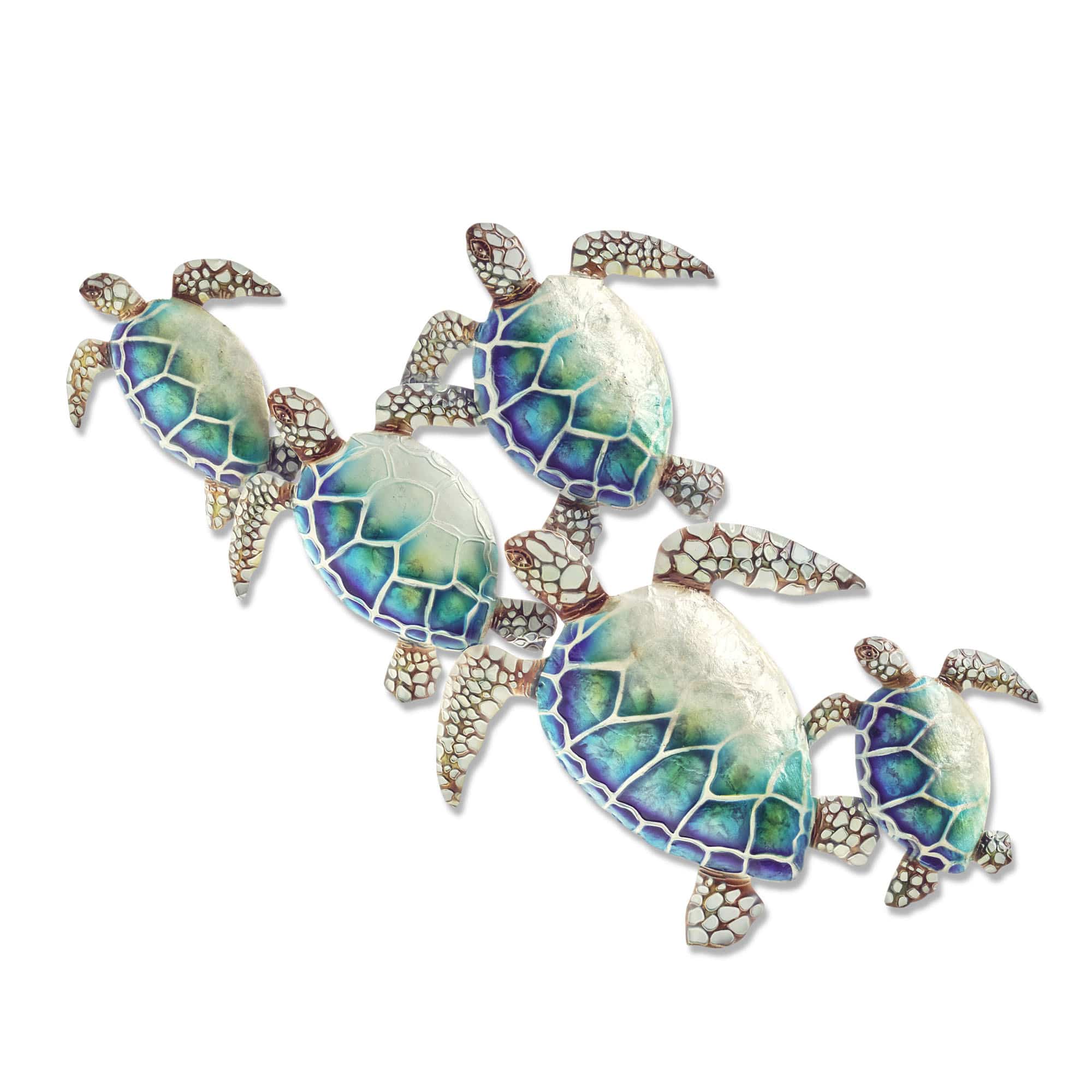 This dramatic piece of art is inspired by a flotilla of Ridley sea turtles coming together to nest. They are swimming towards the beach through the shallow waters represented by the strong aqua based colors. You can almost see the sunlight reflecting off their right side where the color is stark white. The artist recreates the organic body structure of sea turtles by using capiz shell to create the spotted characteristics covering their limbs and head. The basic frame of the turtle is created using tin, which is powder coated with a black finish. The frame is reinforced using tin wire along the inner edge. Capiz is an oyster shell and the primary purpose of the oyster is as a source of food. However, the by-product, the shell, can be used for decoration. Due to it being a natural material, the natural colors of the capiz come through as tans and browns underneath the paint. The shell is then painted the bold colors you see. The entire front facing piece is carefully hand-painted keeping in mind the reflective qualities in the color of turtles.
This dramatic piece of art is inspired by a flotilla of Ridley sea turtles coming together to nest. They are swimming towards the beach through the shallow waters represented by the strong aqua based colors. You can almost see the sunlight reflecting off their right side where the color is stark white. The artist recreates the organic body structure of sea turtles by using capiz shell to create the spotted characteristics covering their limbs and head. The basic frame of the turtle is created using tin, which is powder coated with a black finish. The frame is reinforced using tin wire along the inner edge. Capiz is an oyster shell and the primary purpose of the oyster is as a source of food. However, the by-product, the shell, can be used for decoration. Due to it being a natural material, the natural colors of the capiz come through as tans and browns underneath the paint. The shell is then painted the bold colors you see. The entire front facing piece is carefully hand-painted keeping in mind the reflective qualities in the color of turtles. -
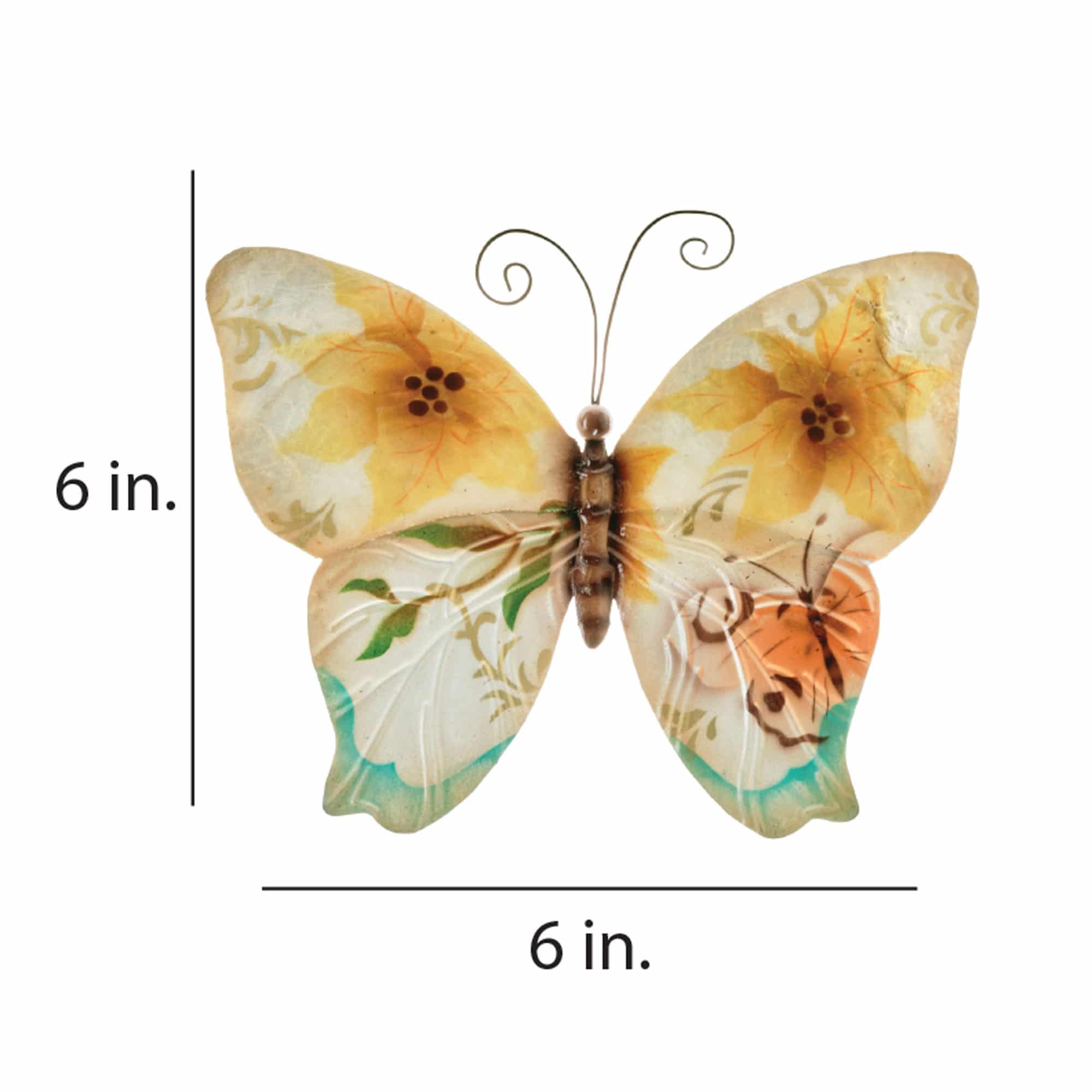
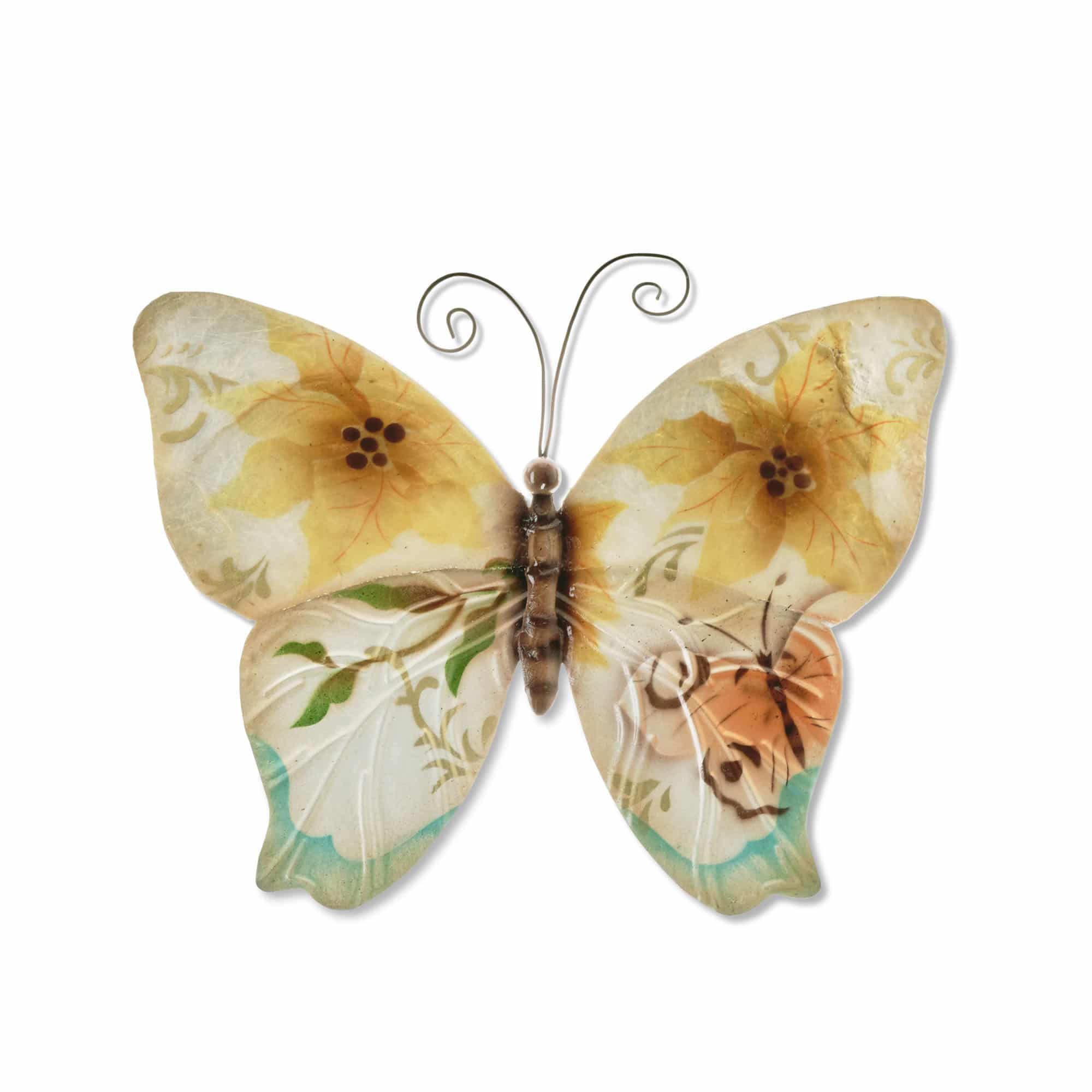 Small and graceful, the sunflower butterfly features soft colors with a mix of flower and leaf patterns to create warmth. A mix of metal and capiz shell, this perfectly crafted butterfly is meant as an extra touch of color and visual interest in a small space. The basic frame of the butterfly is created using tin, which is powder-coated with a black finish and makes this piece safe to use outdoors. The edges of the frame are reinforced using thicker tin wire. The front of this piece is adorned in areas with capiz shell, an oyster native to the Philippines, before being hand-painted and sealed with a water-based sealant. The primary purpose of this oyster to provide a source of food, however, the shell is a sustainable by-product that can be used for decoration. The capiz shell subtly replicates the reflective qualities of butterflies in nature. The entire piece is lightweight and has an eyelet in the back allowing it to be hung using a finishing nail, command strip, or a push pin. Due to it being a natural material, the organic colors of capiz come through as tans and browns underneath the paint.
Small and graceful, the sunflower butterfly features soft colors with a mix of flower and leaf patterns to create warmth. A mix of metal and capiz shell, this perfectly crafted butterfly is meant as an extra touch of color and visual interest in a small space. The basic frame of the butterfly is created using tin, which is powder-coated with a black finish and makes this piece safe to use outdoors. The edges of the frame are reinforced using thicker tin wire. The front of this piece is adorned in areas with capiz shell, an oyster native to the Philippines, before being hand-painted and sealed with a water-based sealant. The primary purpose of this oyster to provide a source of food, however, the shell is a sustainable by-product that can be used for decoration. The capiz shell subtly replicates the reflective qualities of butterflies in nature. The entire piece is lightweight and has an eyelet in the back allowing it to be hung using a finishing nail, command strip, or a push pin. Due to it being a natural material, the organic colors of capiz come through as tans and browns underneath the paint. -
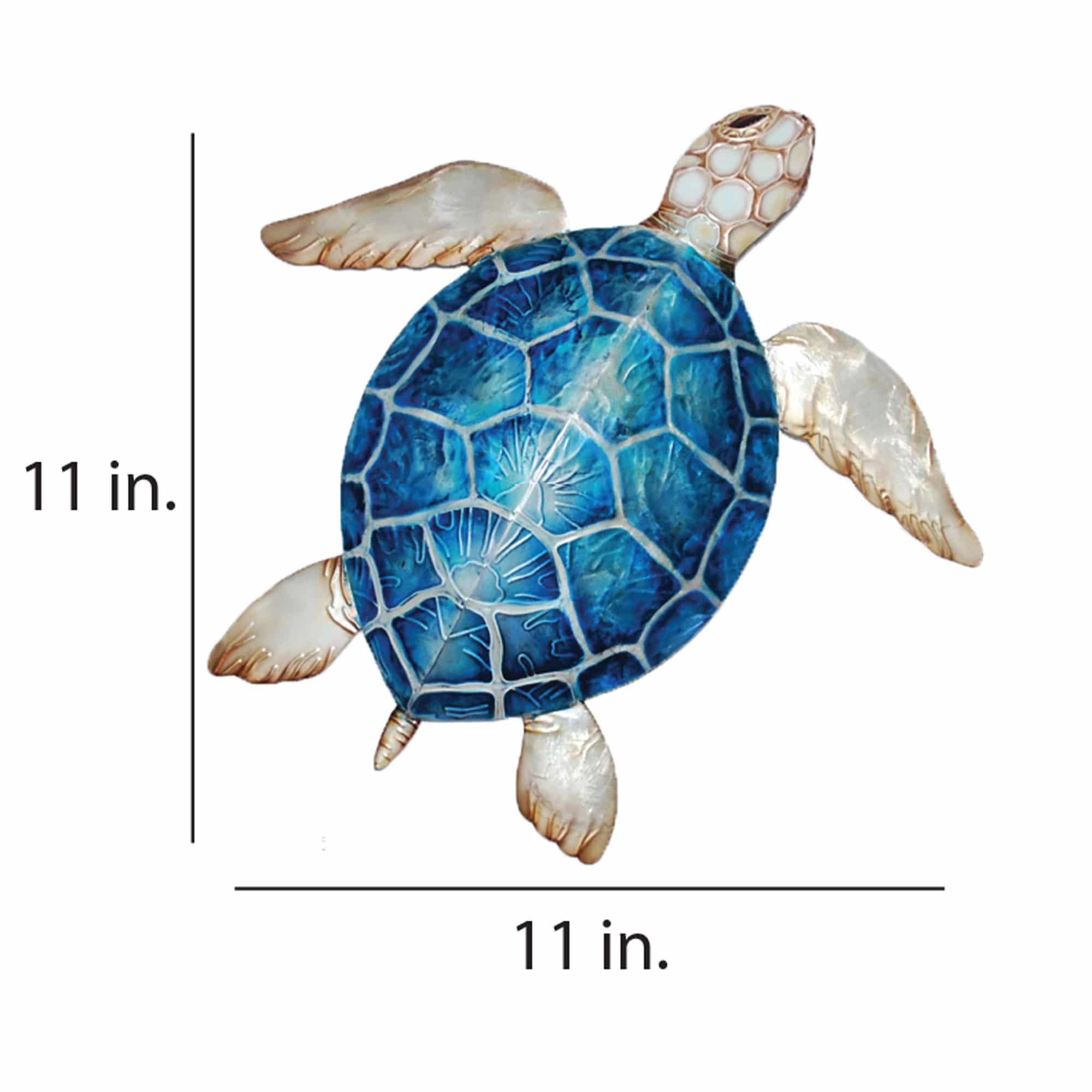
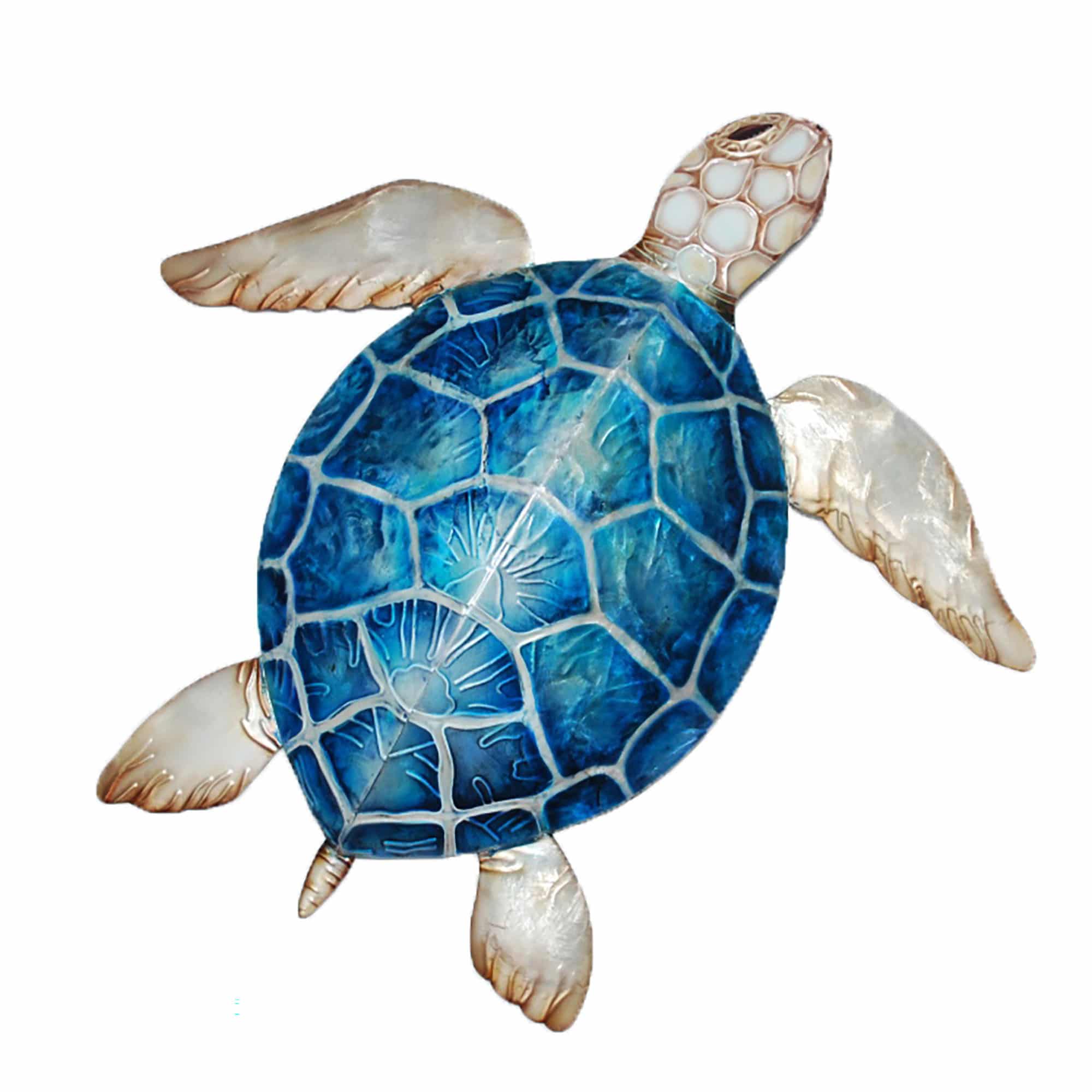 Sea turtles are among the most ancient species on this planet. Today there are seven species of sea turtle remaining that date back 110 million years, back to the age of the dinosaurs. This piece features the Loggerhead turtle, one of the most recognizable of all the sea. This creature is known for its scaled skin, which the artist carefully etches into the metal of the turtle's head and throughout the tips and edges of its body. The shell of the turtle glistens which the artist recreates using capiz shell. The focus of this awe-inspiring piece is the texture and size of sea turtles and the artist uses contrasting colors to underscore this fact. The basic frame of the turtle is created using tin, which is powder coated with a black finish. The frame is reinforced using tin wire along the inner edge. Capiz is an oyster shell and the primary purpose of the oyster is as a source of food. However, the by-product, the shell, can be used for decoration. Due to it being a natural material, the natural colors of the capiz come through as tans and browns underneath the paint. The shell is then painted the bold colors you see. The entire front facing piece is carefully hand-painted keeping in mind the reflective qualities in the color of turtles.
Sea turtles are among the most ancient species on this planet. Today there are seven species of sea turtle remaining that date back 110 million years, back to the age of the dinosaurs. This piece features the Loggerhead turtle, one of the most recognizable of all the sea. This creature is known for its scaled skin, which the artist carefully etches into the metal of the turtle's head and throughout the tips and edges of its body. The shell of the turtle glistens which the artist recreates using capiz shell. The focus of this awe-inspiring piece is the texture and size of sea turtles and the artist uses contrasting colors to underscore this fact. The basic frame of the turtle is created using tin, which is powder coated with a black finish. The frame is reinforced using tin wire along the inner edge. Capiz is an oyster shell and the primary purpose of the oyster is as a source of food. However, the by-product, the shell, can be used for decoration. Due to it being a natural material, the natural colors of the capiz come through as tans and browns underneath the paint. The shell is then painted the bold colors you see. The entire front facing piece is carefully hand-painted keeping in mind the reflective qualities in the color of turtles. -
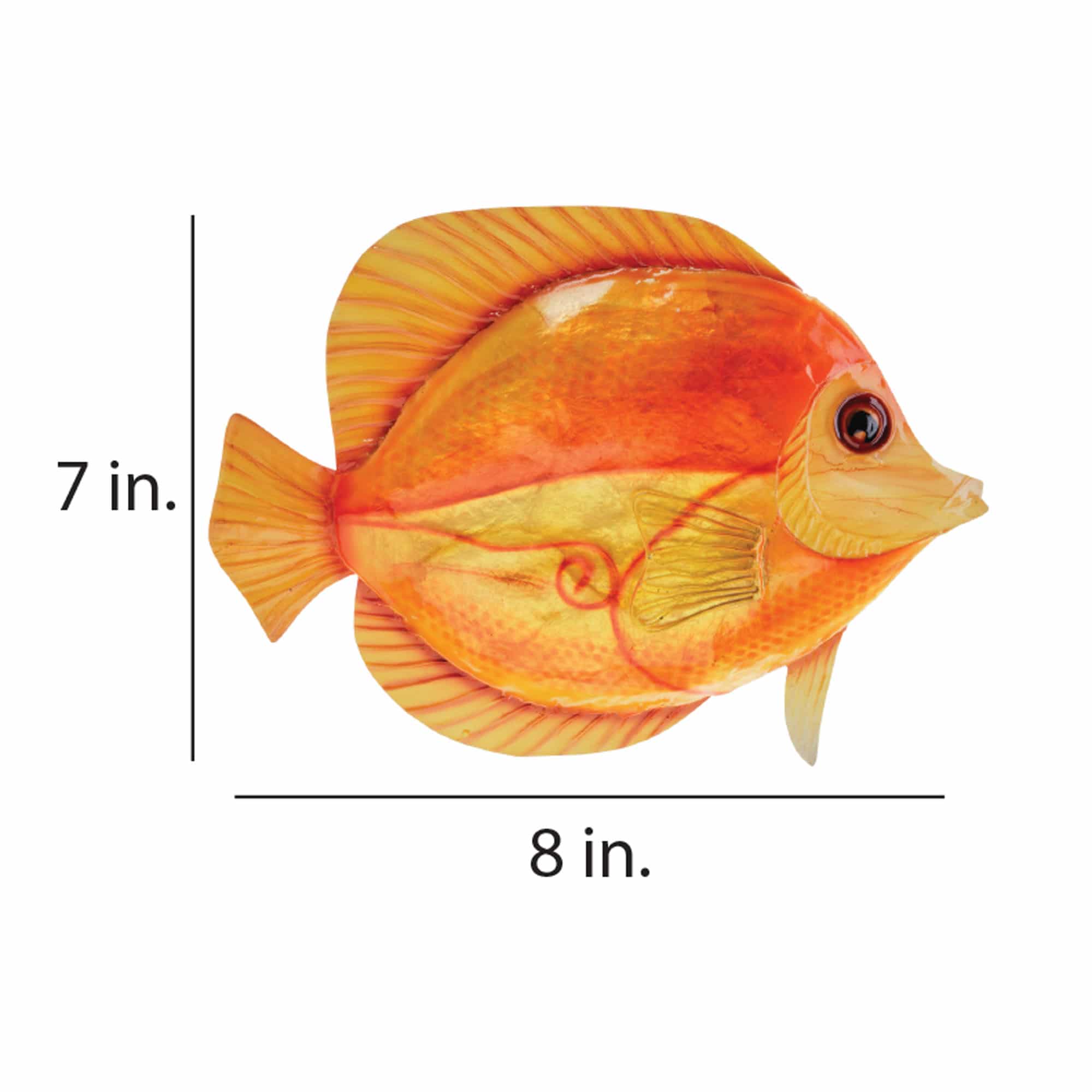
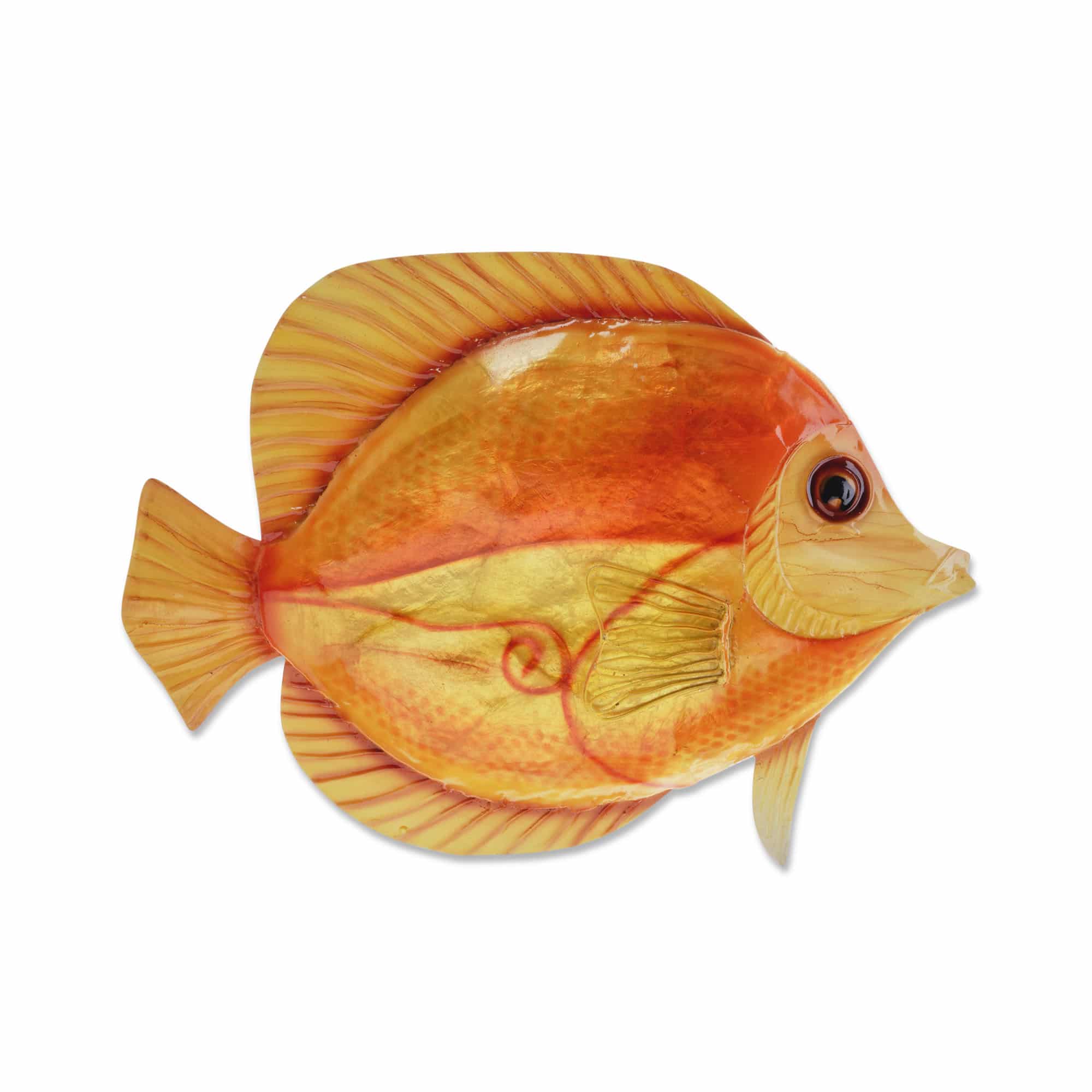 The discus fish is native to the Amazon river basin. These fish are known for their distinctive shape, bright colors, and unique patterns. The artist who painted this fish paid attention to the interacting color patterns. Using capiz shell, he emulated the natural scales of this fish. The basic frame of the wall fish is created using tin, which is powder coated as a black finish. The frame is reinforced using wrought iron wire along the inner edge. Capiz is an oyster shell and the primary purpose of the oyster is as a source of food. However, the by-product, the shell, can be used for decoration. Due to it being a natural material, the natural colors of the capiz can come through as tans and browns underneath the paint.
The discus fish is native to the Amazon river basin. These fish are known for their distinctive shape, bright colors, and unique patterns. The artist who painted this fish paid attention to the interacting color patterns. Using capiz shell, he emulated the natural scales of this fish. The basic frame of the wall fish is created using tin, which is powder coated as a black finish. The frame is reinforced using wrought iron wire along the inner edge. Capiz is an oyster shell and the primary purpose of the oyster is as a source of food. However, the by-product, the shell, can be used for decoration. Due to it being a natural material, the natural colors of the capiz can come through as tans and browns underneath the paint. -
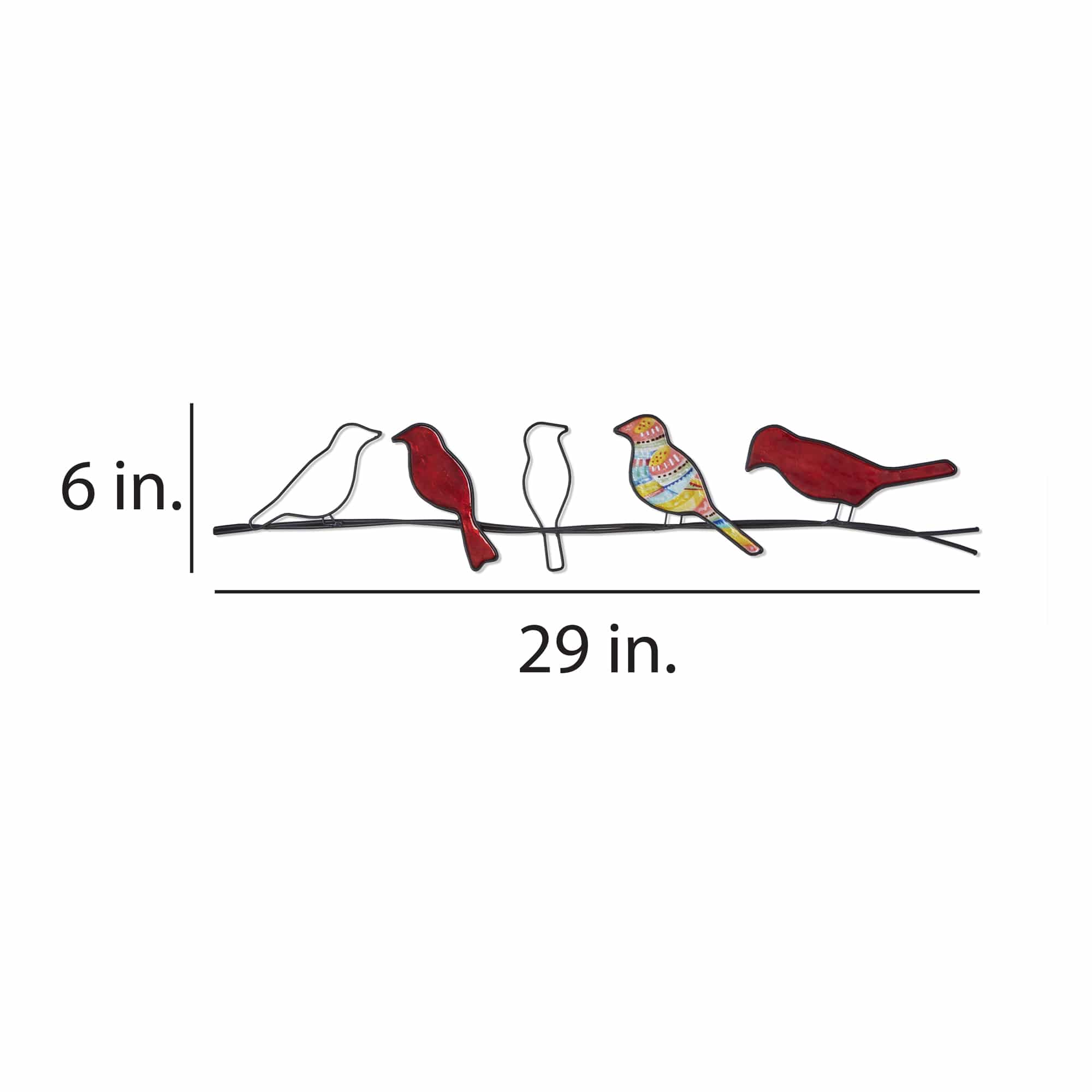
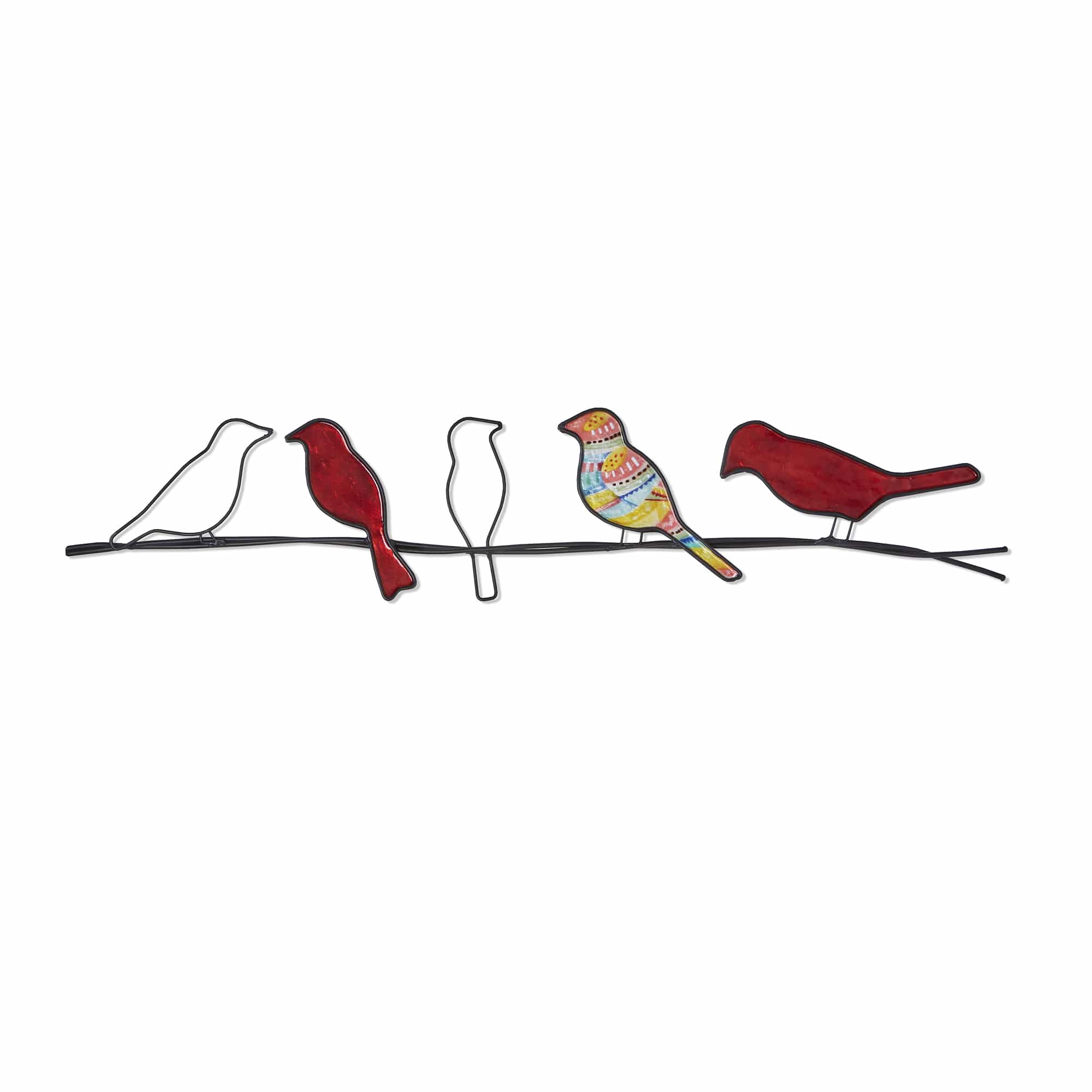 An old parable states that five birds were resting on a wire. Two decided to fly south. How many were birds are left? One's initial answer may be three, however, the answer is still five. The moral of the fable is actions are more important than intention; a kind reminder that a truer picture of one's character is drawn by actions. The artisan captures this parable by lining up five birds socializing on a wire. The basic frame of this piece is created using tin, which is powder coated with a black finish. The frame is reinforced using tin wire along the inner edge. The front of the body is adorned with capiz. Capiz is an oyster shell and the primary purpose of the oyster is as a source of food. However, the by-product, the shell, can be used for decoration. Due to it being a natural material, the natural colors of the capiz may come through as tans and browns underneath the hand-painted surface.
An old parable states that five birds were resting on a wire. Two decided to fly south. How many were birds are left? One's initial answer may be three, however, the answer is still five. The moral of the fable is actions are more important than intention; a kind reminder that a truer picture of one's character is drawn by actions. The artisan captures this parable by lining up five birds socializing on a wire. The basic frame of this piece is created using tin, which is powder coated with a black finish. The frame is reinforced using tin wire along the inner edge. The front of the body is adorned with capiz. Capiz is an oyster shell and the primary purpose of the oyster is as a source of food. However, the by-product, the shell, can be used for decoration. Due to it being a natural material, the natural colors of the capiz may come through as tans and browns underneath the hand-painted surface. -
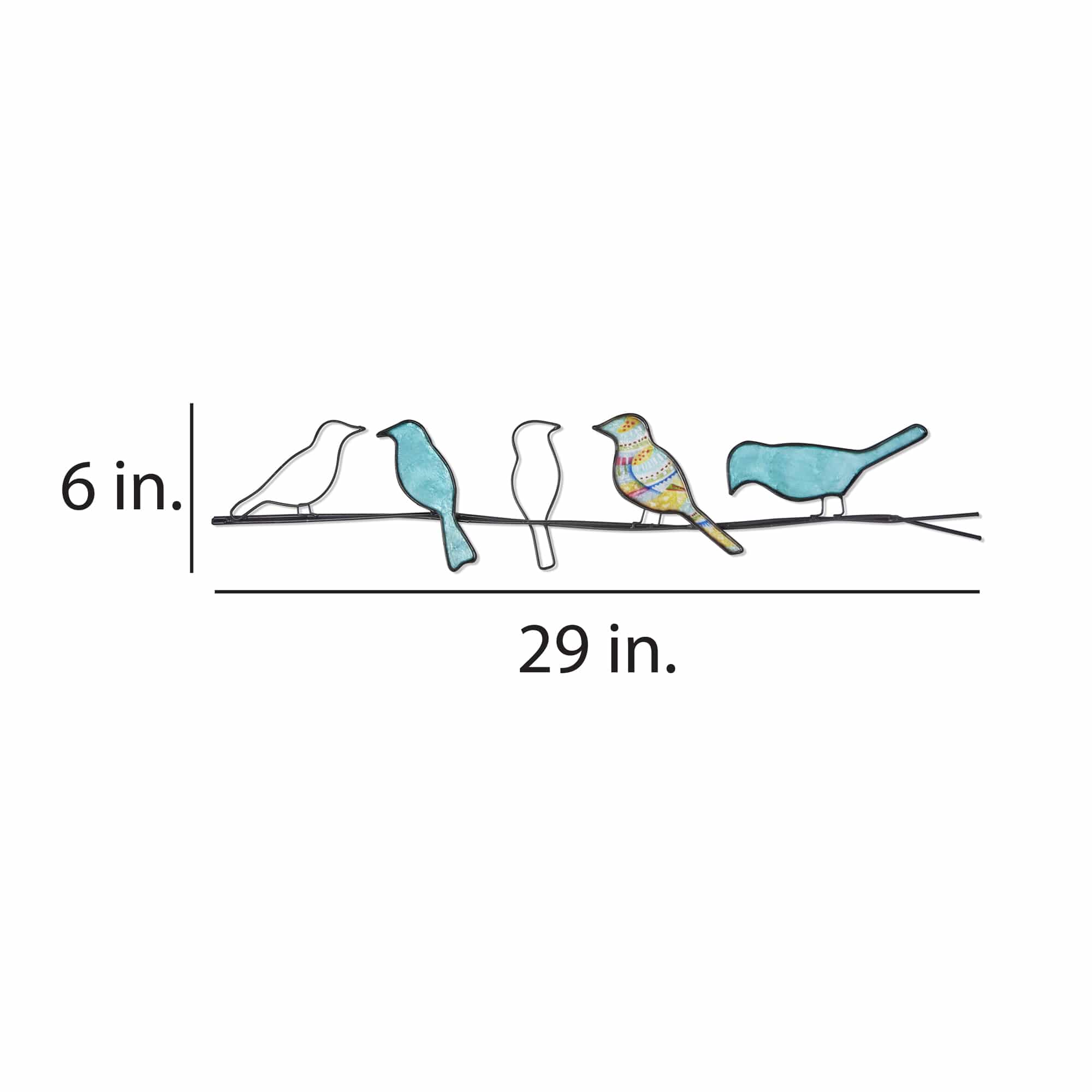
 An old parable states that five birds were resting on a wire. Two decided to fly south. How many were birds are left? One's initial answer may be three, however, the answer is still five. The moral of the fable is actions are more important than intention; a kind reminder that a truer picture of one's character is drawn by actions. The artisan captures this parable by lining up five birds socializing on a wire. The basic frame of this piece is created using tin, which is powder coated with a black finish. The frame is reinforced using tin wire along the inner edge. The front of the body is adorned with capiz. Capiz is an oyster shell and the primary purpose of the oyster is as a source of food. However, the by-product, the shell, can be used for decoration. Due to it being a natural material, the natural colors of the capiz may come through as tans and browns underneath the hand-painted surface.
An old parable states that five birds were resting on a wire. Two decided to fly south. How many were birds are left? One's initial answer may be three, however, the answer is still five. The moral of the fable is actions are more important than intention; a kind reminder that a truer picture of one's character is drawn by actions. The artisan captures this parable by lining up five birds socializing on a wire. The basic frame of this piece is created using tin, which is powder coated with a black finish. The frame is reinforced using tin wire along the inner edge. The front of the body is adorned with capiz. Capiz is an oyster shell and the primary purpose of the oyster is as a source of food. However, the by-product, the shell, can be used for decoration. Due to it being a natural material, the natural colors of the capiz may come through as tans and browns underneath the hand-painted surface. -
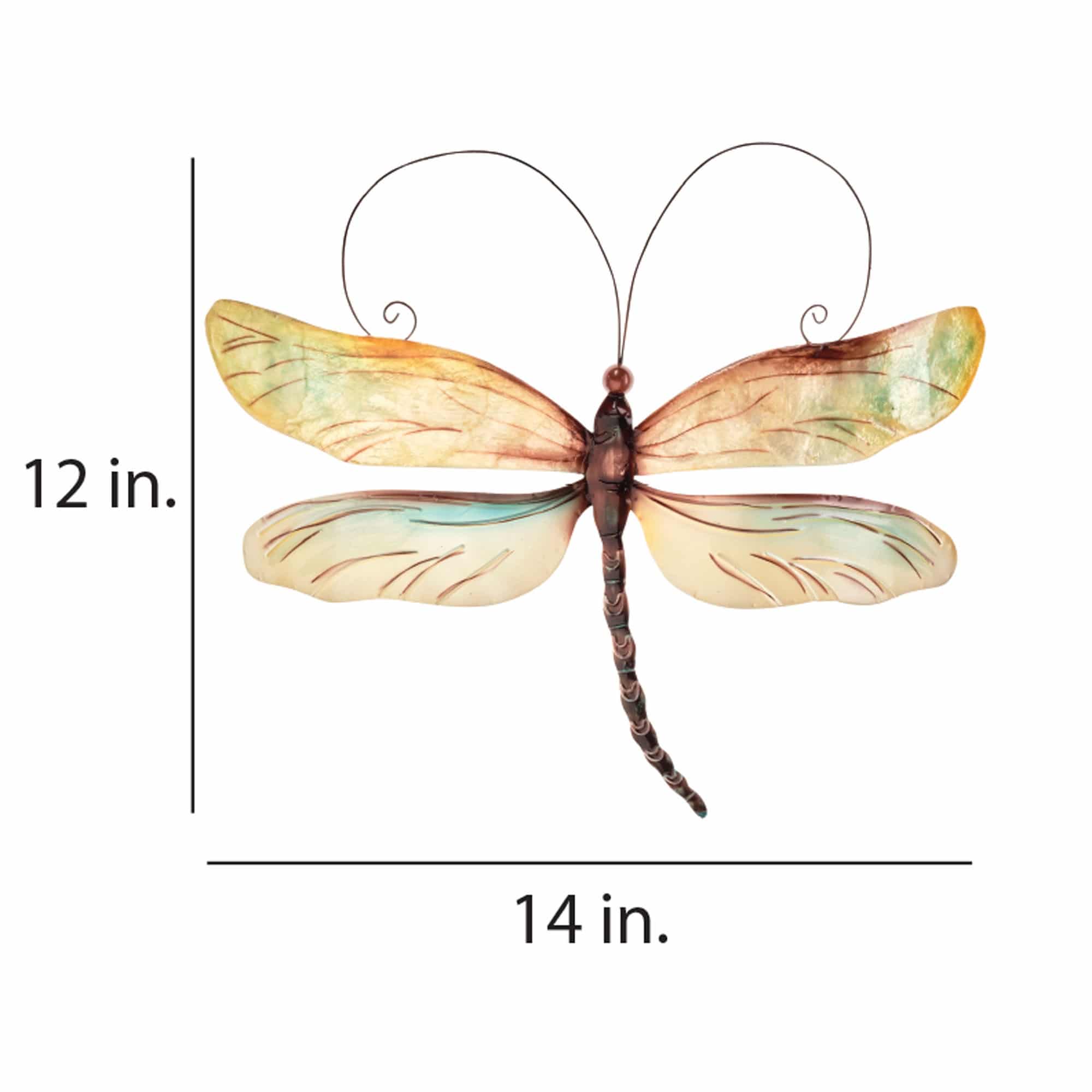
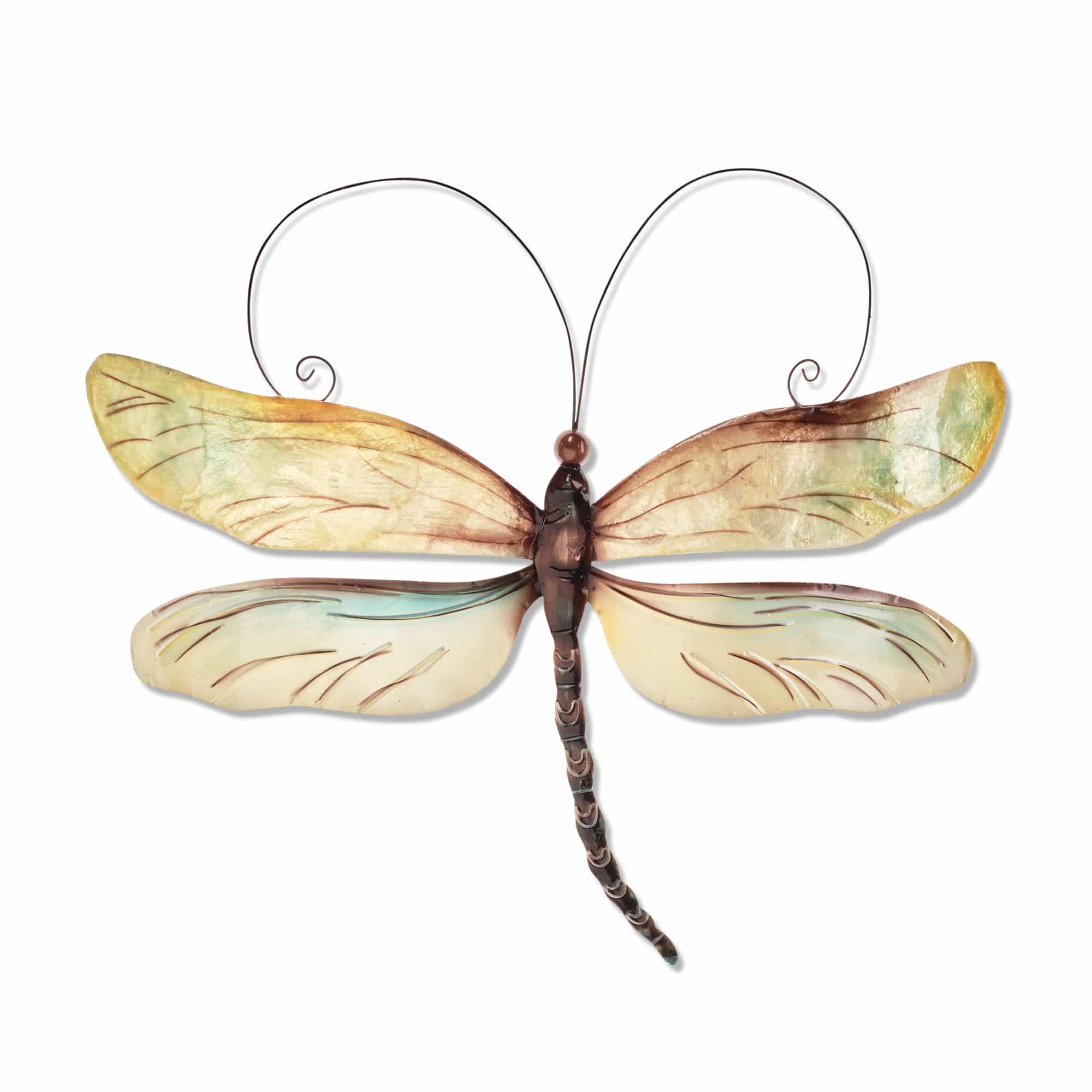
This dragonfly is extremely popular! The colors of the wings are inspired by the water of a crystal-clear lake, making the pearl wings feel translucent next to the dark body. The long flowing antenna and the shape of this dragonfly provide a classic feel to this very familiar form.
The basic frame of the dragonfly is created using tin, which is powder-coated with a black finish and makes this piece safe to use outdoors. The edges of the frame are reinforced using thicker tin wire. The front of this piece is adorned in areas with capiz shell, an oyster native to the Philippines, before being hand-painted and sealed with a water-based sealant. The primary purpose of this oyster to provide a source of food, however, the shell is a sustainable by-product that can be used for decoration. The capiz shell subtly replicates the reflective qualities of dragonflies in nature. The entire piece is lightweight and has an eyelet in the back allowing it to be hung using a finishing nail, command strip, or a push pin. Due to it being a natural material, the organic colors of capiz come through as tans and browns underneath the paint.
-
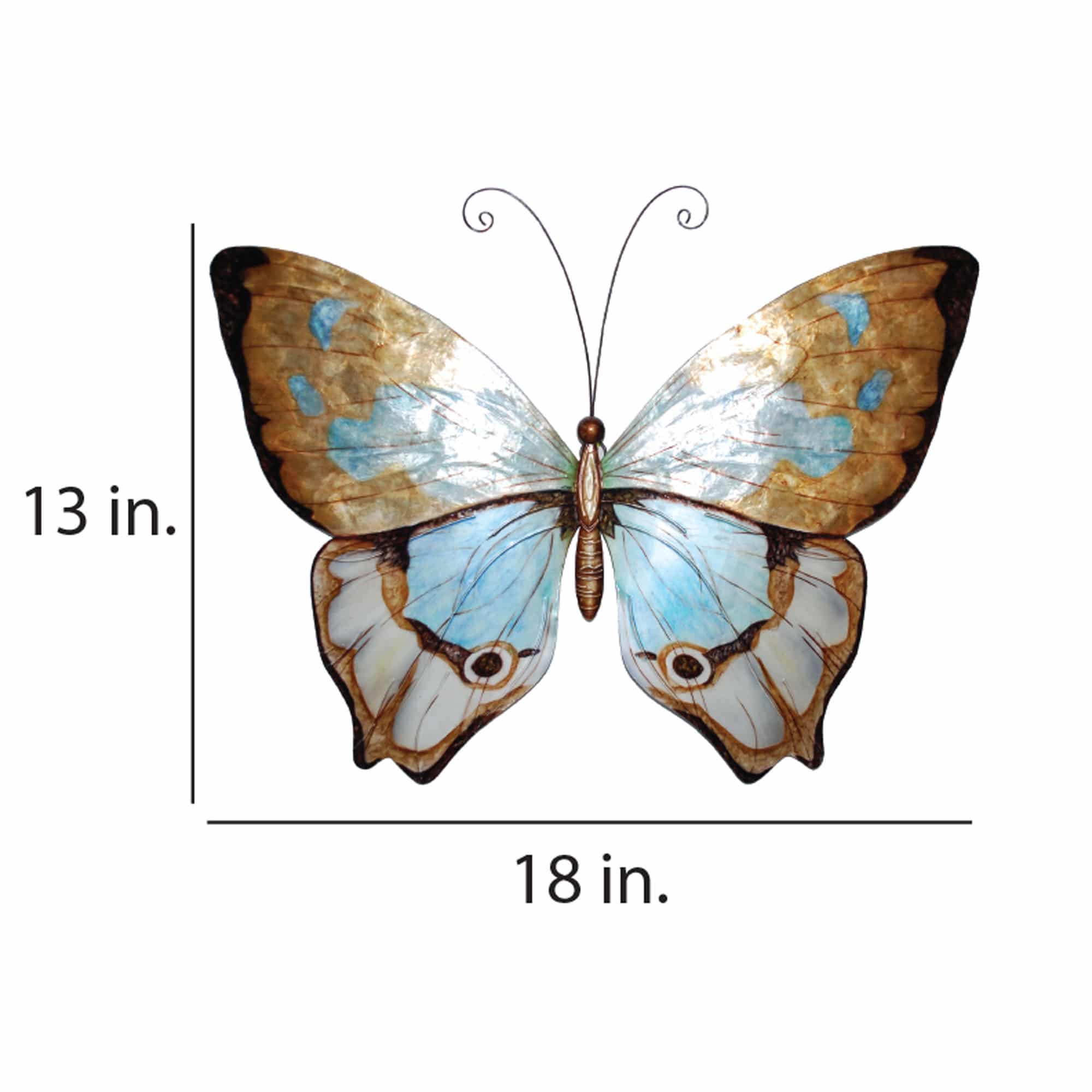
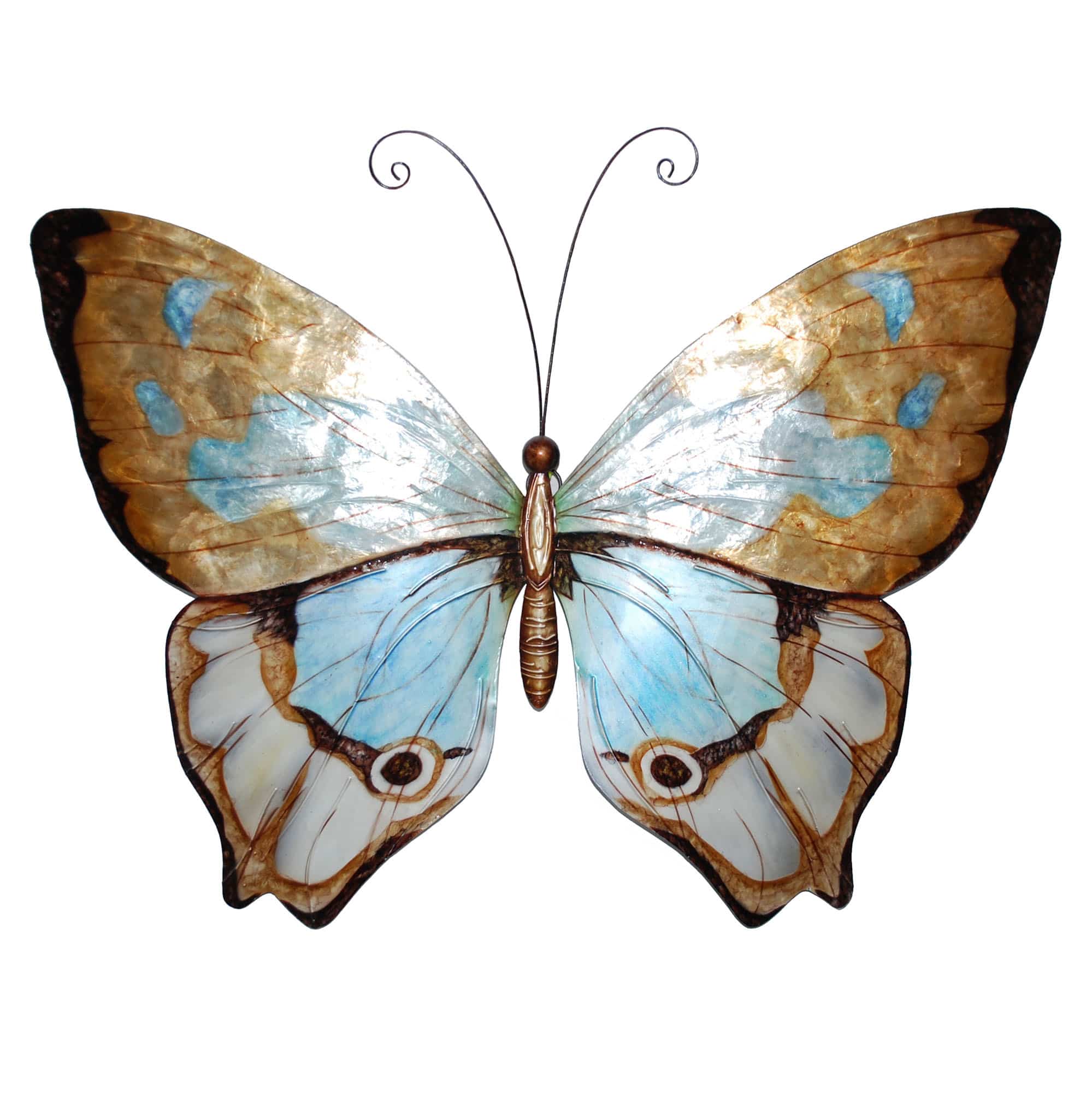
This butterfly features classic butterfly patterns with is mottled upper wings and its dotted lower section. The warm copper tones contrast with the contemporary blues to take this naturally feeling piece in a direction that works in both contemporary and traditional settings. Its neutral in tone while still exuding warmth.
The basic frame of the butterfly is created using tin, which is powder-coated with a black finish and makes this piece safe to use outdoors. The edges of the frame are reinforced using thicker tin wire. The front of this piece is adorned in areas with capiz shell, an oyster native to the Philippines, before being hand-painted and sealed with a water-based sealant. The primary purpose of this oyster to provide a source of food, however, the shell is a sustainable by-product that can be used for decoration. The capiz shell subtly replicates the reflective qualities of butterflies in nature. The entire piece is lightweight and has an eyelet in the back allowing it to be hung using a finishing nail, command strip, or a push pin. Due to it being a natural material, the organic colors of capiz come through as tans and browns underneath the paint.
-
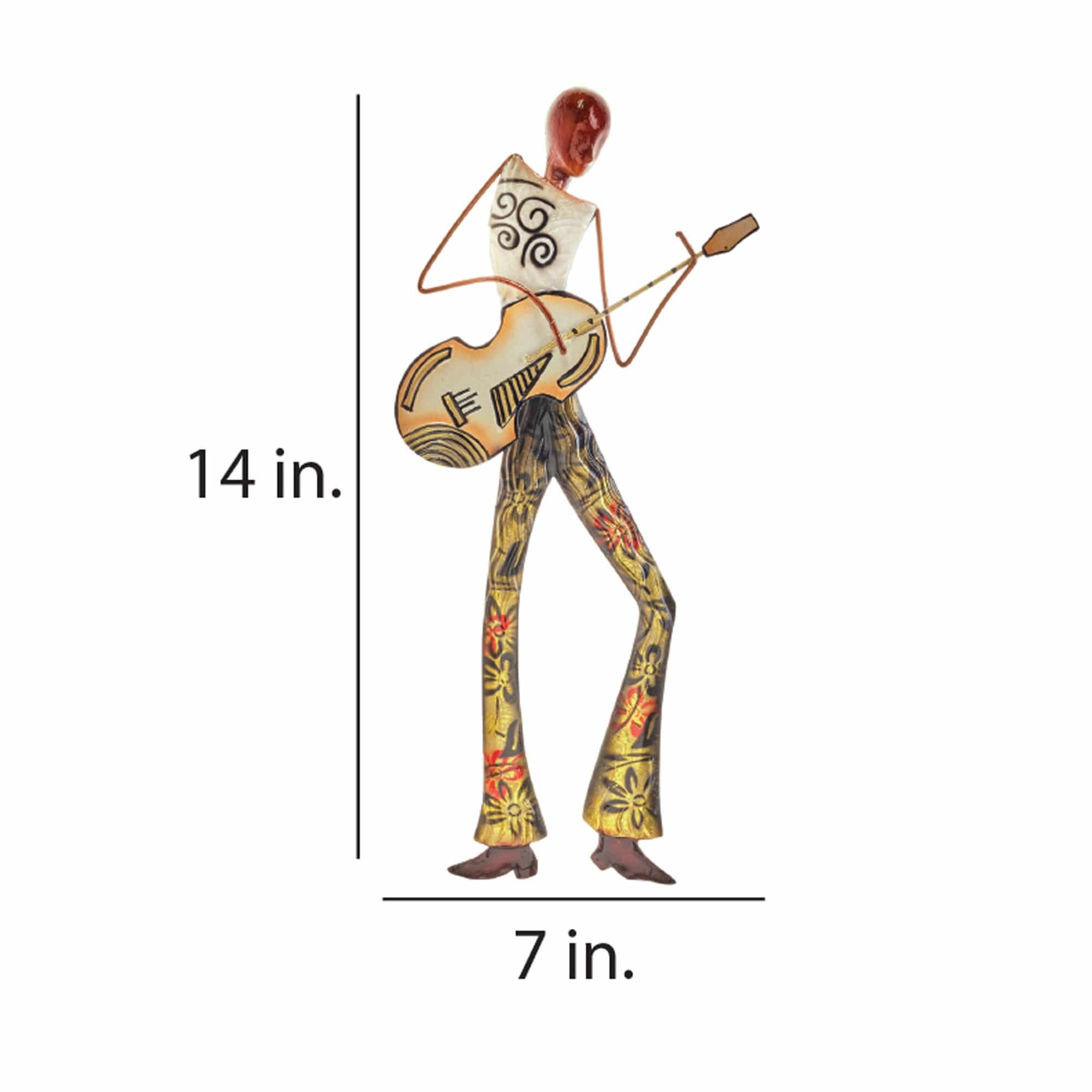
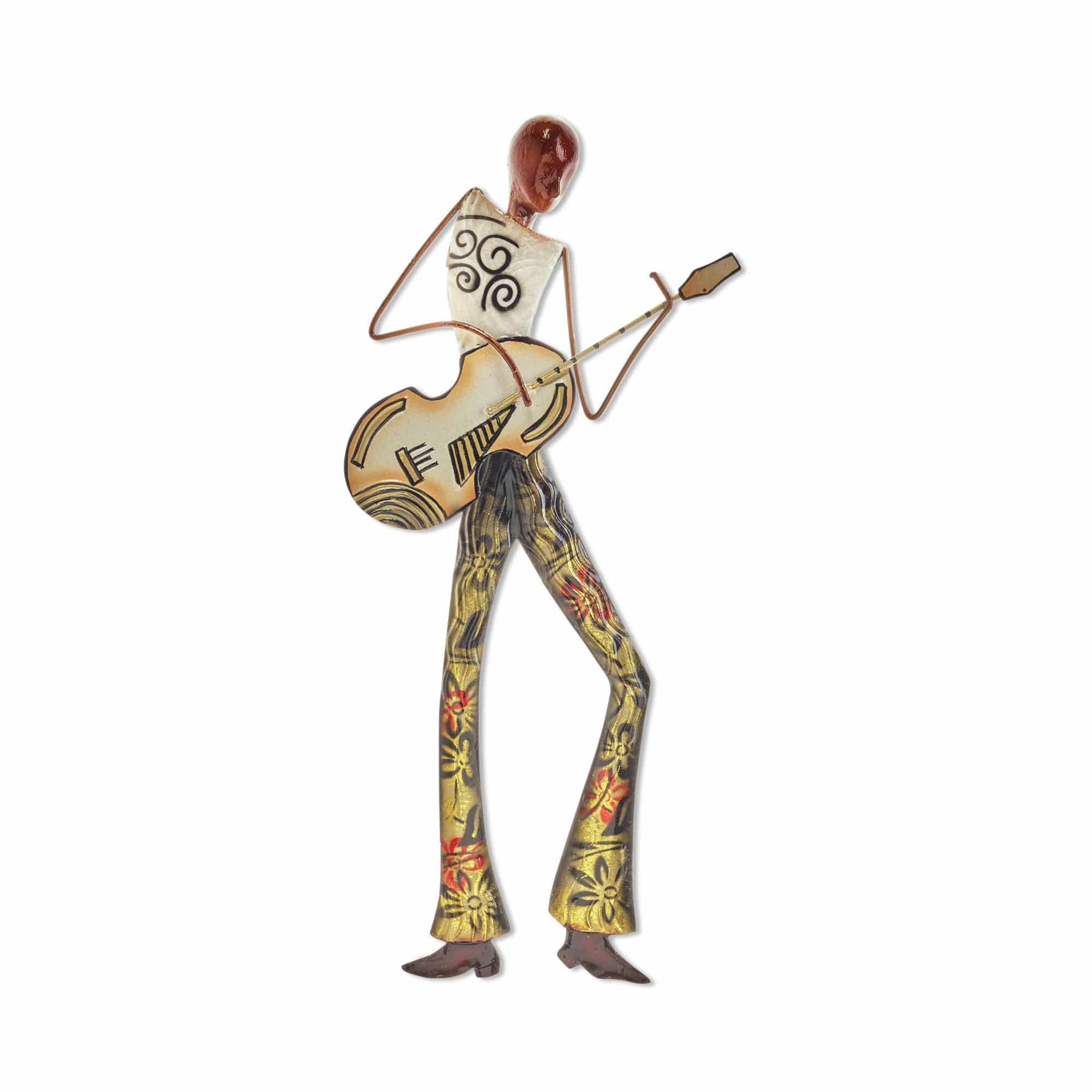
Jazz inspires the artisan's interpretation of the guitar player. Jazz is considered music of the soul due to the deep emotion that runs to the roots of this important American movement. It can be used as a journey to happy times or a reflection of struggles. This particular guitarist, with the colorful finishes, the influence is definitely in a mood of celebration. The festive shirt of the player is adorned with capiz shell, giving it a shimmer as it reflects light.
The frame of the Guitar Player Wall Decor is created using tin, which is powder coated in a black finish. The frame is reinforced using wrought iron wire inner and outer edges. Capiz is an oyster shell and the primary purpose of the oyster is as a source of food. However, the by-product, the shell, can be used for decoration. Due to it being a natural material, the natural colors of the capiz can come through as tans and browns underneath the paint.
-
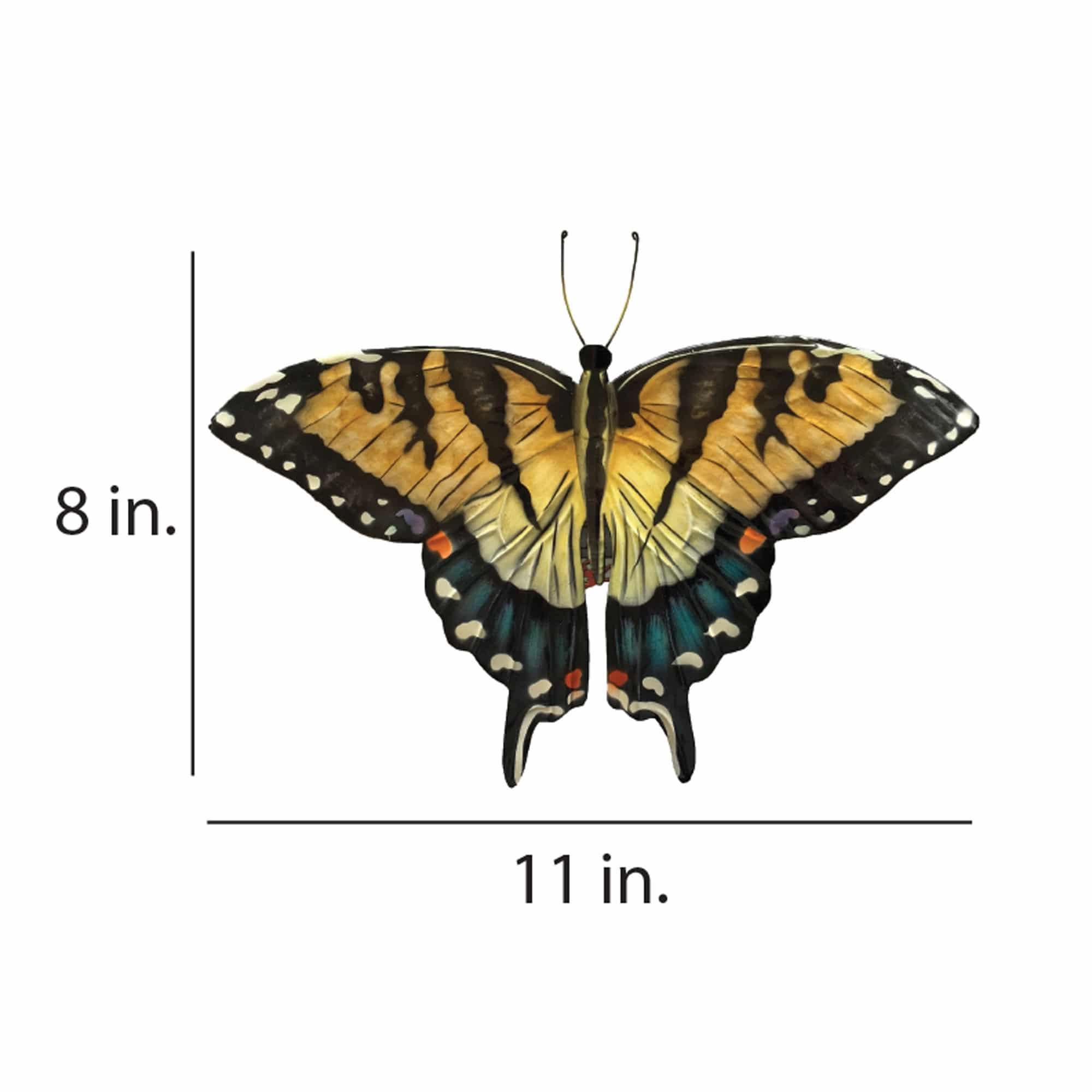
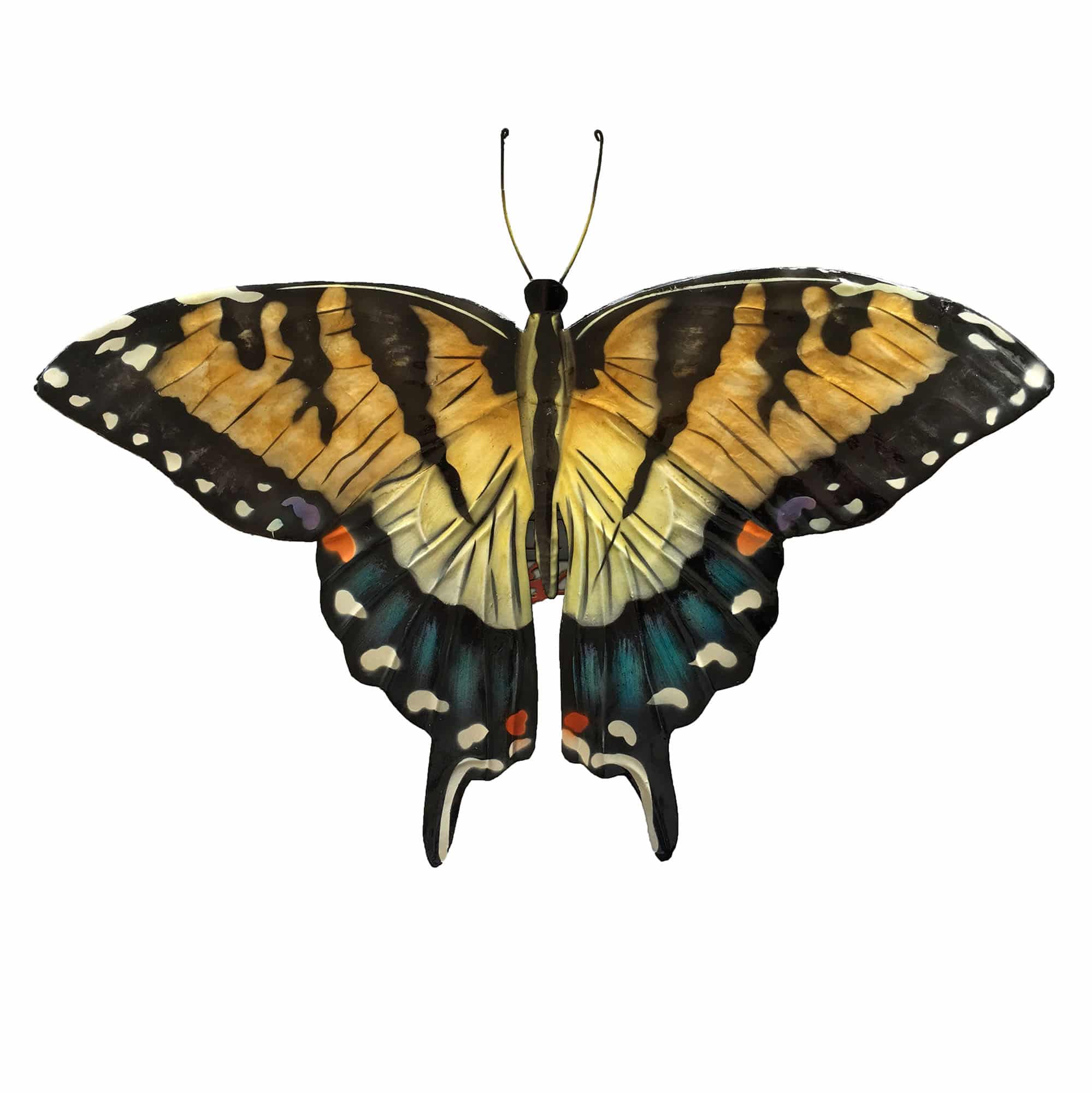
Chances are you have seen the eastern tiger swallowtail at some point. This species can be seen in every state on the continent, as well as Canada and Mexico. Even though the males are colorful, the females carry more of the color and therefore inspired this realistic butterfly piece. Bringing this recreation of nature into your home will add design and color to your space.
The basic frame of the butterfly is created using tin, which is powder-coated with a black finish and makes this piece safe to use outdoors. The edges of the frame are reinforced using thicker tin wire. The front of this piece is adorned in areas with capiz shell, an oyster native to the Philippines, before being hand-painted and sealed with a water-based sealant. The primary purpose of this oyster to provide a source of food, however, the shell is a sustainable by-product that can be used for decoration. The capiz shell subtly replicates the reflective qualities of butterflies in nature. The entire piece is lightweight and has an eyelet in the back allowing it to be hung using a finishing nail, command strip, or a push pin. Due to it being a natural material, the organic colors of capiz come through as tans and browns underneath the paint.
-
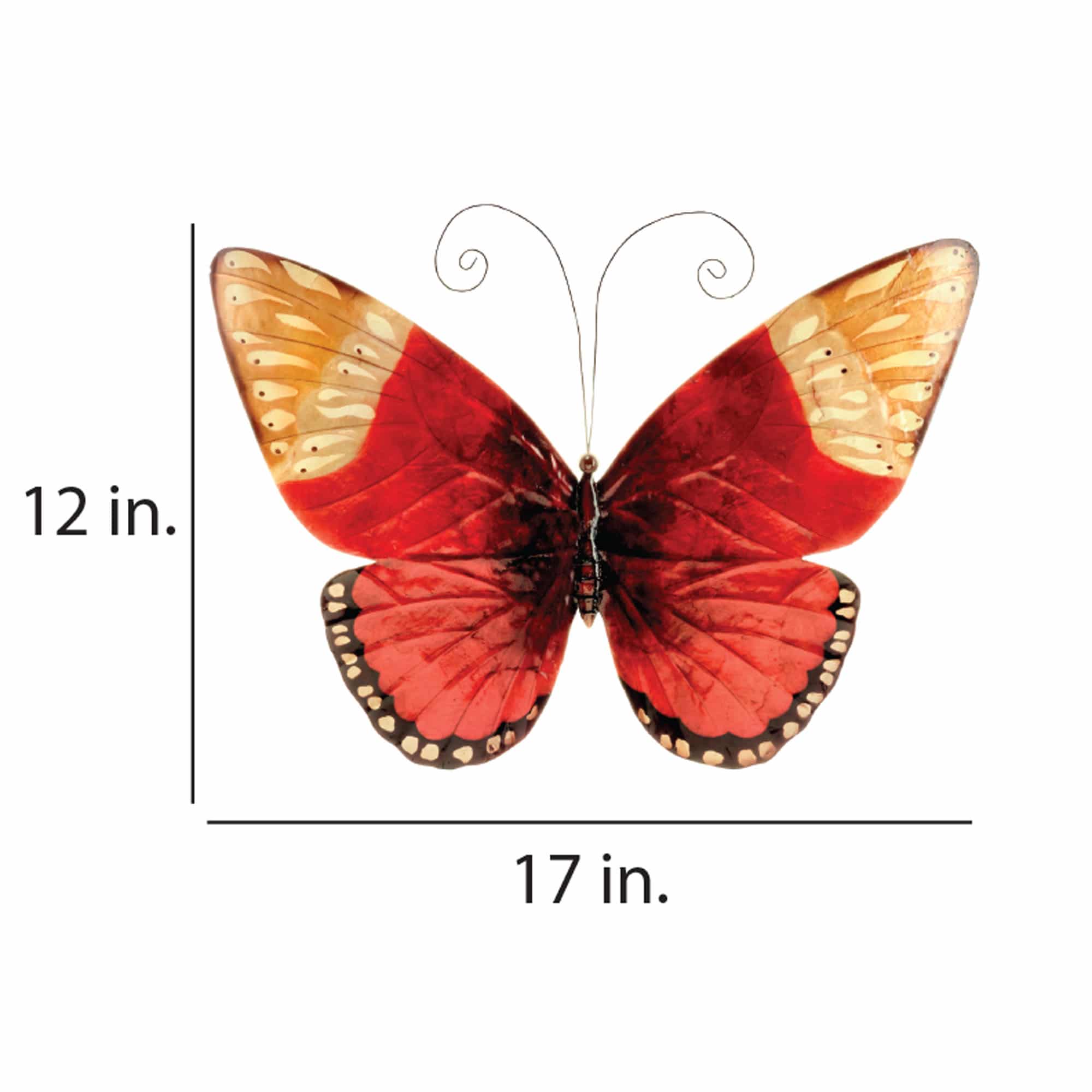
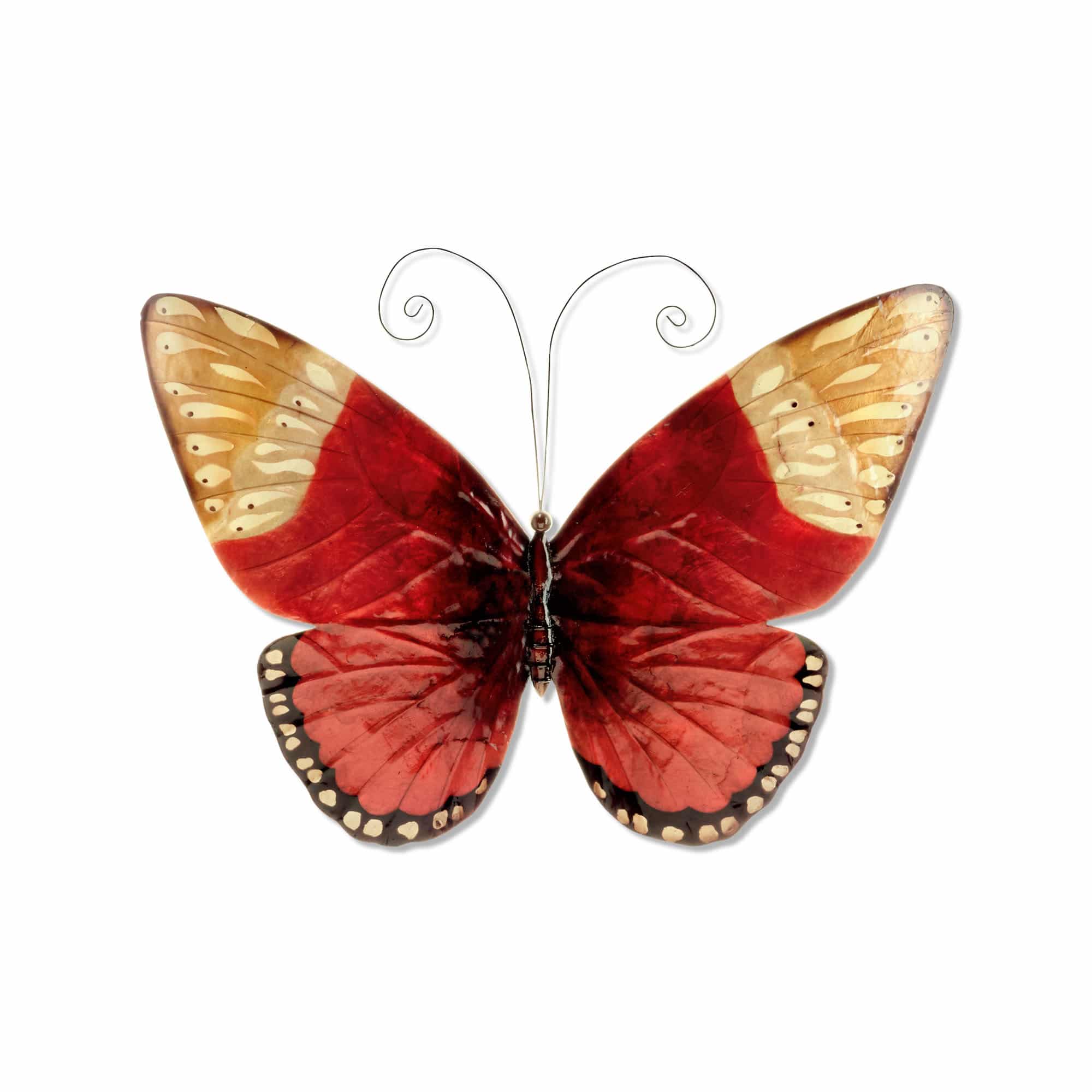
This butterfly is large and bold with its striking bright red body. But this butterfly isn't mono-colored. Instead the artist uses different shading techniques and mother of pearl oyster shell to bring in depth as well as strong color. The artist further enhances the butterfly by adding brown feathering to the wing-tips.
The basic frame of the butterfly is created using tin, which is powder-coated with a black finish and makes this piece safe to use outdoors. The edges of the frame are reinforced using thicker tin wire. The front of this piece is adorned in areas with capiz shell, an oyster native to the Philippines, before being hand-painted and sealed with a water-based sealant. The primary purpose of this oyster to provide a source of food, however, the shell is a sustainable by-product that can be used for decoration. The capiz shell subtly replicates the reflective qualities of butterflies in nature. The entire piece is lightweight and has an eyelet in the back allowing it to be hung using a finishing nail, command strip, or a push pin. Due to it being a natural material, the organic colors of capiz come through as tans and browns underneath the paint.
-
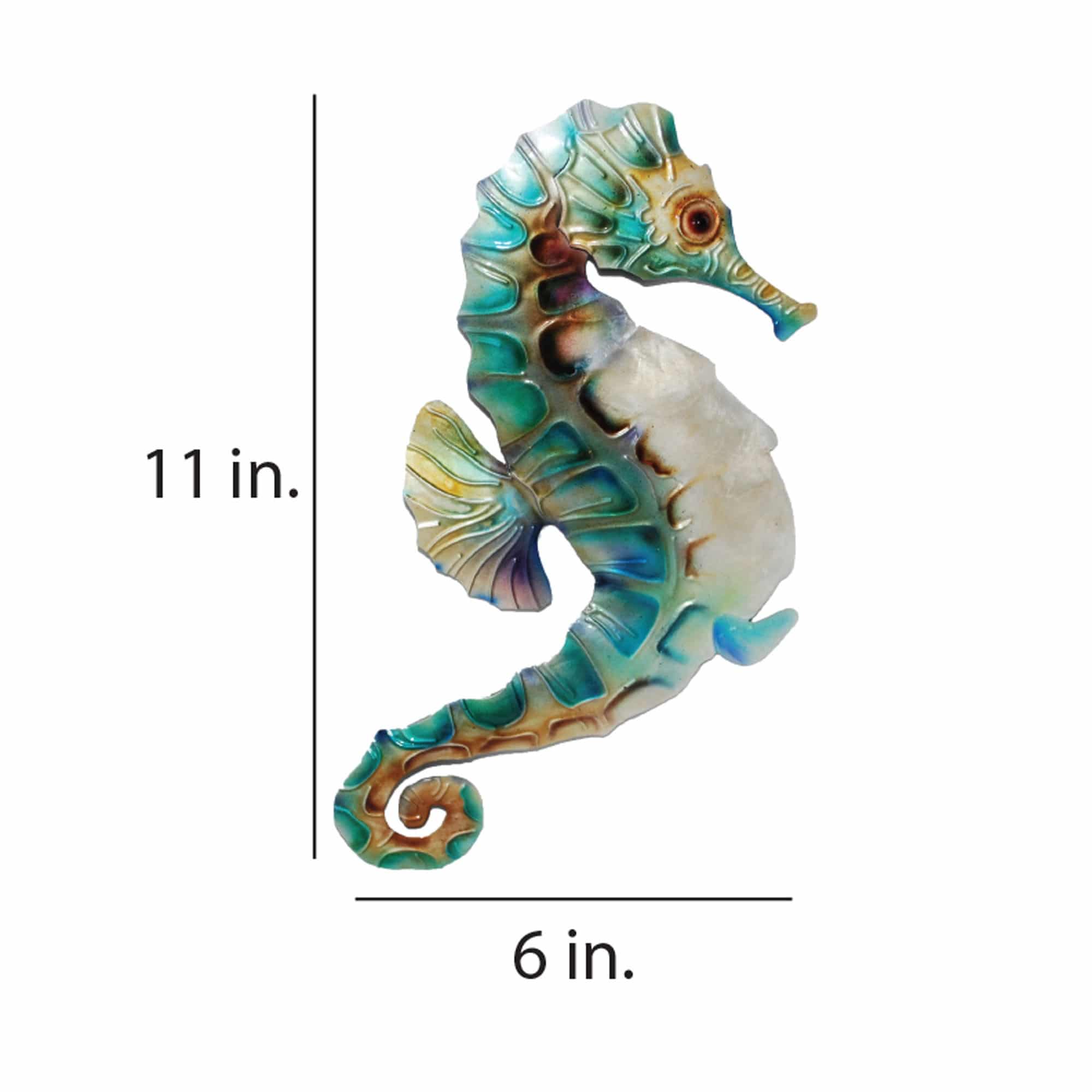
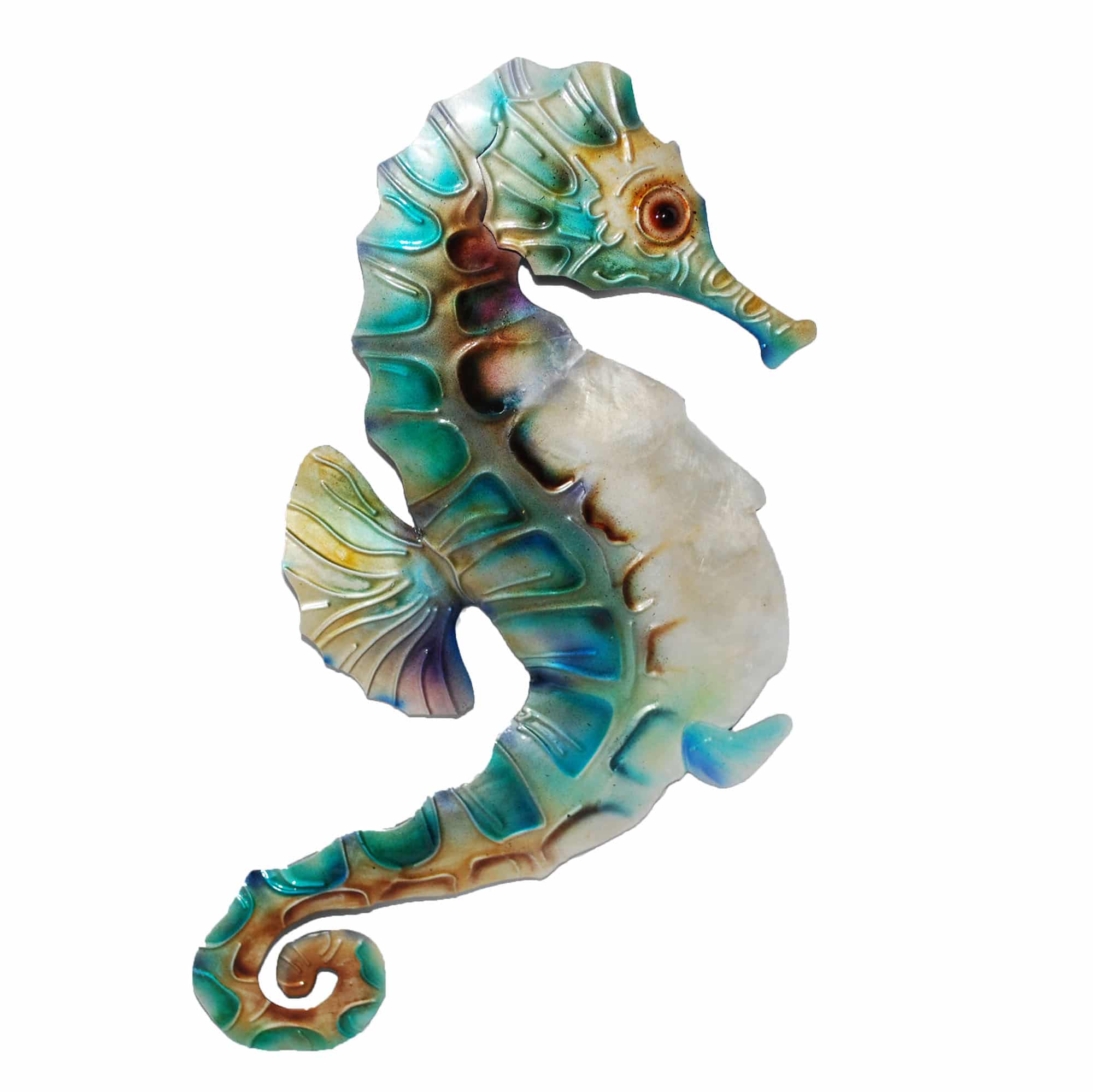 The seahorse has captured the minds and imaginations of people across all cultures for thousands of years. Seen as a symbol of good luck, strength and safety, this unique and beautiful animal is as charming as it is mysterious. The artist captures the beauty of the seahorse with a raised fine, high shine, hand-painted finish, and elegant mother of pearl chest and forefront. The basic frame of the wall seahorse is created using tin, which is powder coated as a black finish. Capiz is an oyster shell and the primary purpose of the oyster is as a source of food. However, the by-product, the shell, can be used for decoration. Due to it being a natural material, the natural colors of the capiz can come through as tans and browns.
The seahorse has captured the minds and imaginations of people across all cultures for thousands of years. Seen as a symbol of good luck, strength and safety, this unique and beautiful animal is as charming as it is mysterious. The artist captures the beauty of the seahorse with a raised fine, high shine, hand-painted finish, and elegant mother of pearl chest and forefront. The basic frame of the wall seahorse is created using tin, which is powder coated as a black finish. Capiz is an oyster shell and the primary purpose of the oyster is as a source of food. However, the by-product, the shell, can be used for decoration. Due to it being a natural material, the natural colors of the capiz can come through as tans and browns. -
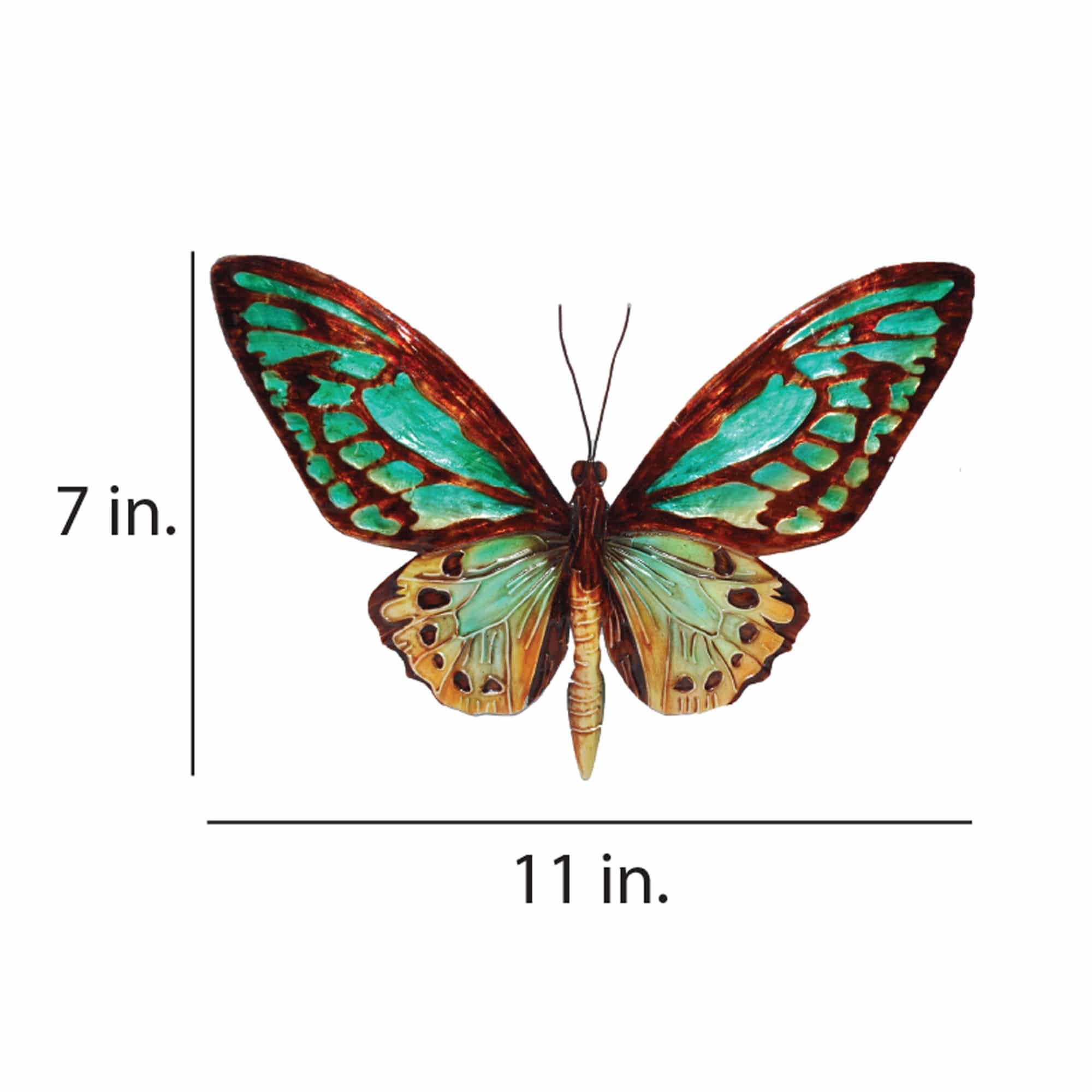
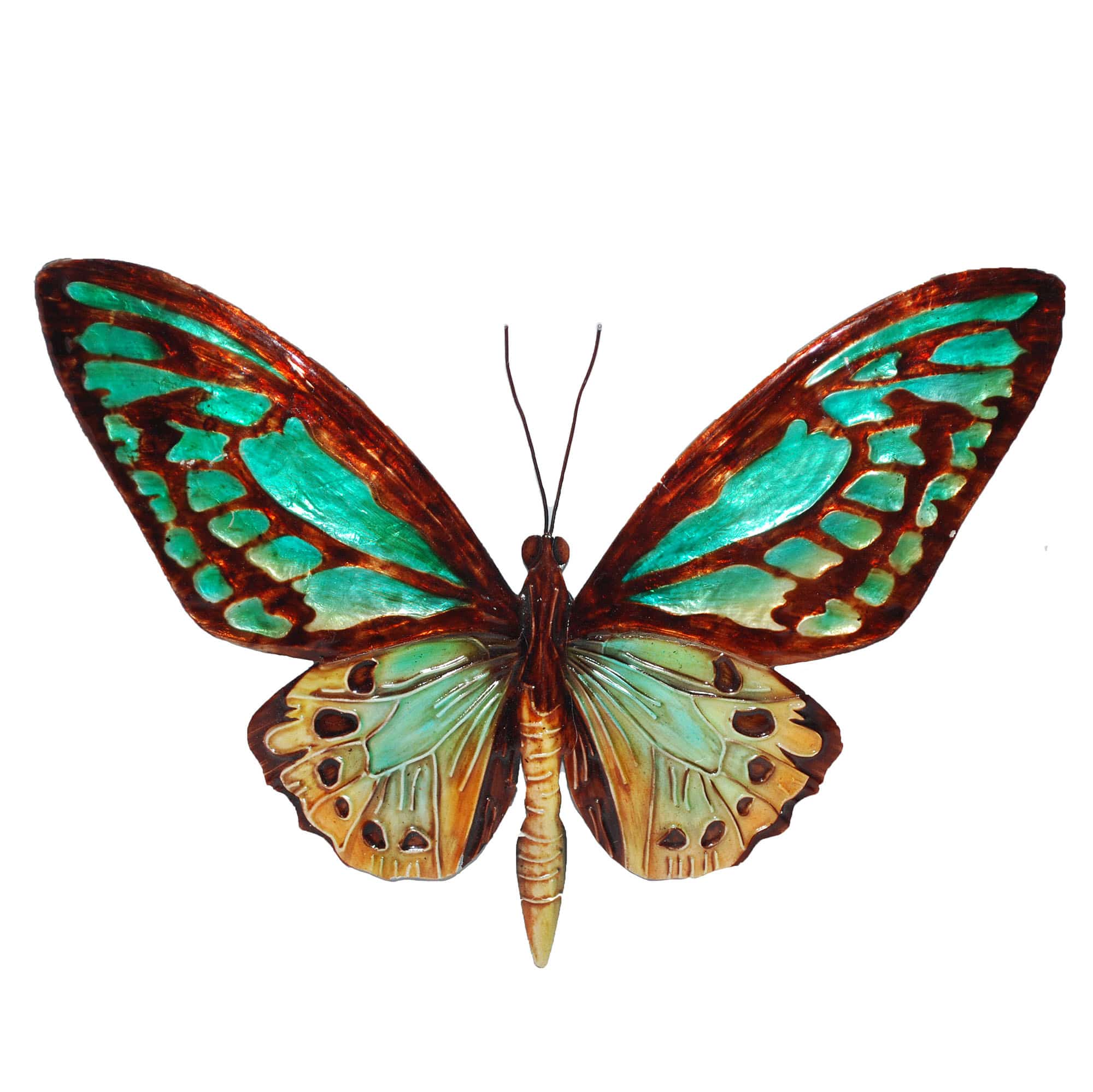
The aqua color of this butterfly and the capiz shell complement each other in such a way that it almost looks like one is looking at cobalt glass. This color is accentuated by the copper tone bordering the aqua centers. This is truly an impressive piece combining natural materials and colors and creating something breathtaking. The upper wing adorned in capiz is contrasted by the handcrafted metal lower wing. Both components meld together for a piece that showcases the artists talents.
The basic frame of the butterfly is created using tin, which is powder-coated with a black finish and makes this piece safe to use outdoors. The edges of the frame are reinforced using thicker tin wire. The front of this piece is adorned in areas with capiz shell, an oyster native to the Philippines, before being hand-painted and sealed with a water-based sealant. The primary purpose of this oyster to provide a source of food, however, the shell is a sustainable by-product that can be used for decoration. The capiz shell subtly replicates the reflective qualities of butterflies in nature. The entire piece is lightweight and has an eyelet in the back allowing it to be hung using a finishing nail, command strip, or a push pin. Due to it being a natural material, the organic colors of capiz come through as tans and browns underneath the paint.
-
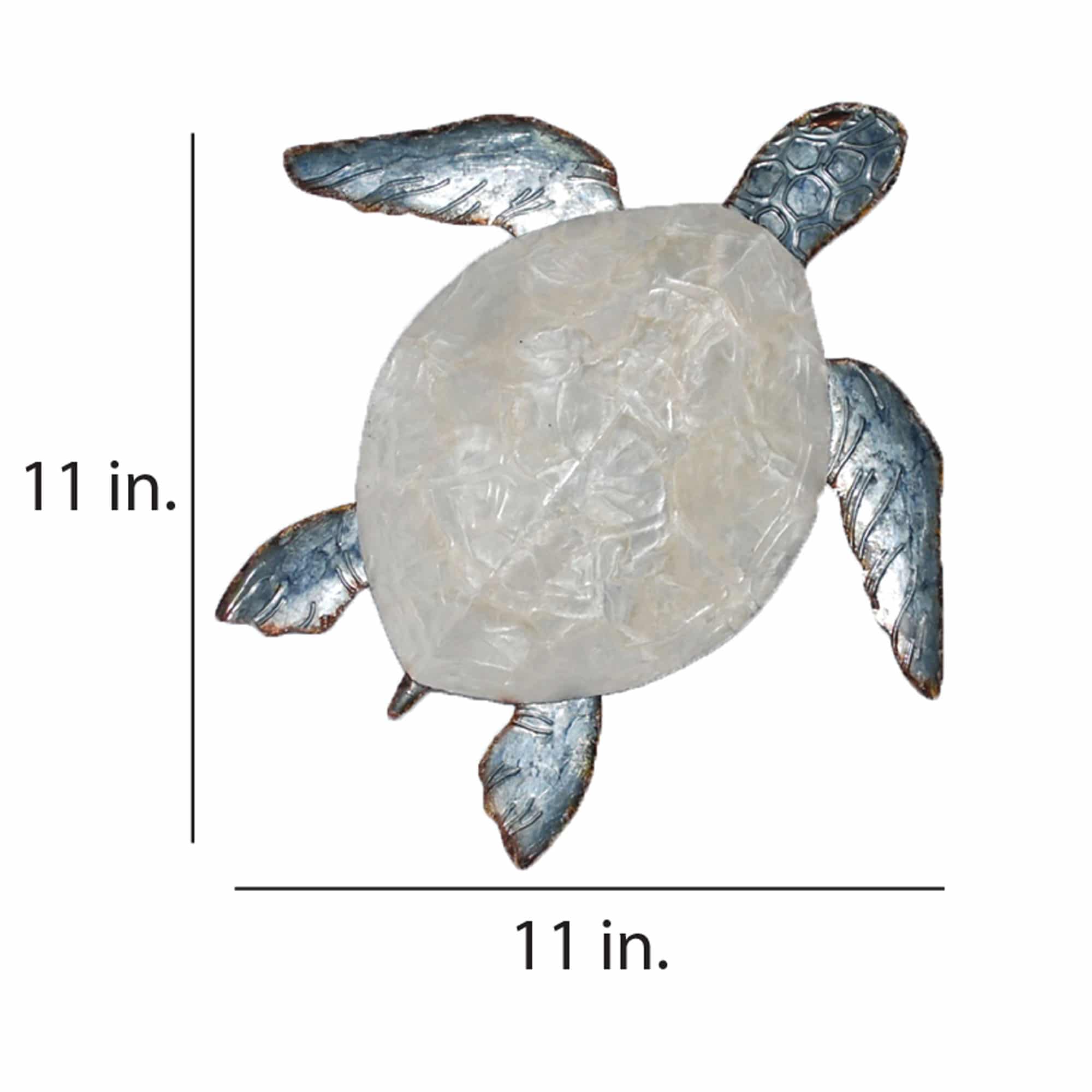
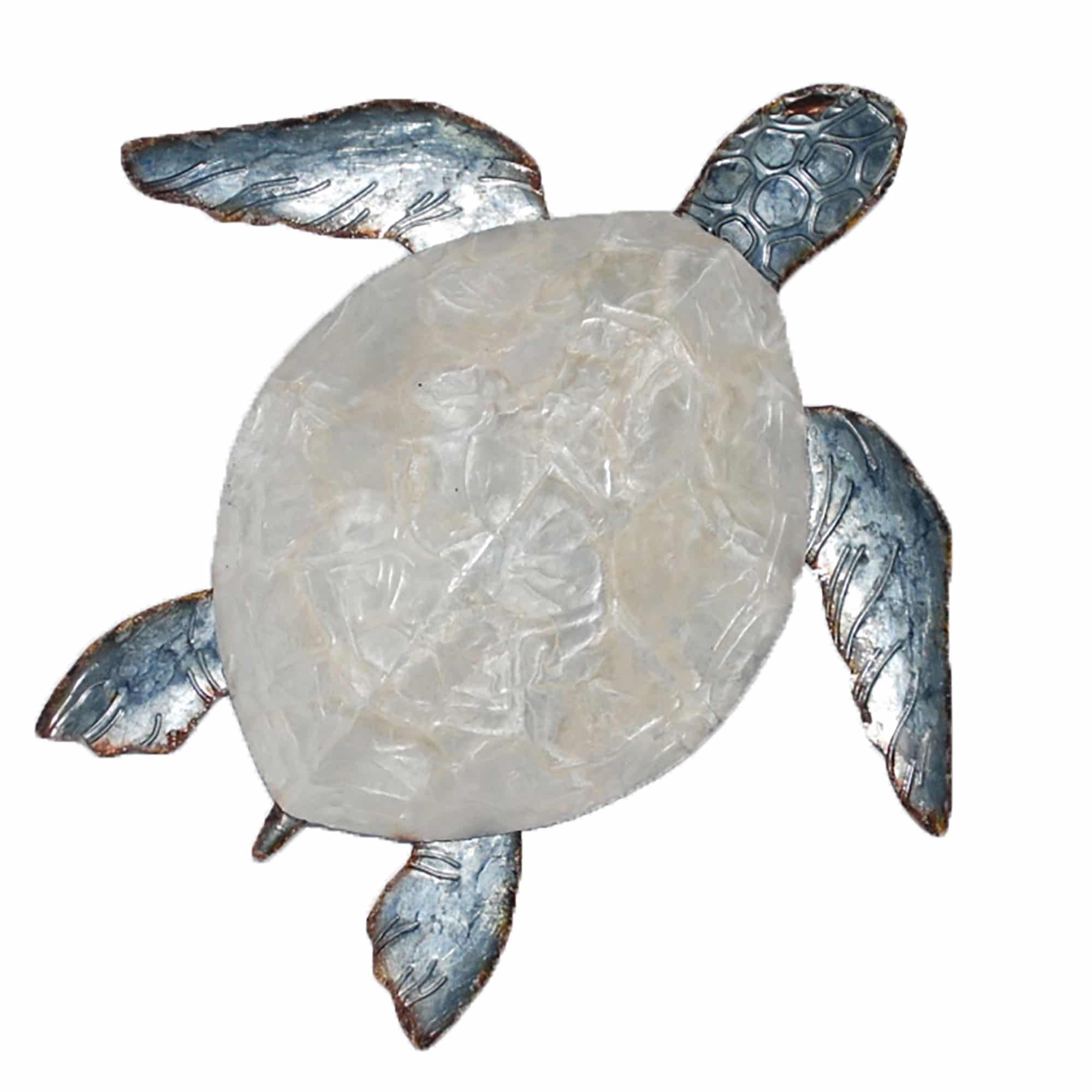 Sea turtles are among the most ancient species on this planet. Today there are seven species of sea turtle remaining that date back 110 million years, back to the age of the dinosaurs. This piece features the Loggerhead turtle, one of the most recognizable of all the sea. This creature is known for its scaled skin, which the artist carefully etches into the metal of the turtle's head and throughout the tips and edges of its body. The shell of the turtle glistens which the artist recreates using capiz shell. The focus of this awe-inspiring piece is the texture and size of sea turtles and the artist uses contrasting colors to underscore this fact. The basic frame of the turtle is created using tin, which is powder coated with a black finish. The frame is reinforced using tin wire along the inner edge. Capiz is an oyster shell and the primary purpose of the oyster is as a source of food. However, the by-product, the shell, can be used for decoration. Due to it being a natural material, the natural colors of the capiz come through as tans and browns underneath the paint. The shell is then painted the bold colors you see. The entire front facing piece is carefully hand-painted keeping in mind the reflective qualities in the color of turtles.
Sea turtles are among the most ancient species on this planet. Today there are seven species of sea turtle remaining that date back 110 million years, back to the age of the dinosaurs. This piece features the Loggerhead turtle, one of the most recognizable of all the sea. This creature is known for its scaled skin, which the artist carefully etches into the metal of the turtle's head and throughout the tips and edges of its body. The shell of the turtle glistens which the artist recreates using capiz shell. The focus of this awe-inspiring piece is the texture and size of sea turtles and the artist uses contrasting colors to underscore this fact. The basic frame of the turtle is created using tin, which is powder coated with a black finish. The frame is reinforced using tin wire along the inner edge. Capiz is an oyster shell and the primary purpose of the oyster is as a source of food. However, the by-product, the shell, can be used for decoration. Due to it being a natural material, the natural colors of the capiz come through as tans and browns underneath the paint. The shell is then painted the bold colors you see. The entire front facing piece is carefully hand-painted keeping in mind the reflective qualities in the color of turtles. -
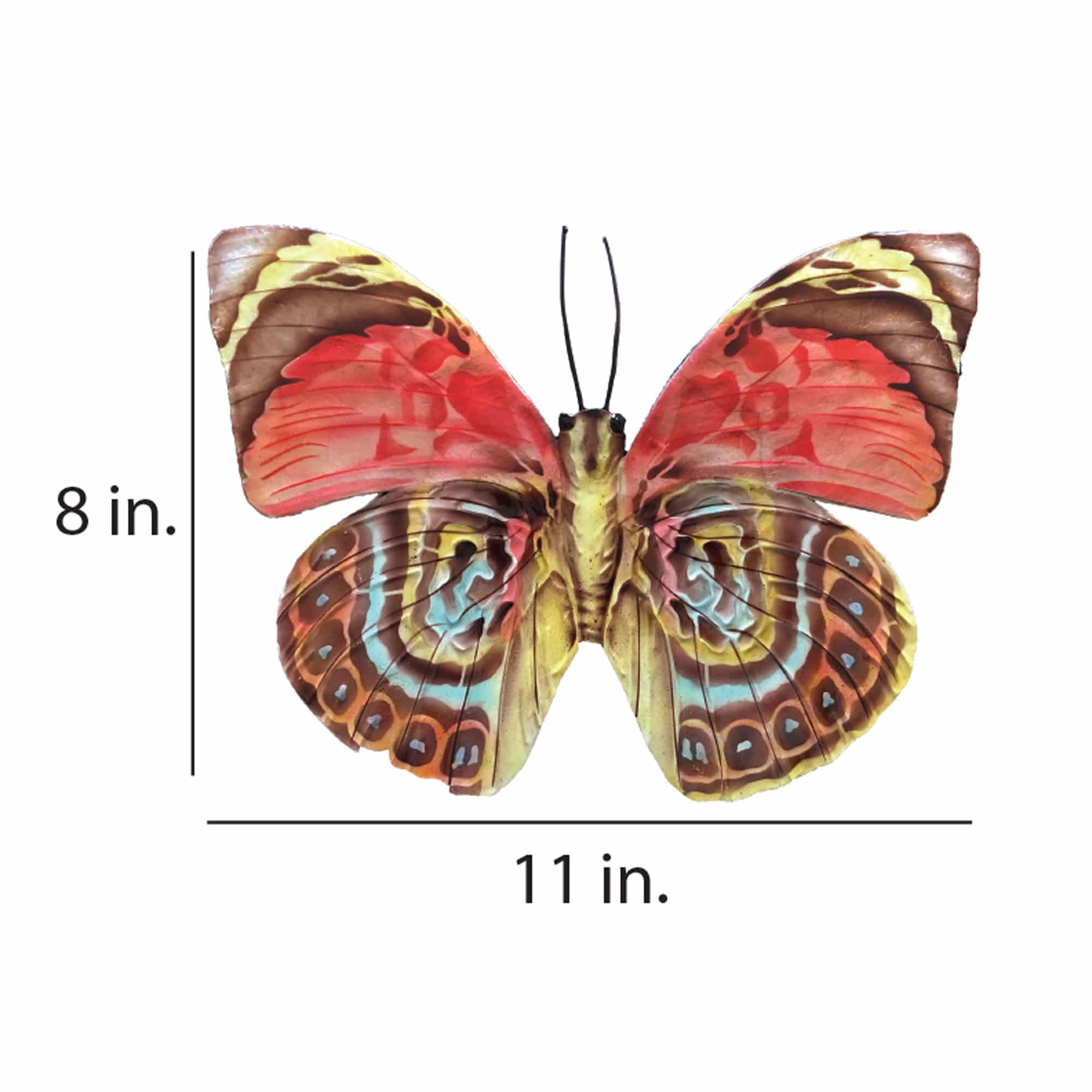
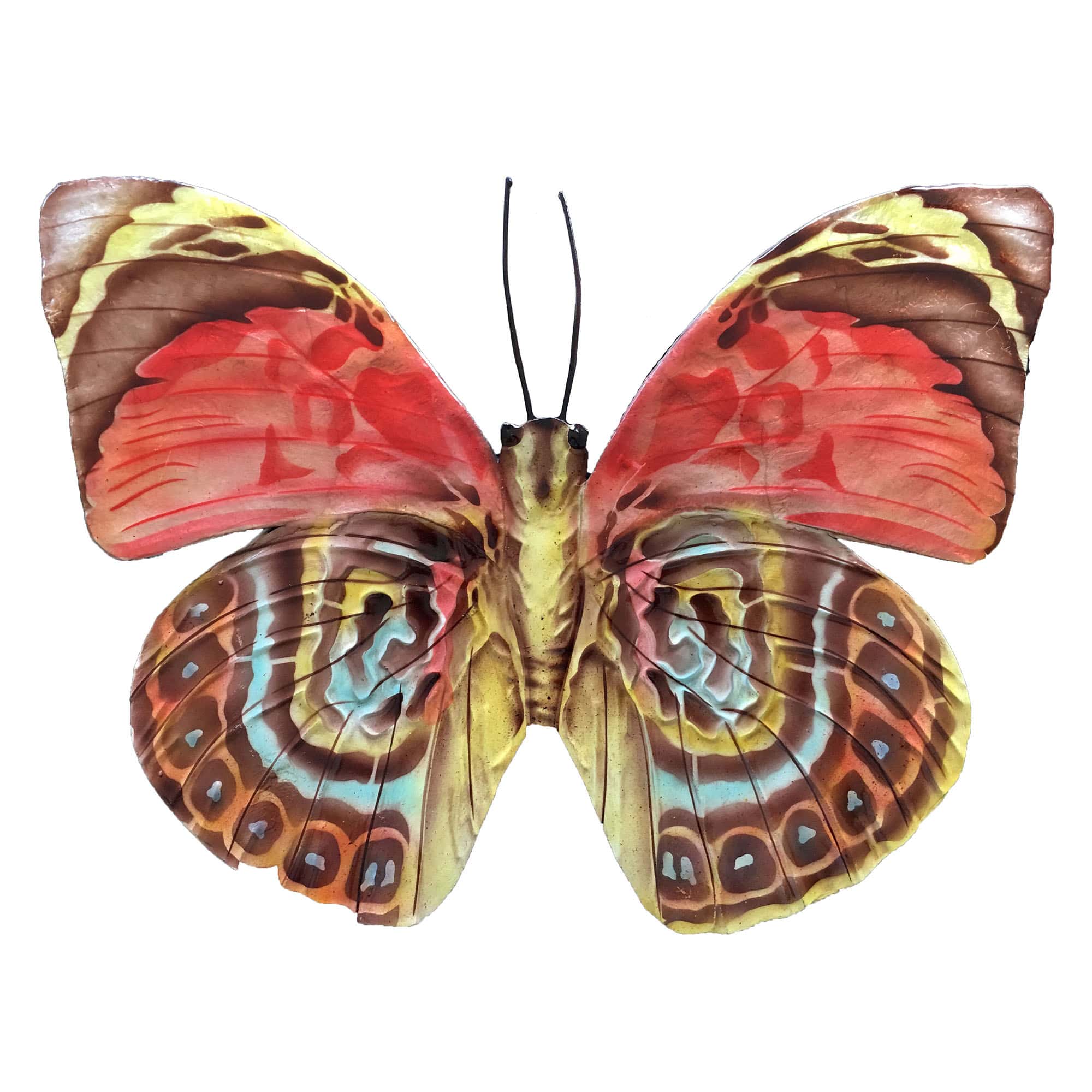
Butterflies are known for their vibrant patterns. The striking contrast of this piece reflects the ability of these insects to hide in plane site through foliage and flowers. The artist uses bright bands of colors to bring this butterfly to life.
The basic frame of the butterfly is created using tin, which is powder-coated with a black finish and makes this piece safe to use outdoors. The edges of the frame are reinforced using thicker tin wire. The front of this piece is adorned in areas with capiz shell, an oyster native to the Philippines, before being hand-painted and sealed with a water-based sealant. The primary purpose of this oyster to provide a source of food, however, the shell is a sustainable by-product that can be used for decoration. The capiz shell subtly replicates the reflective qualities of butterflies in nature. The entire piece is lightweight and has an eyelet in the back allowing it to be hung using a finishing nail, command strip, or a push pin. Due to it being a natural material, the organic colors of capiz come through as tans and browns underneath the paint.
-
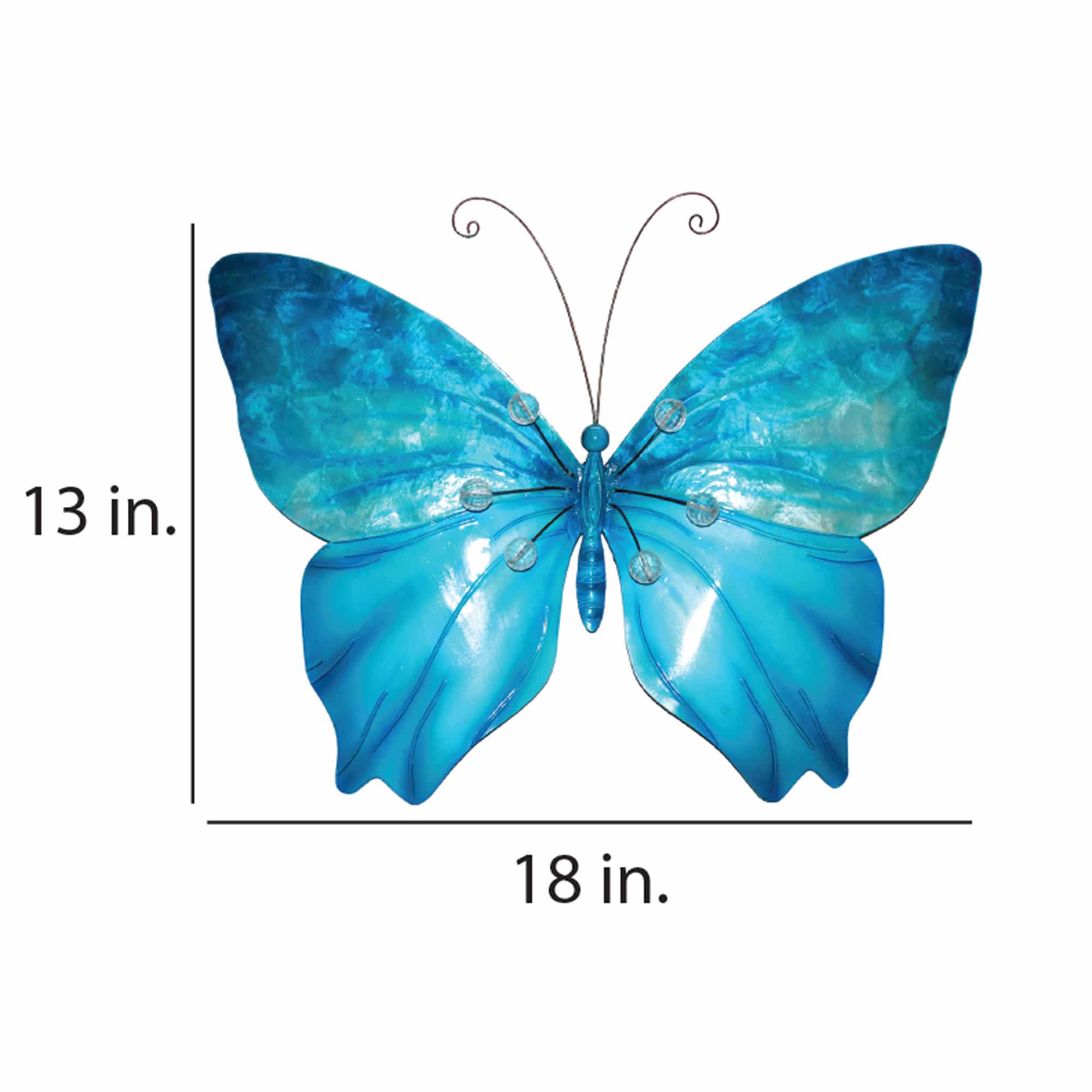
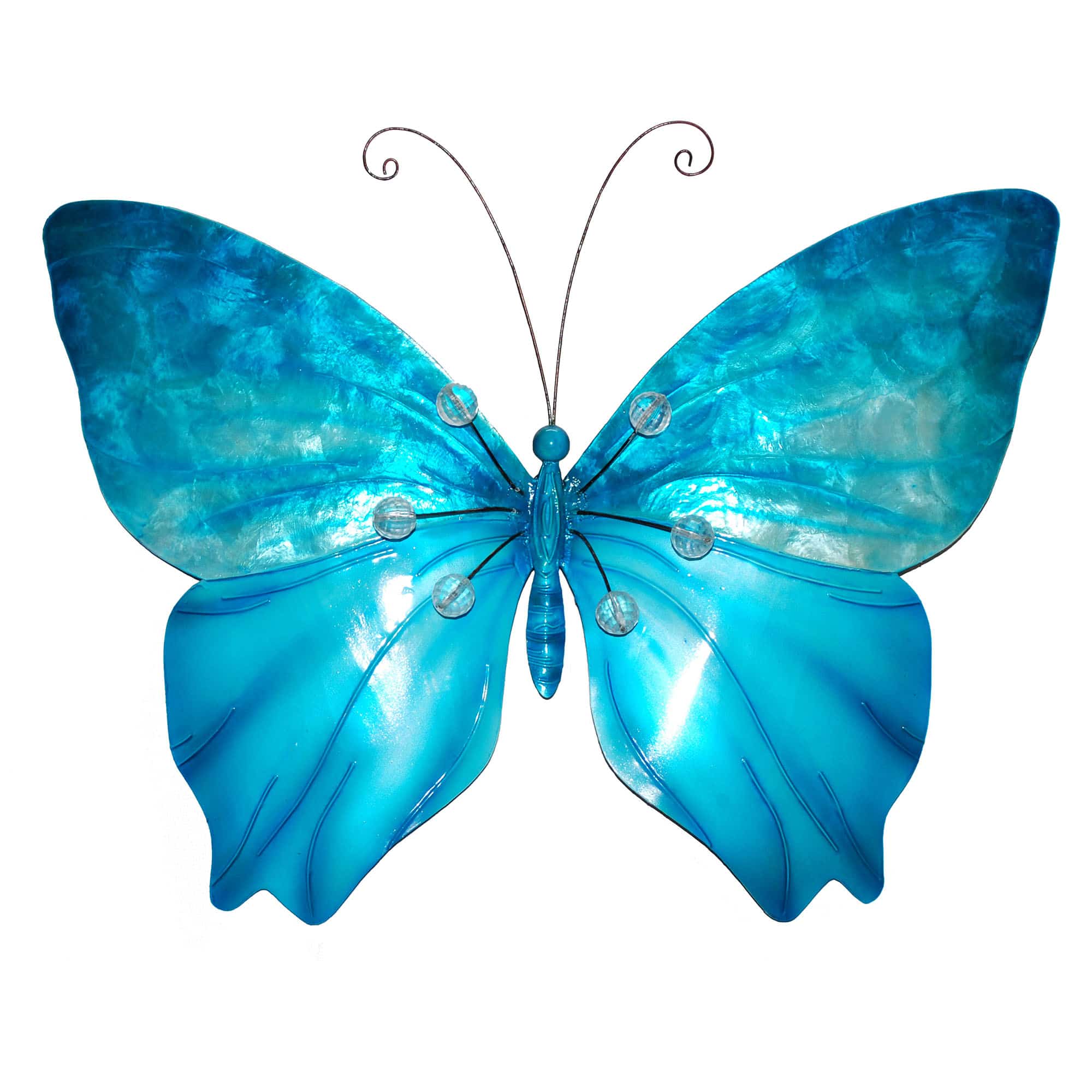
This piece showcases a bright, blue body strong in aqua tones. The upper wings glisten from the inlay of shell work; each shell absorbing and reflecting light differently than its neighbor. The lower wings contrast with a softer, satin, blue finish. As added detail, the metal in the lower wing is pressed to represent the artist's view of the wing's components. Beads radiate from the center of the butterfly, almost making it feel as if this butterfly is transforming from a flower into its animal form.
The basic frame of the butterfly is created using tin, which is powder-coated with a black finish and makes this piece safe to use outdoors. The edges of the frame are reinforced using thicker tin wire. The front of this piece is adorned in areas with capiz shell, an oyster native to the Philippines, before being hand-painted and sealed with a water-based sealant. The primary purpose of this oyster to provide a source of food, however, the shell is a sustainable by-product that can be used for decoration. The capiz shell subtly replicates the reflective qualities of butterflies in nature. The entire piece is lightweight and has an eyelet in the back allowing it to be hung using a finishing nail, command strip, or a push pin. Due to it being a natural material, the organic colors of capiz come through as tans and browns underneath the paint.
-

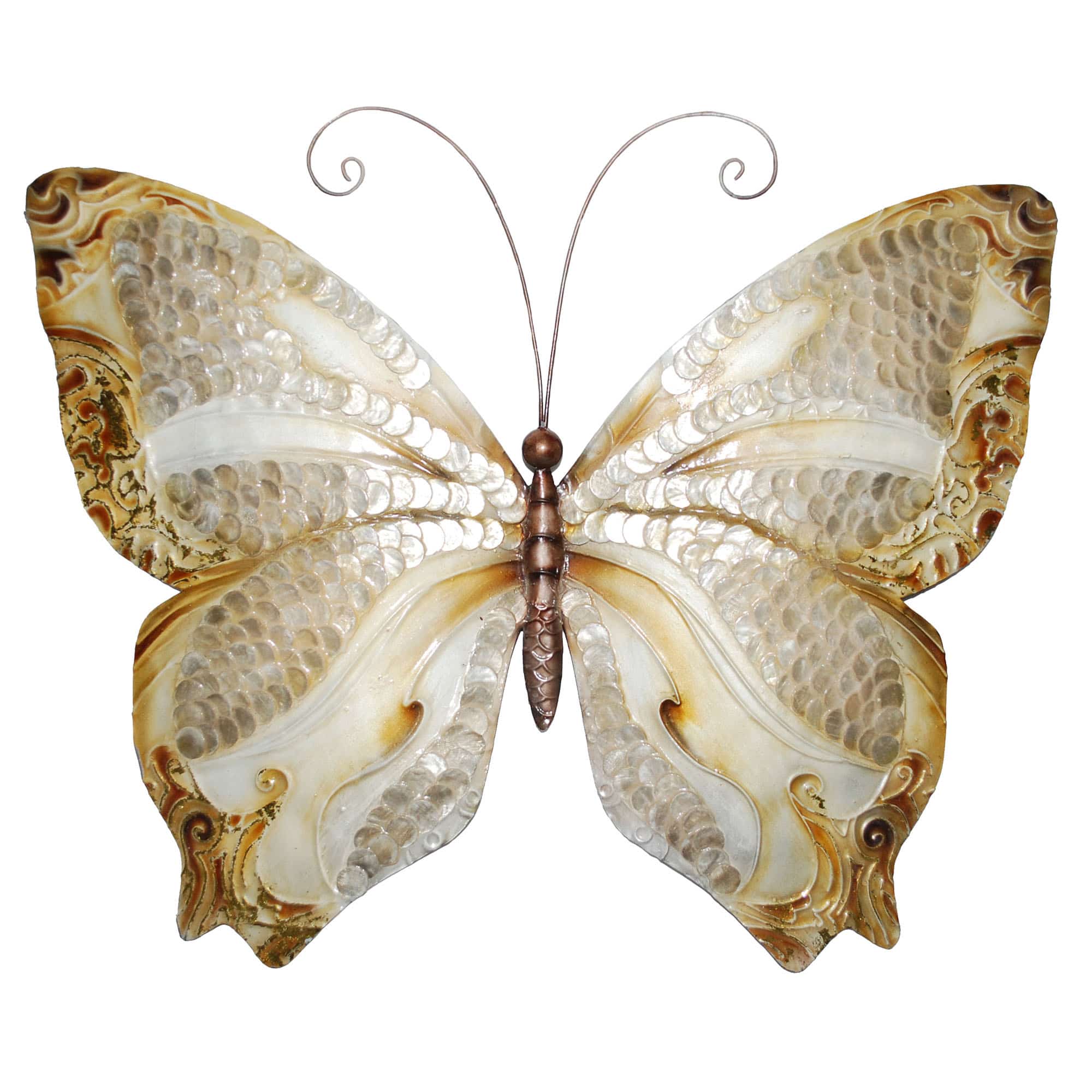
This butterfly sports a flowing fish scale pattern of shell radiating from its center to its wingtips. The artisan details the butterfly in gold flakes and different hues of brown, while the texture of the shell is complemented with three dimensional features within the metalwork. The warm neutral tones make this a very versatile piece that fits many color schemes.
The basic frame of the butterfly is created using tin, which is powder-coated with a black finish and makes this piece safe to use outdoors. The edges of the frame are reinforced using thicker tin wire. The front of this piece is adorned in areas with capiz shell, an oyster native to the Philippines, before being hand-painted and sealed with a water-based sealant. The primary purpose of this oyster to provide a source of food, however, the shell is a sustainable by-product that can be used for decoration. The capiz shell subtly replicates the reflective qualities of butterflies in nature. The entire piece is lightweight and has an eyelet in the back allowing it to be hung using a finishing nail, command strip, or a push pin. Due to it being a natural material, the organic colors of capiz come through as tans and browns underneath the paint.
-
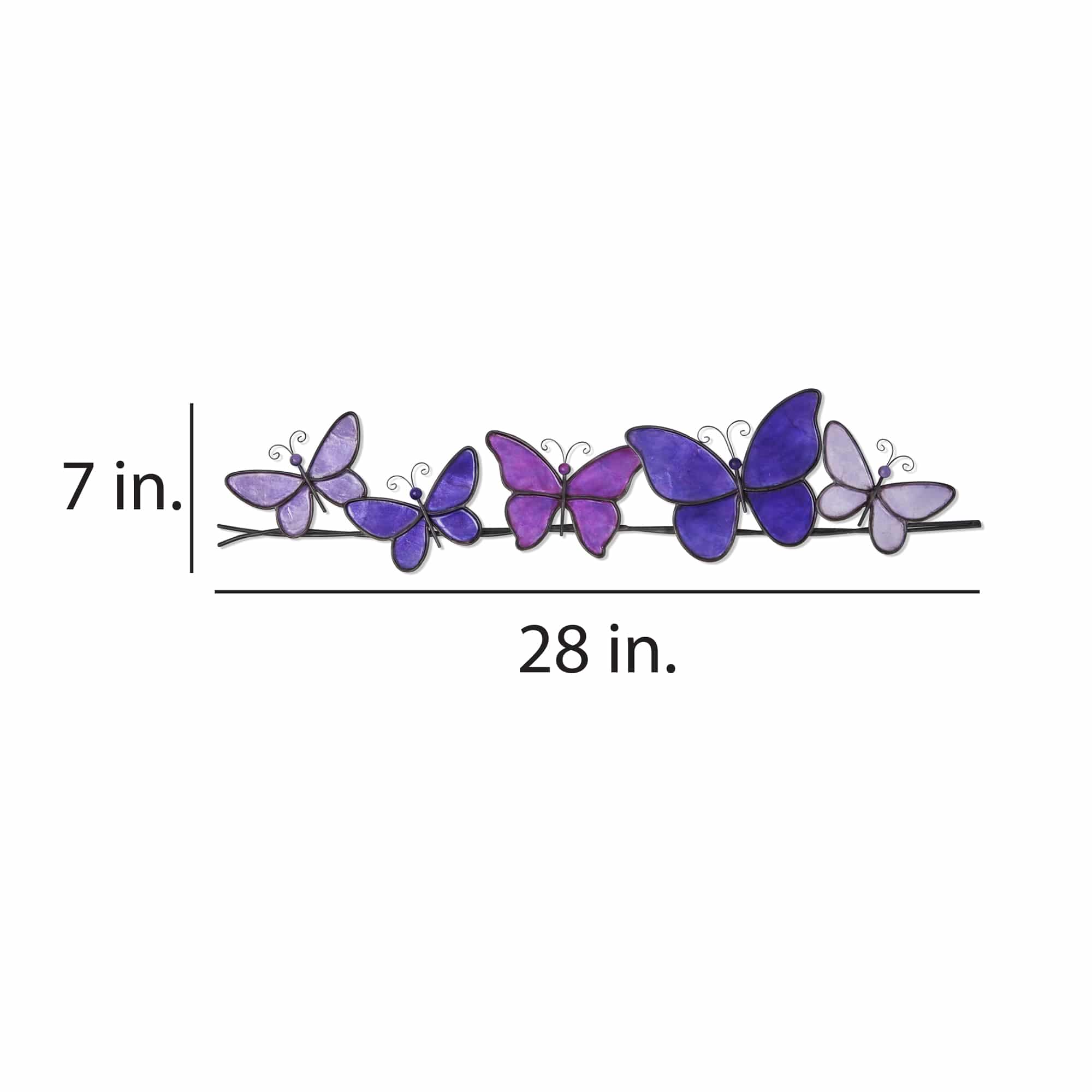
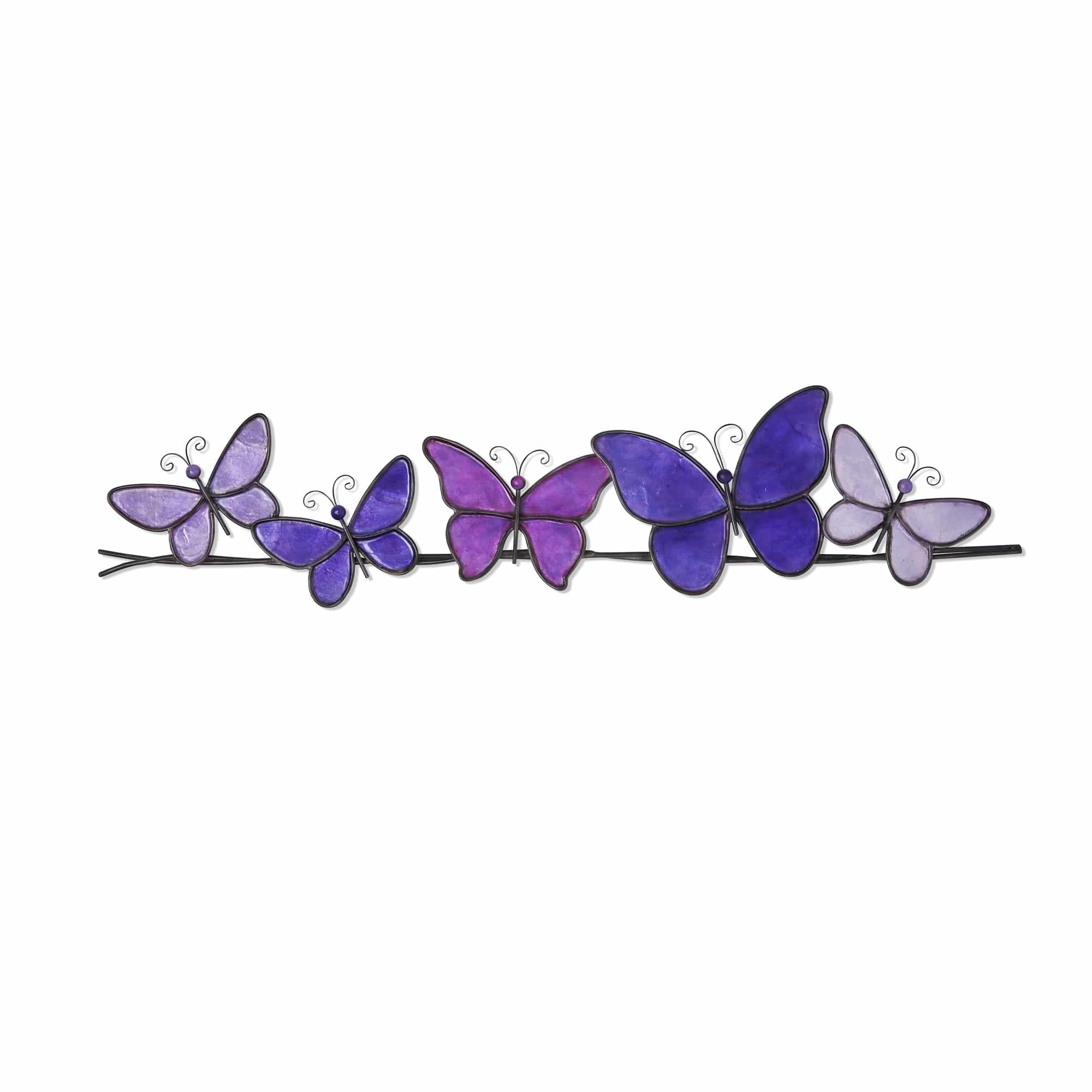
Five, fluttering butterflies are ready to complete their journey after taking a break from a long migration. The slender, metal body of each butterfly connects to colorful capiz-shell wings which catches light and adds shine. Each wing is framed using sturdy wrought iron and reinforced with a metal backing.
The basic frame of the butterfly is created using tin, which is powder-coated with a black finish and makes this piece safe to use outdoors. The edges of the frame are reinforced using thicker tin wire. The front of this piece is adorned in areas with capiz shell, an oyster native to the Philippines, before being hand-painted and sealed with a water-based sealant. The primary purpose of this oyster to provide a source of food, however, the shell is a sustainable by-product that can be used for decoration. The capiz shell subtly replicates the reflective qualities of butterflies in nature. The entire piece is lightweight and has an eyelet in the back allowing it to be hung using a finishing nail, command strip, or a push pin. Due to it being a natural material, the organic colors of capiz come through as tans and browns underneath the paint.
-
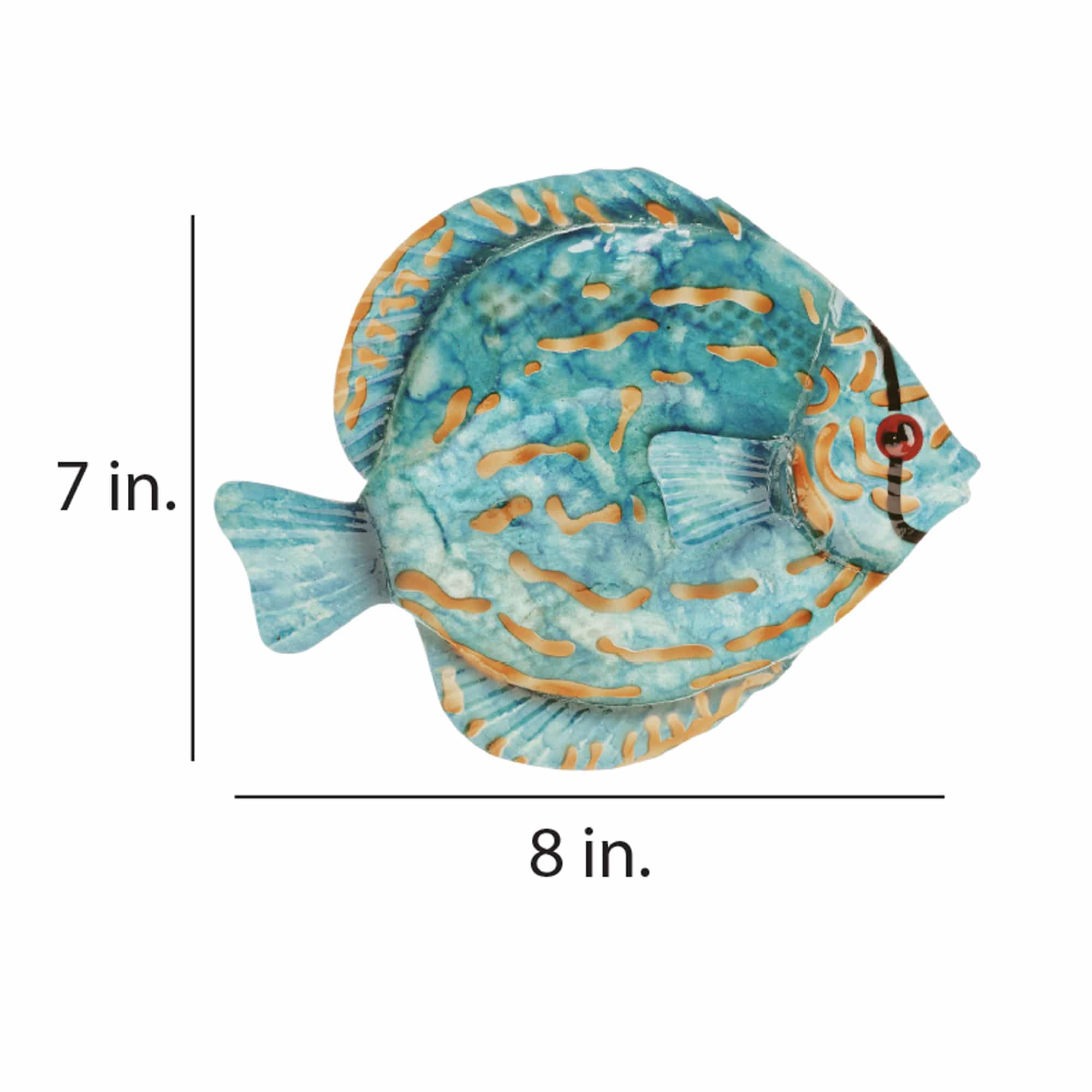
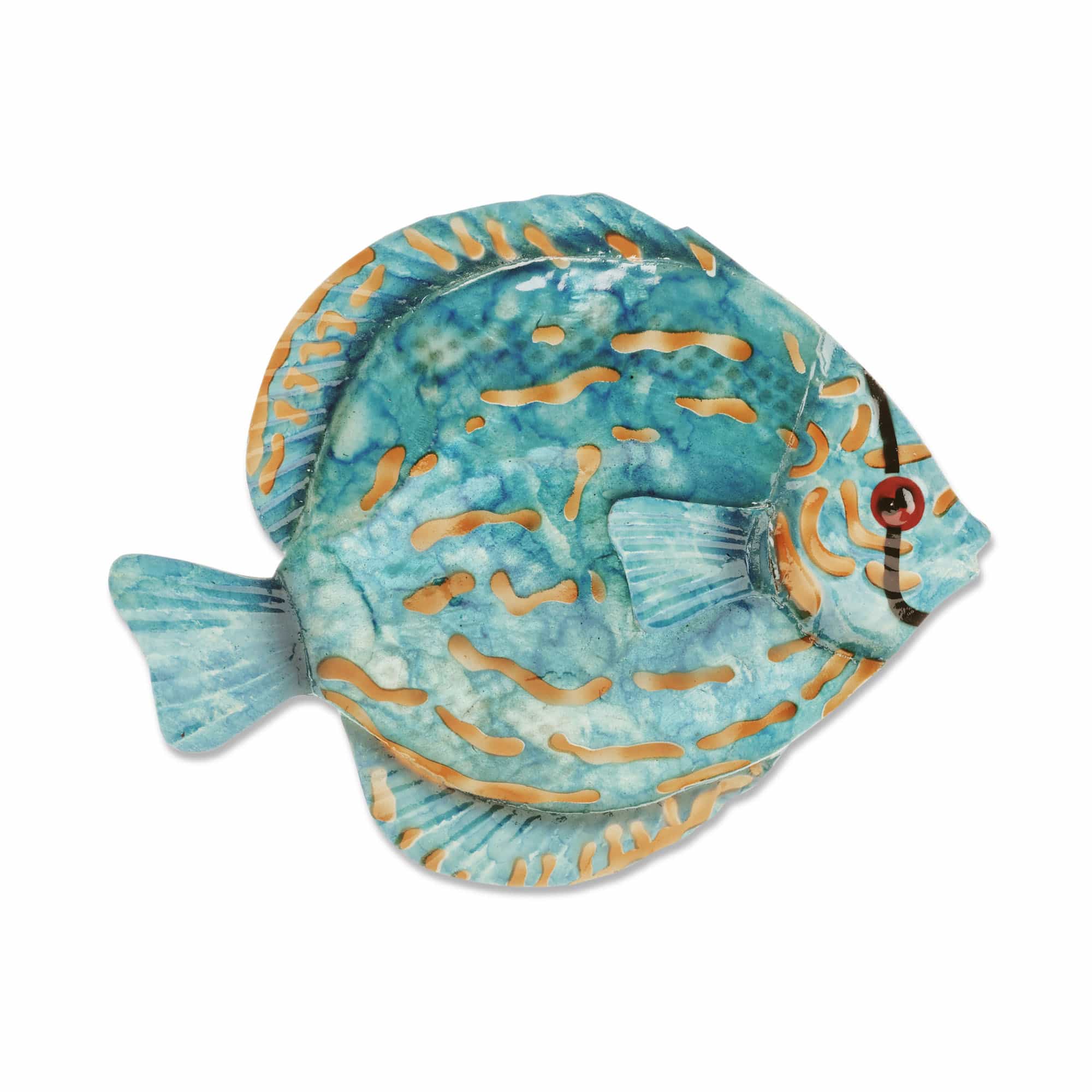 The discus fish is native to the Amazon river basin. These fish are known for their distinctive shape, bright colors, and unique patterns. The artist who painted this fish paid attention to the interact color patterns. Using capiz shell, he emulated the natural scales of this fish. The basic frame of the wall fish is created using tin, which is powder coated as a black finish. The frame is reinforced using wrought iron wire along the inner edge. Capiz is an oyster shell and the primary purpose of the oyster is as a source of food. However, the by-product, the shell, can be used for decoration. Due to it being a natural material, the natural colors of the capiz can come through as tans and browns underneath the paint.
The discus fish is native to the Amazon river basin. These fish are known for their distinctive shape, bright colors, and unique patterns. The artist who painted this fish paid attention to the interact color patterns. Using capiz shell, he emulated the natural scales of this fish. The basic frame of the wall fish is created using tin, which is powder coated as a black finish. The frame is reinforced using wrought iron wire along the inner edge. Capiz is an oyster shell and the primary purpose of the oyster is as a source of food. However, the by-product, the shell, can be used for decoration. Due to it being a natural material, the natural colors of the capiz can come through as tans and browns underneath the paint. -

 The clown fish is one of the most iconic saltwater fish in the world. The artist wanted to make sure to capture this fish and all of what makes him stand out; therefore, instead of just a solid orange, the orange portrayed in varying shades to signify the variation one would see when up close to the fish. The scales of the Clown fish is enhanced by using capiz shell throughout the body of the fish, so when one hangs this fish up it will reflect and bounce the light in different ways. The basic frame of the wall fish is created using tin, which is powder coated as a black finish. The frame is reinforced using wrought iron wire along the inner edge. Capiz is an oyster shell and the primary purpose of the oyster is as a source of food. However, the by-product, the shell, can be used for decoration. Due to it being a natural material, the natural colors of the capiz can come through as tans and browns underneath the paint.
The clown fish is one of the most iconic saltwater fish in the world. The artist wanted to make sure to capture this fish and all of what makes him stand out; therefore, instead of just a solid orange, the orange portrayed in varying shades to signify the variation one would see when up close to the fish. The scales of the Clown fish is enhanced by using capiz shell throughout the body of the fish, so when one hangs this fish up it will reflect and bounce the light in different ways. The basic frame of the wall fish is created using tin, which is powder coated as a black finish. The frame is reinforced using wrought iron wire along the inner edge. Capiz is an oyster shell and the primary purpose of the oyster is as a source of food. However, the by-product, the shell, can be used for decoration. Due to it being a natural material, the natural colors of the capiz can come through as tans and browns underneath the paint. -
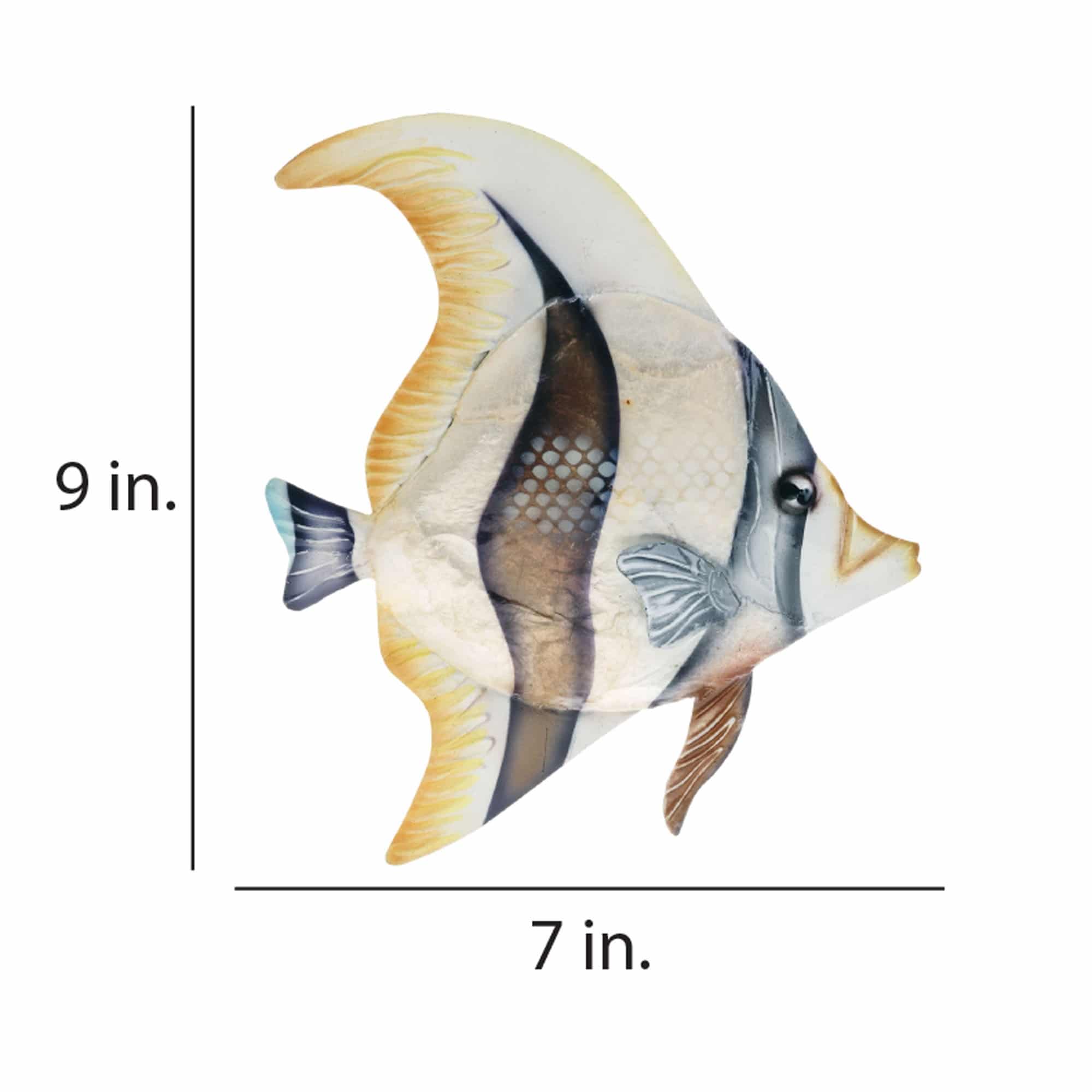
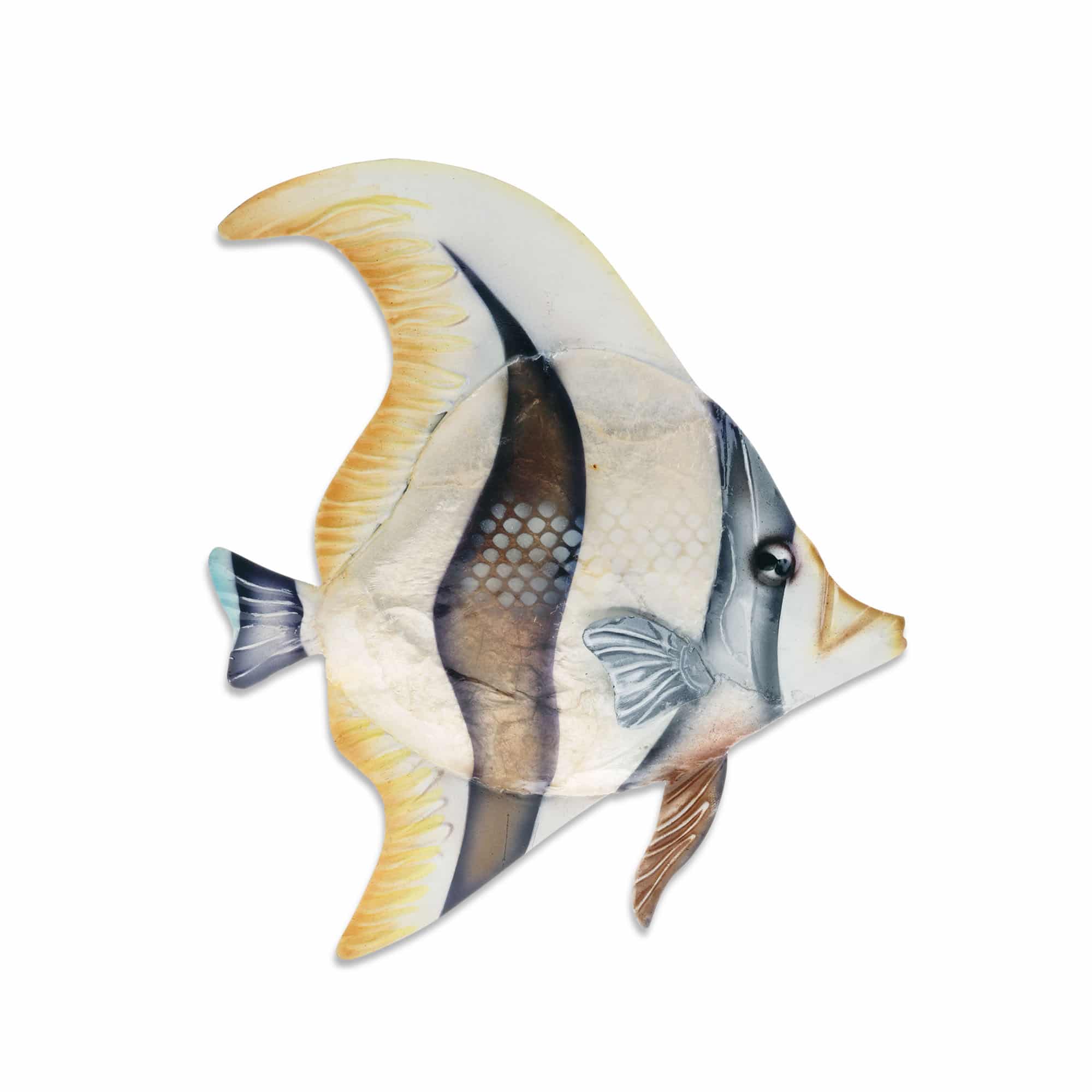 With its contrast of black and yellow and long iconic dorsal fin, the Moorish Idol Angle is well recognized by aquatic hobbyist and novices alike. This moderately peaceful fish is found throughout the southern hemisphere. The artist took great care on showing the big details common to the fish, but on closer examination one will see some color variations and shading in the paint itself. The scales of the Angelfish is pronounced using capiz shell throughout the body of the fish, so when one hangs this fish up it will reflect and bounce the light in different ways. The basic frame of the Moorish Idol Angelfish Wall Decor is created using tin, which is powder coated as a black finish. The frame is reinforced using wrought iron wire along the inner edge. Capiz is an oyster shell and the primary purpose of the oyster is as a source of food. However, the by-product, the shell, can be used for decoration. Due to it being a natural material, the natural colors of the capiz can come through as tans and browns underneath the paint.
With its contrast of black and yellow and long iconic dorsal fin, the Moorish Idol Angle is well recognized by aquatic hobbyist and novices alike. This moderately peaceful fish is found throughout the southern hemisphere. The artist took great care on showing the big details common to the fish, but on closer examination one will see some color variations and shading in the paint itself. The scales of the Angelfish is pronounced using capiz shell throughout the body of the fish, so when one hangs this fish up it will reflect and bounce the light in different ways. The basic frame of the Moorish Idol Angelfish Wall Decor is created using tin, which is powder coated as a black finish. The frame is reinforced using wrought iron wire along the inner edge. Capiz is an oyster shell and the primary purpose of the oyster is as a source of food. However, the by-product, the shell, can be used for decoration. Due to it being a natural material, the natural colors of the capiz can come through as tans and browns underneath the paint. -
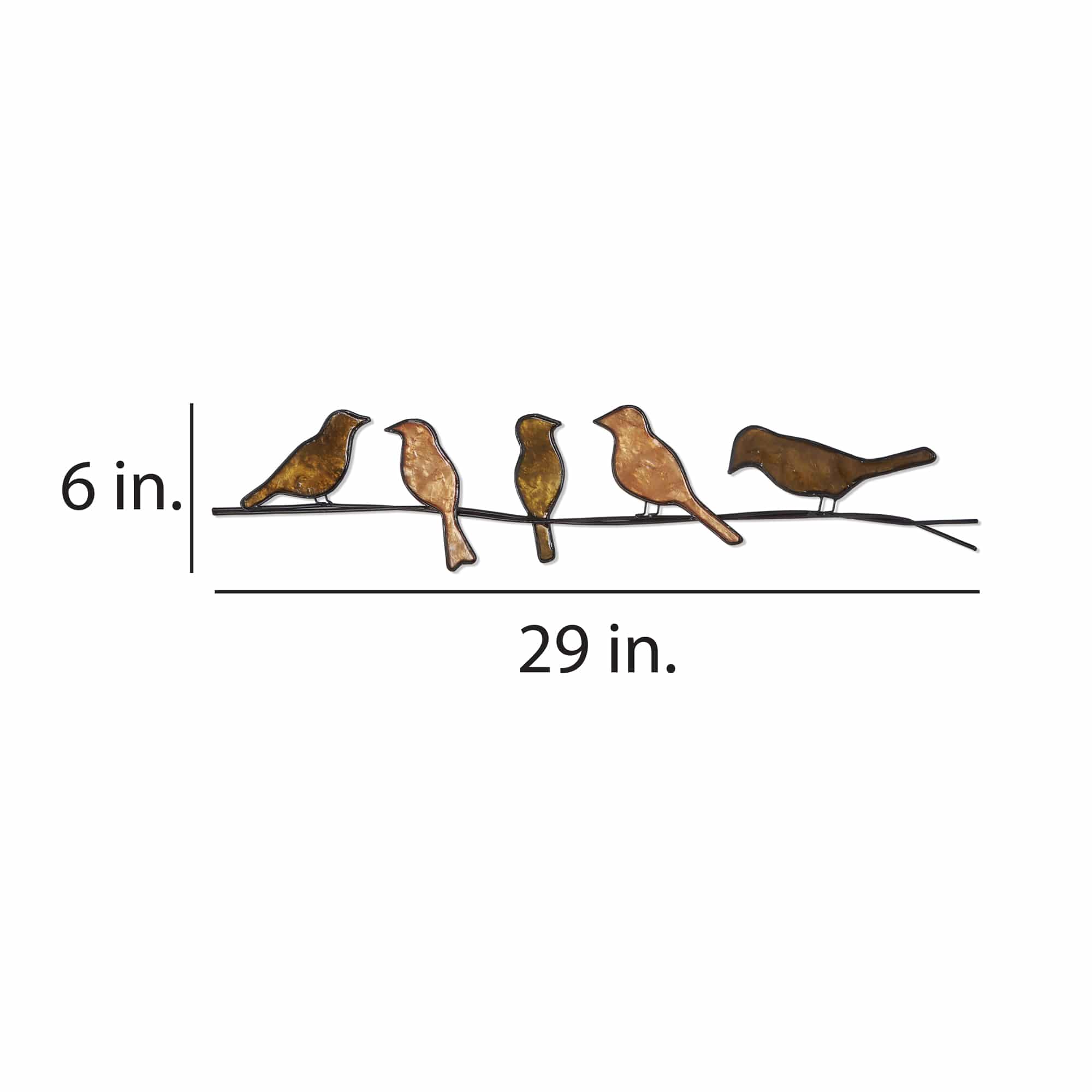
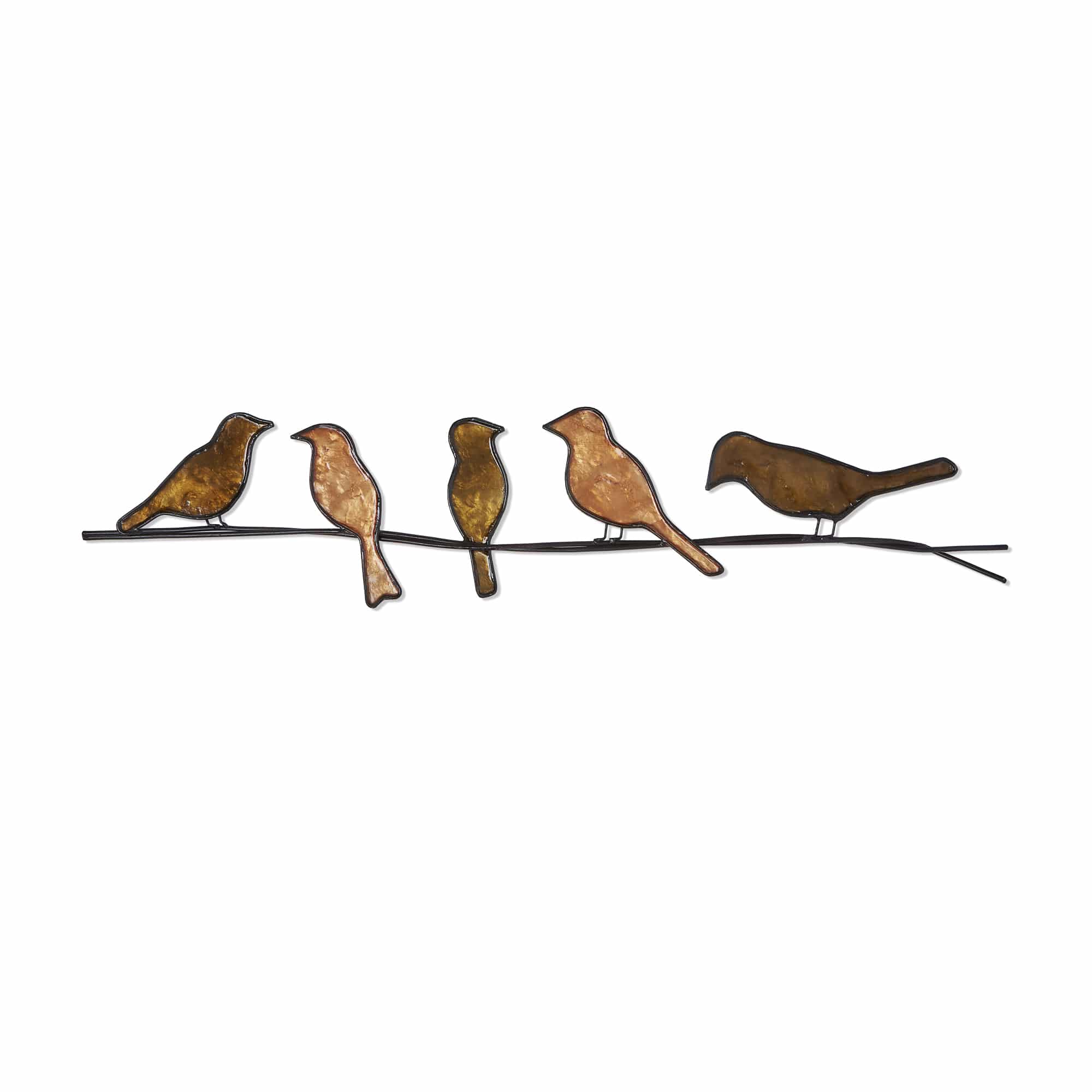 An old parable states that five birds were resting on a wire. Two decided to fly south. How many were birds are left? One's initial answer may be three, however, the answer is still five. The moral of the fable is actions are more important than intention; a kind reminder that a truer picture of one's character is drawn by actions. The artisan captures this parable by lining up five birds socializing on a wire. The basic frame of this piece is created using tin, which is powder coated with a black finish. The frame is reinforced using tin wire along the inner edge. The front of the body is adorned with capiz. Capiz is an oyster shell and the primary purpose of the oyster is as a source of food. However, the by-product, the shell, can be used for decoration. Due to it being a natural material, the natural colors of the capiz may come through as tans and browns underneath the hand-painted surface.
An old parable states that five birds were resting on a wire. Two decided to fly south. How many were birds are left? One's initial answer may be three, however, the answer is still five. The moral of the fable is actions are more important than intention; a kind reminder that a truer picture of one's character is drawn by actions. The artisan captures this parable by lining up five birds socializing on a wire. The basic frame of this piece is created using tin, which is powder coated with a black finish. The frame is reinforced using tin wire along the inner edge. The front of the body is adorned with capiz. Capiz is an oyster shell and the primary purpose of the oyster is as a source of food. However, the by-product, the shell, can be used for decoration. Due to it being a natural material, the natural colors of the capiz may come through as tans and browns underneath the hand-painted surface. -


This dragonfly pays homage to the Indian peacock and its iridescent blue and green metallic plumage. Each wing has the distinctive eyespot for which this peacock is known. Bold and impossible to miss, the dramatic peacock design on this dragonfly glistens. The vibrant golds, blues and greens contrast in style. This dragonfly will add a strong punch of color to any room.
The basic frame of the dragonfly is created using tin, which is powder-coated with a black finish and makes this piece safe to use outdoors. The edges of the frame are reinforced using thicker tin wire. The front of this piece is adorned in areas with capiz shell, an oyster native to the Philippines, before being hand-painted and sealed with a water-based sealant. The primary purpose of this oyster to provide a source of food, however, the shell is a sustainable by-product that can be used for decoration. The capiz shell subtly replicates the reflective qualities of dragonflies in nature. The entire piece is lightweight and has an eyelet in the back allowing it to be hung using a finishing nail, command strip, or a push pin. Due to it being a natural material, the organic colors of capiz come through as tans and browns underneath the paint.
-

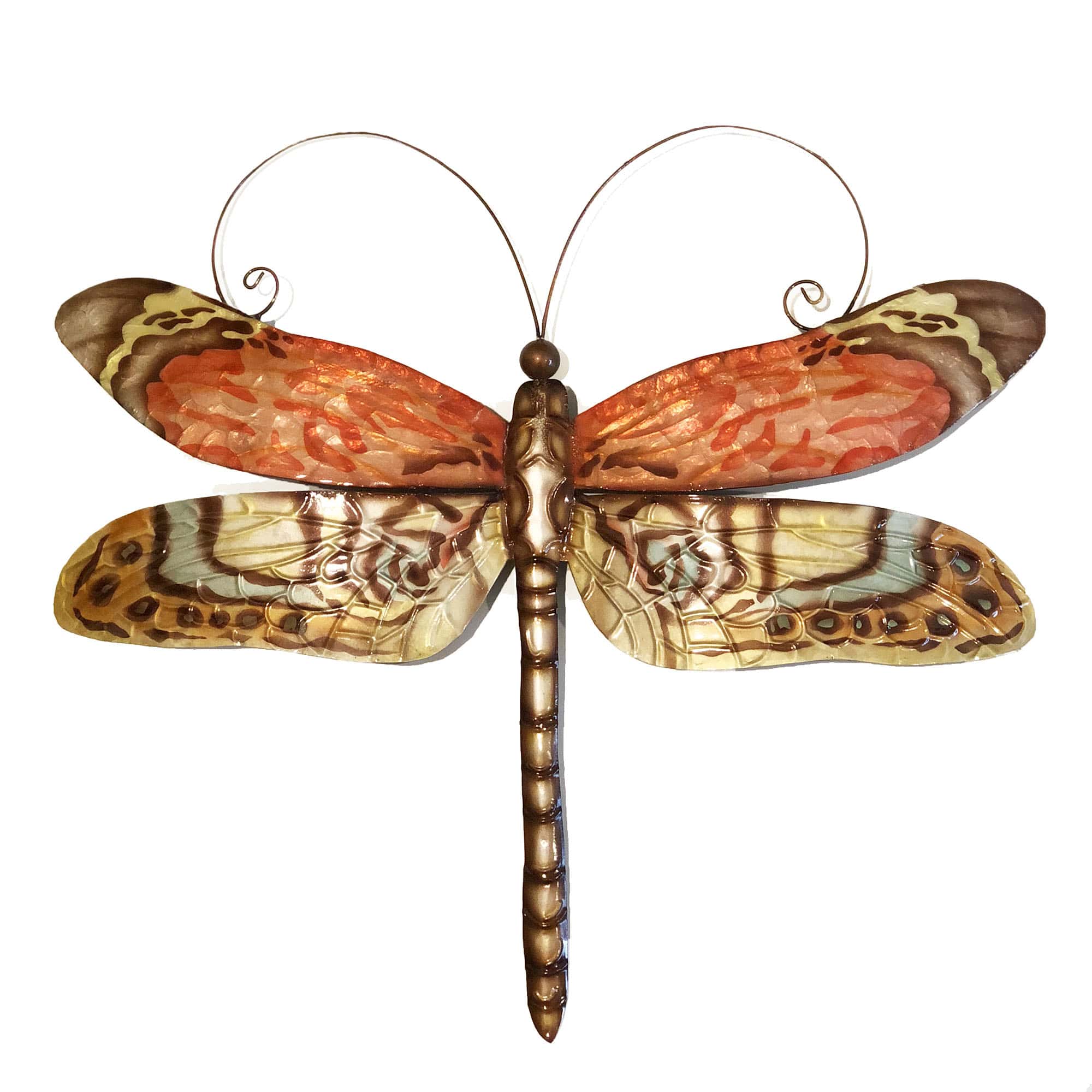
This festively colored dragonfly will brighten any room with its mix of colors hand-painted in intricate detailed patterns. A mix of metal and capiz shell will highlight texture and the capiz will give it a translucent feel as it reflects and bounces the colors.
The basic frame of the dragonfly is created using tin, which is powder-coated with a black finish and makes this piece safe to use outdoors. The edges of the frame are reinforced using thicker tin wire. The front of this piece is adorned in areas with capiz shell, an oyster native to the Philippines, before being hand-painted and sealed with a water-based sealant. The primary purpose of this oyster to provide a source of food, however, the shell is a sustainable by-product that can be used for decoration. The capiz shell subtly replicates the reflective qualities of dragonflies in nature. The entire piece is lightweight and has an eyelet in the back allowing it to be hung using a finishing nail, command strip, or a push pin. Due to it being a natural material, the organic colors of capiz come through as tans and browns underneath the paint.
-
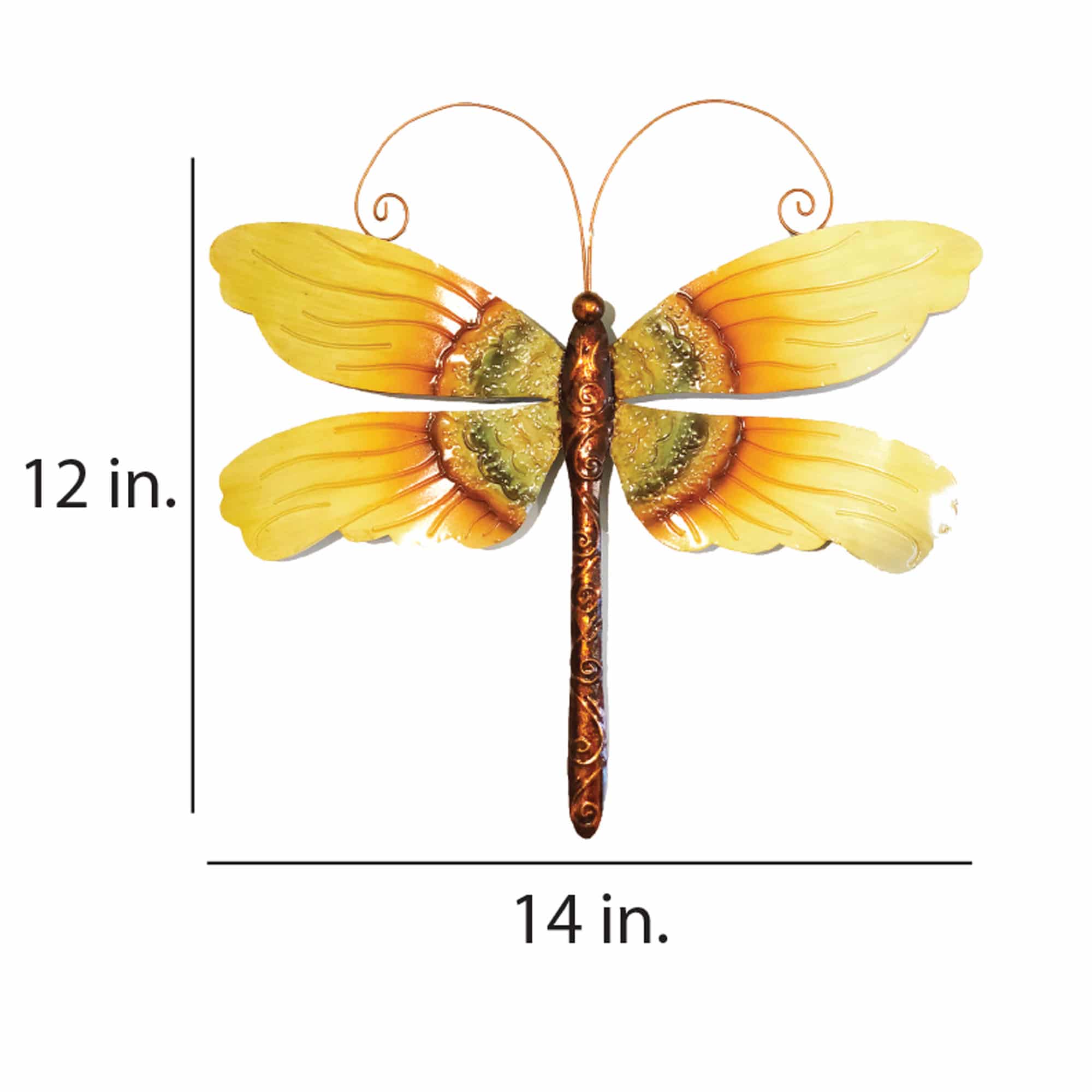
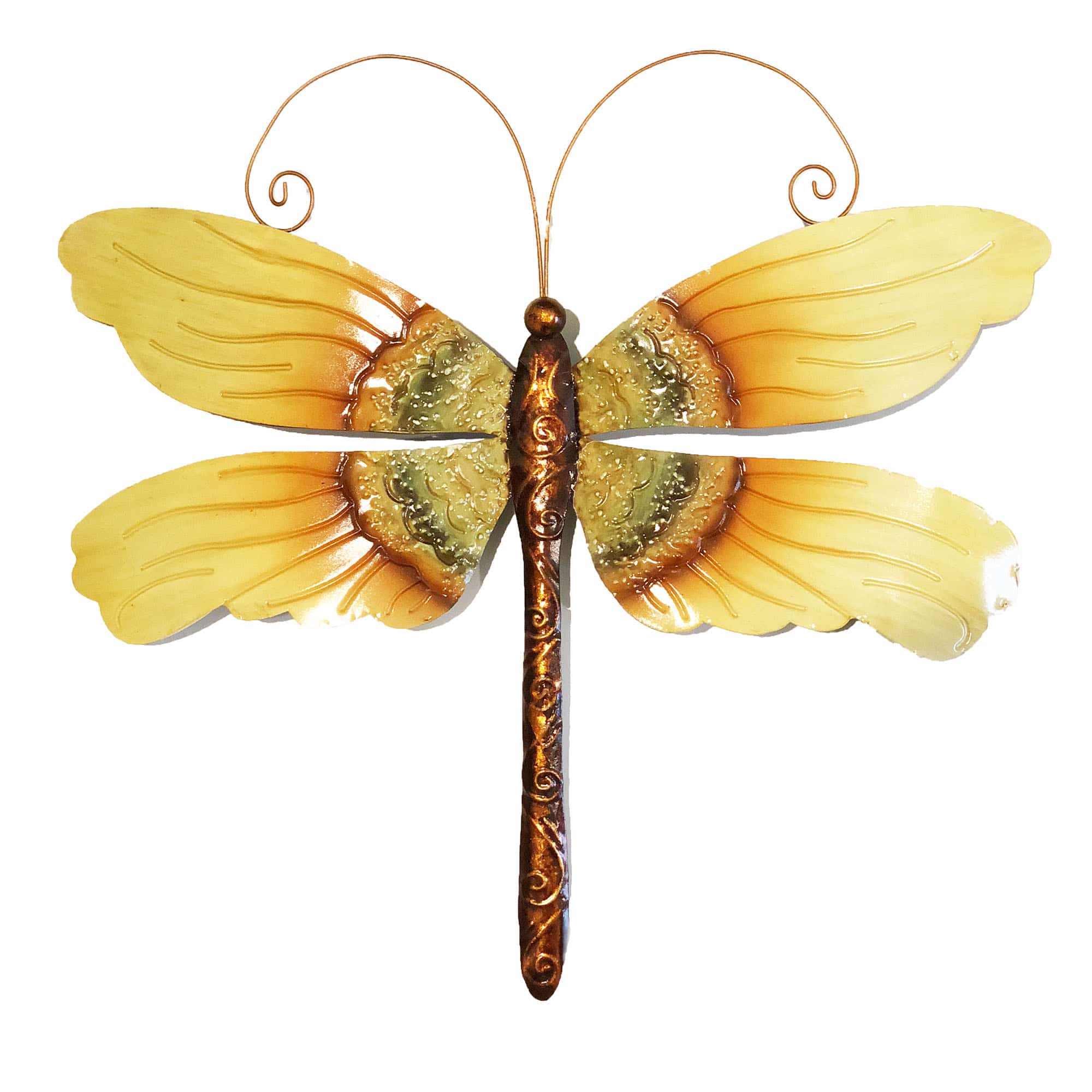 Subtle brown leaves curling and two sunflowers in full bloom provides the feeling of transition from summer to autumn. Even the base color is in the brown hue, enhancing the seasonal transition. The basic frame of the dragonfly is created using tin, which is powder-coated with a black finish and makes this piece safe to use outdoors. The edges of the frame are reinforced using thicker tin wire. The front of this piece is hand-painted and sealed with a water-based sealant. The entire piece is lightweight and has an eyelet in the back allowing it to be hung using a finishing nail, command strip, or a push pin. Due to it being a natural material, the organic colors of capiz come through as tans and browns underneath the paint.
Subtle brown leaves curling and two sunflowers in full bloom provides the feeling of transition from summer to autumn. Even the base color is in the brown hue, enhancing the seasonal transition. The basic frame of the dragonfly is created using tin, which is powder-coated with a black finish and makes this piece safe to use outdoors. The edges of the frame are reinforced using thicker tin wire. The front of this piece is hand-painted and sealed with a water-based sealant. The entire piece is lightweight and has an eyelet in the back allowing it to be hung using a finishing nail, command strip, or a push pin. Due to it being a natural material, the organic colors of capiz come through as tans and browns underneath the paint. -

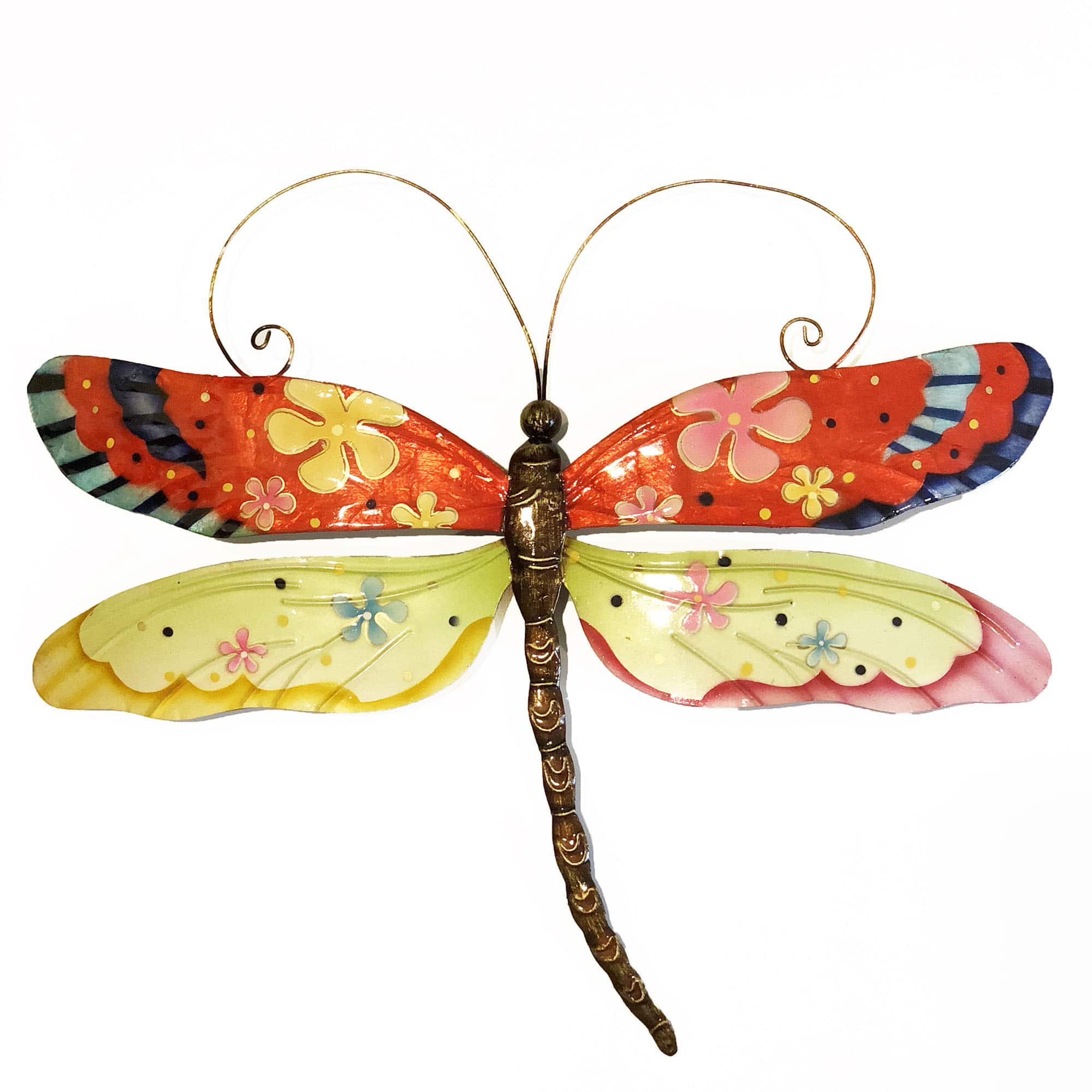
Colorful, fun, and full of cheer, this dragonfly gets its influence from the flower power movement of years past. Designed to stand out, this piece adds a powerful pop of color and pizzazz to any space.
The basic frame of the dragonfly is created using tin, which is powder-coated with a black finish and makes this piece safe to use outdoors. The edges of the frame are reinforced using thicker tin wire. The front of this piece is adorned in areas with capiz shell, an oyster native to the Philippines, before being hand-painted and sealed with a water-based sealant. The primary purpose of this oyster to provide a source of food, however, the shell is a sustainable by-product that can be used for decoration. The capiz shell subtly replicates the reflective qualities of dragonflies in nature. The entire piece is lightweight and has an eyelet in the back allowing it to be hung using a finishing nail, command strip, or a push pin. Due to it being a natural material, the organic colors of capiz come through as tans and browns underneath the paint.
-
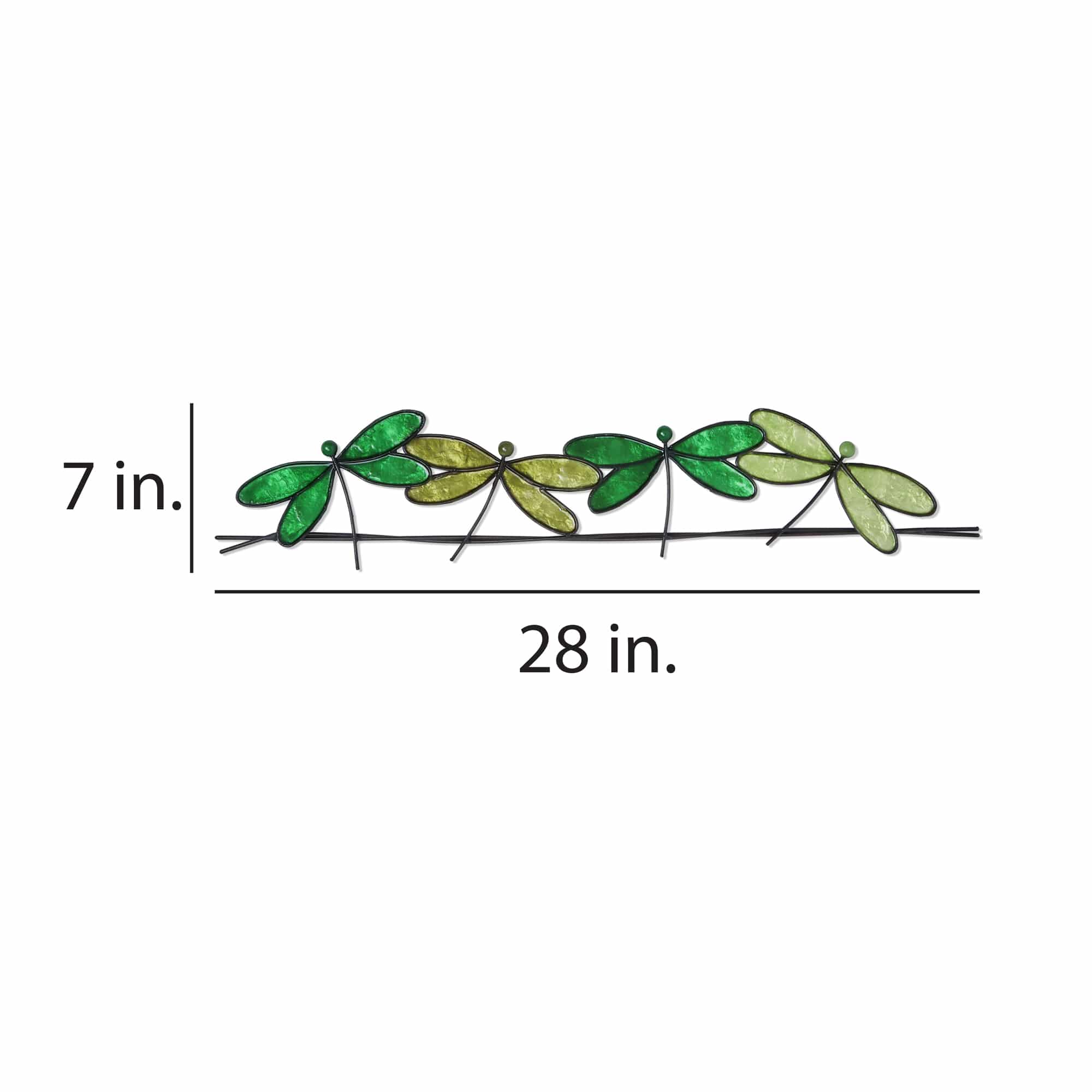
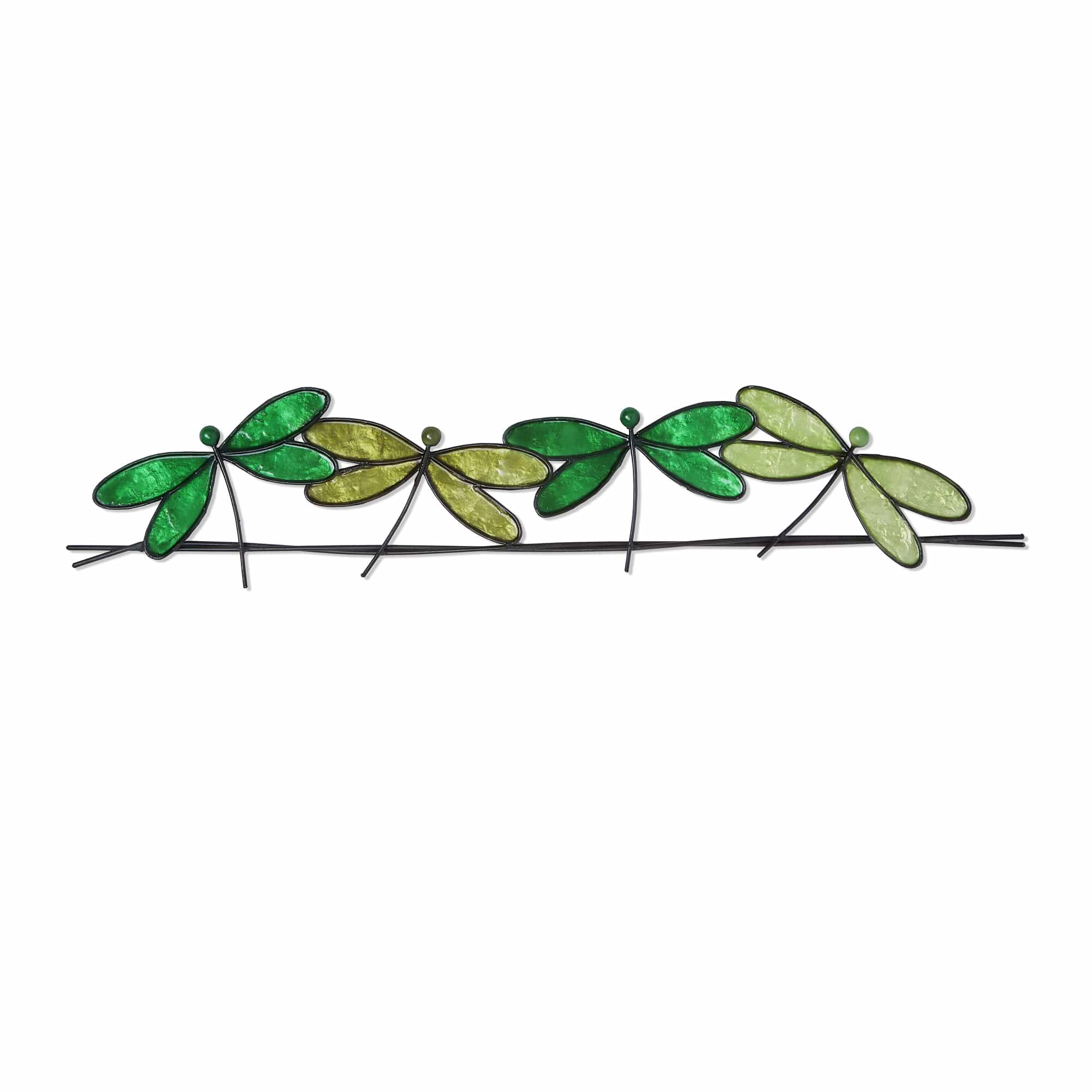
Four dragonflies are taking a mid-day break from fluttering and their characteristically unpredictable flight patterns around the lake. The slender, metal body of each dragonfly connects to colorful, capiz-shell wings, which catches light and adds shine. Each wing is framed using sturdy wrought iron and reinforced with a metal backing.
The basic frame of the dragonfly is created using tin, which is powder-coated with a black finish and makes this piece safe to use outdoors. The edges of the frame are reinforced using thicker tin wire. The front of this piece is adorned in areas with capiz shell, an oyster native to the Philippines, before being hand-painted and sealed with a water-based sealant. The primary purpose of this oyster to provide a source of food, however, the shell is a sustainable by-product that can be used for decoration. The capiz shell subtly replicates the reflective qualities of dragonflies in nature. The entire piece is lightweight and has an eyelet in the back allowing it to be hung using a finishing nail, command strip, or a push pin. Due to it being a natural material, the organic colors of capiz come through as tans and browns underneath the paint.
-
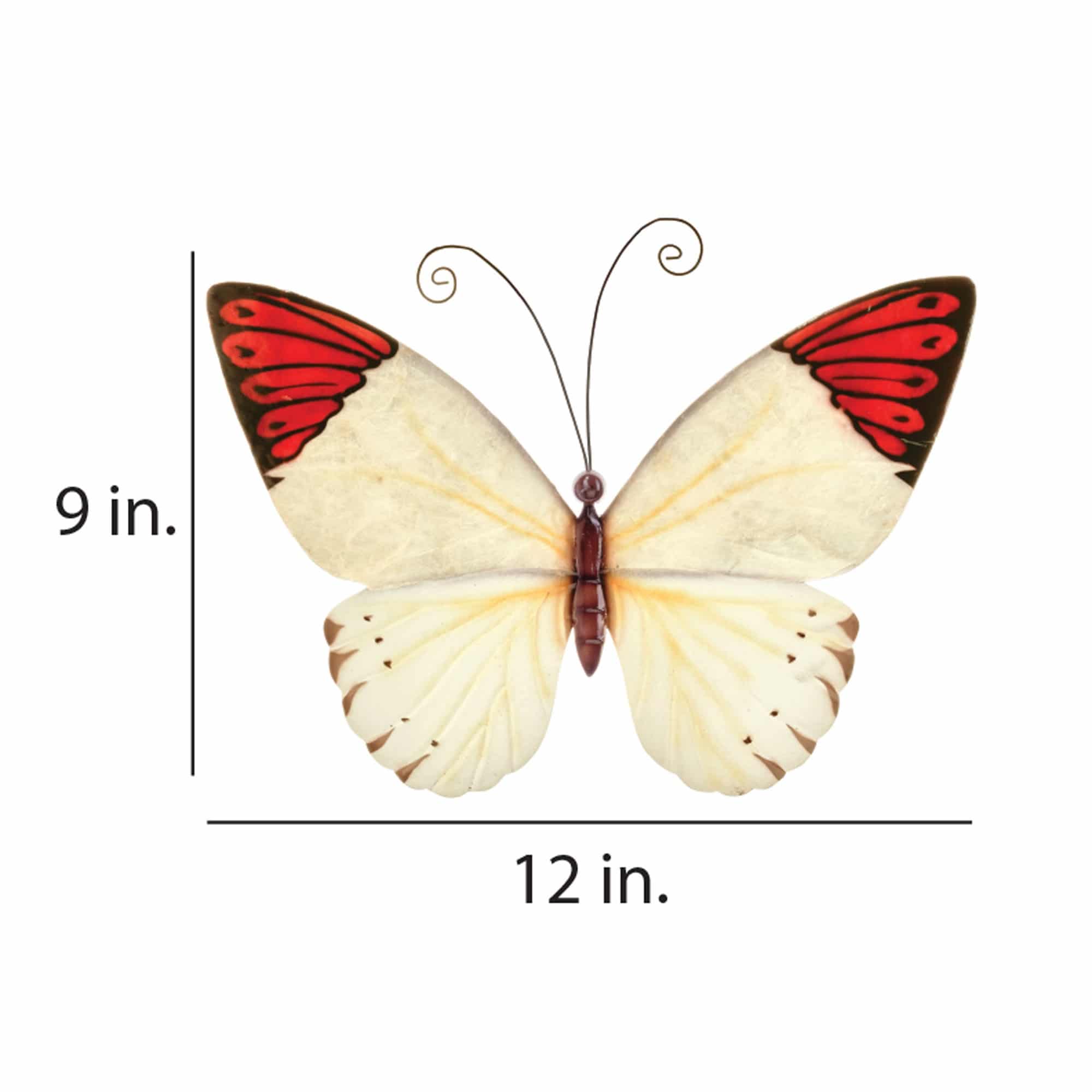
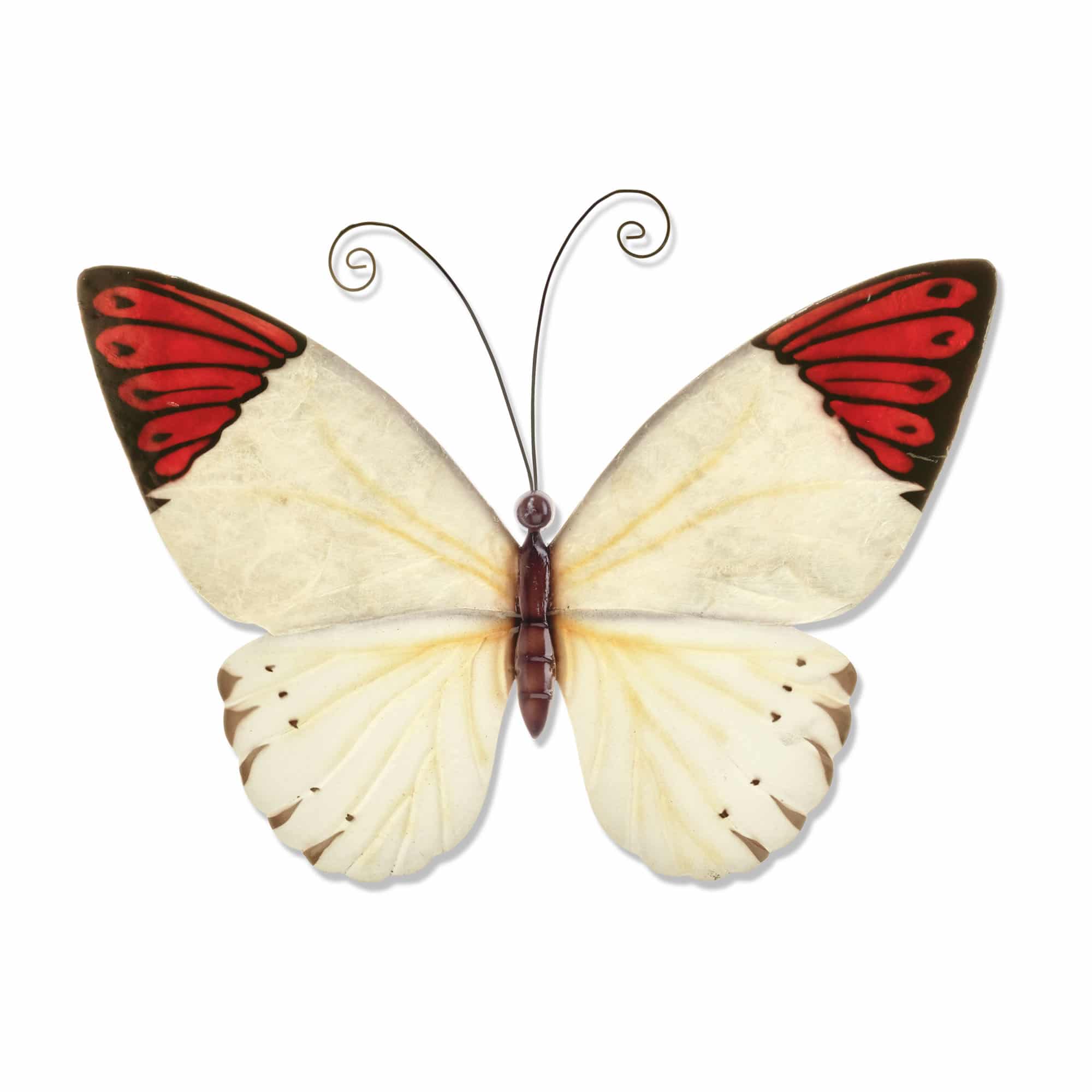 Starting with a base color of pearl white, the artist uses different techniques and splashes of color to craft a distinctive piece. The upper wings are created using capiz oyster shell, left natural to bring in different natural hues. The red base color is accented using brown feathering patterns. The lower portion of the wing is made of tin, textured to highlight the lines that stem from the body of the butterfly. The basic frame of the butterfly is created using tin, which is powder-coated with a black finish and makes this piece safe to use outdoors. The edges of the frame are reinforced using thicker tin wire. The front of this piece is adorned in areas with capiz shell, an oyster native to the Philippines, before being hand-painted and sealed with a water-based sealant. The primary purpose of this oyster to provide a source of food, however, the shell is a sustainable by-product that can be used for decoration. The capiz shell subtly replicates the reflective qualities of butterflies in nature. The entire piece is lightweight and has an eyelet in the back allowing it to be hung using a finishing nail, command strip, or a push pin. Due to it being a natural material, the organic colors of capiz come through as tans and browns underneath the paint.
Starting with a base color of pearl white, the artist uses different techniques and splashes of color to craft a distinctive piece. The upper wings are created using capiz oyster shell, left natural to bring in different natural hues. The red base color is accented using brown feathering patterns. The lower portion of the wing is made of tin, textured to highlight the lines that stem from the body of the butterfly. The basic frame of the butterfly is created using tin, which is powder-coated with a black finish and makes this piece safe to use outdoors. The edges of the frame are reinforced using thicker tin wire. The front of this piece is adorned in areas with capiz shell, an oyster native to the Philippines, before being hand-painted and sealed with a water-based sealant. The primary purpose of this oyster to provide a source of food, however, the shell is a sustainable by-product that can be used for decoration. The capiz shell subtly replicates the reflective qualities of butterflies in nature. The entire piece is lightweight and has an eyelet in the back allowing it to be hung using a finishing nail, command strip, or a push pin. Due to it being a natural material, the organic colors of capiz come through as tans and browns underneath the paint. -
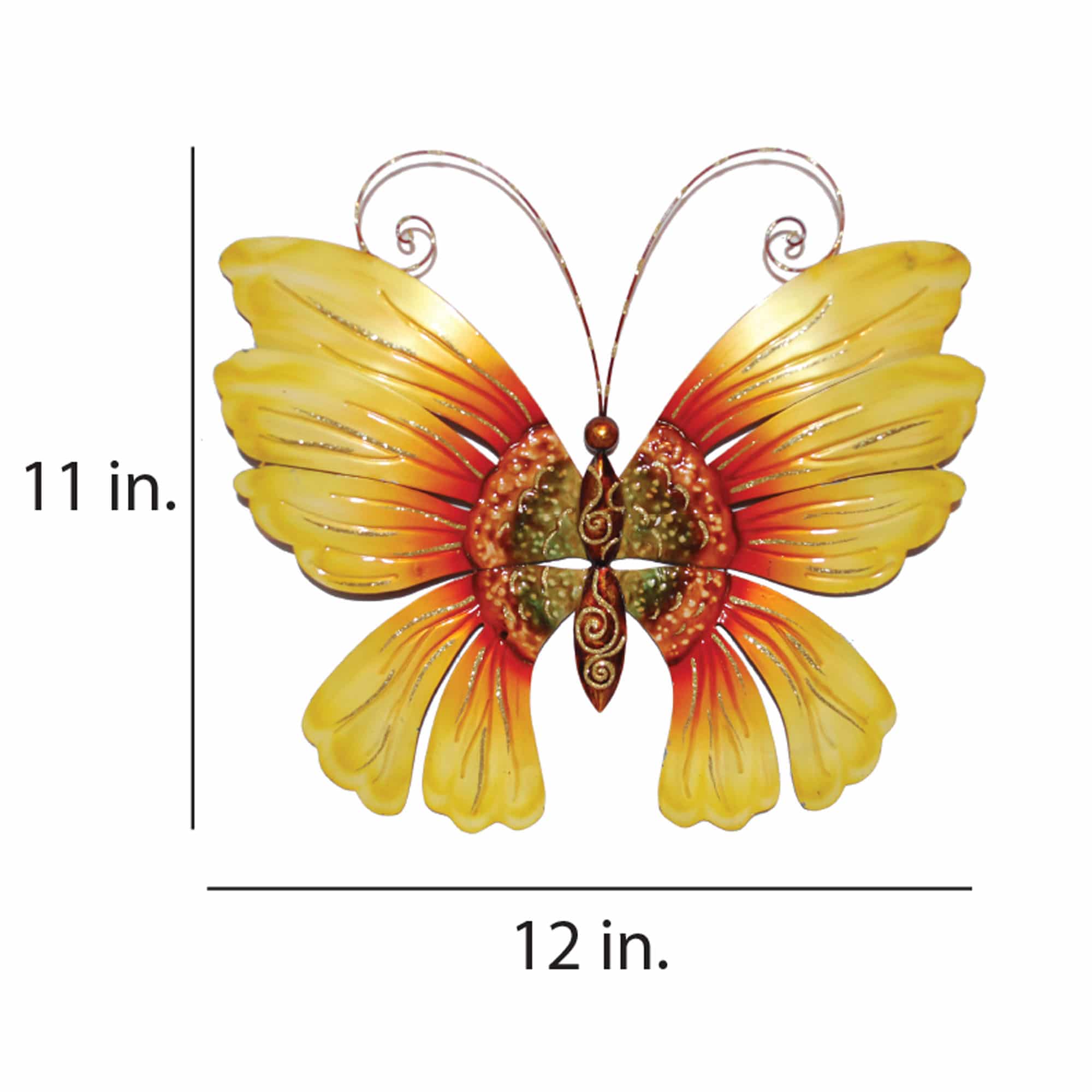
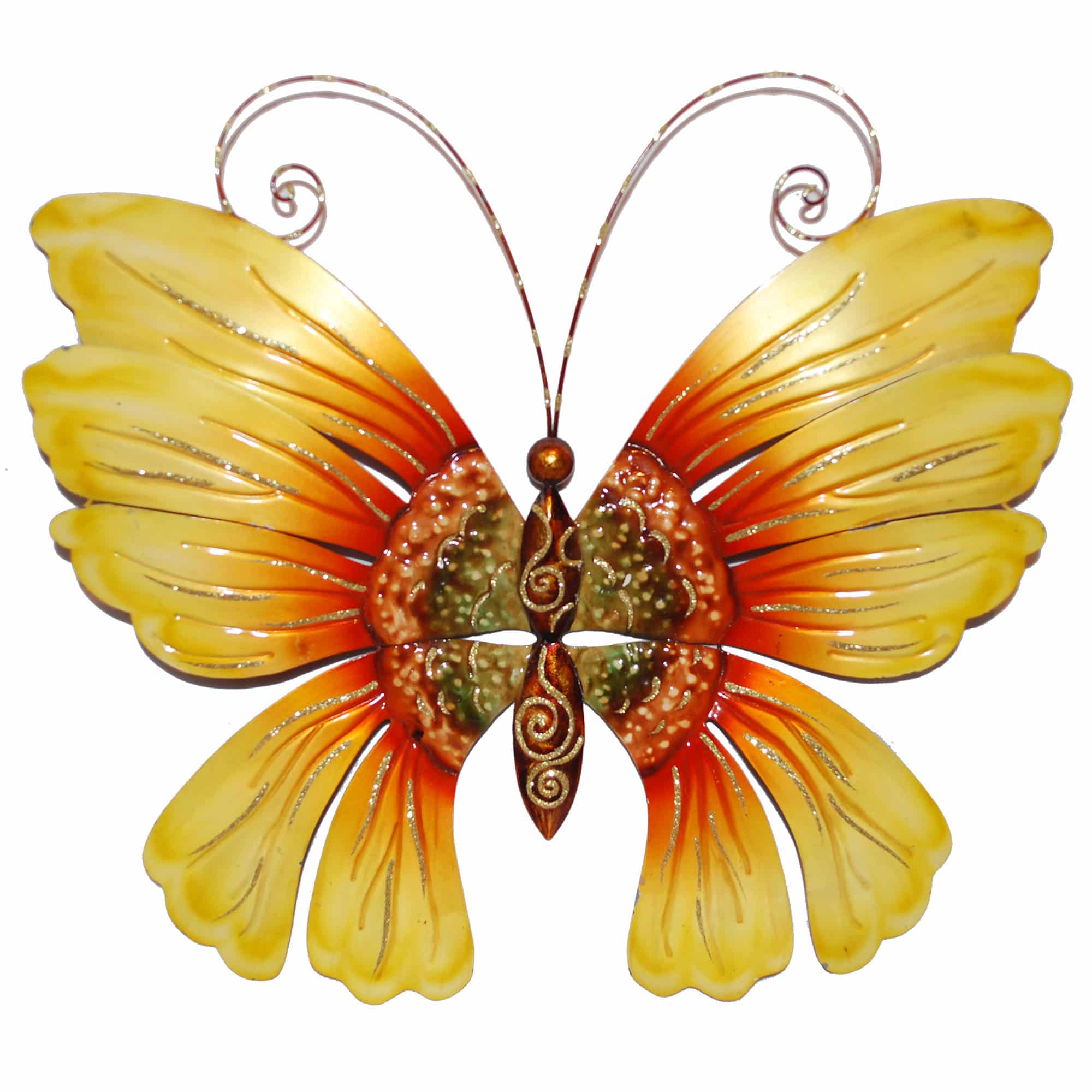
This butterfly echoes the leafy face of a sunflower. The serrated edges of the wings add emphasize the petals while the center of the butterfly mirrors the blossom of a sunflower. No details weren't overlooked, from the center of the butterfly being textured like sunflower seeds, to the gold glitter simulating the reflection of sunlight.
The basic frame of the butterfly is created using tin, which is powder-coated with a black finish and makes this piece safe to use outdoors. The edges of the frame are reinforced using thicker tin wire. The front of this piece is hand-painted and sealed with a water-based sealant. The entire piece is lightweight and has an eyelet in the back allowing it to be hung using a finishing nail, command strip, or a push pin. Due to it being a natural material, the organic colors of capiz come through as tans and browns underneath the paint.
-
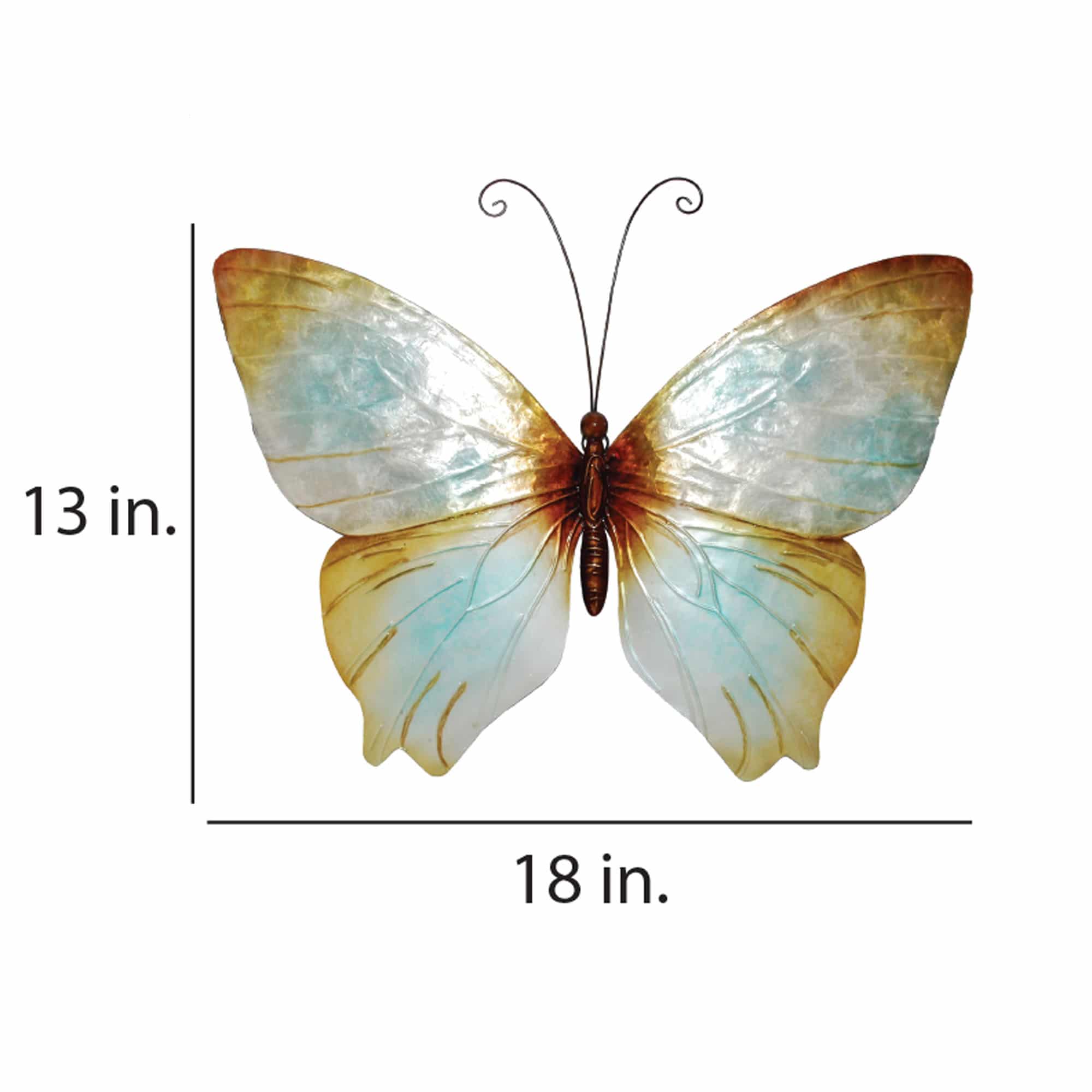
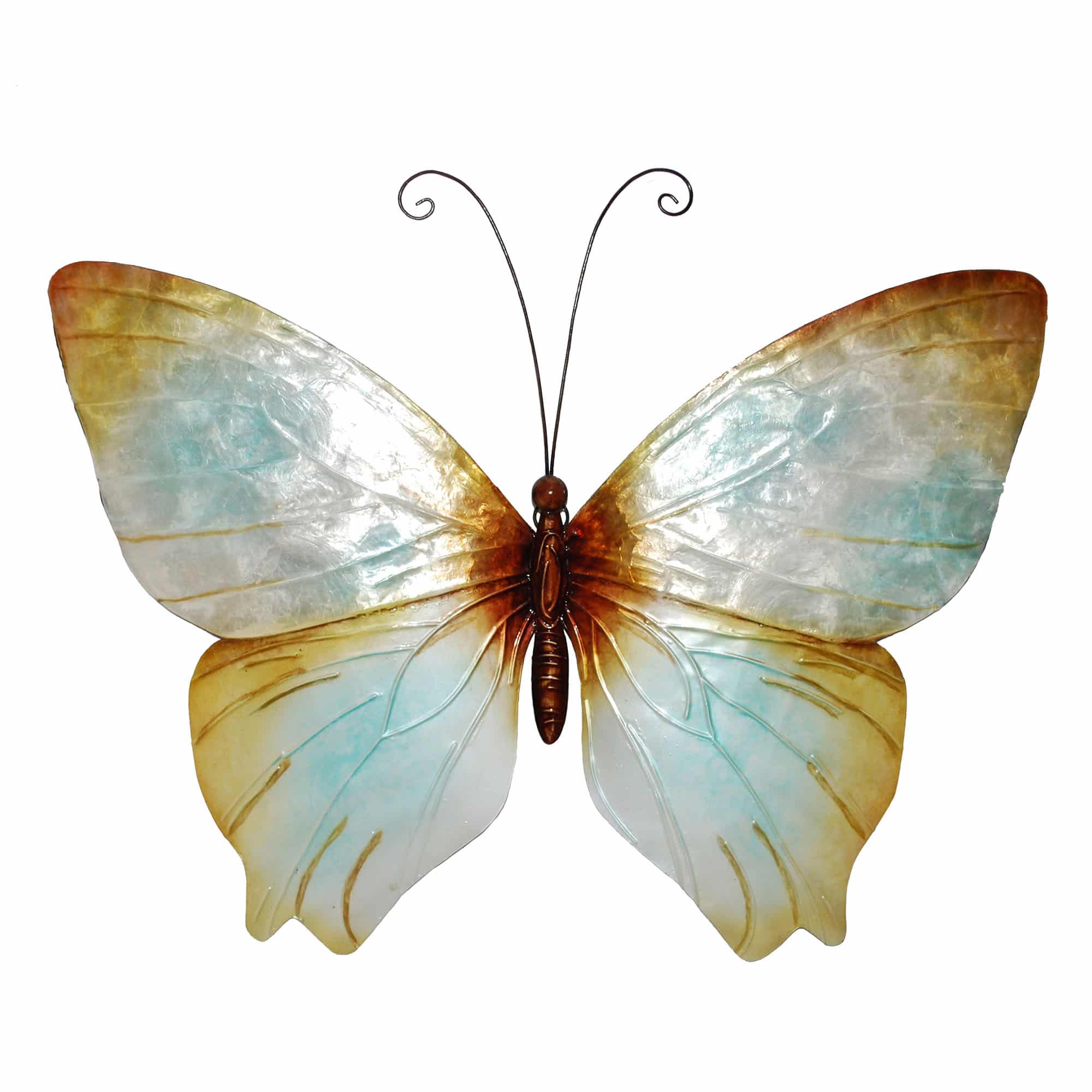
The colors of the wings are inspired by the water of a crystal-clear lake, making the pearl wings feel translucent next to the dark body. The long flowing antenna and the shape of this butterfly provide a classic feel to this very familiar form.
The basic frame of the butterfly is created using tin, which is powder-coated with a black finish and makes this piece safe to use outdoors. The edges of the frame are reinforced using thicker tin wire. The front of this piece is adorned in areas with capiz shell, an oyster native to the Philippines, before being hand-painted and sealed with a water-based sealant. The primary purpose of this oyster to provide a source of food, however, the shell is a sustainable by-product that can be used for decoration. The capiz shell subtly replicates the reflective qualities of butterflies in nature. The entire piece is lightweight and has an eyelet in the back allowing it to be hung using a finishing nail, command strip, or a push pin. Due to it being a natural material, the organic colors of capiz come through as tans and browns underneath the paint.
-
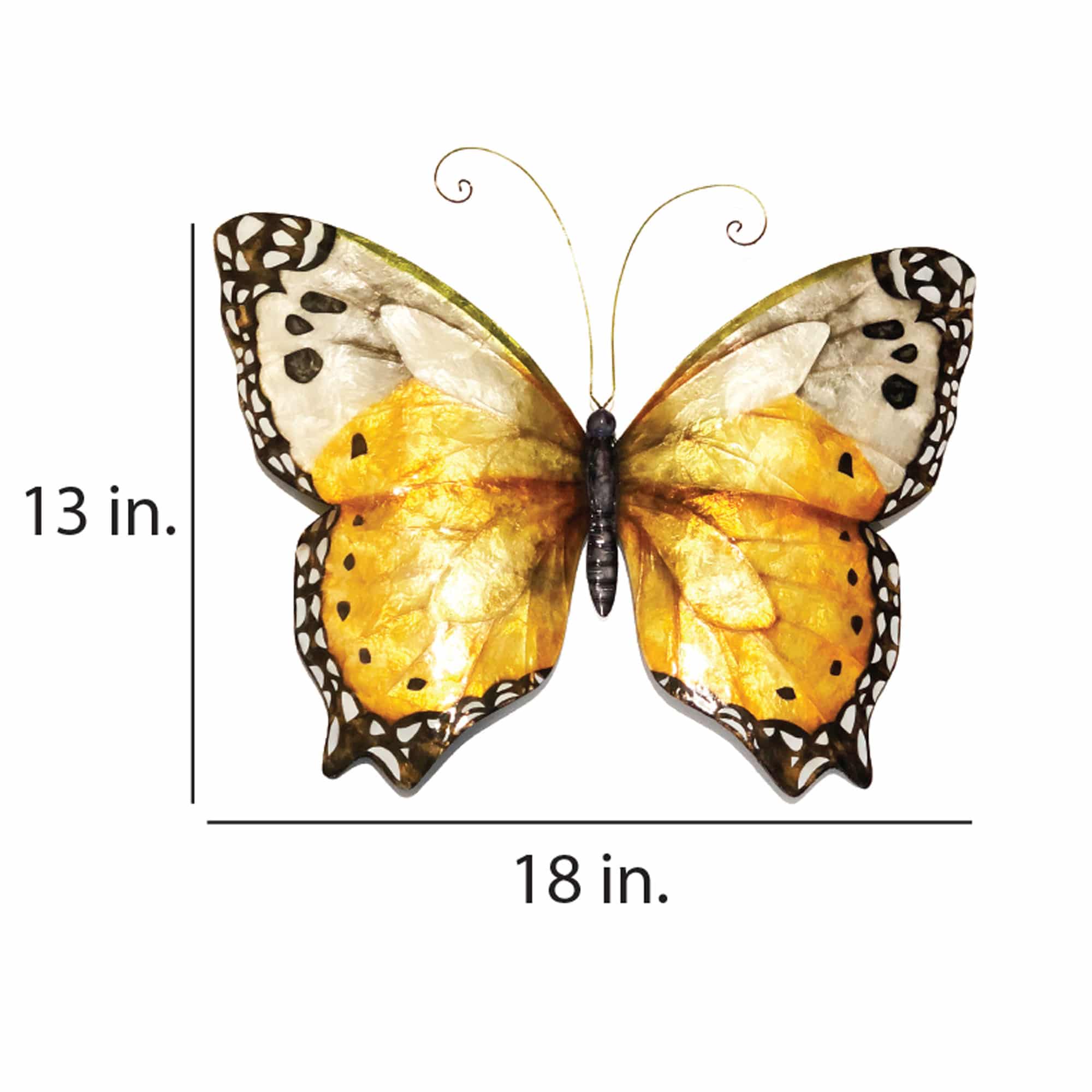
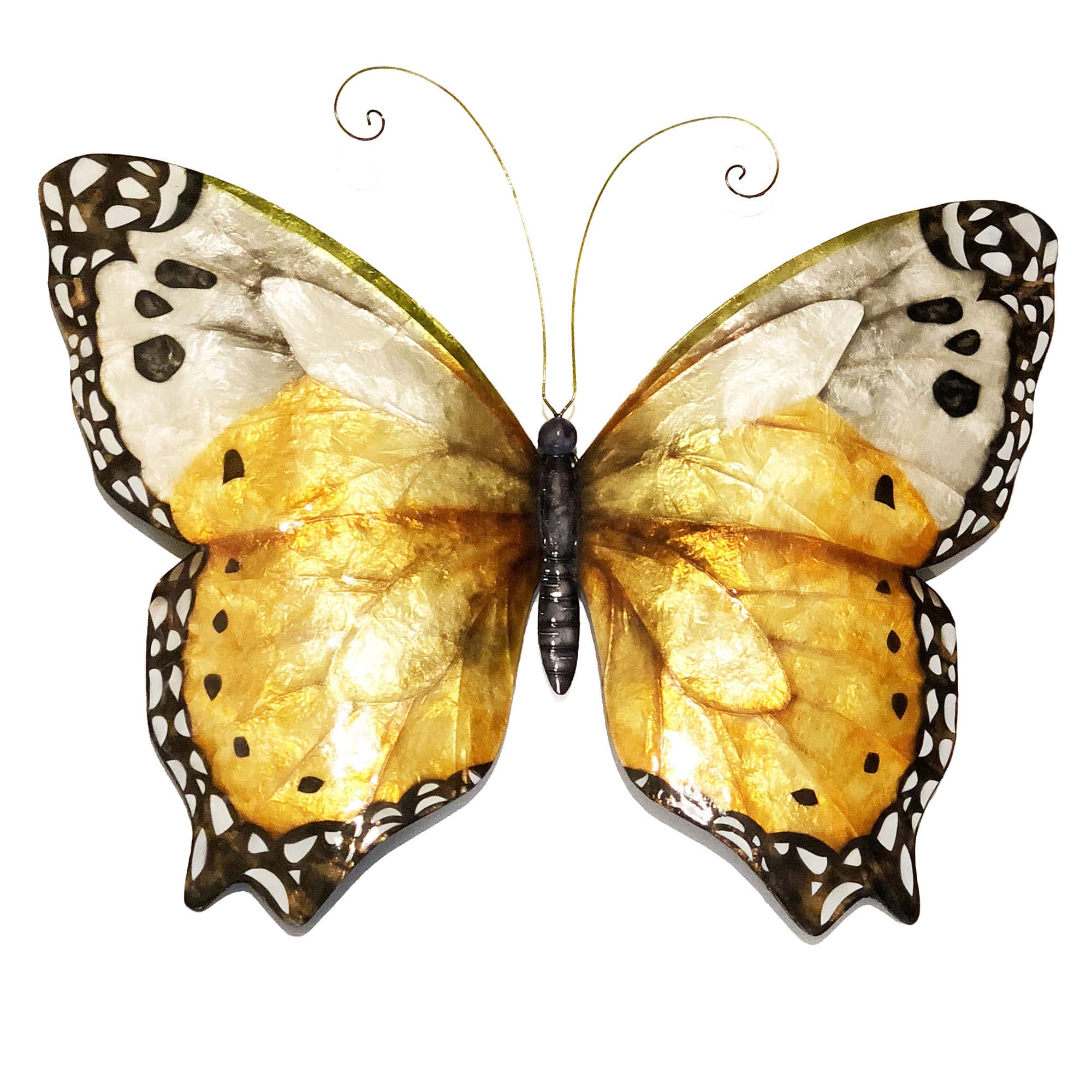
The monarch butterfly is one of the most recognizable butterflies in the world. Its bright orange makes it easily recognizable and it is frequently called the king of butterflies. With long migration patterns, monarchs go through several generations as they travel across the continent each year.
The basic frame of the butterfly is created using tin, which is powder-coated with a black finish and makes this piece safe to use outdoors. The edges of the frame are reinforced using thicker tin wire. The front of this piece is adorned in areas with capiz shell, an oyster native to the Philippines, before being hand-painted and sealed with a water-based sealant. The primary purpose of this oyster to provide a source of food, however, the shell is a sustainable by-product that can be used for decoration. The capiz shell subtly replicates the reflective qualities of butterflies in nature. The entire piece is lightweight and has an eyelet in the back allowing it to be hung using a finishing nail, command strip, or a push pin. Due to it being a natural material, the organic colors of capiz come through as tans and browns underneath the paint.
-
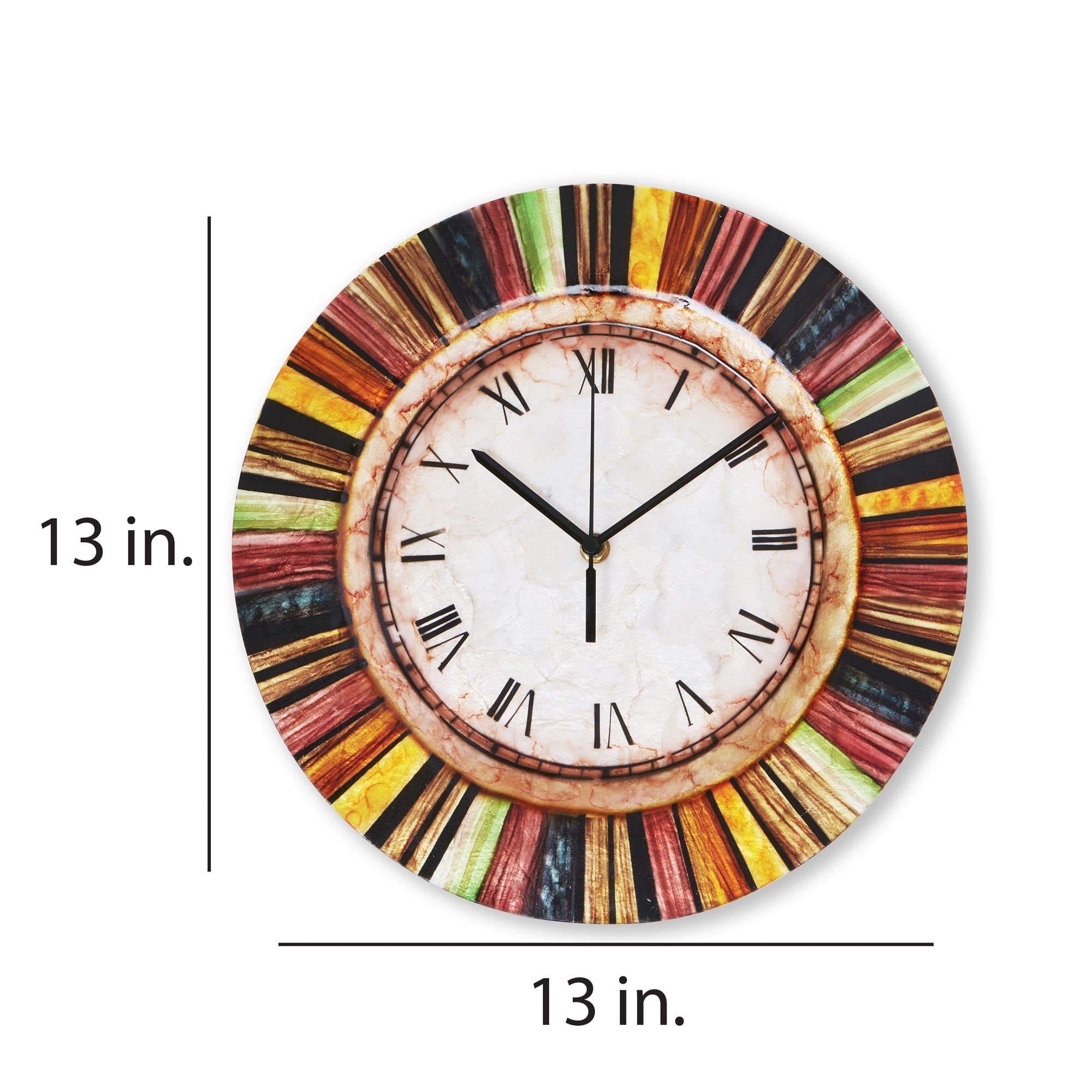
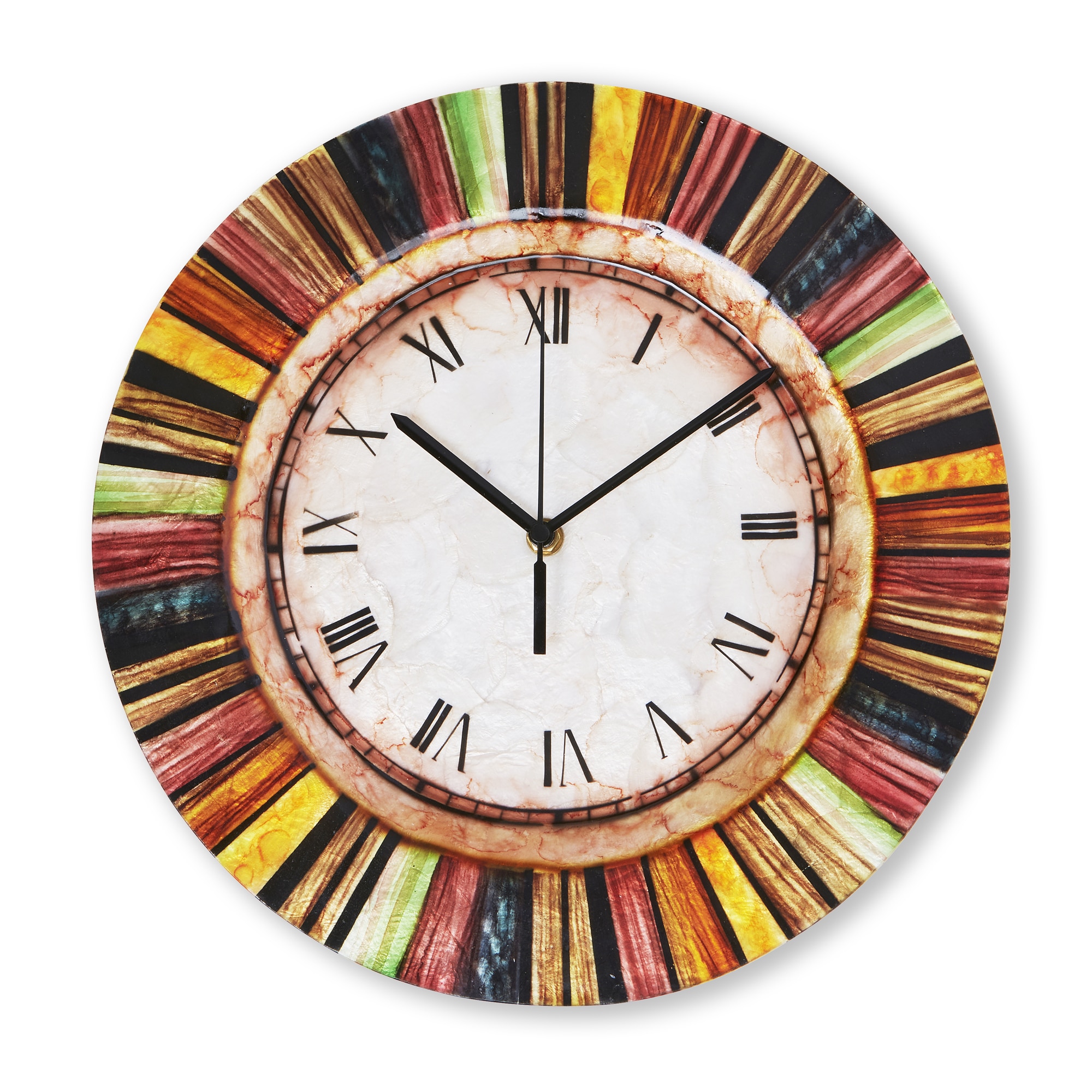 The frame of this clock is made with solid capiz oyster shell, compressed into shape.The artist calls attention to the uniqueness of each shell in the center with a high-gloss finish. Bold, roman numerals stand in contrast to the shell within the clock face. Color blocks adorn the outer rim of the clock in muted tones. The roman numerals combined with the color palette are strongly influenced from Tuscan design. Capiz is an oyster shell and the primary purpose of the oyster is as a source of food. However, the by-product, the shell, can be used for decoration. The clock is created by compressing capiz shell together and forming it into shape. The final result is a light-weight, plate that feels similar to plastic. Due to it being a natural material, the natural colors of the capiz may come through as tans and browns underneath the hand-painted surface.
The frame of this clock is made with solid capiz oyster shell, compressed into shape.The artist calls attention to the uniqueness of each shell in the center with a high-gloss finish. Bold, roman numerals stand in contrast to the shell within the clock face. Color blocks adorn the outer rim of the clock in muted tones. The roman numerals combined with the color palette are strongly influenced from Tuscan design. Capiz is an oyster shell and the primary purpose of the oyster is as a source of food. However, the by-product, the shell, can be used for decoration. The clock is created by compressing capiz shell together and forming it into shape. The final result is a light-weight, plate that feels similar to plastic. Due to it being a natural material, the natural colors of the capiz may come through as tans and browns underneath the hand-painted surface. -

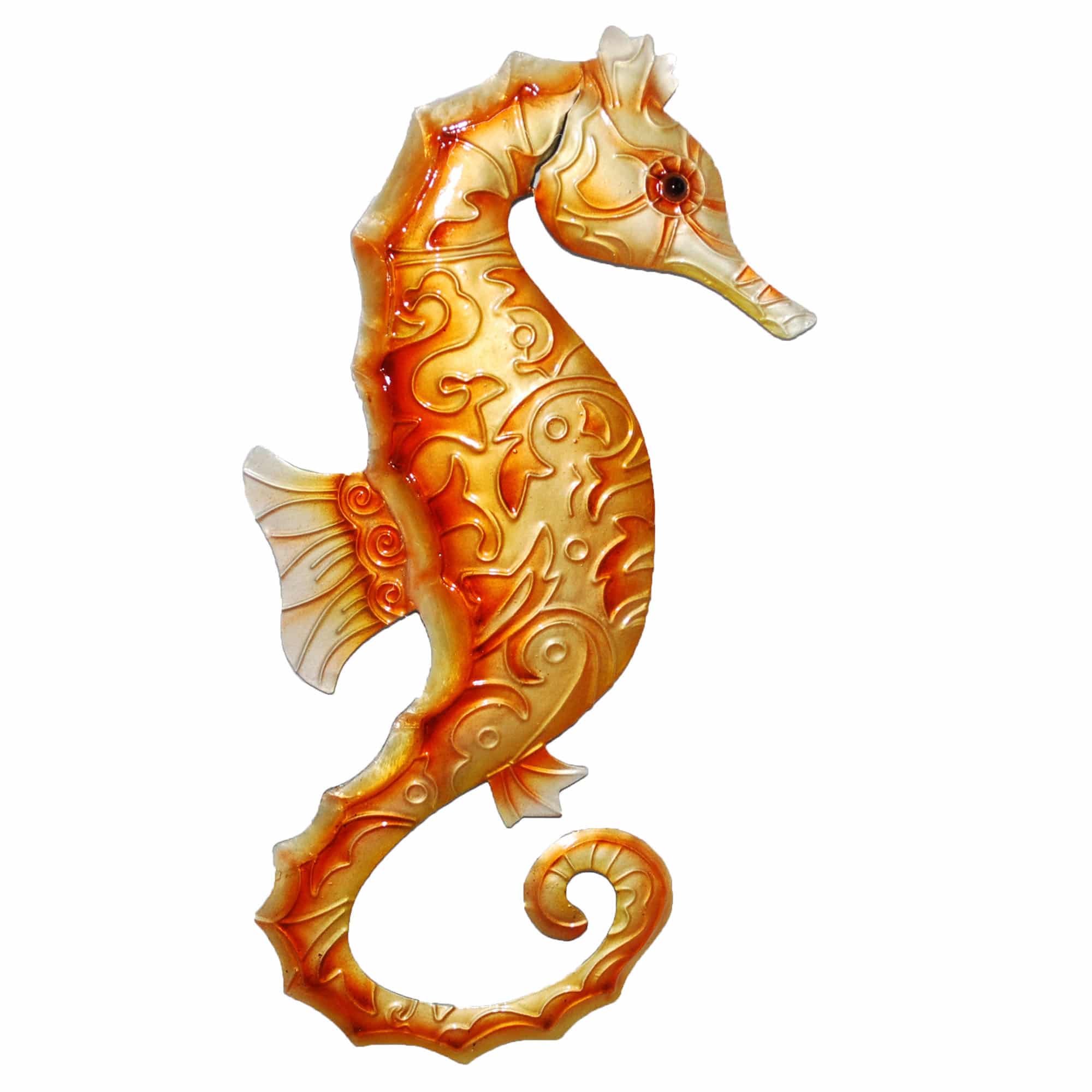 The seahorse has captured the minds and imaginations of people across all cultures for thousands of years. Seen as a symbol of good luck, strength and safety, this unique and beautiful animal is as charming as it is mysterious. The artist captures the beauty of the seahorse with a raised fine, high shine, hand-painted finish, and elegant mother of pearl chest and forefront. The basic frame of the wall seahorse is created using tin, which is powder coated as a black finish. Capiz is an oyster shell and the primary purpose of the oyster is as a source of food. However, the by-product, the shell, can be used for decoration. Due to it being a natural material, the natural colors of the capiz can come through as tans and browns.
The seahorse has captured the minds and imaginations of people across all cultures for thousands of years. Seen as a symbol of good luck, strength and safety, this unique and beautiful animal is as charming as it is mysterious. The artist captures the beauty of the seahorse with a raised fine, high shine, hand-painted finish, and elegant mother of pearl chest and forefront. The basic frame of the wall seahorse is created using tin, which is powder coated as a black finish. Capiz is an oyster shell and the primary purpose of the oyster is as a source of food. However, the by-product, the shell, can be used for decoration. Due to it being a natural material, the natural colors of the capiz can come through as tans and browns. -
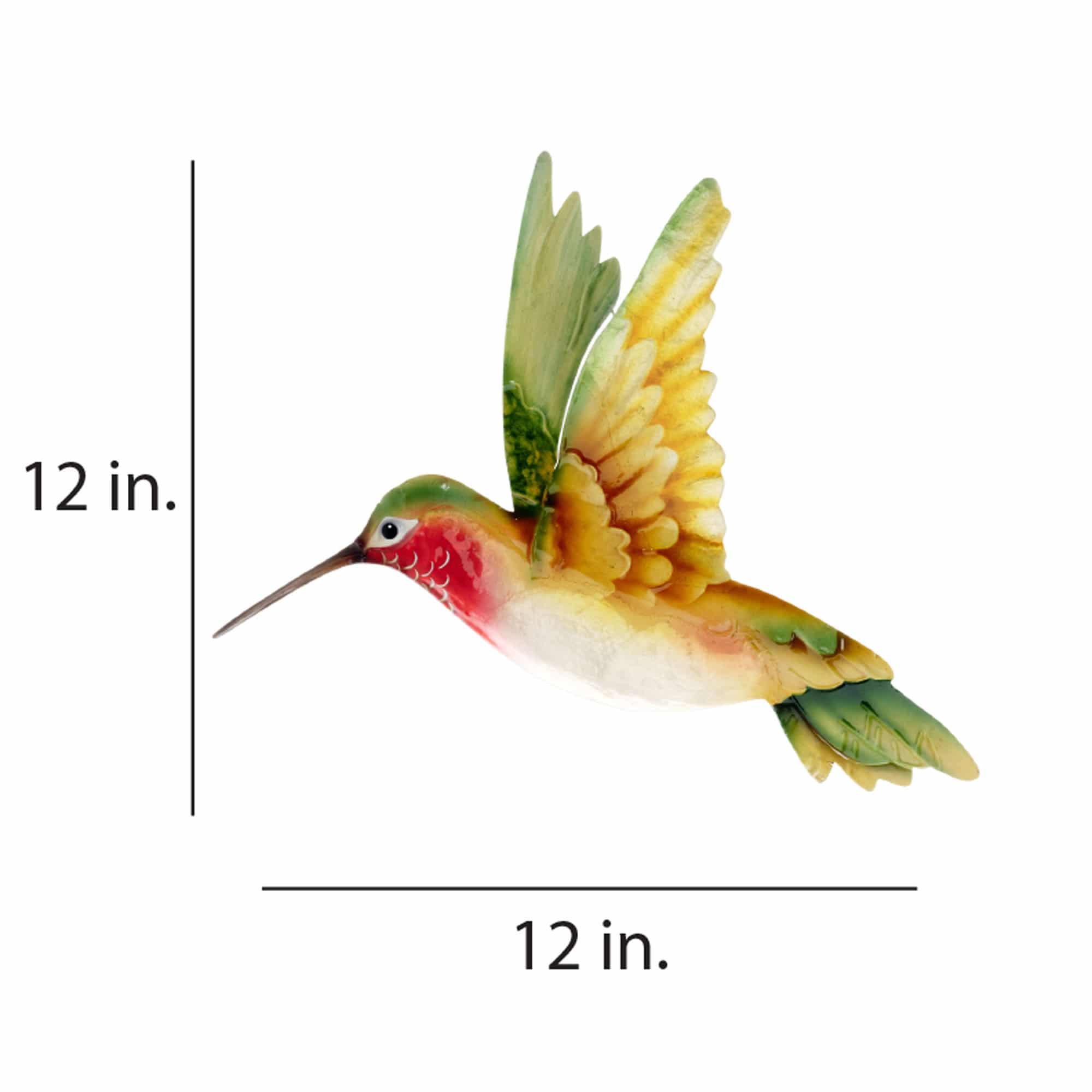
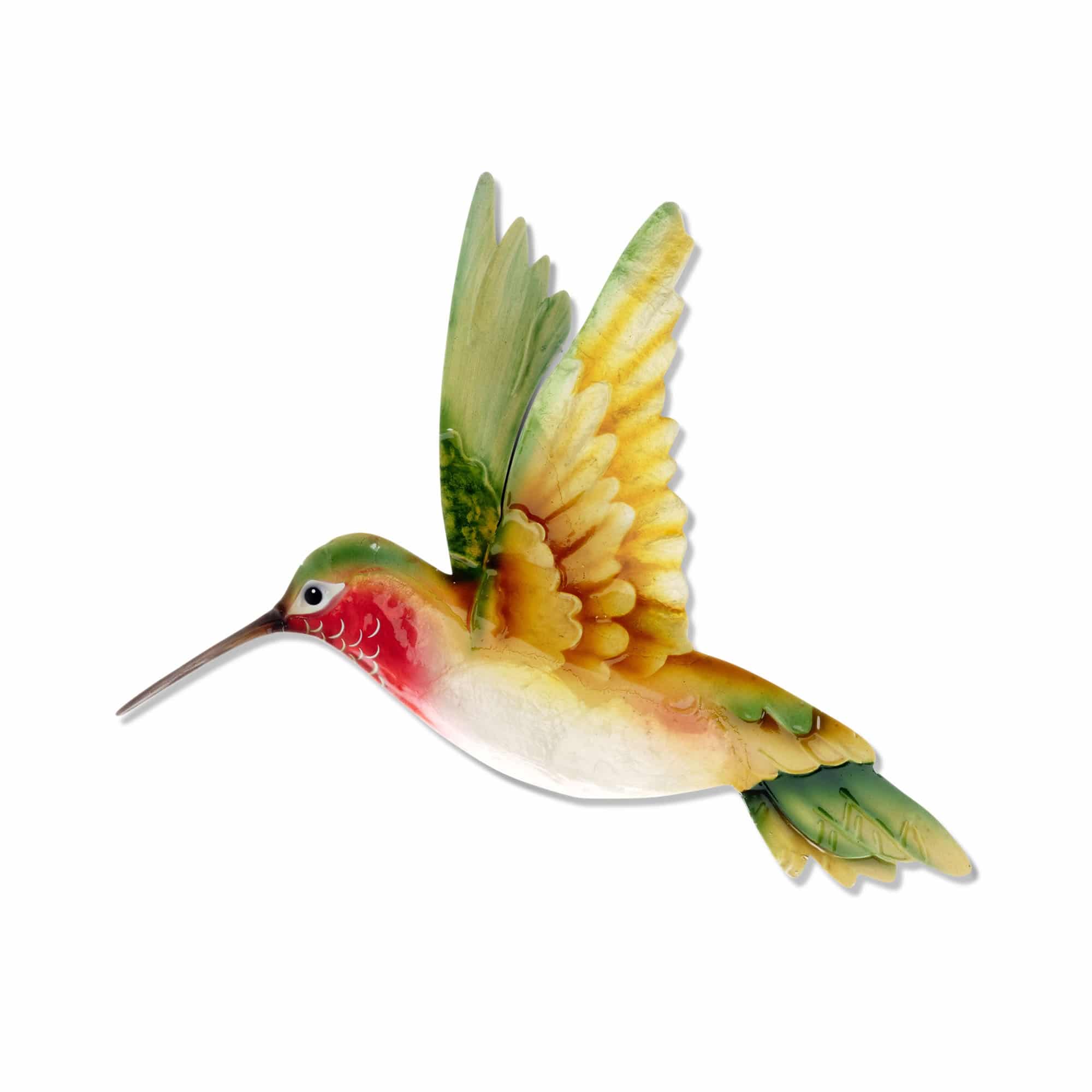
This hummingbird is inspired by the Ruby-throated hummingbird, commonly seen in Eastern North America in the summer. Small yet agile, this hummingbird flies all the way to the southern parts of Central America for the winter. The artist captures the hummingbird in mid-flight. Its chest is adorned with capiz shell, which is then hand-painted to the magnificent colors seen in this species. Bring the spirt of summer into your home by adding this piece of art to your wall.
The basic frame of the hummingbird is created using tin, which is powder coated with a black finish. The frame is reinforced using tin wire along the inner edge. Capiz is an oyster shell and the primary purpose of the oyster is as a source of food. However, the by-product, the shell, can be used for decoration. Due to it being a natural material, the natural colors of the capiz come through as tans and browns underneath the paint. The shell is then painted the bold colors you see. The entire front facing piece is carefully hand-painted keeping in mind the reflective qualities in the color of hummingbirds.
-
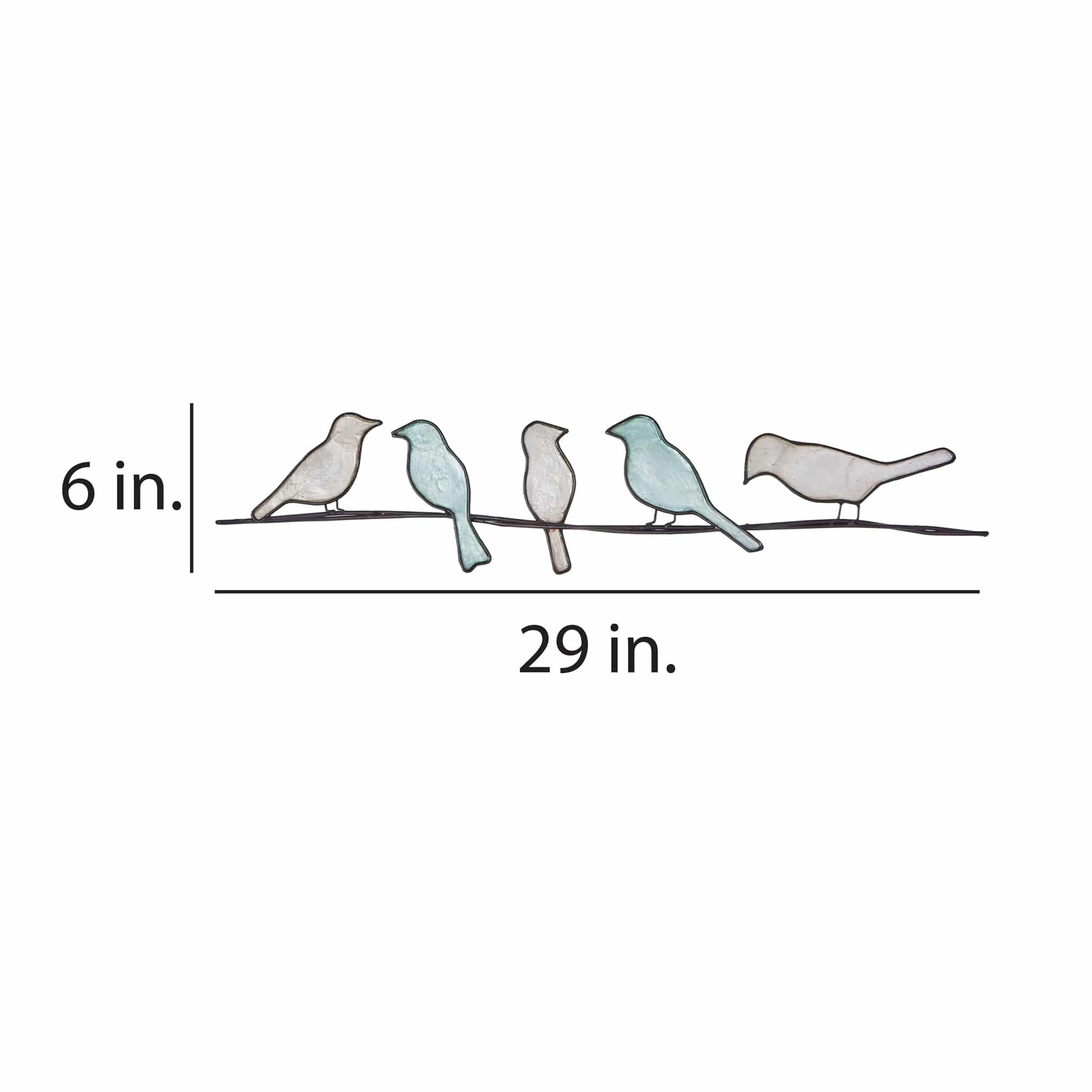
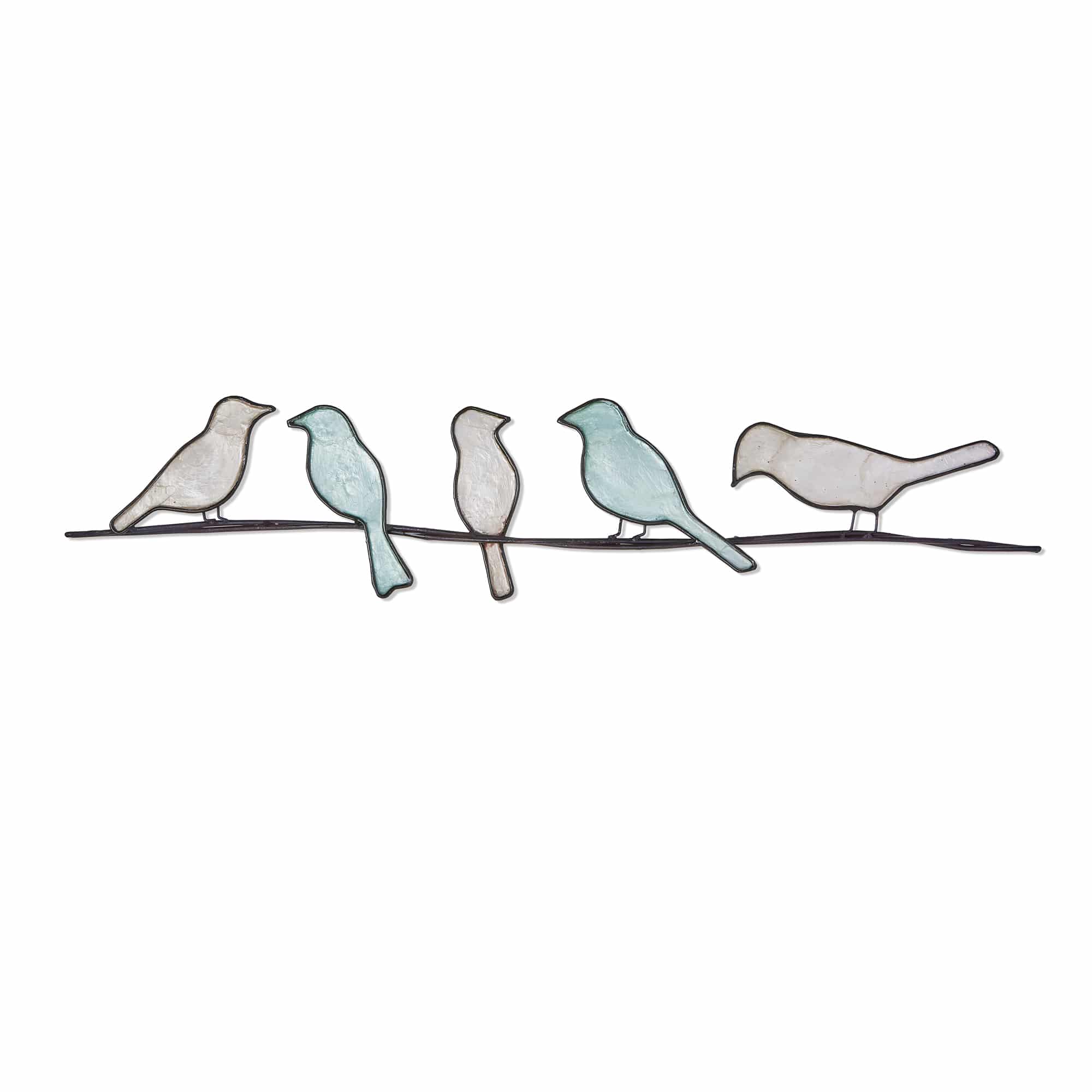 An old parable states that five birds were resting on a wire. Two decided to fly south. How many were birds are left? One's initial answer may be three, however, the answer is still five. The moral of the fable is actions are more important than intention; a kind reminder that a truer picture of one's character is drawn by actions. The artisan captures this parable by lining up five birds socializing on a wire. The basic frame of this piece is created using tin, which is powder coated with a black finish. The frame is reinforced using tin wire along the inner edge. The front of the body is adorned with capiz. Capiz is an oyster shell and the primary purpose of the oyster is as a source of food. However, the by-product, the shell, can be used for decoration. Due to it being a natural material, the natural colors of the capiz may come through as tans and browns underneath the hand-painted surface.
An old parable states that five birds were resting on a wire. Two decided to fly south. How many were birds are left? One's initial answer may be three, however, the answer is still five. The moral of the fable is actions are more important than intention; a kind reminder that a truer picture of one's character is drawn by actions. The artisan captures this parable by lining up five birds socializing on a wire. The basic frame of this piece is created using tin, which is powder coated with a black finish. The frame is reinforced using tin wire along the inner edge. The front of the body is adorned with capiz. Capiz is an oyster shell and the primary purpose of the oyster is as a source of food. However, the by-product, the shell, can be used for decoration. Due to it being a natural material, the natural colors of the capiz may come through as tans and browns underneath the hand-painted surface. -
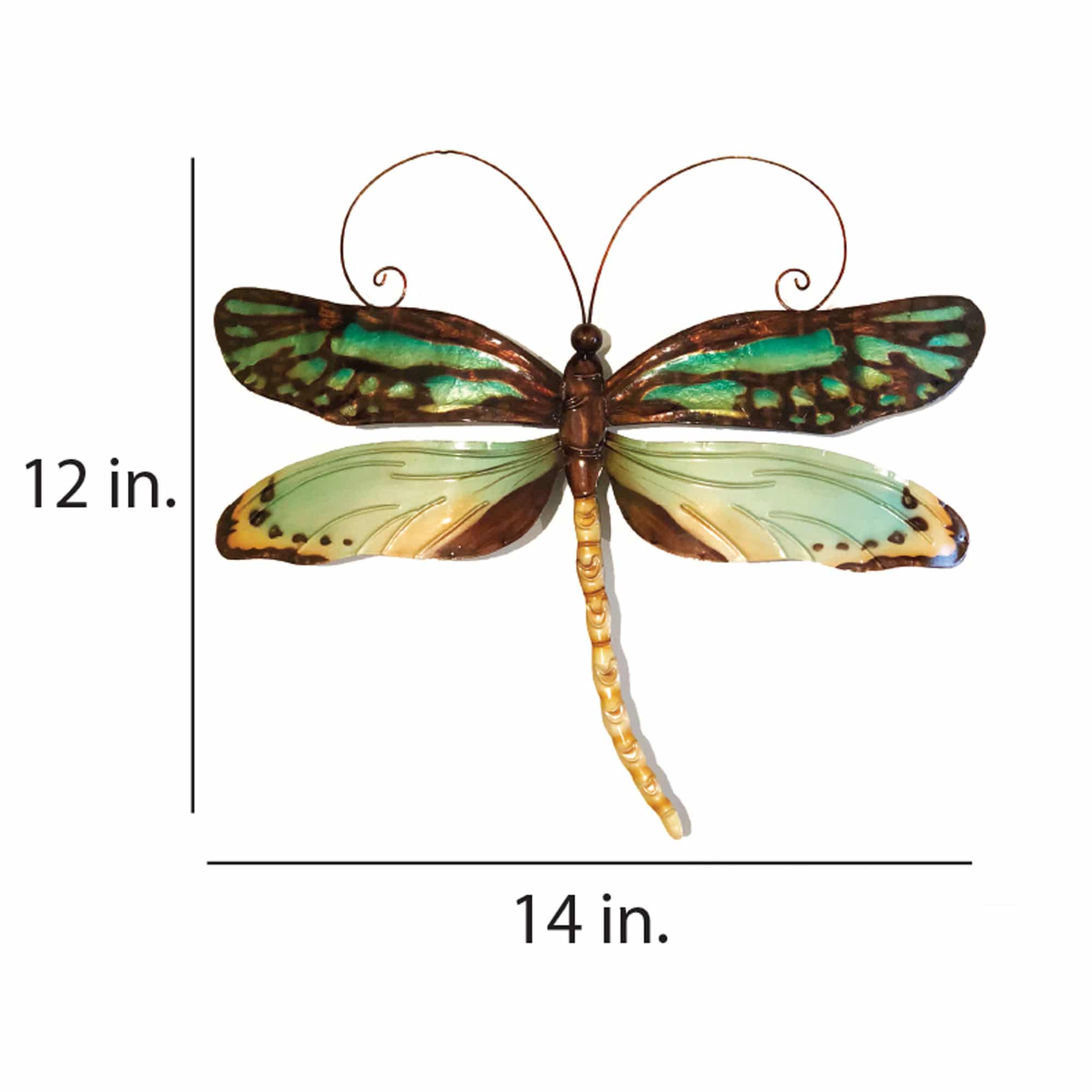
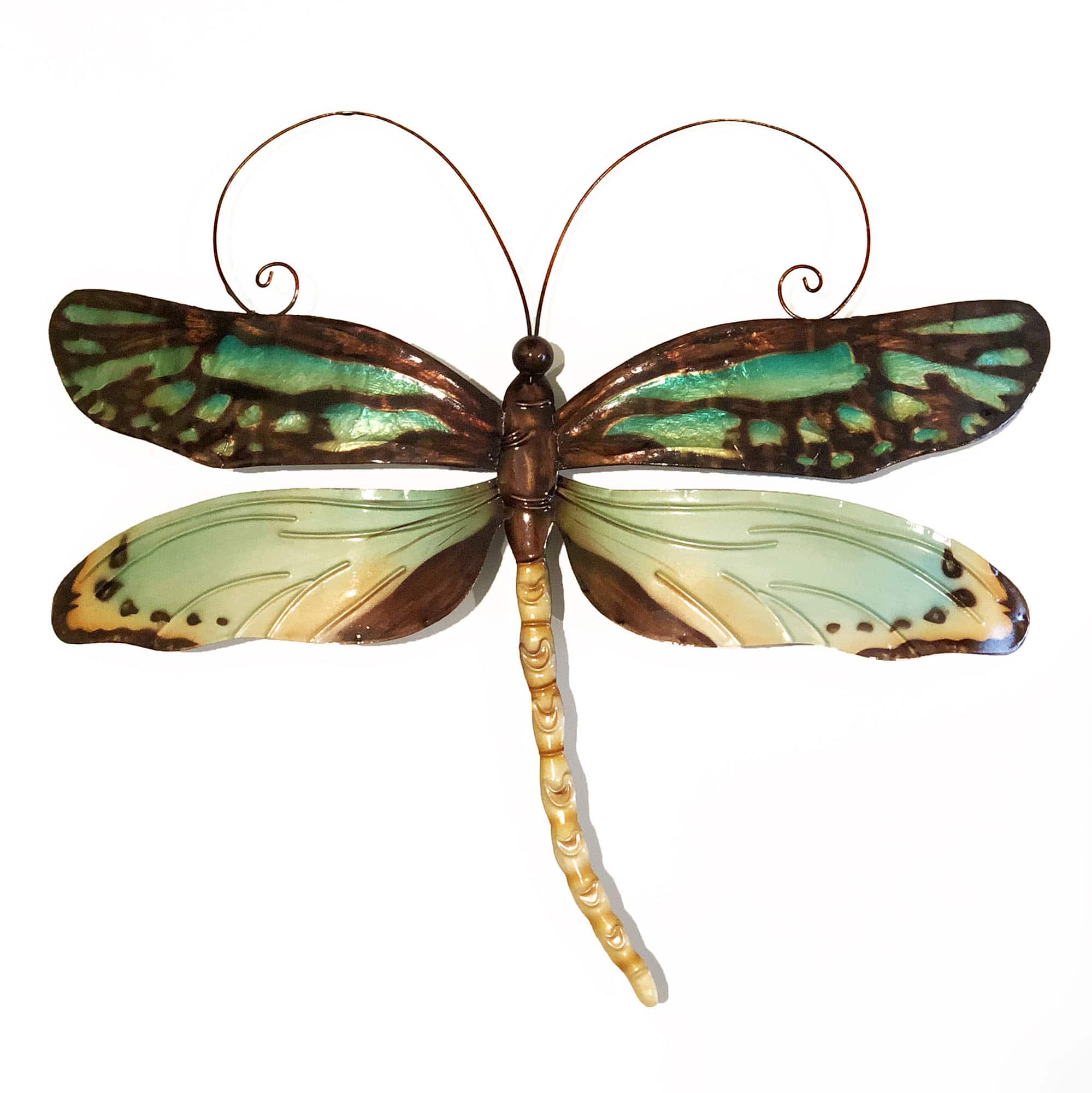
The aqua color of this dragonfly and the capiz shell complement each other in such a way that it almost looks like one is looking at cobalt glass. This color is accentuated by the copper tone bordering the aqua centers. This is truly an impressive piece combining natural materials and colors and creating something breathtaking. The upper wing adorned in capiz is contrasted by the handcrafted metal lower wing. Both components meld together for a piece that showcases the artists talents.
The basic frame of the dragonfly is created using tin, which is powder-coated with a black finish and makes this piece safe to use outdoors. The edges of the frame are reinforced using thicker tin wire. The front of this piece is adorned in areas with capiz shell, an oyster native to the Philippines, before being hand-painted and sealed with a water-based sealant. The primary purpose of this oyster to provide a source of food, however, the shell is a sustainable by-product that can be used for decoration. The capiz shell subtly replicates the reflective qualities of dragonflies in nature. The entire piece is lightweight and has an eyelet in the back allowing it to be hung using a finishing nail, command strip, or a push pin. Due to it being a natural material, the organic colors of capiz come through as tans and browns underneath the paint.
-
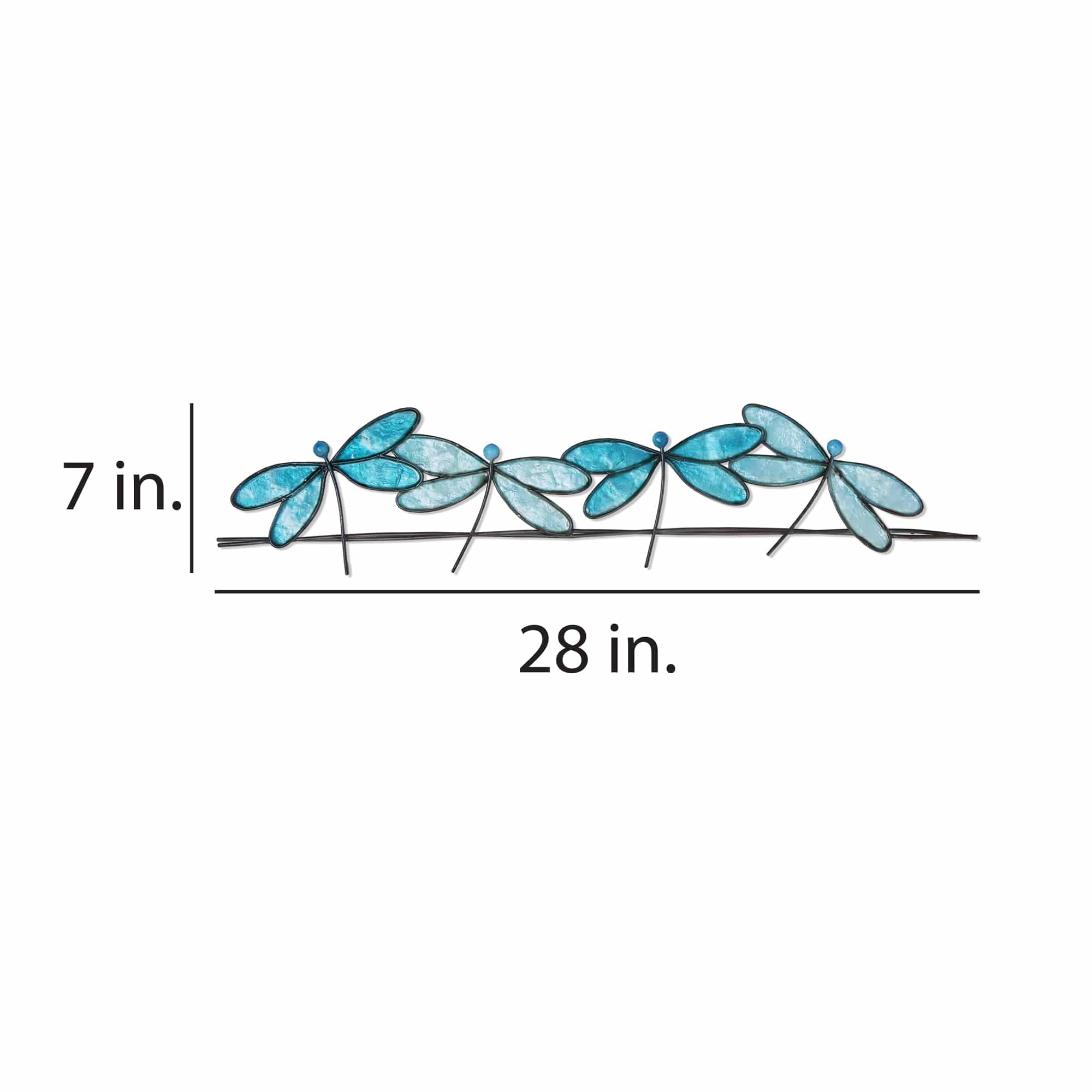

Four dragonflies are taking a mid-day break from fluttering and their characteristically unpredictable flight patterns around the lake. The slender, metal body of each dragonfly connects to colorful, capiz-shell wings, which catches light and adds shine. Each wing is framed using sturdy wrought iron and reinforced with a metal backing.
The basic frame of the dragonfly is created using tin, which is powder-coated with a black finish and makes this piece safe to use outdoors. The edges of the frame are reinforced using thicker tin wire. The front of this piece is adorned in areas with capiz shell, an oyster native to the Philippines, before being hand-painted and sealed with a water-based sealant. The primary purpose of this oyster to provide a source of food, however, the shell is a sustainable by-product that can be used for decoration. The capiz shell subtly replicates the reflective qualities of dragonflies in nature. The entire piece is lightweight and has an eyelet in the back allowing it to be hung using a finishing nail, command strip, or a push pin. Due to it being a natural material, the organic colors of capiz come through as tans and browns underneath the paint.
-


Reflecting the natural greens and blues of the nearly translucent dragonfly wings, the artist uses a base of capiz shell on the lower wings to embody the almost ephemeral structure. The upper wings feature a hand etched pattern mimicking the texture of a dragonfly�s organic wing structure. The blues and greens continue down the body creating a lively and colorful piece.
The basic frame of the dragonfly is created using tin, which is powder-coated with a black finish and makes this piece safe to use outdoors. The edges of the frame are reinforced using thicker tin wire. The front of this piece is adorned in areas with capiz shell, an oyster native to the Philippines, before being hand-painted and sealed with a water-based sealant. The primary purpose of this oyster to provide a source of food, however, the shell is a sustainable by-product that can be used for decoration. The capiz shell subtly replicates the reflective qualities of dragonflies in nature. The entire piece is lightweight and has an eyelet in the back allowing it to be hung using a finishing nail, command strip, or a push pin. Due to it being a natural material, the organic colors of capiz come through as tans and browns underneath the paint.
-
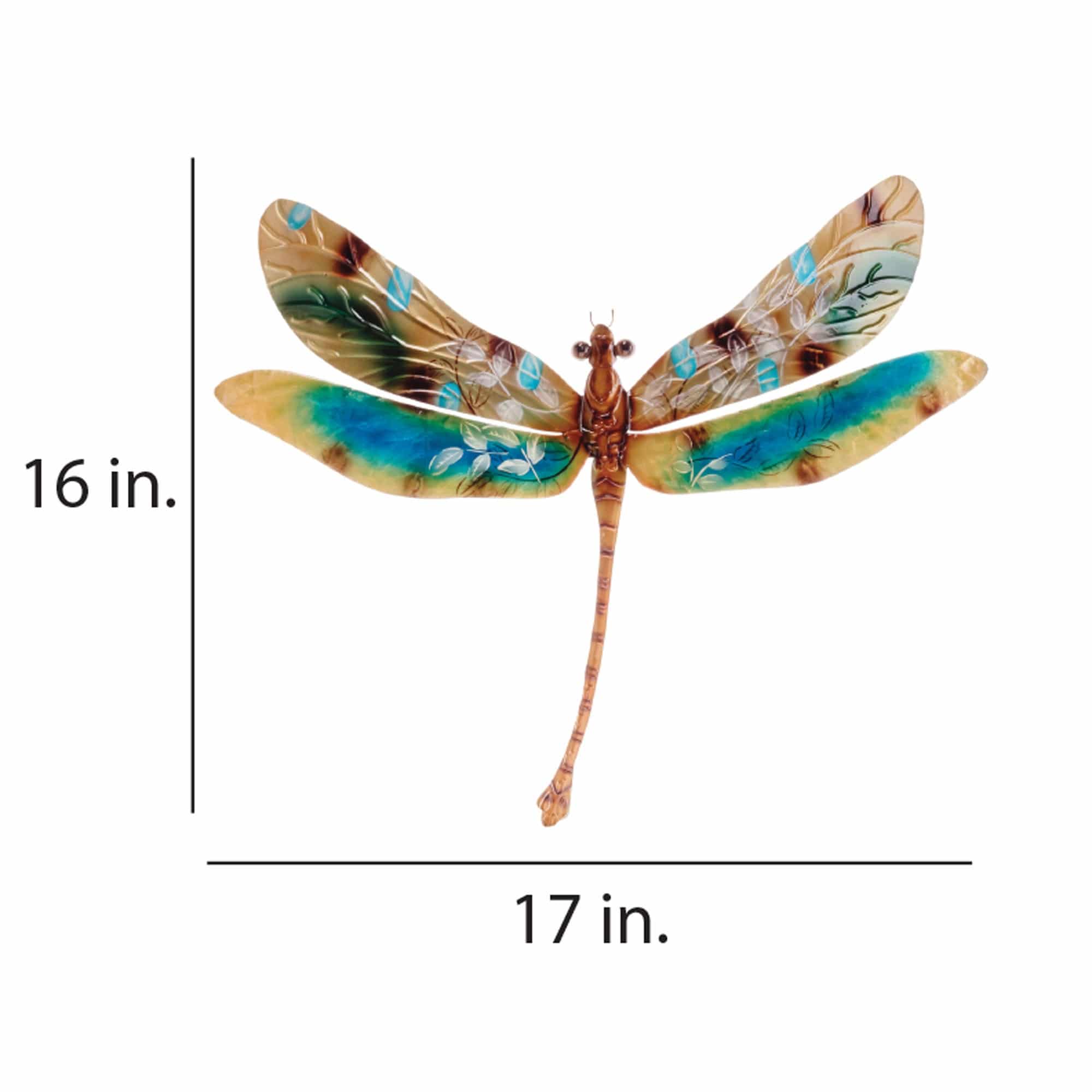
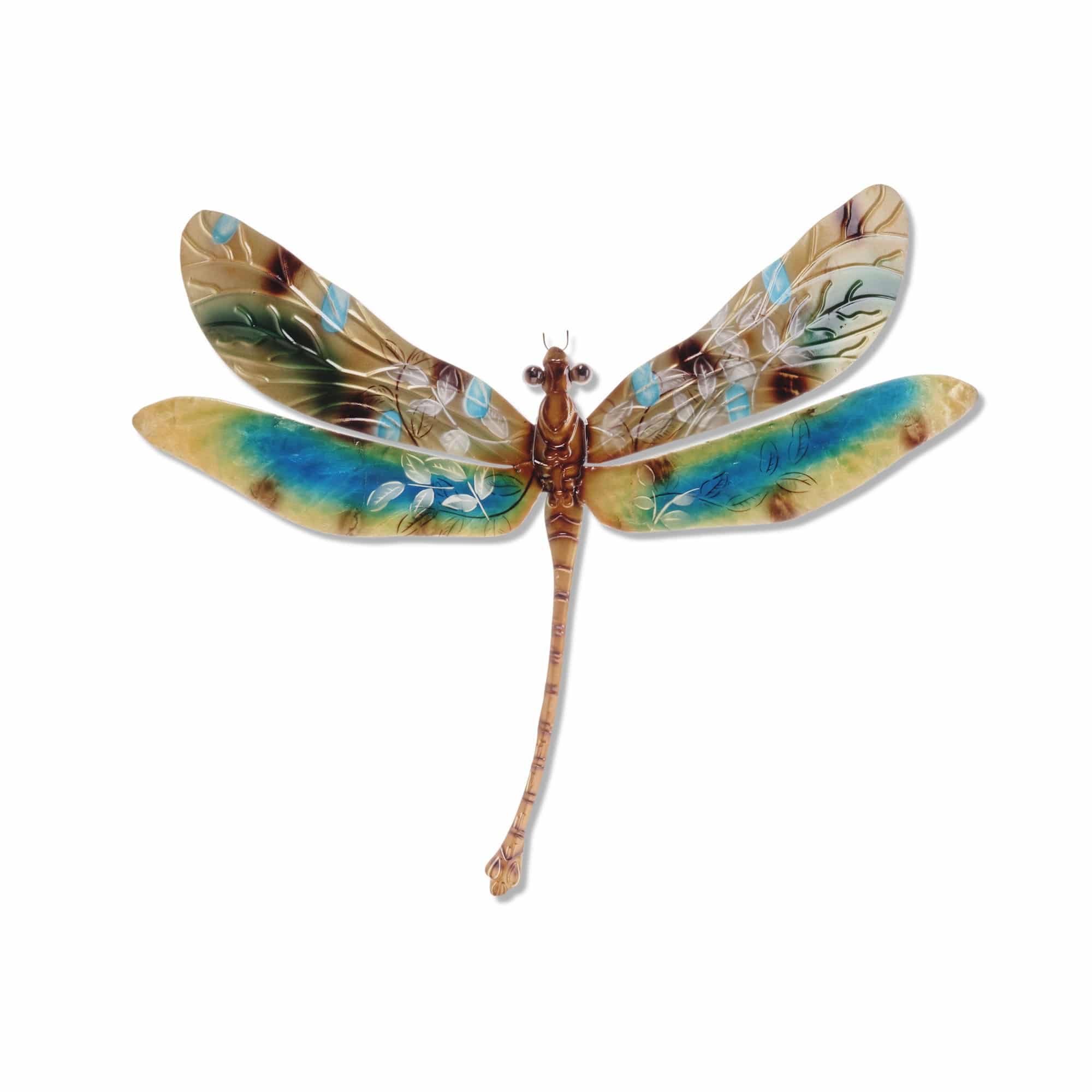
The color pallet of this dragonfly is true to form with its aqua, gold, and brown hues. The artist adds leafy structure to the dragonfly�s to the upper wing while providing shimmer and geomatics design with capiz shell in the lower half. Additional detail is added with hand painted, white foliage that starts on the lower wing and travels to the upper wing, reflecting the dragonfly�s natural habitat.
The basic frame of the dragonfly is created using tin, which is powder-coated with a black finish and makes this piece safe to use outdoors. The edges of the frame are reinforced using thicker tin wire. The front of this piece is adorned in areas with capiz shell, an oyster native to the Philippines, before being hand-painted and sealed with a water-based sealant. The primary purpose of this oyster to provide a source of food, however, the shell is a sustainable by-product that can be used for decoration. The capiz shell subtly replicates the reflective qualities of dragonflies in nature. The entire piece is lightweight and has an eyelet in the back allowing it to be hung using a finishing nail, command strip, or a push pin. Due to it being a natural material, the organic colors of capiz come through as tans and browns underneath the paint.
-
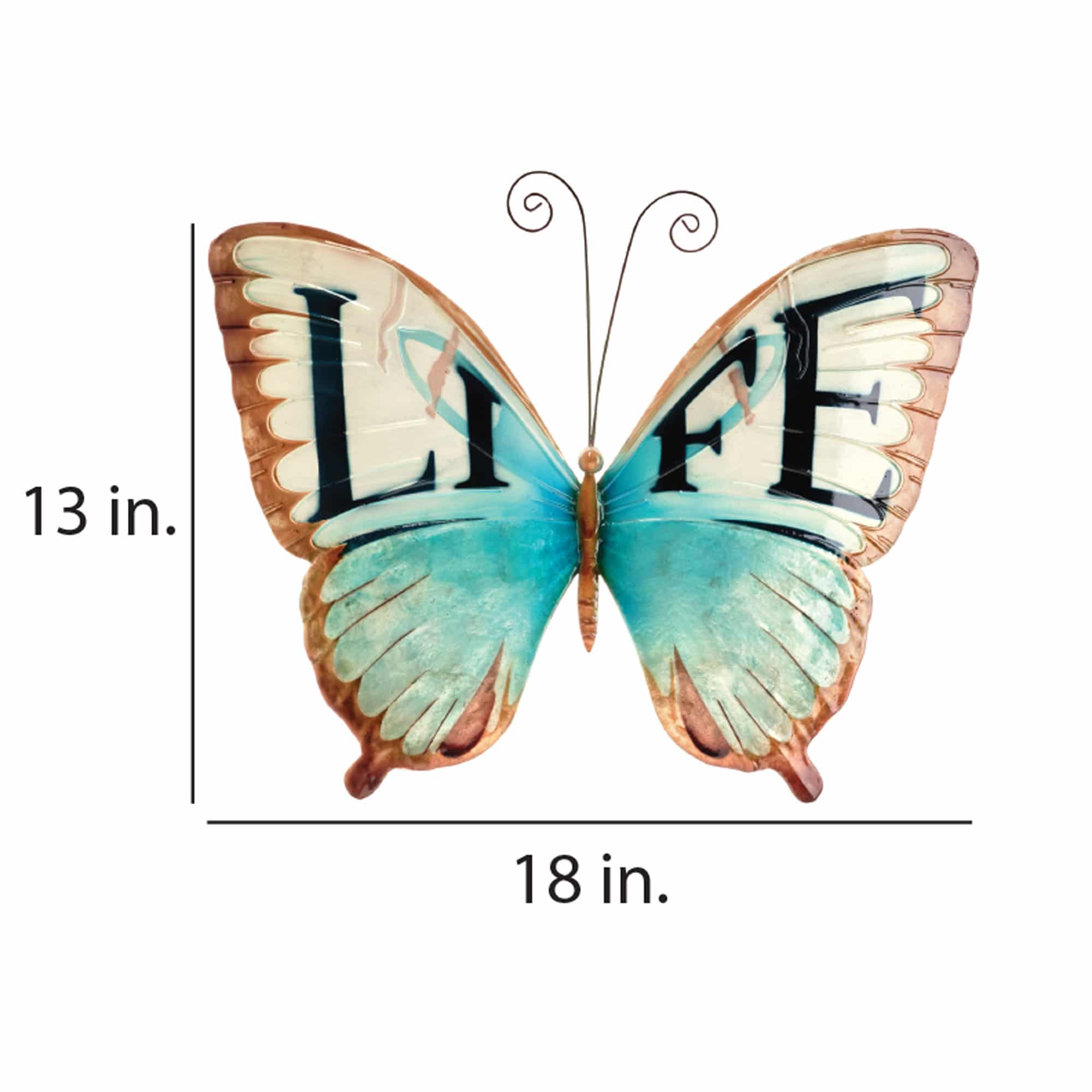
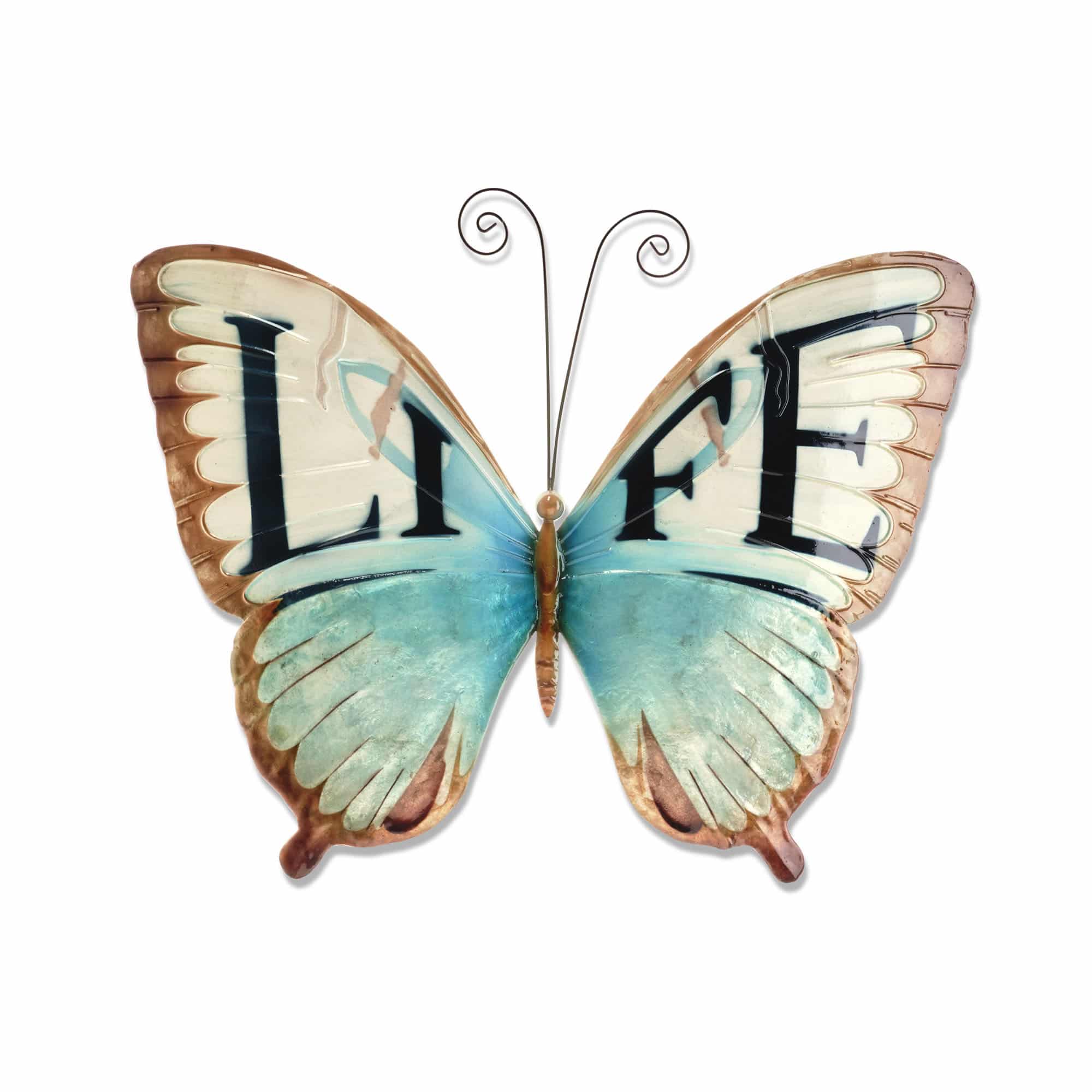
Shedding its cocoon, the butterfly is a strong symbol of rebirth, thus the butterfly is entrenched in many myths and legends around the world about immortality. In many eastern cultures, the color blue also is a symbol of immortality and is used to represent life. As to contrast the subtle meanings behind this butterfly, the word eLife' radiates from the butterfly's very core. This elegant butterfly, highlighted with blue and browns, states clearly that this beautiful creation represents life.
The basic frame of the butterfly is created using tin, which is powder-coated with a black finish and makes this piece safe to use outdoors. The edges of the frame are reinforced using thicker tin wire. The front of this piece is adorned in areas with capiz shell, an oyster native to the Philippines, before being hand-painted and sealed with a water-based sealant. The primary purpose of this oyster to provide a source of food, however, the shell is a sustainable by-product that can be used for decoration. The capiz shell subtly replicates the reflective qualities of butterflies in nature. The entire piece is lightweight and has an eyelet in the back allowing it to be hung using a finishing nail, command strip, or a push pin. Due to it being a natural material, the organic colors of capiz come through as tans and browns underneath the paint.
-
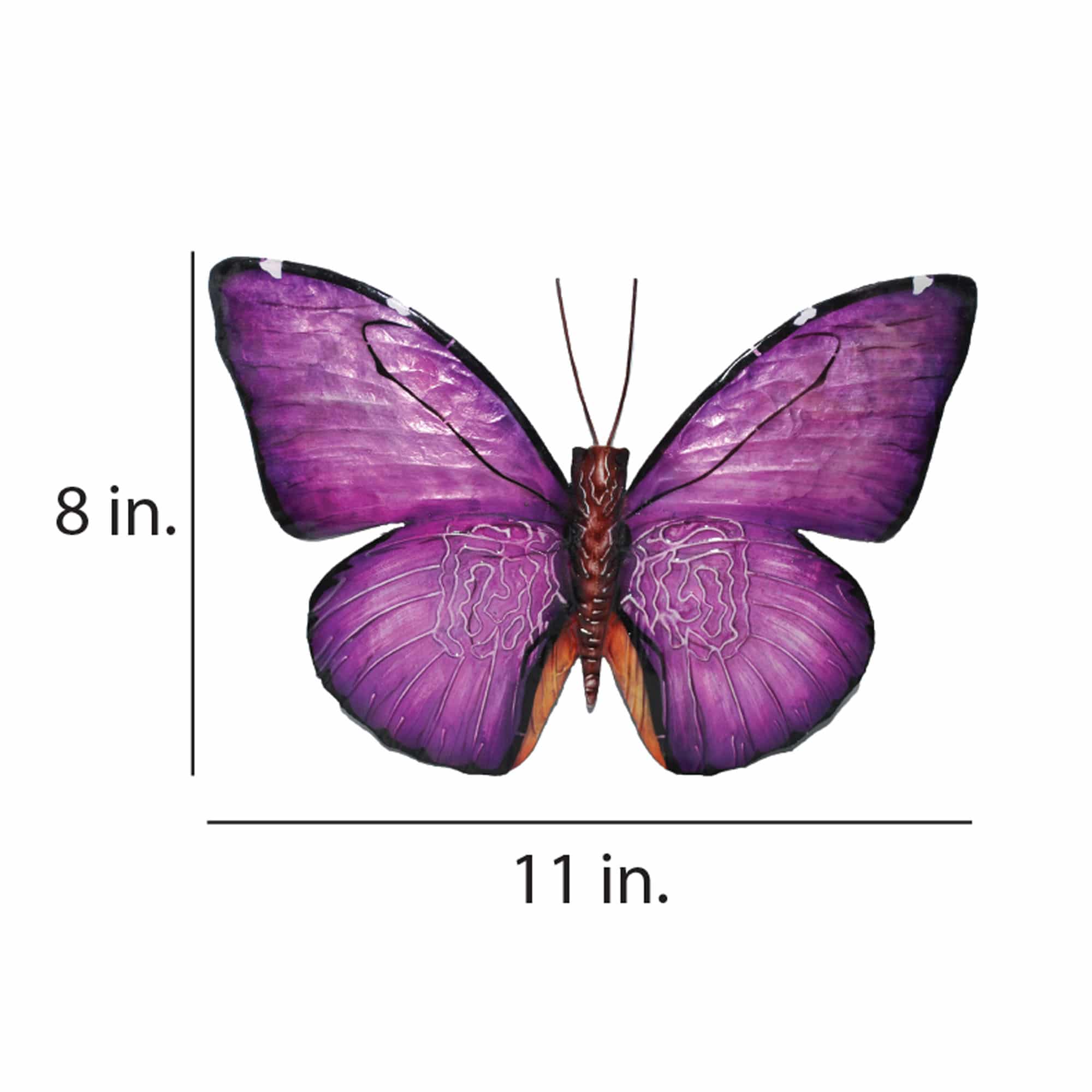
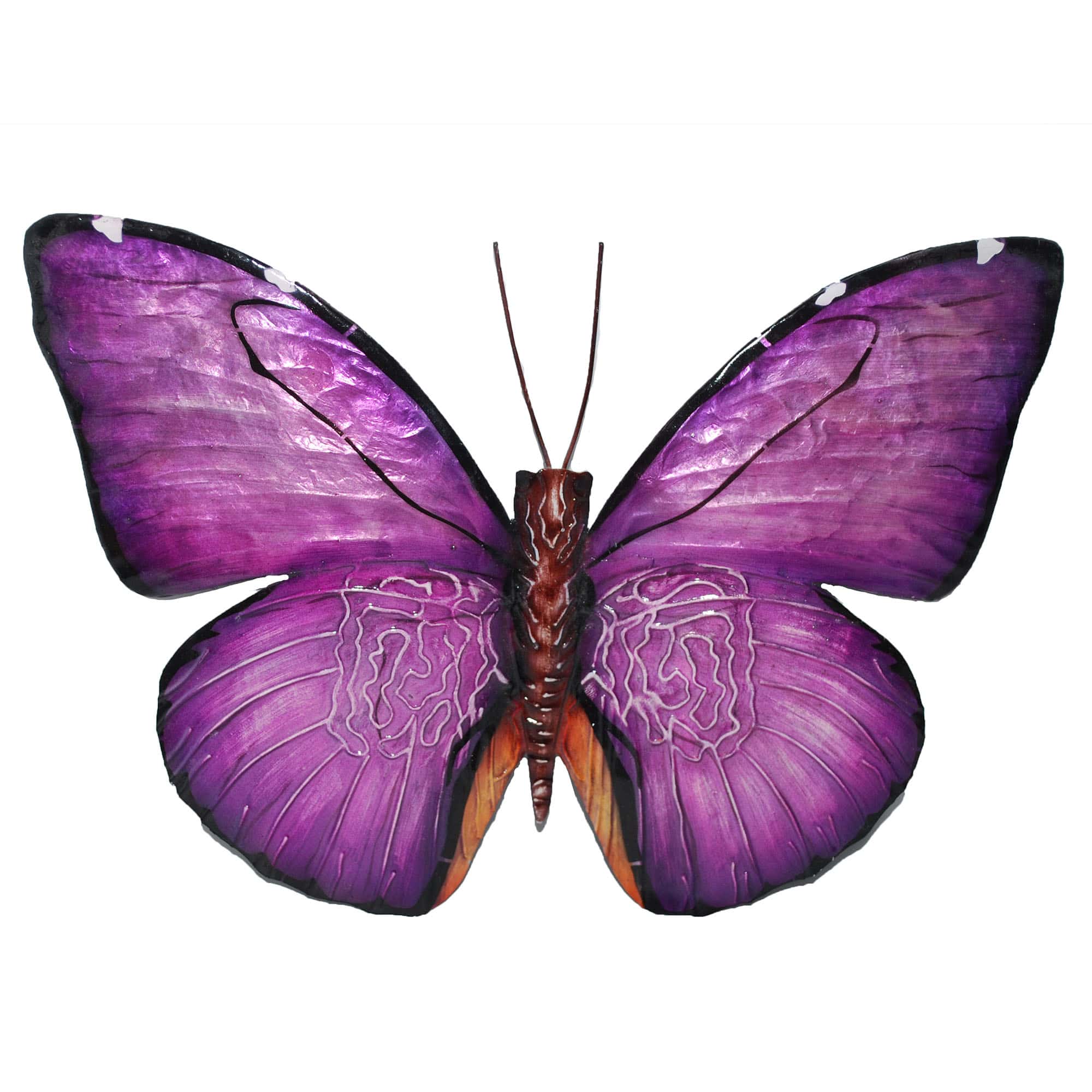
Purple is considered a color of royalty and wealth due to the rarity of the dye that originally produced it. Even though that no longer is the case, it still is considered a bold and rich color. The color is even more vibrant due to the strips of color created by the brush strokes against the capiz shell. The artist complemented the predominantly purple colored butterfly with oranges and reds at the base and a couple of white spots on each wing. If your color is primarily purple or if it is just used as an accent, this butterfly will complement any decor in your room.
The basic frame of the butterfly is created using tin, which is powder-coated with a black finish and makes this piece safe to use outdoors. The edges of the frame are reinforced using thicker tin wire. The front of this piece is adorned in areas with capiz shell, an oyster native to the Philippines, before being hand-painted and sealed with a water-based sealant. The primary purpose of this oyster to provide a source of food, however, the shell is a sustainable by-product that can be used for decoration. The capiz shell subtly replicates the reflective qualities of butterflies in nature. The entire piece is lightweight and has an eyelet in the back allowing it to be hung using a finishing nail, command strip, or a push pin. Due to it being a natural material, the organic colors of capiz come through as tans and browns underneath the paint.
-
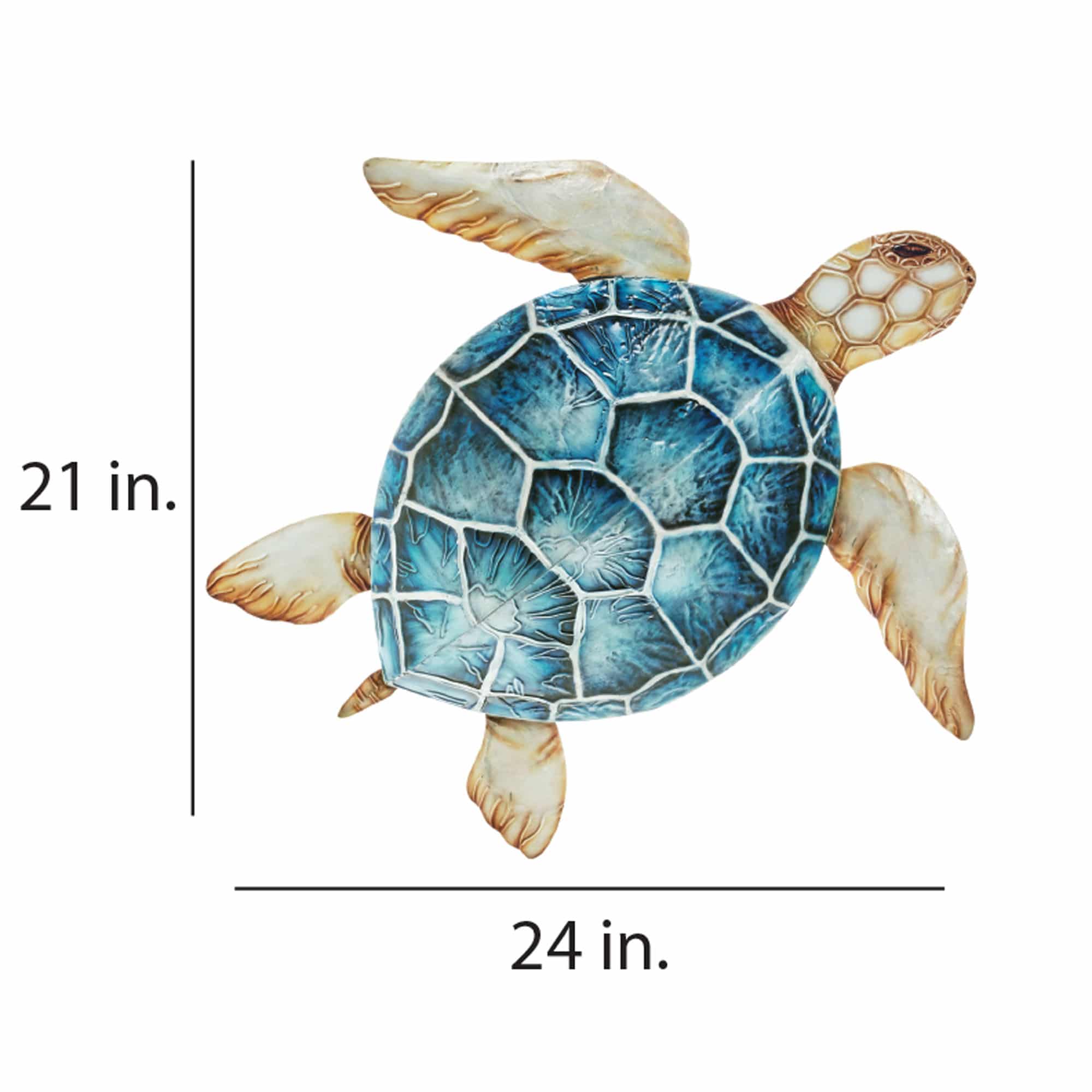
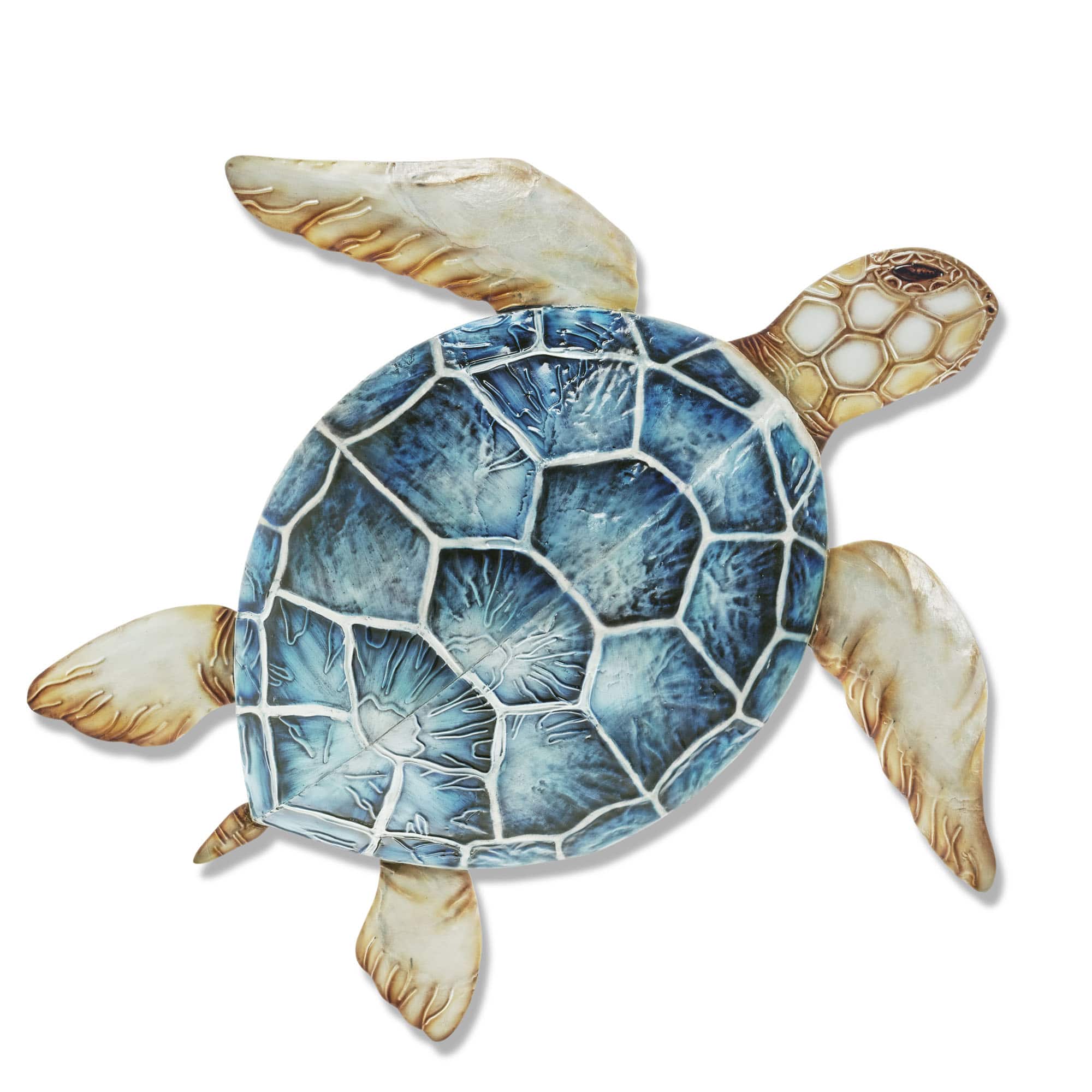 Sea turtles are among the most ancient species on this planet. Today there are seven species of sea turtle remaining that date back 110 million years, back to the age of the dinosaurs. This piece features the Loggerhead turtle, one of the most recognizable of all the sea. This creature is known for its scaled skin, which the artist carefully etches into the metal of the turtle's head and throughout the tips and edges of its body. The shell of the turtle glistens which the artist recreates using capiz shell. The focus of this awe-inspiring piece is the texture and size of sea turtles and the artist uses contrasting colors to underscore this fact. The basic frame of the turtle is created using tin, which is powder coated with a black finish. The frame is reinforced using tin wire along the inner edge. Capiz is an oyster shell and the primary purpose of the oyster is as a source of food. However, the by-product, the shell, can be used for decoration. Due to it being a natural material, the natural colors of the capiz come through as tans and browns underneath the paint. The shell is then painted the bold colors you see. The entire front facing piece is carefully hand-painted keeping in mind the reflective qualities in the color of turtles.
Sea turtles are among the most ancient species on this planet. Today there are seven species of sea turtle remaining that date back 110 million years, back to the age of the dinosaurs. This piece features the Loggerhead turtle, one of the most recognizable of all the sea. This creature is known for its scaled skin, which the artist carefully etches into the metal of the turtle's head and throughout the tips and edges of its body. The shell of the turtle glistens which the artist recreates using capiz shell. The focus of this awe-inspiring piece is the texture and size of sea turtles and the artist uses contrasting colors to underscore this fact. The basic frame of the turtle is created using tin, which is powder coated with a black finish. The frame is reinforced using tin wire along the inner edge. Capiz is an oyster shell and the primary purpose of the oyster is as a source of food. However, the by-product, the shell, can be used for decoration. Due to it being a natural material, the natural colors of the capiz come through as tans and browns underneath the paint. The shell is then painted the bold colors you see. The entire front facing piece is carefully hand-painted keeping in mind the reflective qualities in the color of turtles. -
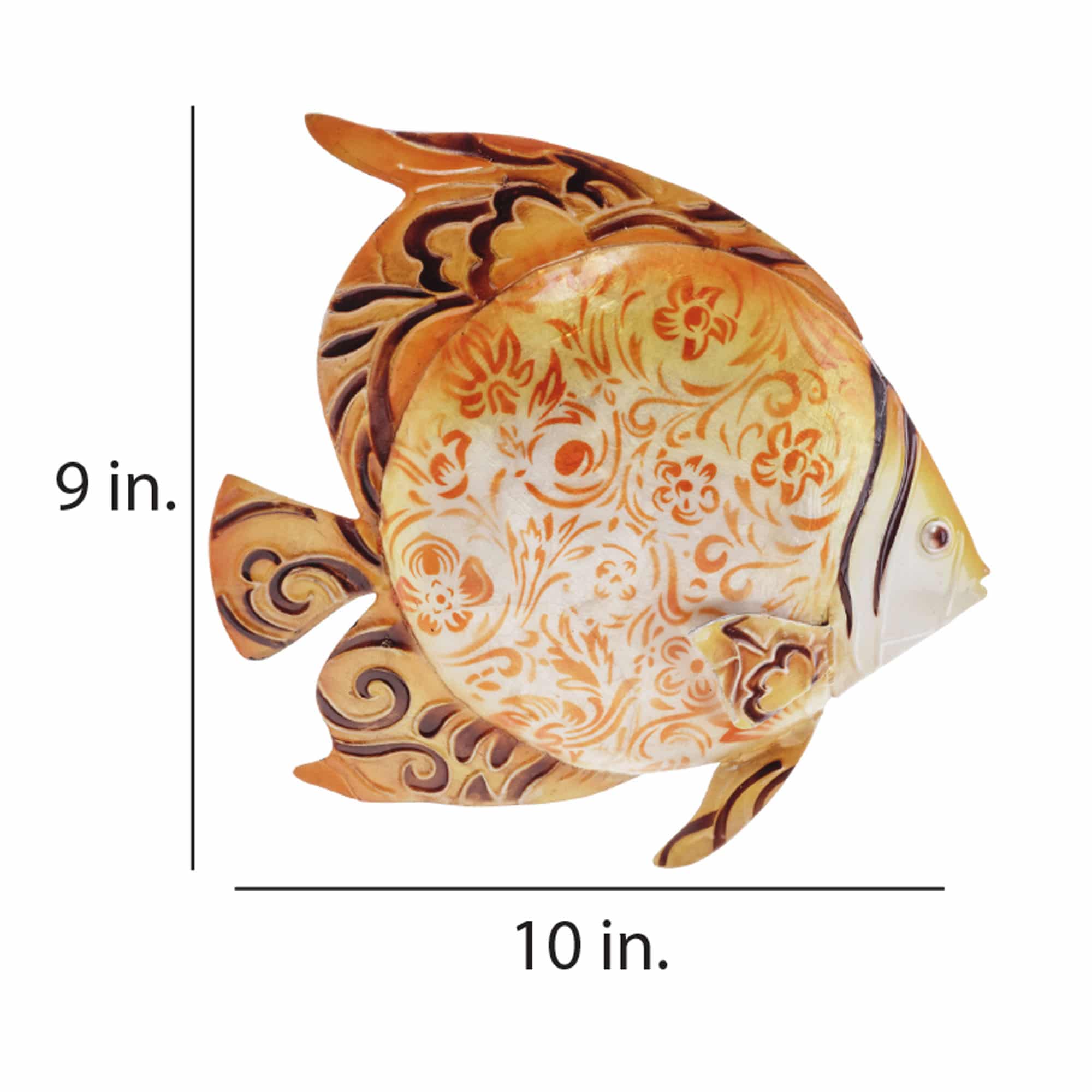
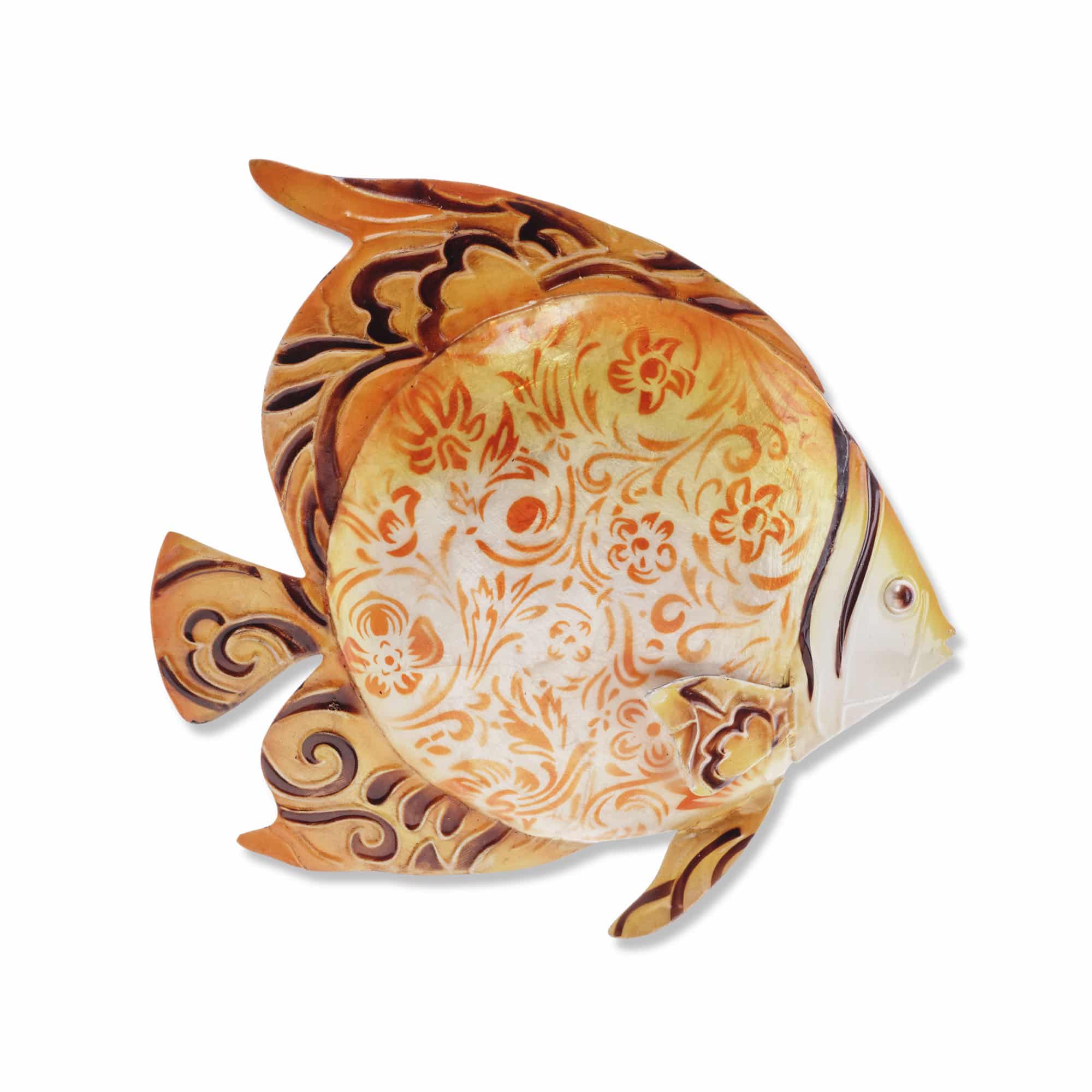 It's big. It's round and it's called an Opah. It looks like a goldfish that seriously outgrew its bowl. The Opah's bright orange is represented in this piece. Instead of spots, the artist took license and painted intricate floral patterns on top of capiz shells. The artist continues by pressing patterns into the tin both in the fins and the face of this magnificent fish. The basic frame of the wall fish is created using tin, which is powder coated as a black finish. The frame is reinforced using wrought iron wire along the inner edge. Capiz is an oyster shell and the primary purpose of the oyster is as a source of food. However, the by-product, the shell, can be used for decoration. Due to it being a natural material, the natural colors of the capiz can come through as tans and browns underneath the paint.
It's big. It's round and it's called an Opah. It looks like a goldfish that seriously outgrew its bowl. The Opah's bright orange is represented in this piece. Instead of spots, the artist took license and painted intricate floral patterns on top of capiz shells. The artist continues by pressing patterns into the tin both in the fins and the face of this magnificent fish. The basic frame of the wall fish is created using tin, which is powder coated as a black finish. The frame is reinforced using wrought iron wire along the inner edge. Capiz is an oyster shell and the primary purpose of the oyster is as a source of food. However, the by-product, the shell, can be used for decoration. Due to it being a natural material, the natural colors of the capiz can come through as tans and browns underneath the paint. -
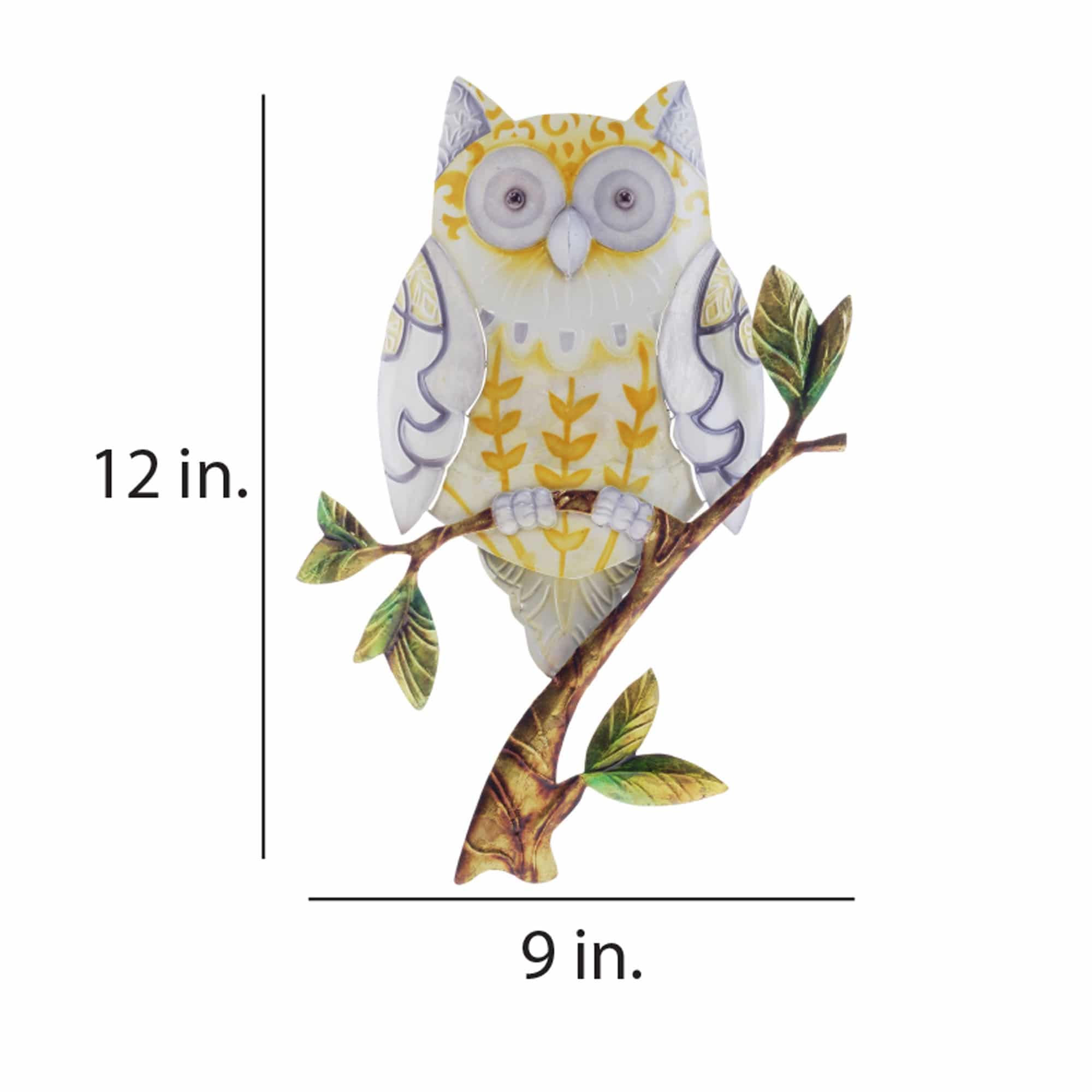
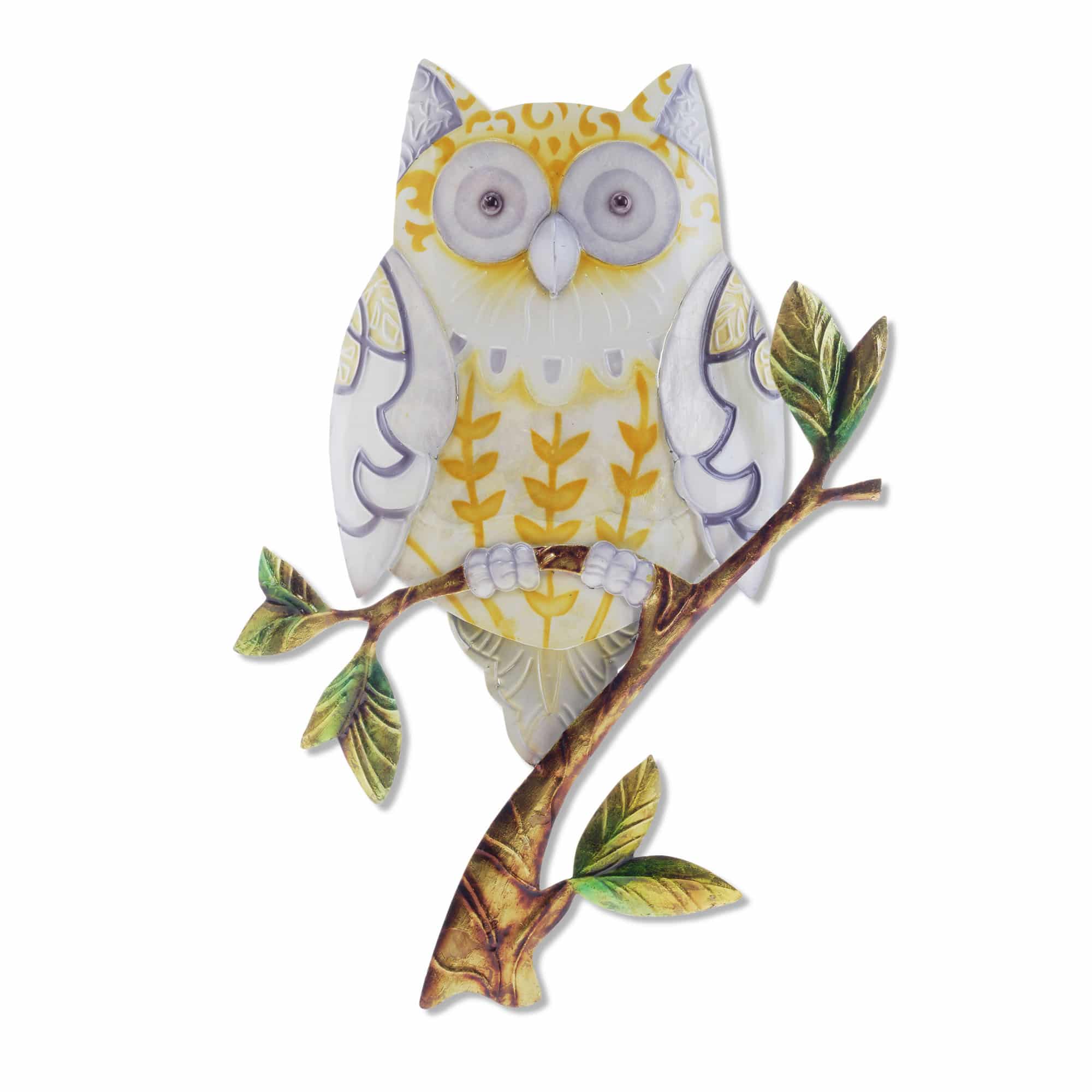 The owl was a bird of prophecy and wisdom in many ancient cultures. Its wide eyes seem to miss nothing and when an owl moves it seems calculated. Even though the colors and designs on the owl are human interpretations, the perched look is defiantly natural. The artist uses capiz shell on the wings to highlight the reflective nature of some of the owl's feathers. The basic frame of the owl is created using tin, which is powder coated with a black finish. The frame is reinforced using tin wire along the inner edge. Capiz is an oyster shell and the primary purpose of the oyster is as a source of food. However, the by-product, the shell, can be used for decoration.
The owl was a bird of prophecy and wisdom in many ancient cultures. Its wide eyes seem to miss nothing and when an owl moves it seems calculated. Even though the colors and designs on the owl are human interpretations, the perched look is defiantly natural. The artist uses capiz shell on the wings to highlight the reflective nature of some of the owl's feathers. The basic frame of the owl is created using tin, which is powder coated with a black finish. The frame is reinforced using tin wire along the inner edge. Capiz is an oyster shell and the primary purpose of the oyster is as a source of food. However, the by-product, the shell, can be used for decoration. -
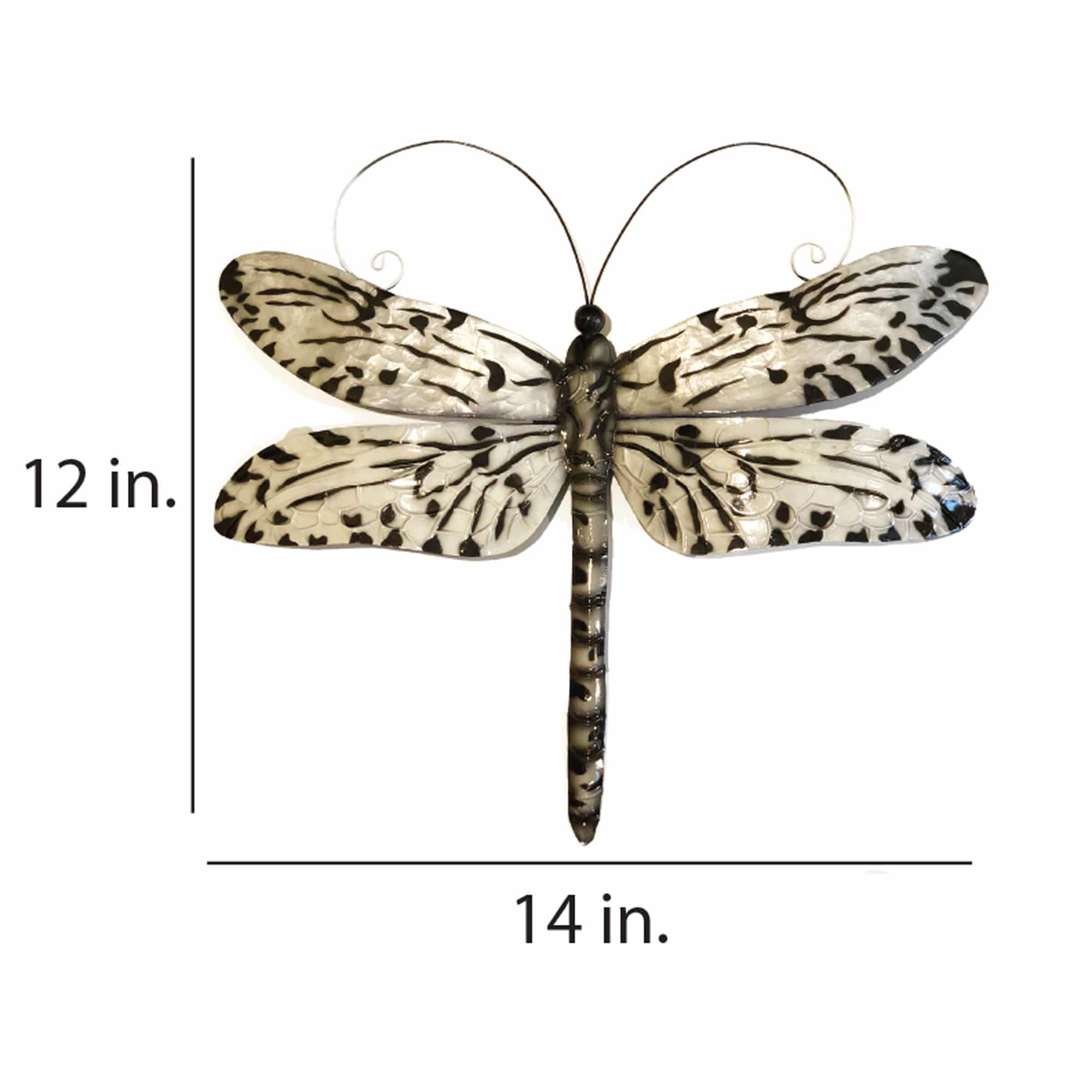
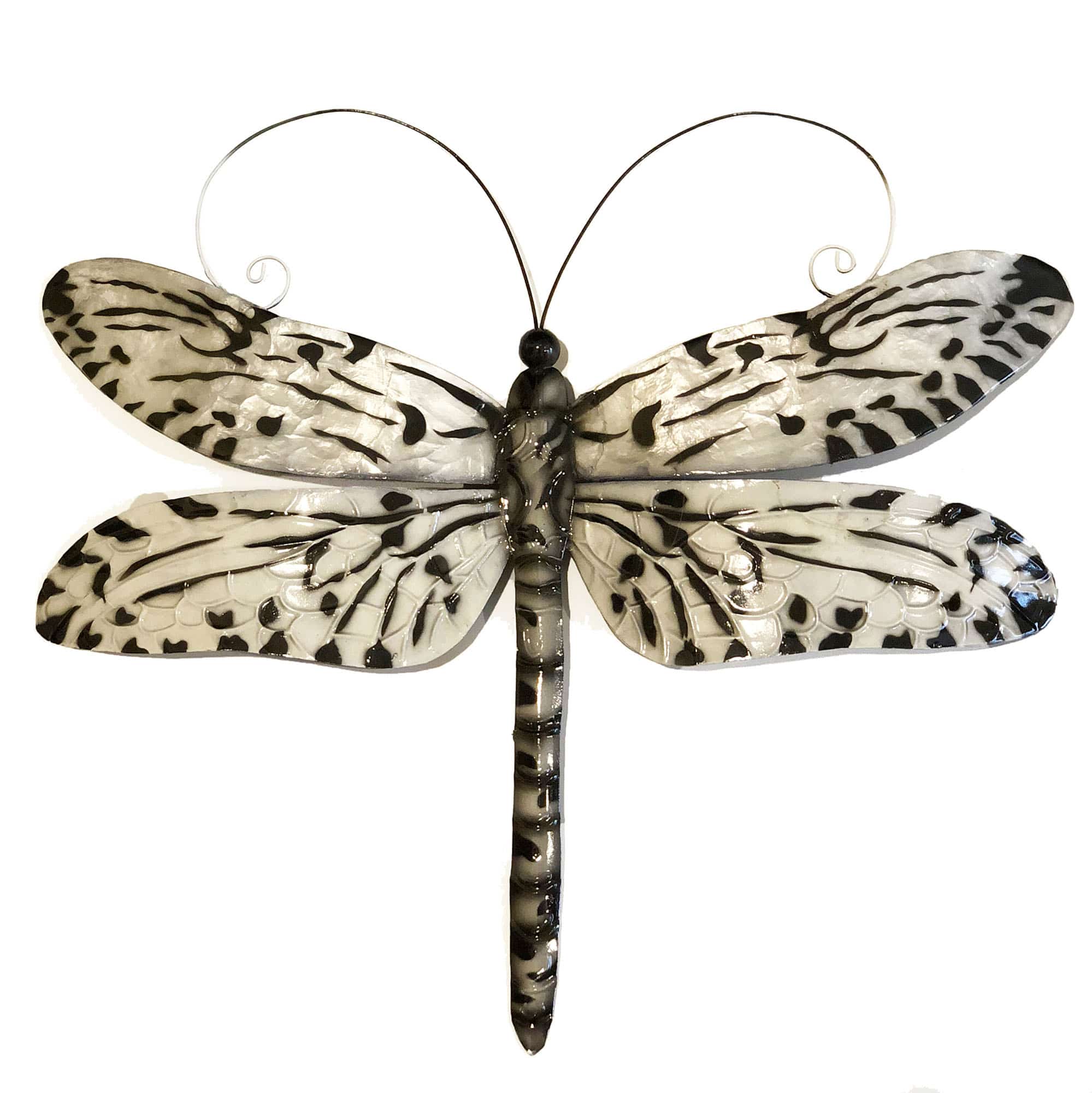
Angelic and graceful, this dragonfly is distinctive and regal. The wings of this piece are rather large and stately, particularly when this beauty flies on the breeze from flower to flower. The artist brings this to life by crafting the body smaller compared to the wings. The upper wings are adorned with capiz shell, giving it the translucent color seen in the natural dragonfly. The lower wings are constructed from tin and the colors help accentuate the vein structures. The combination of the two will add both color and structure to your wall and your room.
The basic frame of the dragonfly is created using tin, which is powder-coated with a black finish and makes this piece safe to use outdoors. The edges of the frame are reinforced using thicker tin wire. The front of this piece is adorned in areas with capiz shell, an oyster native to the Philippines, before being hand-painted and sealed with a water-based sealant. The primary purpose of this oyster to provide a source of food, however, the shell is a sustainable by-product that can be used for decoration. The capiz shell subtly replicates the reflective qualities of dragonflies in nature. The entire piece is lightweight and has an eyelet in the back allowing it to be hung using a finishing nail, command strip, or a push pin. Due to it being a natural material, the organic colors of capiz come through as tans and browns underneath the paint.
-


The wings of this dragonfly are rather large and stately, particularly when this beauty flies on the breeze from flower to flower. The artist brings this to life by crafting the body smaller compared to the wings. The wings are adorned with capiz shell, giving it the translucent color seen in a natural dragonfly. Veins are drawn in throughout it and accentuated on its back are bright red spots, meant to pop out.
The basic frame of the dragonfly is created using tin, which is powder-coated with a black finish and makes this piece safe to use outdoors. The edges of the frame are reinforced using thicker tin wire. The front of this piece is adorned in areas with capiz shell, an oyster native to the Philippines, before being hand-painted and sealed with a water-based sealant. The primary purpose of this oyster to provide a source of food, however, the shell is a sustainable by-product that can be used for decoration. The capiz shell subtly replicates the reflective qualities of dragonflies in nature. The entire piece is lightweight and has an eyelet in the back allowing it to be hung using a finishing nail, command strip, or a push pin. Due to it being a natural material, the organic colors of capiz come through as tans and browns underneath the paint.
-
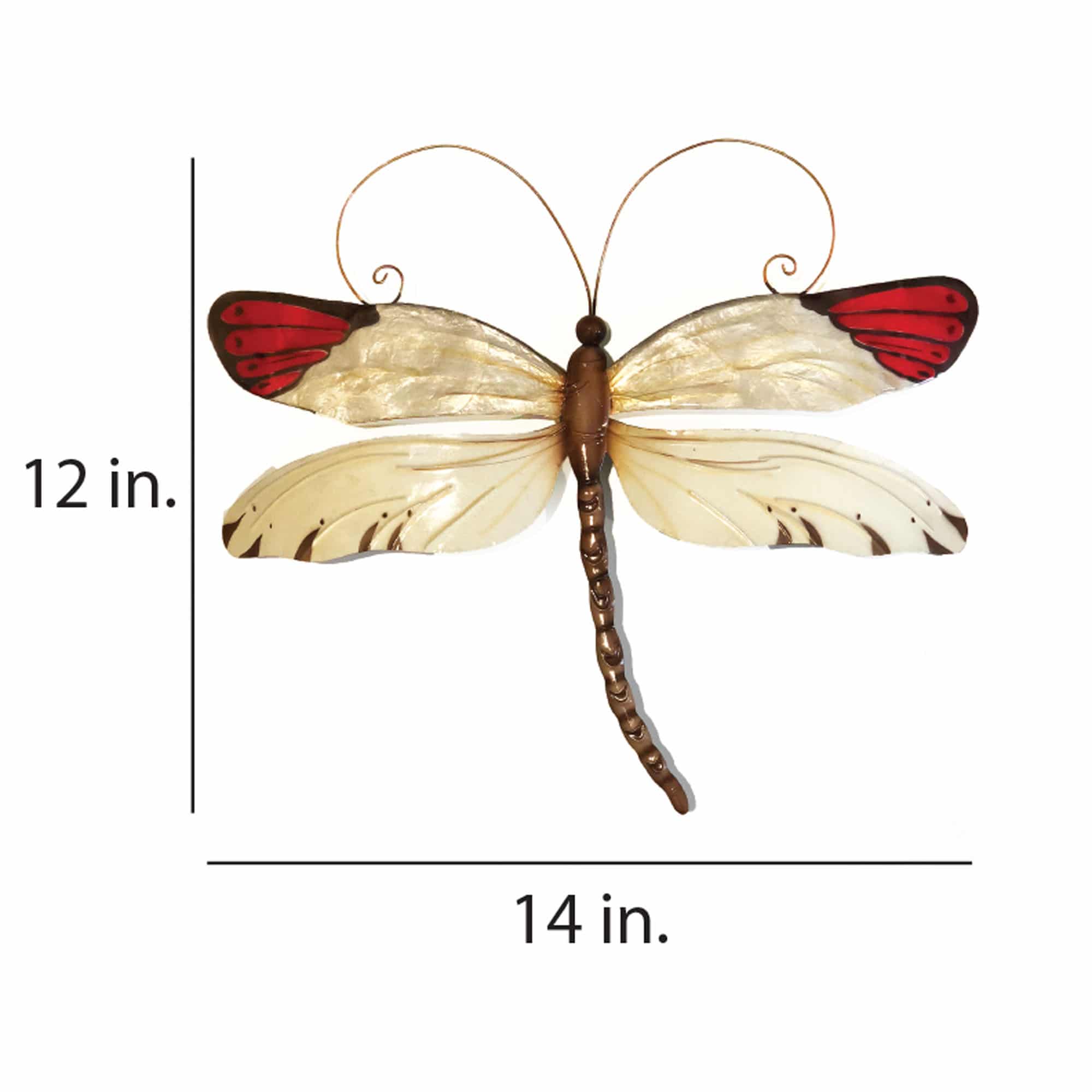

Starting with a base color of pearl white, the artist uses different techniques and splashes of color to craft a distinctive piece. The upper wings are created using capiz oyster shell, left natural to bring in different natural hues. The red base color is accented using brown feathering patterns. The lower portion of the wing is made of tin, textured to highlight the lines that stem from the body of the dragonfly.
The basic frame of the dragonfly is created using tin, which is powder-coated with a black finish and makes this piece safe to use outdoors. The edges of the frame are reinforced using thicker tin wire. The front of this piece is adorned in areas with capiz shell, an oyster native to the Philippines, before being hand-painted and sealed with a water-based sealant. The primary purpose of this oyster to provide a source of food, however, the shell is a sustainable by-product that can be used for decoration. The capiz shell subtly replicates the reflective qualities of dragonflies in nature. The entire piece is lightweight and has an eyelet in the back allowing it to be hung using a finishing nail, command strip, or a push pin. Due to it being a natural material, the organic colors of capiz come through as tans and browns underneath the paint.
-
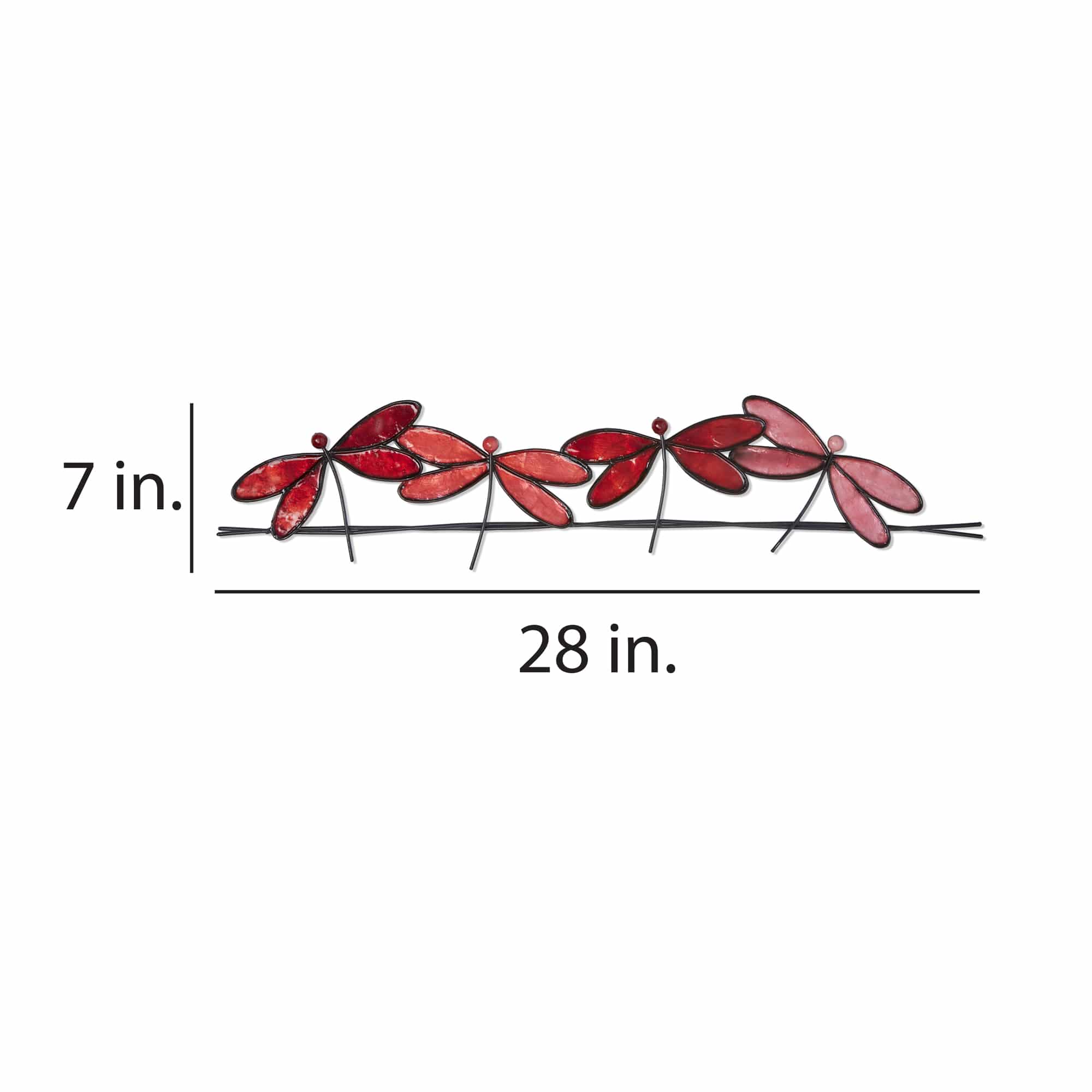
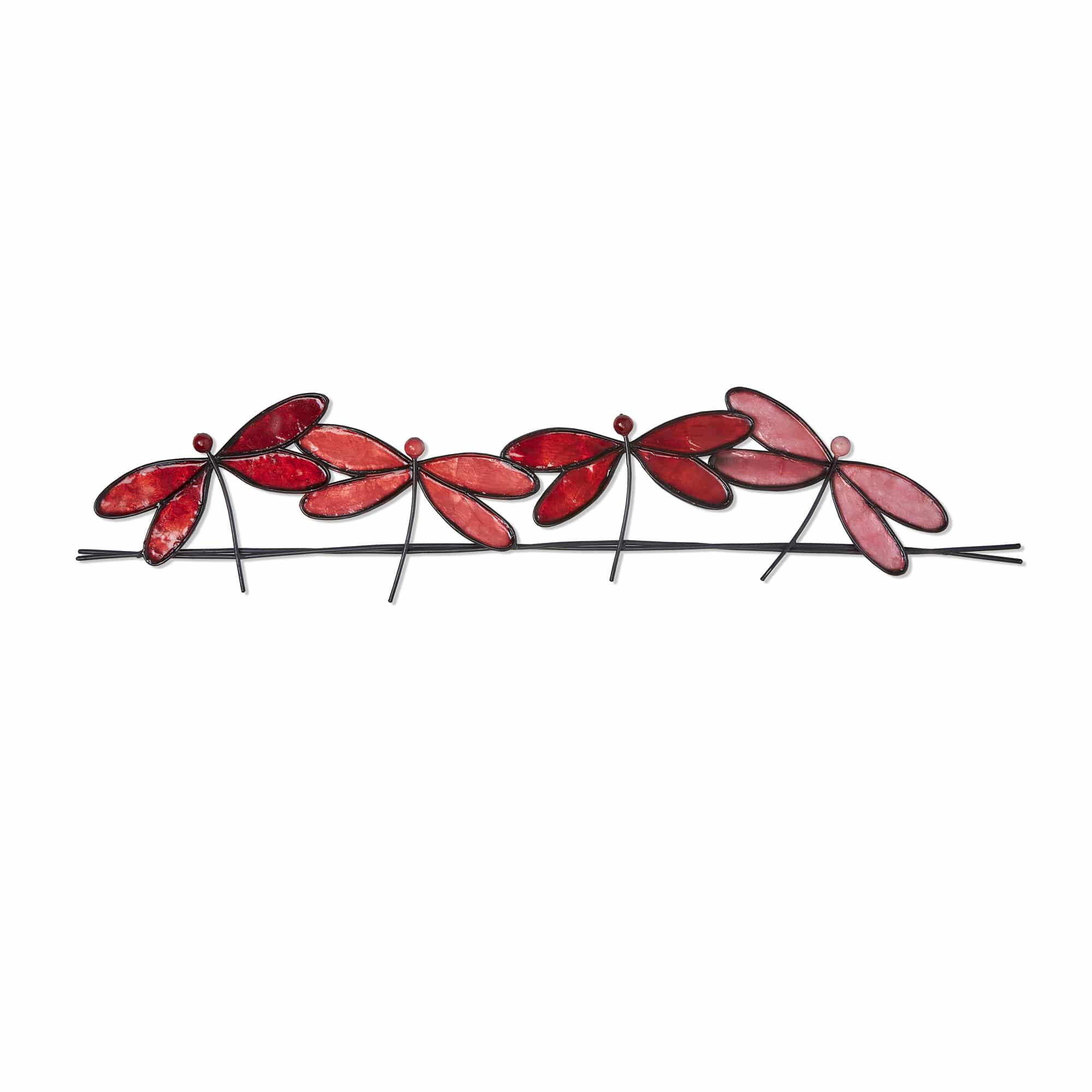 Four dragonflies are taking a mid-day break from fluttering and their characteristically unpredictable flight patterns around the lake. The slender, metal body of each dragonfly connects to colorful, capiz-shell wings, which catches light and adds shine. Each wing is framed using sturdy wrought iron and reinforced with a metal backing. The basic frame of the dragonfly is created using tin, which is powder-coated with a black finish and makes this piece safe to use outdoors. The edges of the frame are reinforced using thicker tin wire. The front of this piece is adorned in areas with capiz shell, an oyster native to the Philippines, before being hand-painted and sealed with a water-based sealant. The primary purpose of this oyster to provide a source of food, however, the shell is a sustainable by-product that can be used for decoration. The capiz shell subtly replicates the reflective qualities of dragonflies in nature. The entire piece is lightweight and has an eyelet in the back allowing it to be hung using a finishing nail, command strip, or a push pin. Due to it being a natural material, the organic colors of capiz come through as tans and browns underneath the paint.
Four dragonflies are taking a mid-day break from fluttering and their characteristically unpredictable flight patterns around the lake. The slender, metal body of each dragonfly connects to colorful, capiz-shell wings, which catches light and adds shine. Each wing is framed using sturdy wrought iron and reinforced with a metal backing. The basic frame of the dragonfly is created using tin, which is powder-coated with a black finish and makes this piece safe to use outdoors. The edges of the frame are reinforced using thicker tin wire. The front of this piece is adorned in areas with capiz shell, an oyster native to the Philippines, before being hand-painted and sealed with a water-based sealant. The primary purpose of this oyster to provide a source of food, however, the shell is a sustainable by-product that can be used for decoration. The capiz shell subtly replicates the reflective qualities of dragonflies in nature. The entire piece is lightweight and has an eyelet in the back allowing it to be hung using a finishing nail, command strip, or a push pin. Due to it being a natural material, the organic colors of capiz come through as tans and browns underneath the paint. -
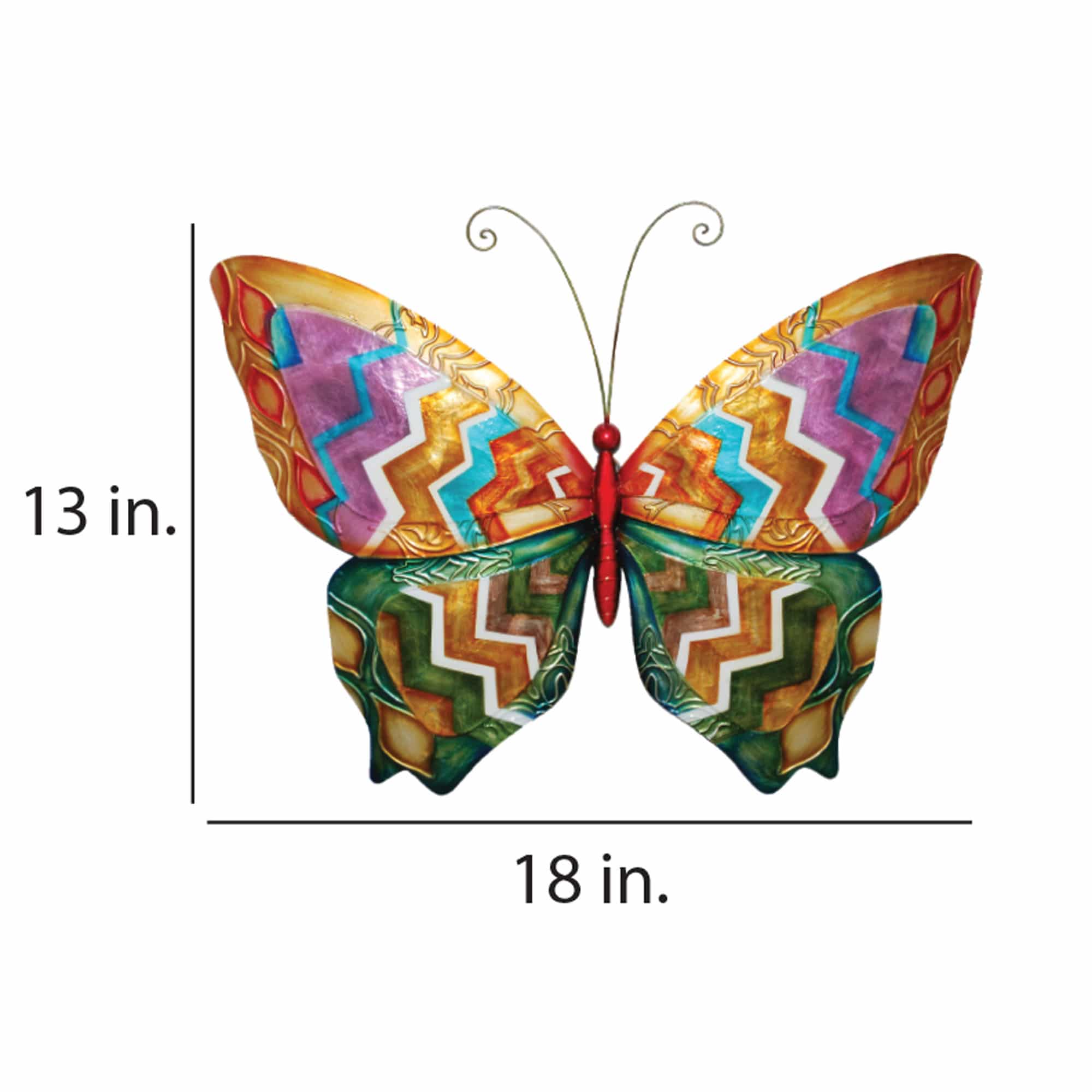

This butterfly shows sharp, bold, beautiful contrasting colors. Using a stylized design, the artist uses shimmering capiz shell and radiating zig zag patterns to create warmth and excitement. These bright colors are complimented by a subtle texture set within the metal work.
The basic frame of the butterfly is created using tin, which is powder-coated with a black finish and makes this piece safe to use outdoors. The edges of the frame are reinforced using thicker tin wire. The front of this piece is adorned in areas with capiz shell, an oyster native to the Philippines, before being hand-painted and sealed with a water-based sealant. The primary purpose of this oyster to provide a source of food, however, the shell is a sustainable by-product that can be used for decoration. The capiz shell subtly replicates the reflective qualities of butterflies in nature. The entire piece is lightweight and has an eyelet in the back allowing it to be hung using a finishing nail, command strip, or a push pin. Due to it being a natural material, the organic colors of capiz come through as tans and browns underneath the paint.
-
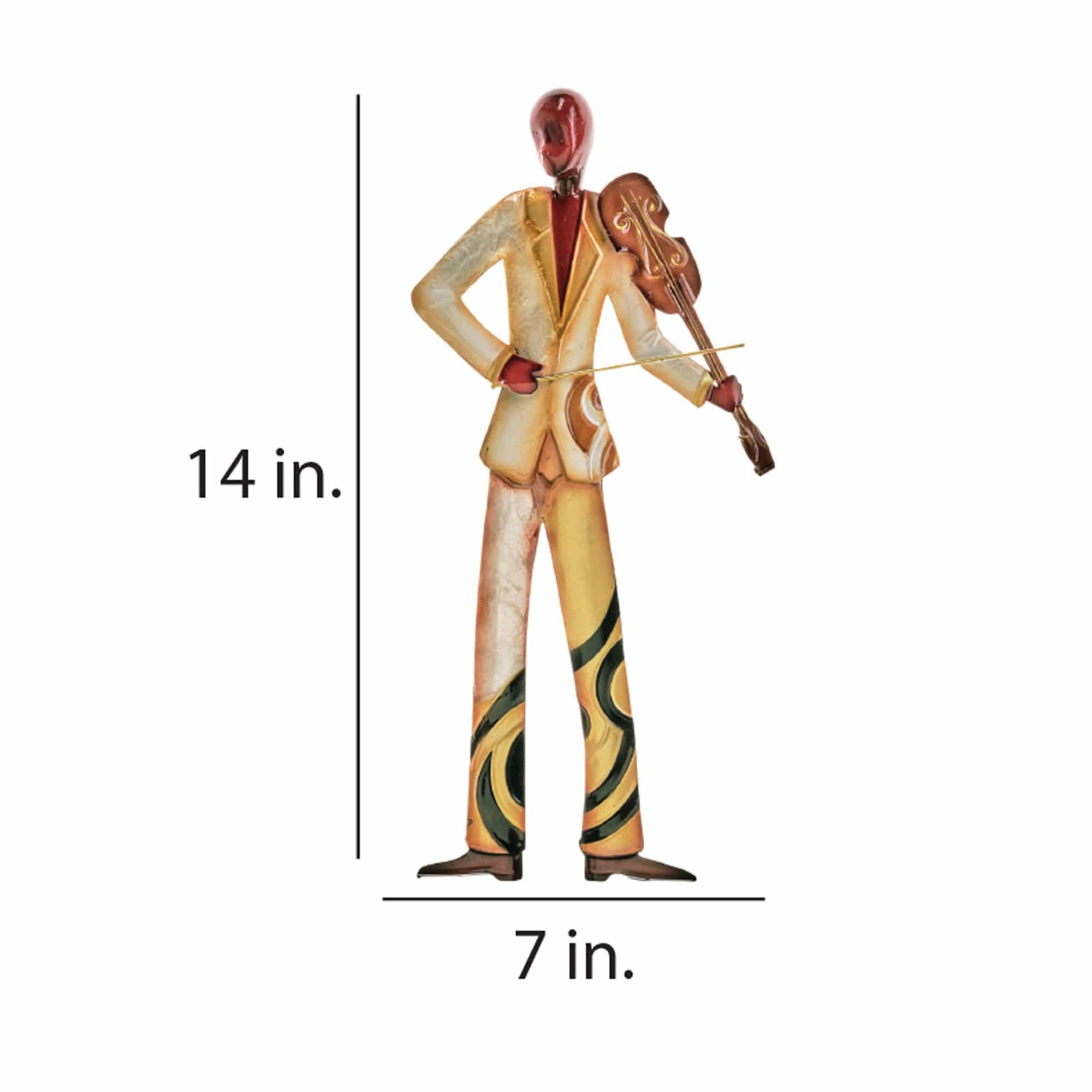
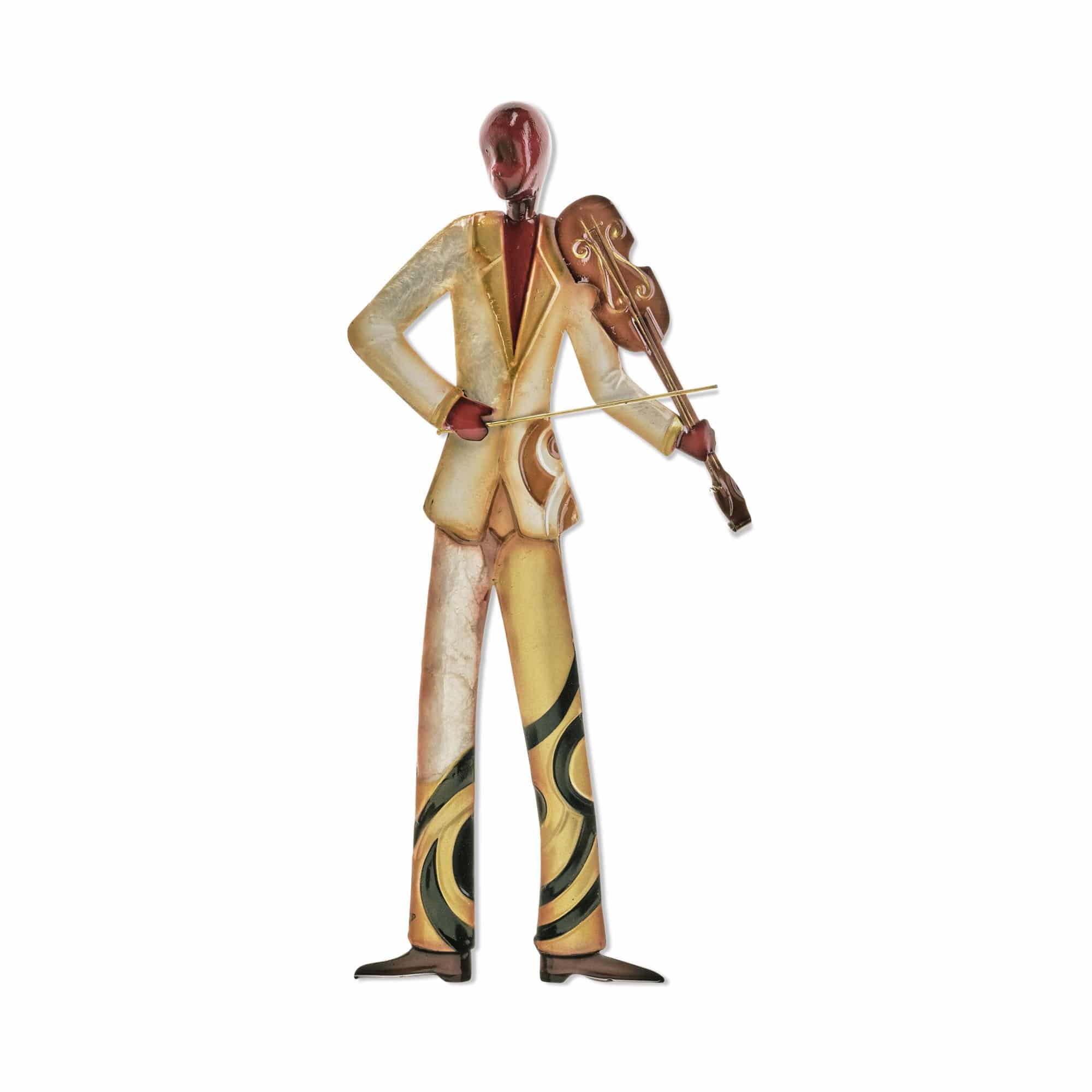
The violin transcends time. Used in both formal and festive settings, this instrument is used to convey a journey or to simply get people up to dance. The artisans bring both into one piece of art. The formal wear of the violinist invokes the classics while the color and shading of the clothing represents the festive. The well-dressed violin player is partially adorned with capiz giving it a shimmer as it reflects light, again bringing out the festive side of the instrument.
The frame of the Violin Player Wall Decor is created using tin, which is powder coated in a black finish. The frame is reinforced using wrought iron wire inner edge or outer edge. Capiz is an oyster shell and the primary purpose of the oyster is as a source of food. However, the by-product, the shell, can be used for decoration. Due to it being a natural material, the natural colors of the capiz can come through as tans and browns underneath the paint.
-
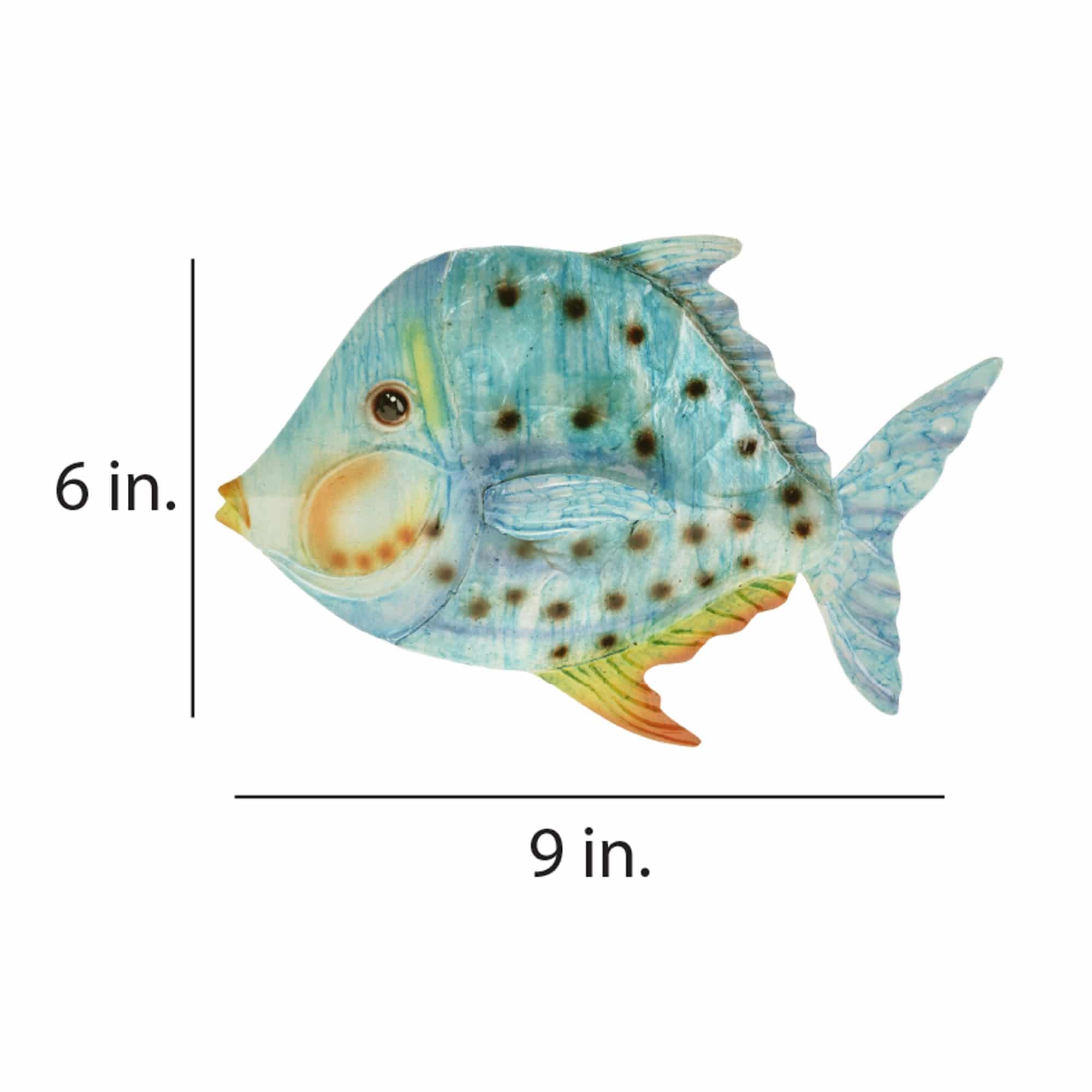
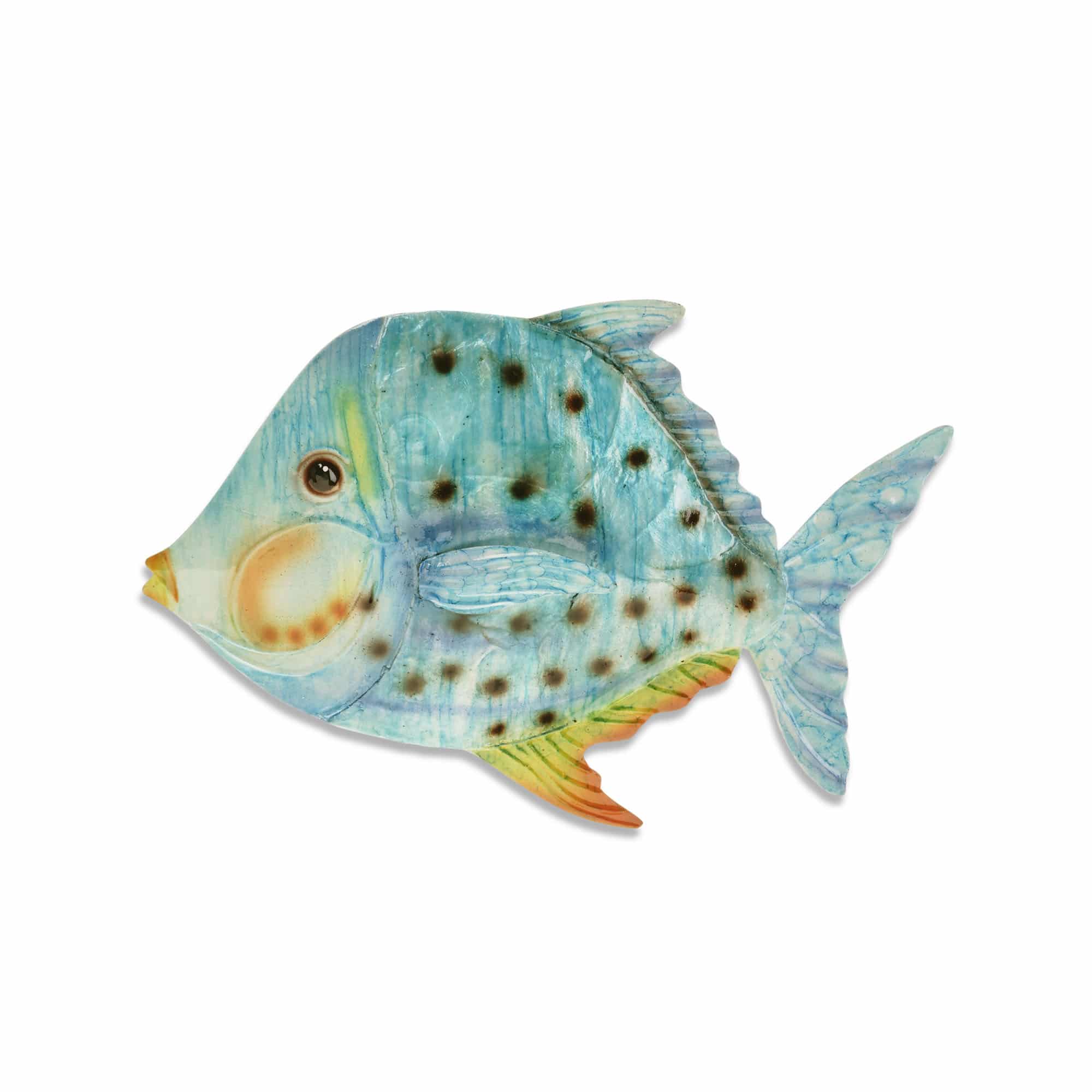 The Caribbean is known for its brightly colored fish. However, the Caribbean silver fish, with its tall forhead and flashy finish can be even more captivating. Found in large schools, this quck fish can change directions in a heartbeat. The artist using capiz shell to capture the shimmer generated as filtered light bounces off its shiny body. The basic frame of the wall fish is created using tin, which is powder coated as a black finish. The frame is reinforced using wrought iron wire along the inner edge. Capiz is an oyster shell and the primary purpose of the oyster is as a source of food. However, the by-product, the shell, can be used for decoration.
The Caribbean is known for its brightly colored fish. However, the Caribbean silver fish, with its tall forhead and flashy finish can be even more captivating. Found in large schools, this quck fish can change directions in a heartbeat. The artist using capiz shell to capture the shimmer generated as filtered light bounces off its shiny body. The basic frame of the wall fish is created using tin, which is powder coated as a black finish. The frame is reinforced using wrought iron wire along the inner edge. Capiz is an oyster shell and the primary purpose of the oyster is as a source of food. However, the by-product, the shell, can be used for decoration. -
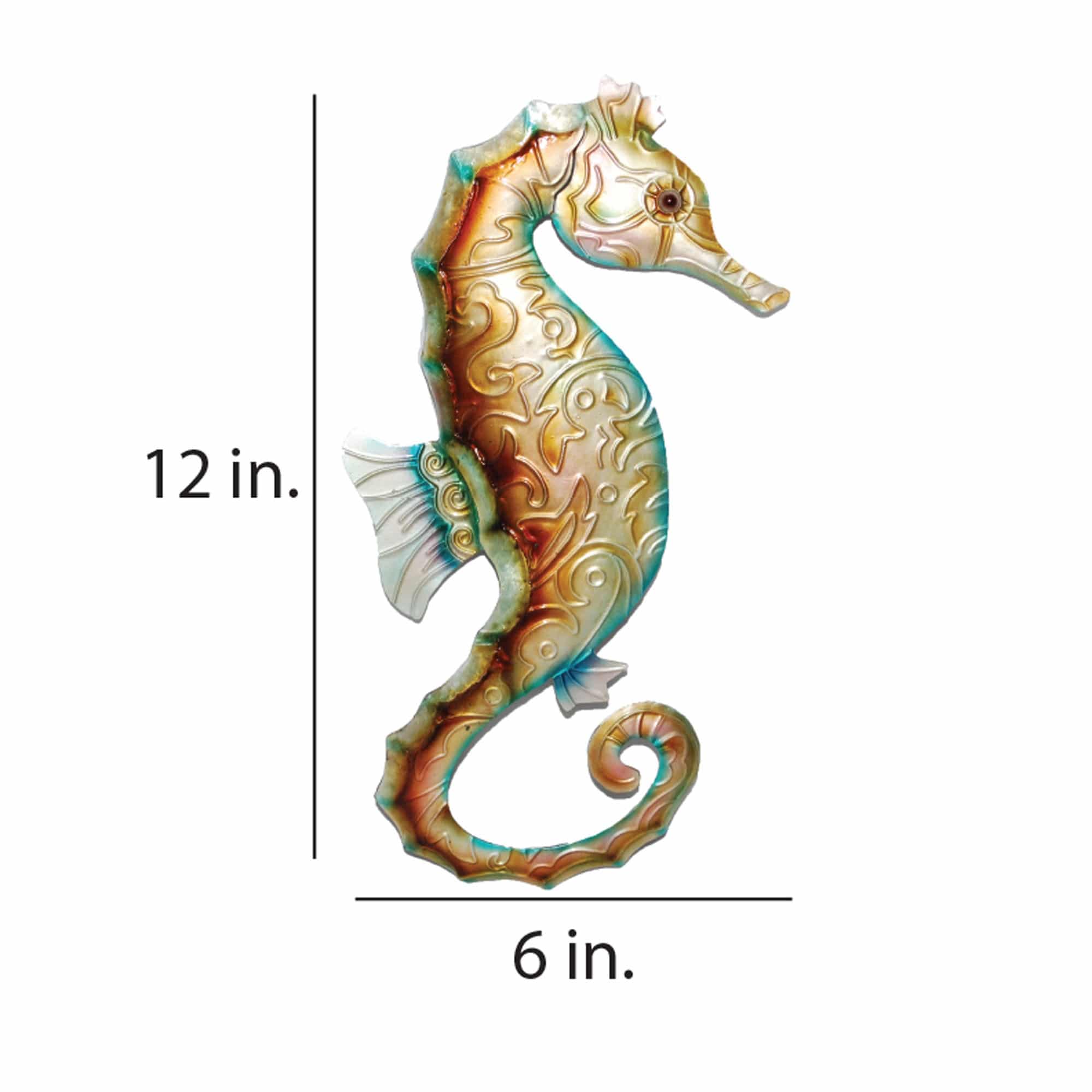
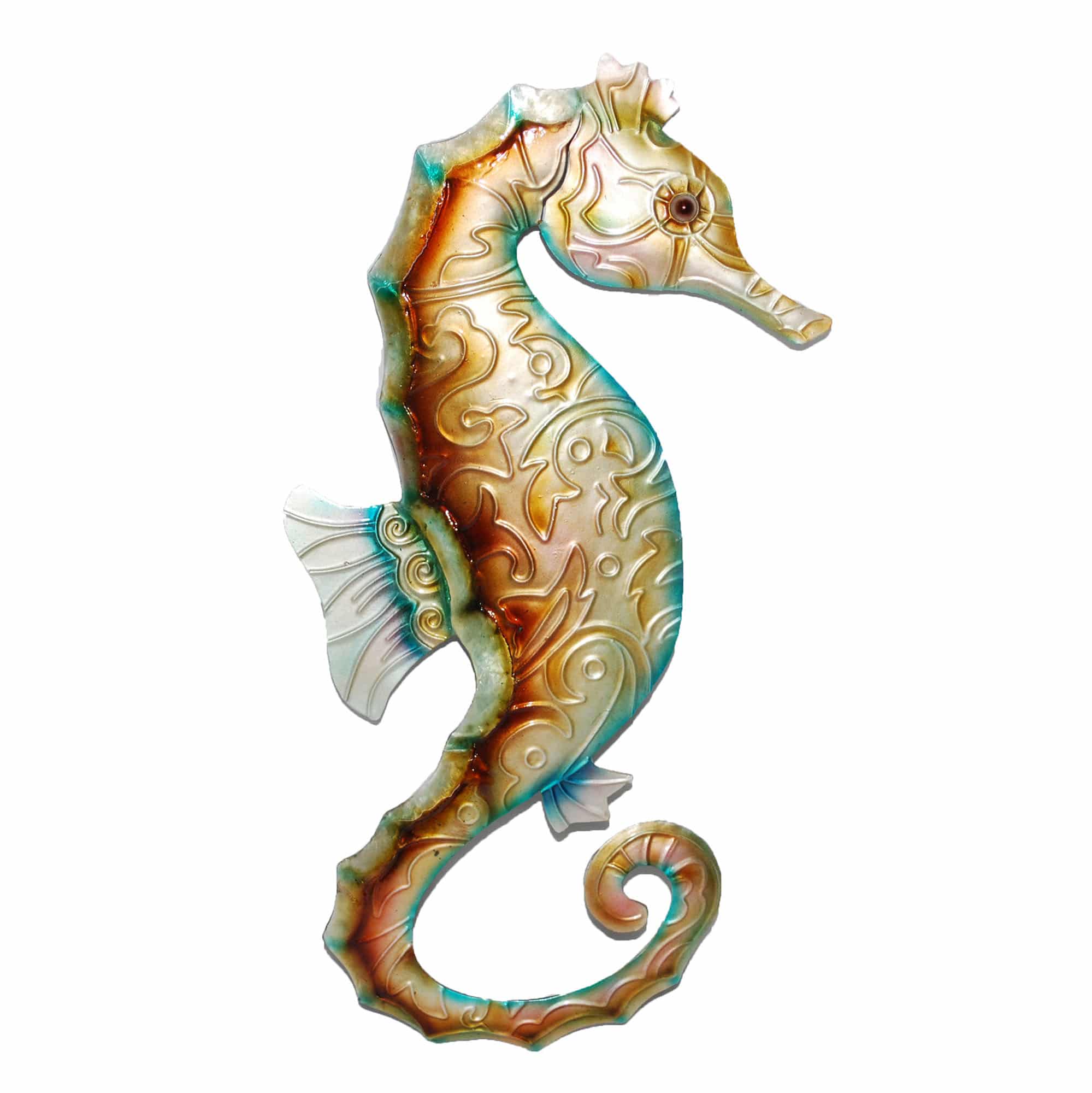 The seahorse has captured the minds and imaginations of people across all cultures for thousands of years. Seen as a symbol of good luck, strength and safety, this unique and beautiful animal is as charming as it is mysterious. The artist captures the beauty of the seahorse with a raised fine, high shine, hand-painted finish, and elegant mother of pearl chest and forefront. The basic frame of the wall seahorse is created using tin, which is powder coated as a black finish. Capiz is an oyster shell and the primary purpose of the oyster is as a source of food. However, the by-product, the shell, can be used for decoration. Due to it being a natural material, the natural colors of the capiz can come through as tans and browns.
The seahorse has captured the minds and imaginations of people across all cultures for thousands of years. Seen as a symbol of good luck, strength and safety, this unique and beautiful animal is as charming as it is mysterious. The artist captures the beauty of the seahorse with a raised fine, high shine, hand-painted finish, and elegant mother of pearl chest and forefront. The basic frame of the wall seahorse is created using tin, which is powder coated as a black finish. Capiz is an oyster shell and the primary purpose of the oyster is as a source of food. However, the by-product, the shell, can be used for decoration. Due to it being a natural material, the natural colors of the capiz can come through as tans and browns. -
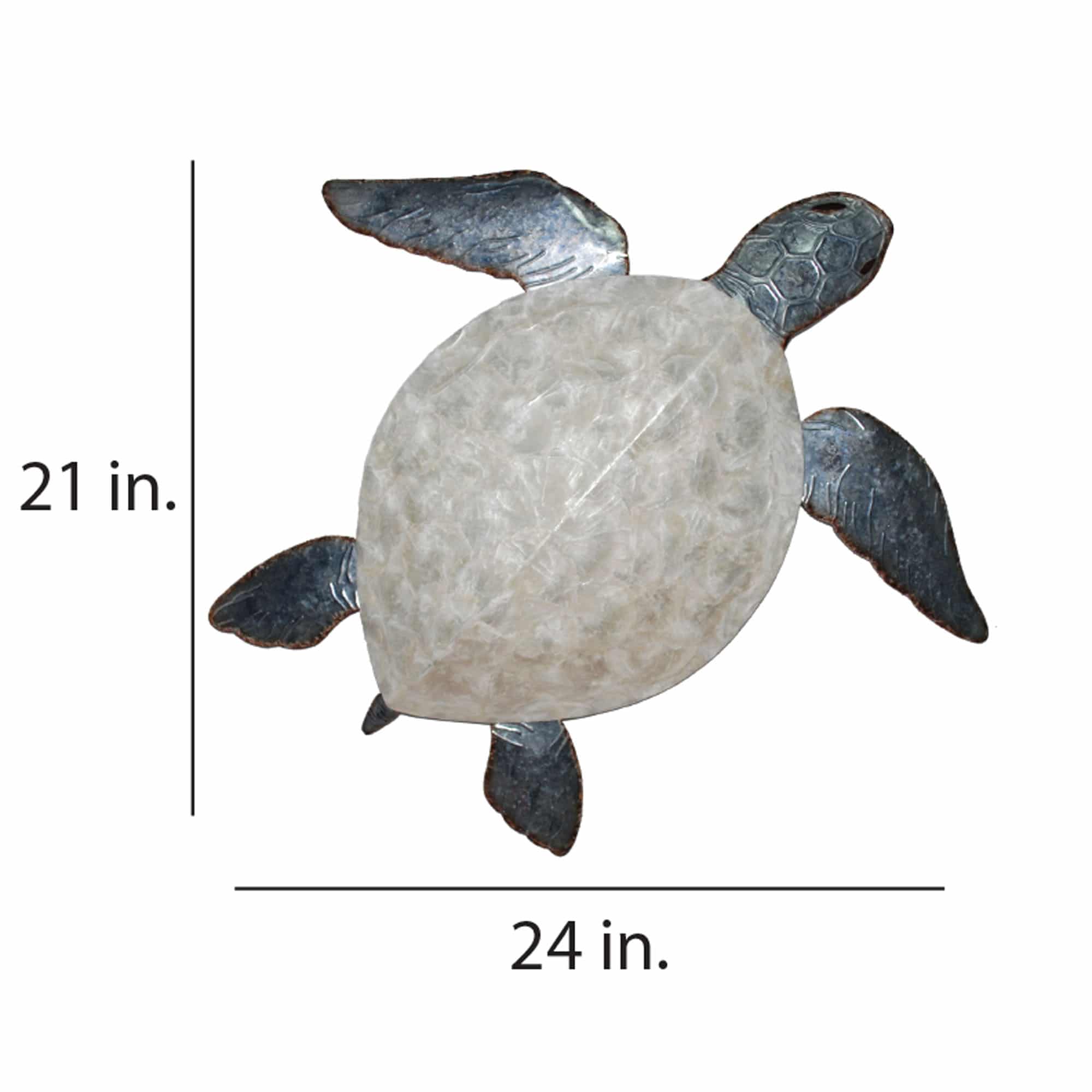
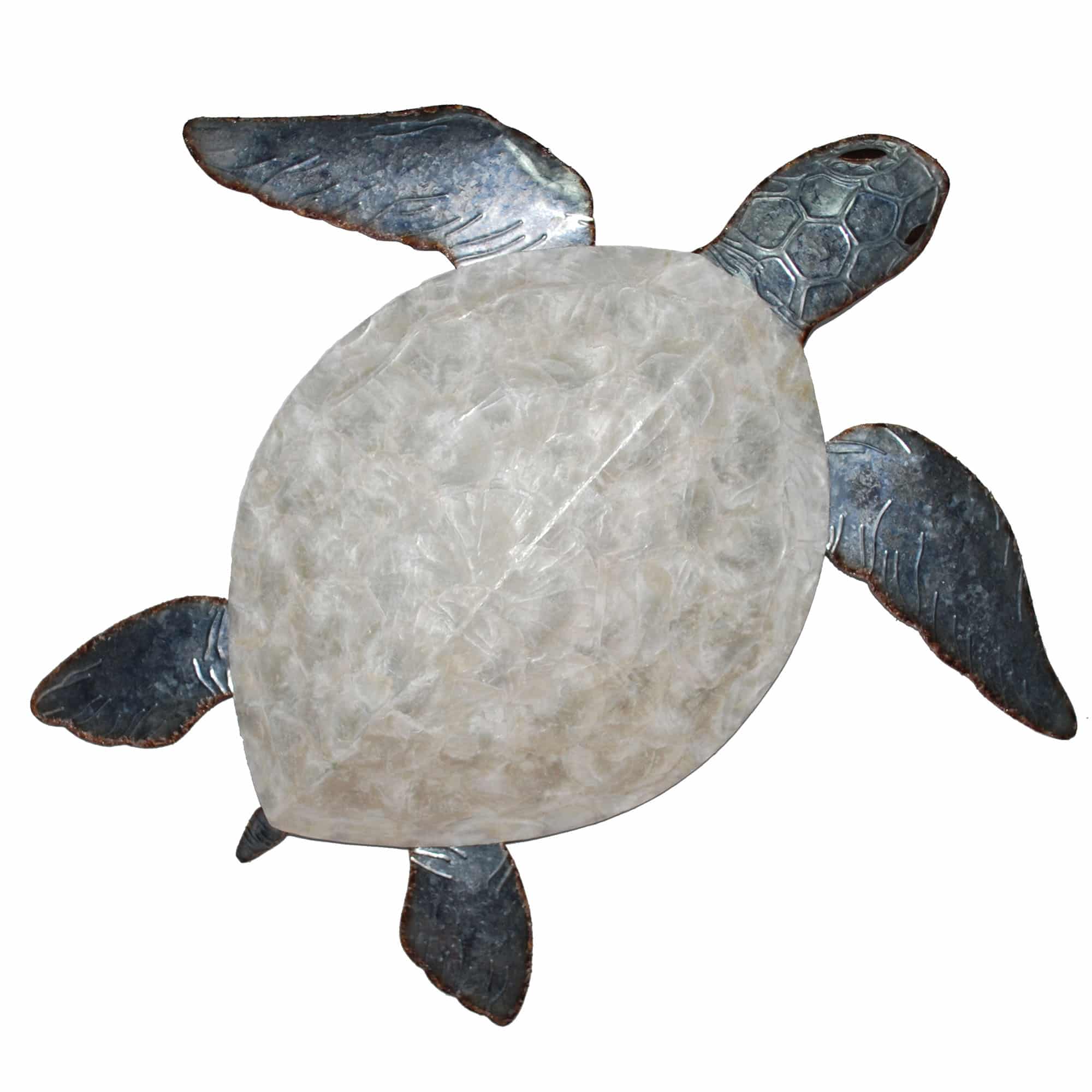 Sea turtles are among the most ancient species on this planet. Today there are seven species of sea turtle remaining that date back 110 million years, back to the age of the dinosaurs. This piece features the Loggerhead turtle, one of the most recognizable of all the sea. This creature is known for its scaled skin, which the artist carefully etches into the metal of the turtle's head and throughout the tips and edges of its body. The shell of the turtle glistens which the artist recreates using capiz shell. The focus of this awe-inspiring piece is the texture and size of sea turtles and the artist uses contrasting colors to underscore this fact. The basic frame of the turtle is created using tin, which is powder coated with a black finish. The frame is reinforced using tin wire along the inner edge. Capiz is an oyster shell and the primary purpose of the oyster is as a source of food. However, the by-product, the shell, can be used for decoration. Due to it being a natural material, the natural colors of the capiz come through as tans and browns underneath the paint. The shell is then painted the bold colors you see. The entire front facing piece is carefully hand-painted keeping in mind the reflective qualities in the color of turtles.
Sea turtles are among the most ancient species on this planet. Today there are seven species of sea turtle remaining that date back 110 million years, back to the age of the dinosaurs. This piece features the Loggerhead turtle, one of the most recognizable of all the sea. This creature is known for its scaled skin, which the artist carefully etches into the metal of the turtle's head and throughout the tips and edges of its body. The shell of the turtle glistens which the artist recreates using capiz shell. The focus of this awe-inspiring piece is the texture and size of sea turtles and the artist uses contrasting colors to underscore this fact. The basic frame of the turtle is created using tin, which is powder coated with a black finish. The frame is reinforced using tin wire along the inner edge. Capiz is an oyster shell and the primary purpose of the oyster is as a source of food. However, the by-product, the shell, can be used for decoration. Due to it being a natural material, the natural colors of the capiz come through as tans and browns underneath the paint. The shell is then painted the bold colors you see. The entire front facing piece is carefully hand-painted keeping in mind the reflective qualities in the color of turtles. -
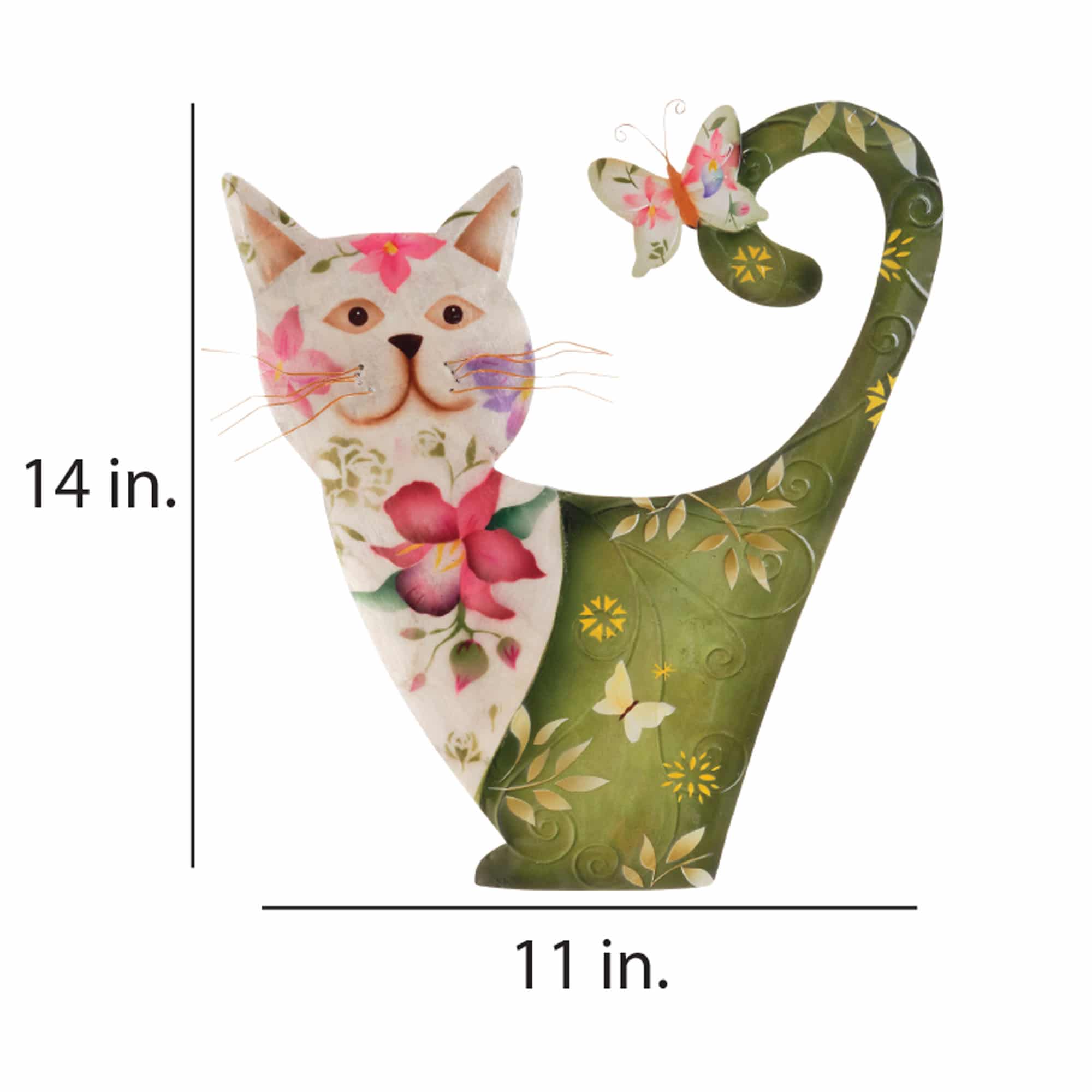
 From the smile on its face to the butterfly resting on its tail, this happy cat brings warmth and joy. This kitty's face and chest is adorned with mother of pearl capiz shell. The artist then hand-painted flowers on top of the shell. The floral theme continues on the lower half of the body, both in being painted on and being pressed into the tin. The contrasting pearl and green ensures this piece fits in nearly any decor style. The basic frame of the cat is created using tin, which is powder coated with a black finish. The frame is reinforced using tin wire along the inner edge. Capiz is an oyster shell and the primary purpose of the oyster is as a source of food. However, the by-product, the shell, can be used for decoration. Due to it being a natural material, the natural colors of the capiz come through as tans and browns underneath the paint. The shell is then painted the bold colors you see. The entire front facing piece is carefully hand-painted.
From the smile on its face to the butterfly resting on its tail, this happy cat brings warmth and joy. This kitty's face and chest is adorned with mother of pearl capiz shell. The artist then hand-painted flowers on top of the shell. The floral theme continues on the lower half of the body, both in being painted on and being pressed into the tin. The contrasting pearl and green ensures this piece fits in nearly any decor style. The basic frame of the cat is created using tin, which is powder coated with a black finish. The frame is reinforced using tin wire along the inner edge. Capiz is an oyster shell and the primary purpose of the oyster is as a source of food. However, the by-product, the shell, can be used for decoration. Due to it being a natural material, the natural colors of the capiz come through as tans and browns underneath the paint. The shell is then painted the bold colors you see. The entire front facing piece is carefully hand-painted. -
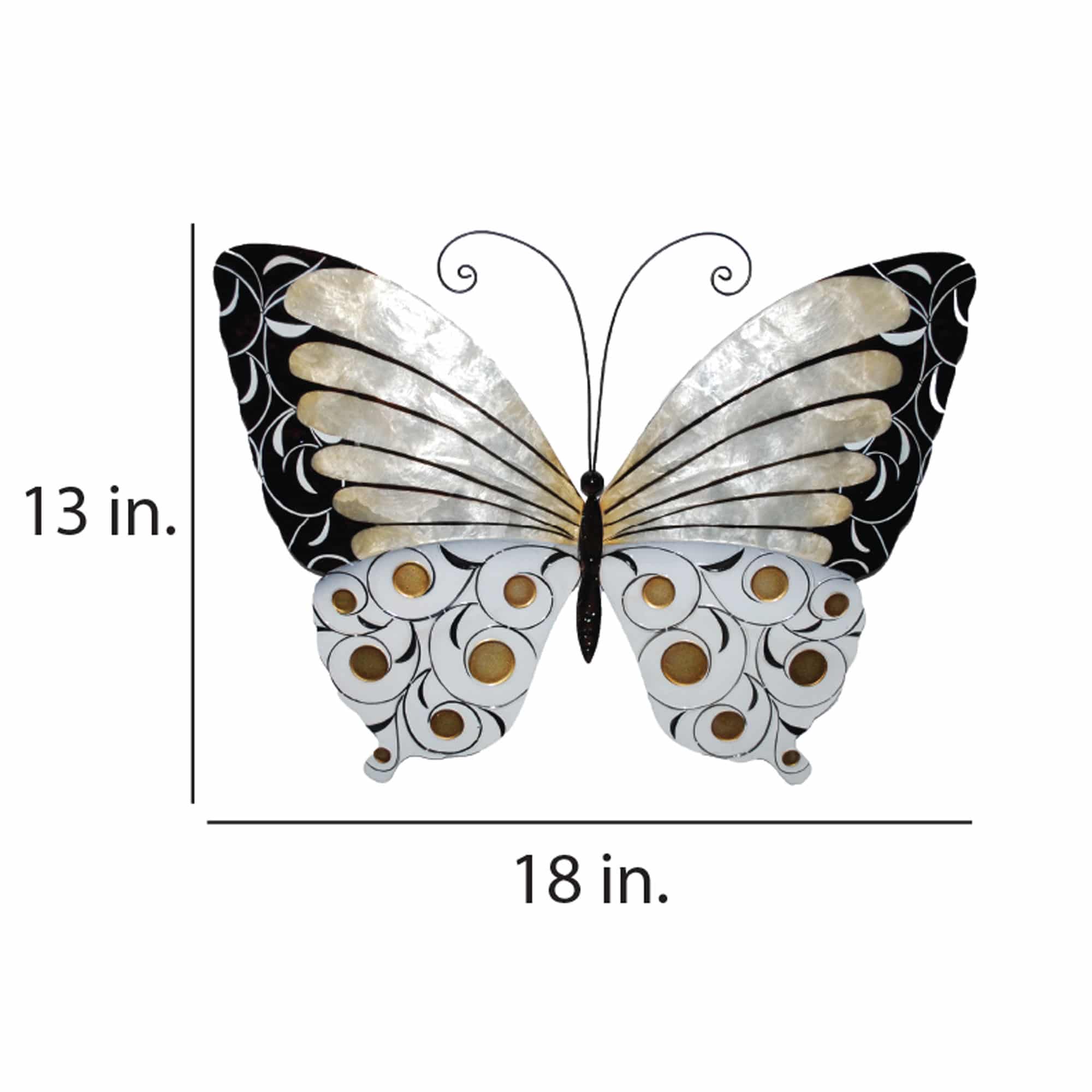
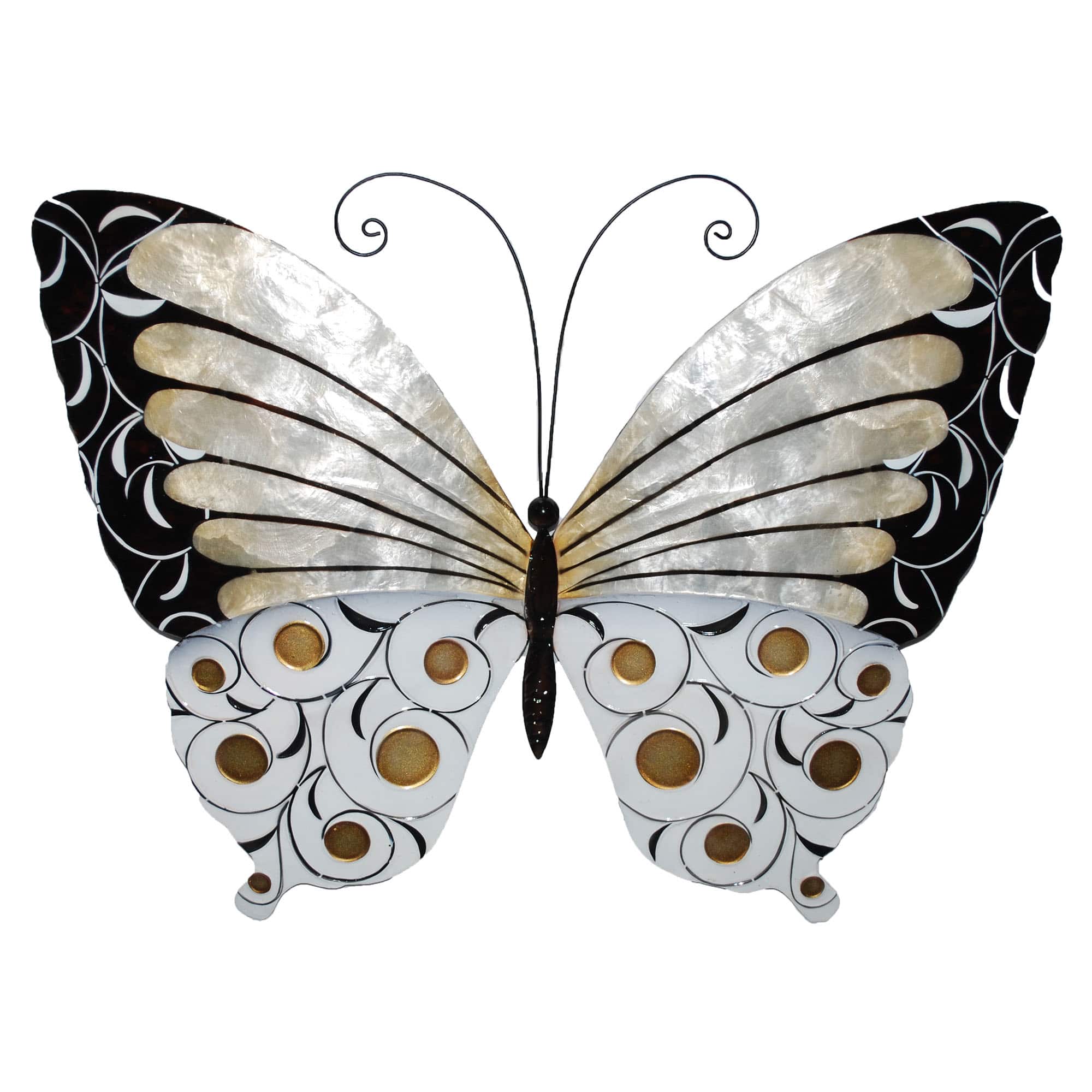
Classy and elegant, the artist hand-paints this butterfly in bold black, white, and golds. This contrasting color choice provides a microcosm of a popular retro design, which incorporates, lines, circles, and different combinations of each of the three colors creating beautiful and distinct living spaces.
The basic frame of the butterfly is created using tin, which is powder-coated with a black finish and makes this piece safe to use outdoors. The edges of the frame are reinforced using thicker tin wire. The front of this piece is adorned in areas with capiz shell, an oyster native to the Philippines, before being hand-painted and sealed with a water-based sealant. The primary purpose of this oyster to provide a source of food, however, the shell is a sustainable by-product that can be used for decoration. The capiz shell subtly replicates the reflective qualities of butterflies in nature. The entire piece is lightweight and has an eyelet in the back allowing it to be hung using a finishing nail, command strip, or a push pin. Due to it being a natural material, the organic colors of capiz come through as tans and browns underneath the paint.
-
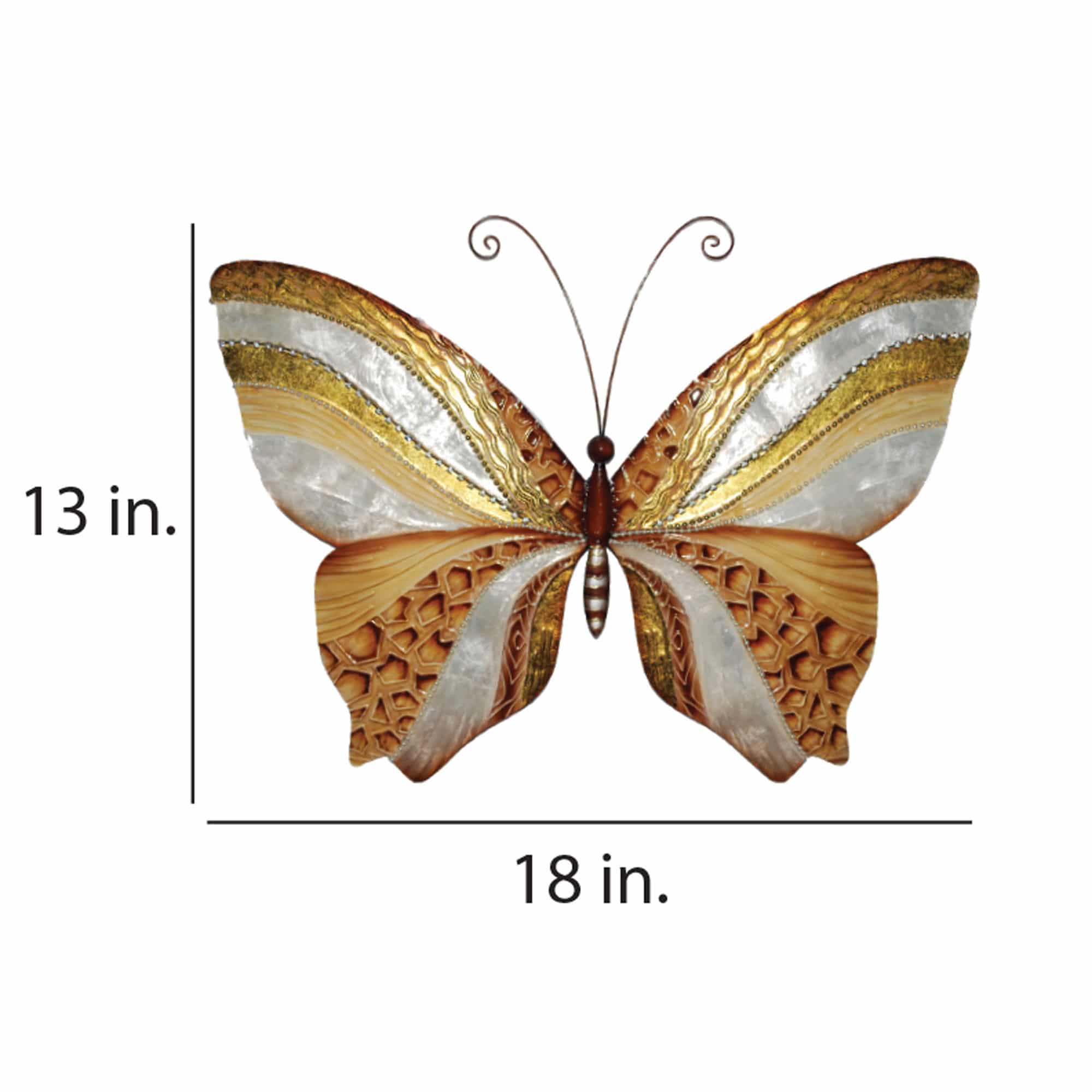
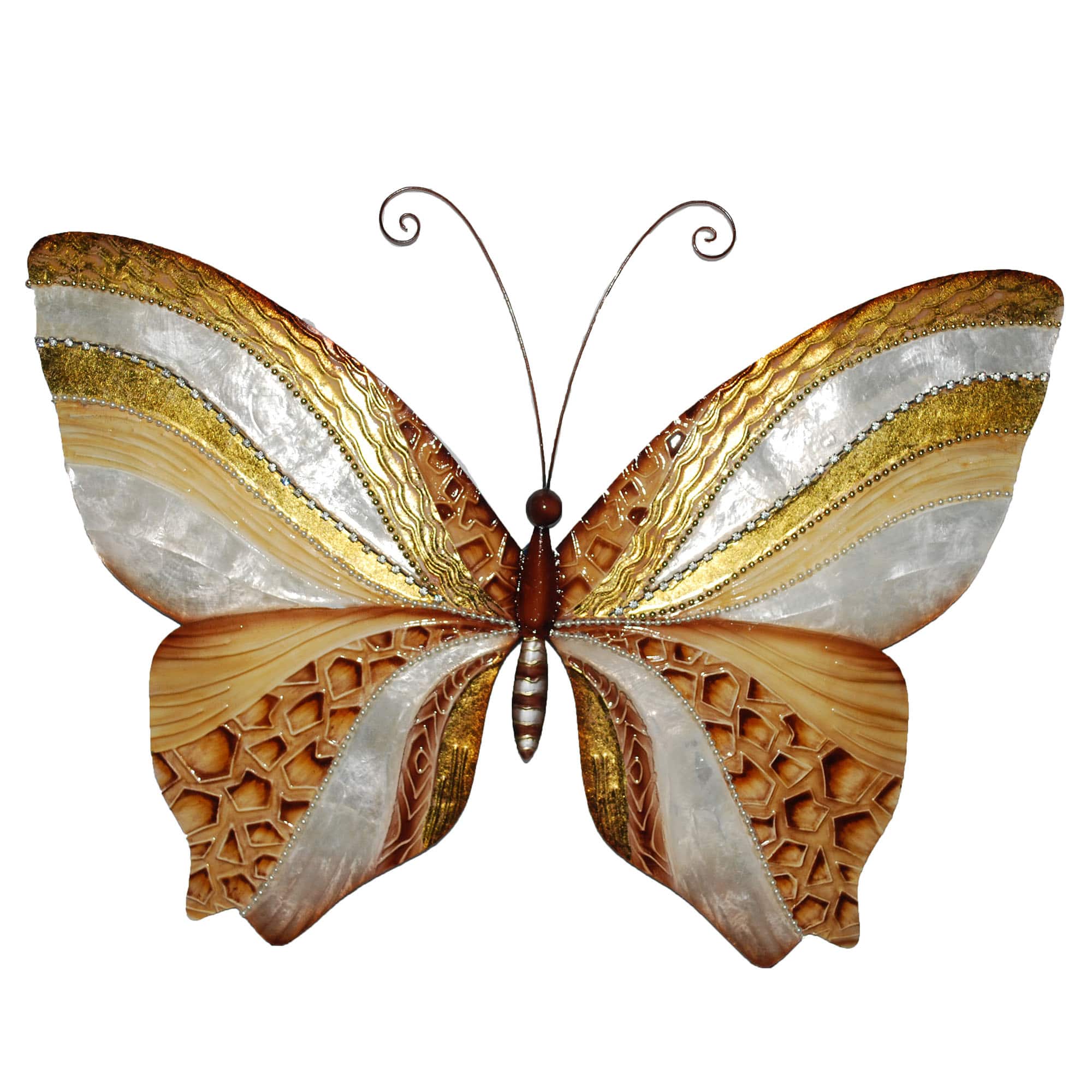
Elegant and flowing, this butterfly has spread its wings to take flight. The artist heightens this feel with capiz shell and shimmering beads. The hand-painted finish flows gracefully along clean lines radiating outwards towards its wingtips.
The basic frame of the butterfly is created using tin, which is powder-coated with a black finish and makes this piece safe to use outdoors. The edges of the frame are reinforced using thicker tin wire. The front of this piece is adorned in areas with capiz shell, an oyster native to the Philippines, before being hand-painted and sealed with a water-based sealant. The primary purpose of this oyster to provide a source of food, however, the shell is a sustainable by-product that can be used for decoration. The capiz shell subtly replicates the reflective qualities of butterflies in nature. The entire piece is lightweight and has an eyelet in the back allowing it to be hung using a finishing nail, command strip, or a push pin. Due to it being a natural material, the organic colors of capiz come through as tans and browns underneath the paint.
-
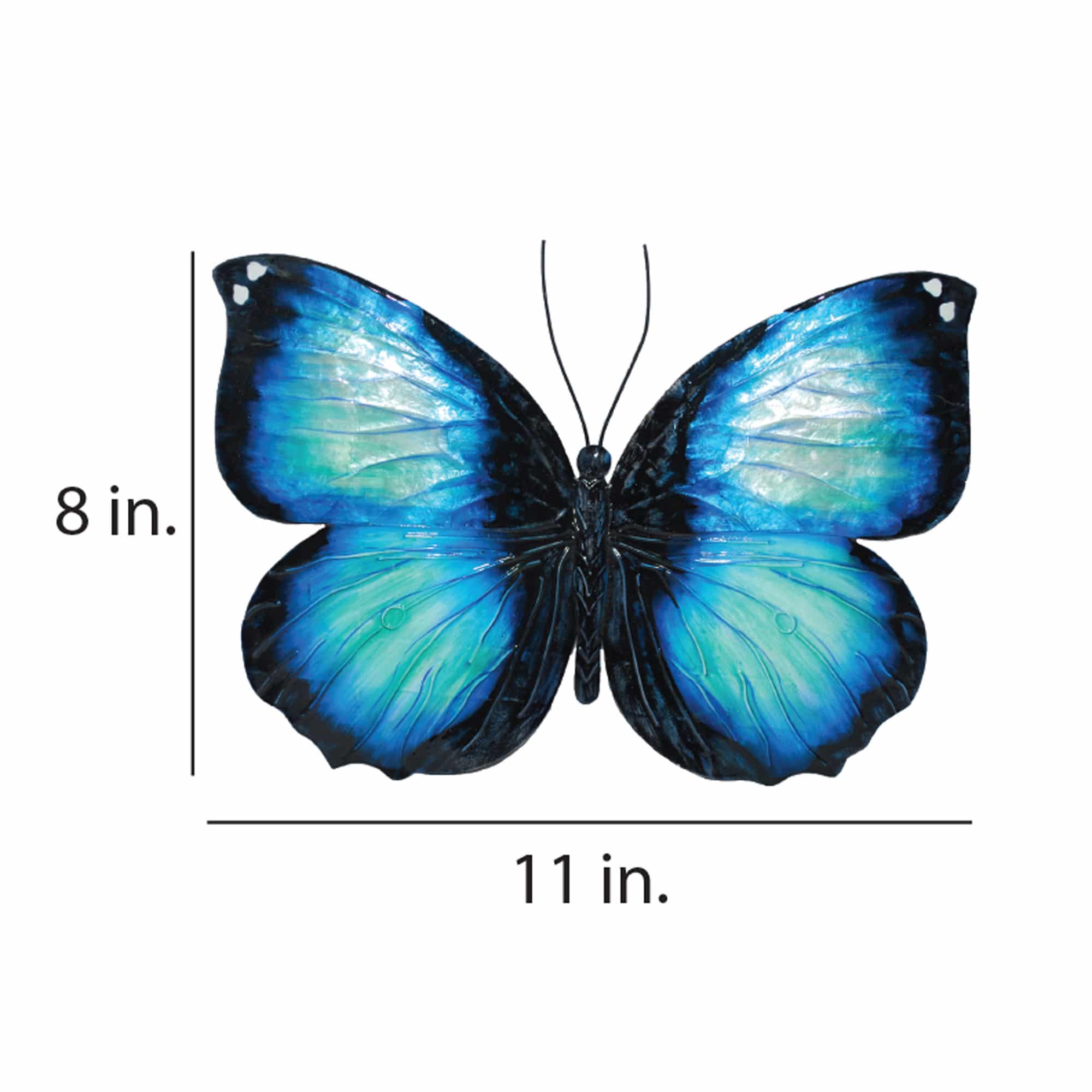
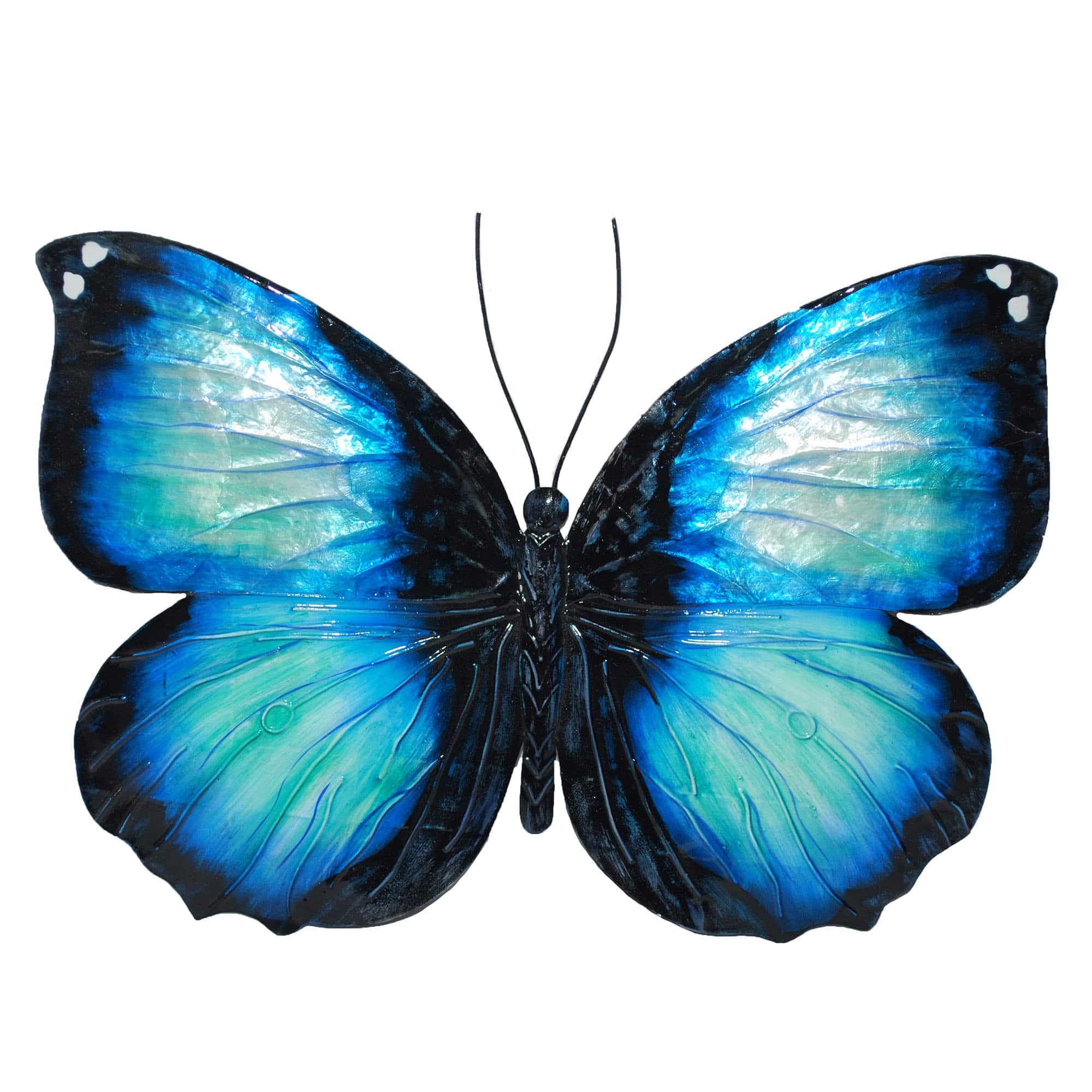
This butterfly is influenced by the Pipevine Swallowtail, which is common in the middle to eastern parts of the US. These swift fliers fly low to the ground and do not stay on a wall very long. The artist captured their cobalt blue color which is truly striking. Accent your wall with a color that has been given a stamp of approval by nature.
The basic frame of the butterfly is created using tin, which is powder-coated with a black finish and makes this piece safe to use outdoors. The edges of the frame are reinforced using thicker tin wire. The front of this piece is adorned in areas with capiz shell, an oyster native to the Philippines, before being hand-painted and sealed with a water-based sealant. The primary purpose of this oyster to provide a source of food, however, the shell is a sustainable by-product that can be used for decoration. The capiz shell subtly replicates the reflective qualities of butterflies in nature. The entire piece is lightweight and has an eyelet in the back allowing it to be hung using a finishing nail, command strip, or a push pin. Due to it being a natural material, the organic colors of capiz come through as tans and browns underneath the paint.
-
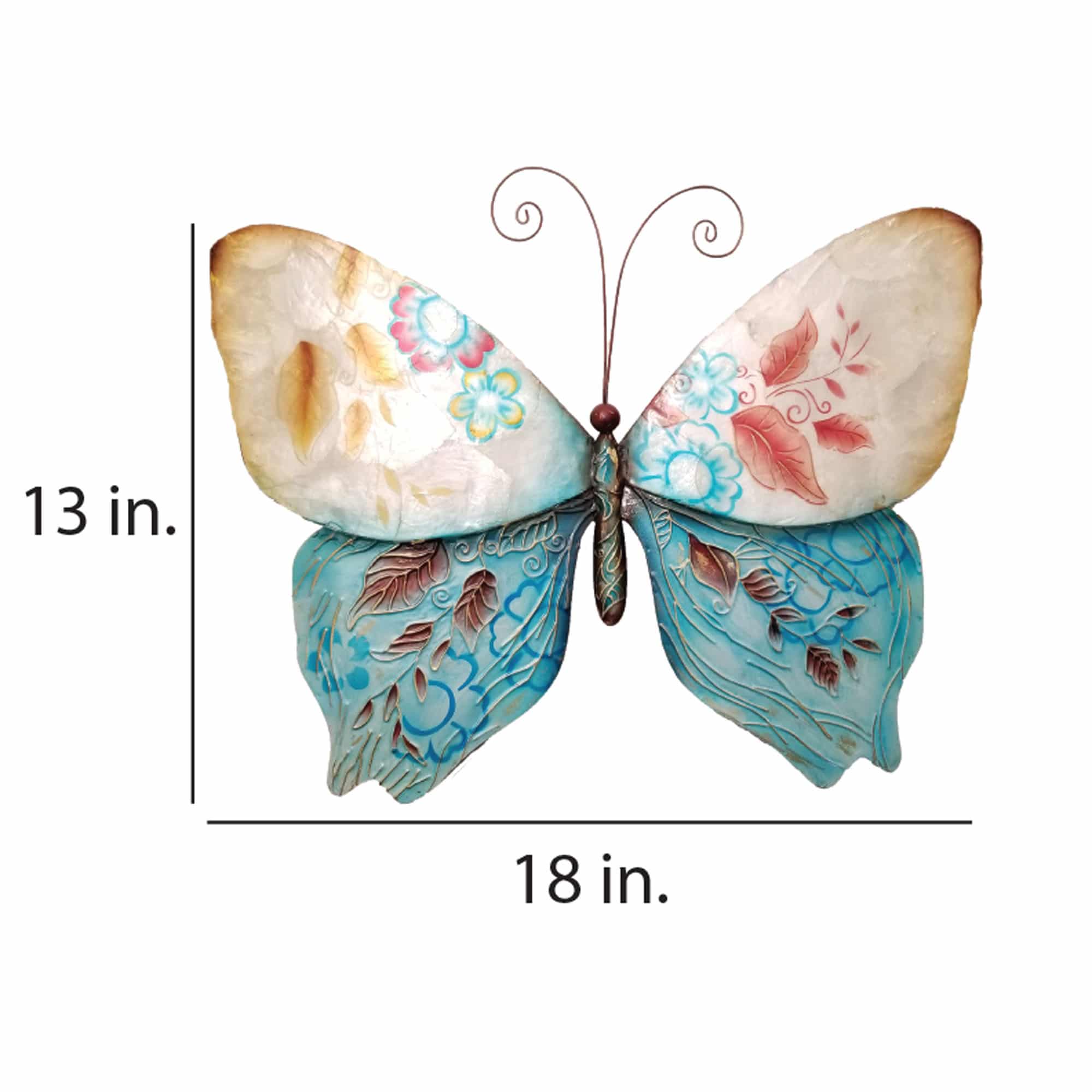
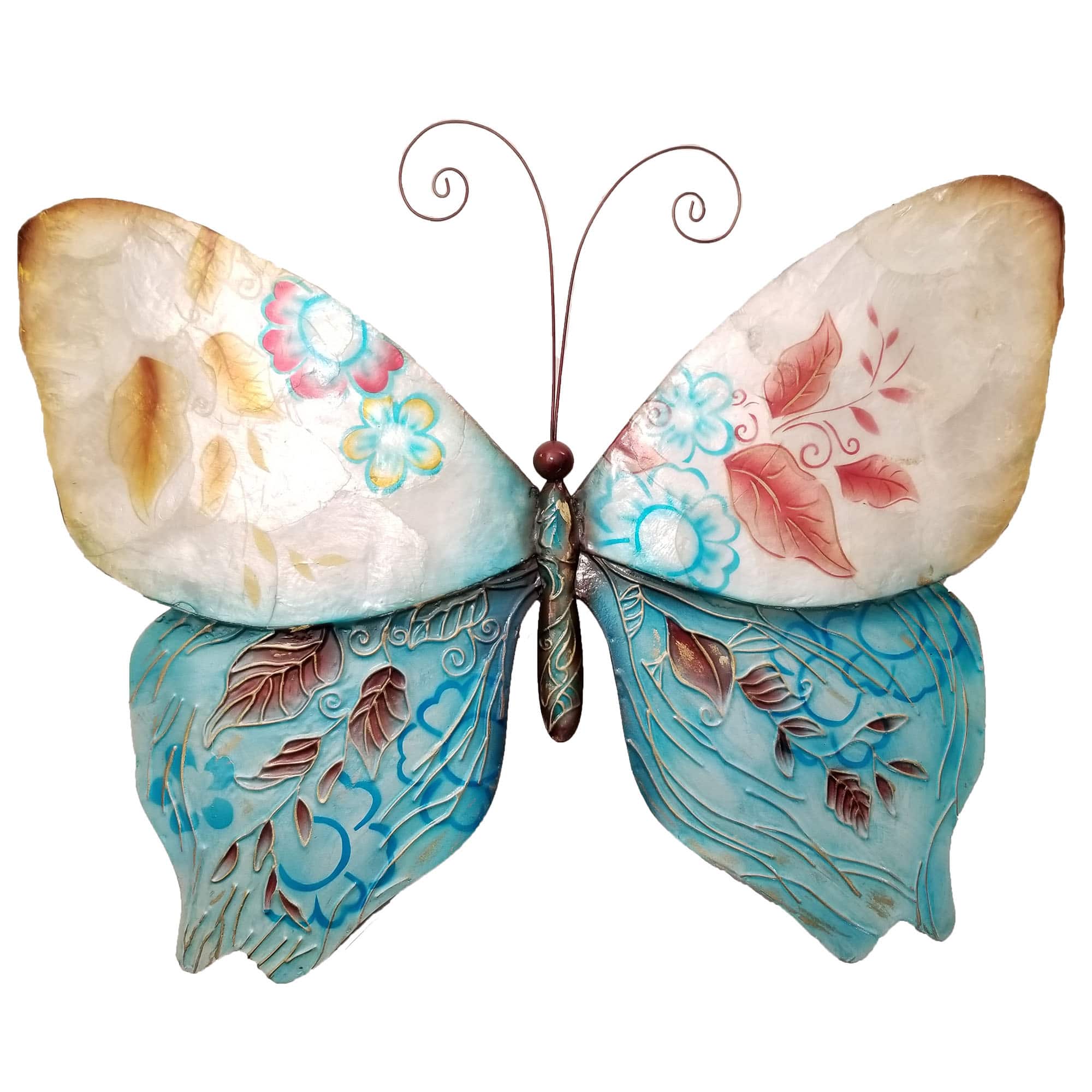 Using intricate design and cool colors, this butterfly is sophisticated with its retro leaf and flower patterns. The upper wings are adorned with capiz shell and the flower patterns are painted lightly, complementing the translucent color seen in the natural butterfly. The lower wings are constructed from tin, textured, colored with a burst of turquoise and accented with golds and reds. Great for nearly all decor styles, this piece works great in contemporary, modern, traditional, and farm house settings The basic frame of the butterfly is created using tin, which is powder-coated with a black finish and makes this piece safe to use outdoors. The edges of the frame are reinforced using thicker tin wire. The front of this piece is adorned in areas with capiz shell, an oyster native to the Philippines, before being hand-painted and sealed with a water-based sealant. The primary purpose of this oyster to provide a source of food, however, the shell is a sustainable by-product that can be used for decoration. The capiz shell subtly replicates the reflective qualities of butterflies in nature. The entire piece is lightweight and has an eyelet in the back allowing it to be hung using a finishing nail, command strip, or a push pin. Due to it being a natural material, the organic colors of capiz come through as tans and browns underneath the paint.
Using intricate design and cool colors, this butterfly is sophisticated with its retro leaf and flower patterns. The upper wings are adorned with capiz shell and the flower patterns are painted lightly, complementing the translucent color seen in the natural butterfly. The lower wings are constructed from tin, textured, colored with a burst of turquoise and accented with golds and reds. Great for nearly all decor styles, this piece works great in contemporary, modern, traditional, and farm house settings The basic frame of the butterfly is created using tin, which is powder-coated with a black finish and makes this piece safe to use outdoors. The edges of the frame are reinforced using thicker tin wire. The front of this piece is adorned in areas with capiz shell, an oyster native to the Philippines, before being hand-painted and sealed with a water-based sealant. The primary purpose of this oyster to provide a source of food, however, the shell is a sustainable by-product that can be used for decoration. The capiz shell subtly replicates the reflective qualities of butterflies in nature. The entire piece is lightweight and has an eyelet in the back allowing it to be hung using a finishing nail, command strip, or a push pin. Due to it being a natural material, the organic colors of capiz come through as tans and browns underneath the paint. -


Classically painted roses adorn this set of three butterflies. The traditional pattern brings the garden indoors. Painted on mother of pearl oyster shells, the vibrant roses pop, adding color and charm.
The basic frame of the butterfly is created using tin, which is powder-coated with a black finish and makes this piece safe to use outdoors. The edges of the frame are reinforced using thicker tin wire. The front of this piece is adorned in areas with capiz shell, an oyster native to the Philippines, before being hand-painted and sealed with a water-based sealant. The primary purpose of this oyster to provide a source of food, however, the shell is a sustainable by-product that can be used for decoration. The capiz shell subtly replicates the reflective qualities of butterflies in nature. The entire piece is lightweight and has an eyelet in the back allowing it to be hung using a finishing nail, command strip, or a push pin. Due to it being a natural material, the organic colors of capiz come through as tans and browns underneath the paint.
-
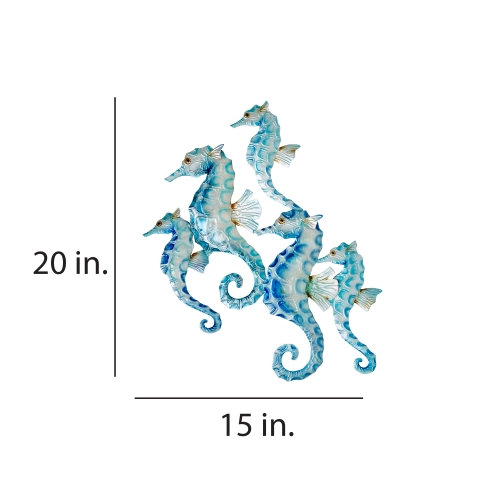
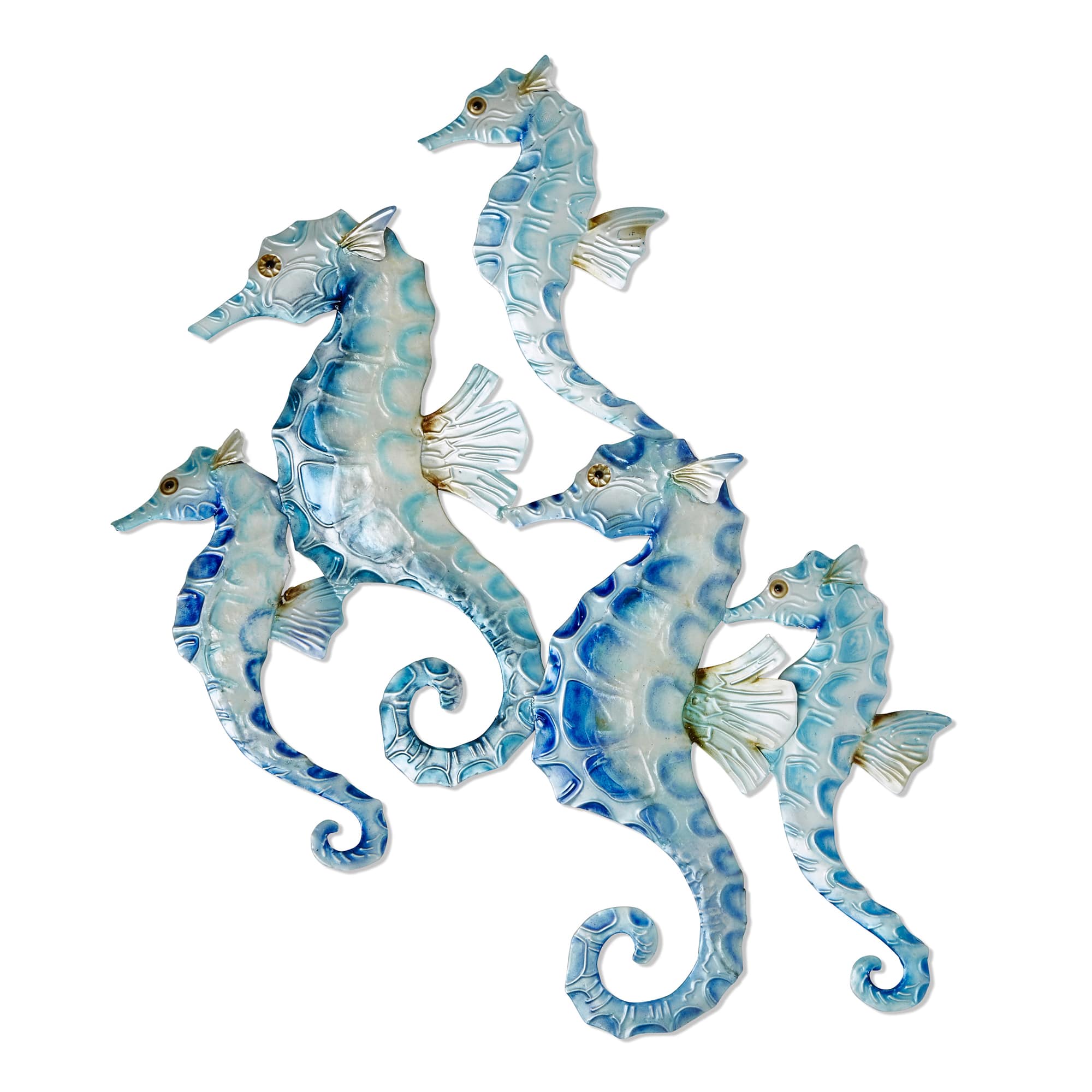 The seahorse has captured the minds and imaginations of people across all cultures for thousands of years. Seen as a symbol of good luck, strength and safety, this unique and beautiful animal is as charming as it is mysterious. The artist captures the beauty of the seahorse with a raised fine, high shine, hand-painted finish, and elegant mother of pearl on their chest and forefront. The basic frame of the wall seahorses is created using tin, which is powder coated as a black finish. Capiz is an oyster shell and the primary purpose of the oyster is as a source of food. However, the by-product, the shell, can be used for decoration. Due to it being a natural material, the natural colors of the capiz can come through as tans and browns.
The seahorse has captured the minds and imaginations of people across all cultures for thousands of years. Seen as a symbol of good luck, strength and safety, this unique and beautiful animal is as charming as it is mysterious. The artist captures the beauty of the seahorse with a raised fine, high shine, hand-painted finish, and elegant mother of pearl on their chest and forefront. The basic frame of the wall seahorses is created using tin, which is powder coated as a black finish. Capiz is an oyster shell and the primary purpose of the oyster is as a source of food. However, the by-product, the shell, can be used for decoration. Due to it being a natural material, the natural colors of the capiz can come through as tans and browns. -


Few things have the influence on life as does music. It is at the center of nearly every culture. It sets mood, both draws from and creates emotion. It provides voice and power. The artist uses streaming golds and detailed design to create a classical feel in this piece. It is large and lively and will provide resonating sound to its environment.
The frame of this piece is created using tin, which is powder coated in a black finish. The frame is reinforced using wrought iron wire on the inner and outer edges. The copper paint is worked over to give it an aged and oxidized look.
-
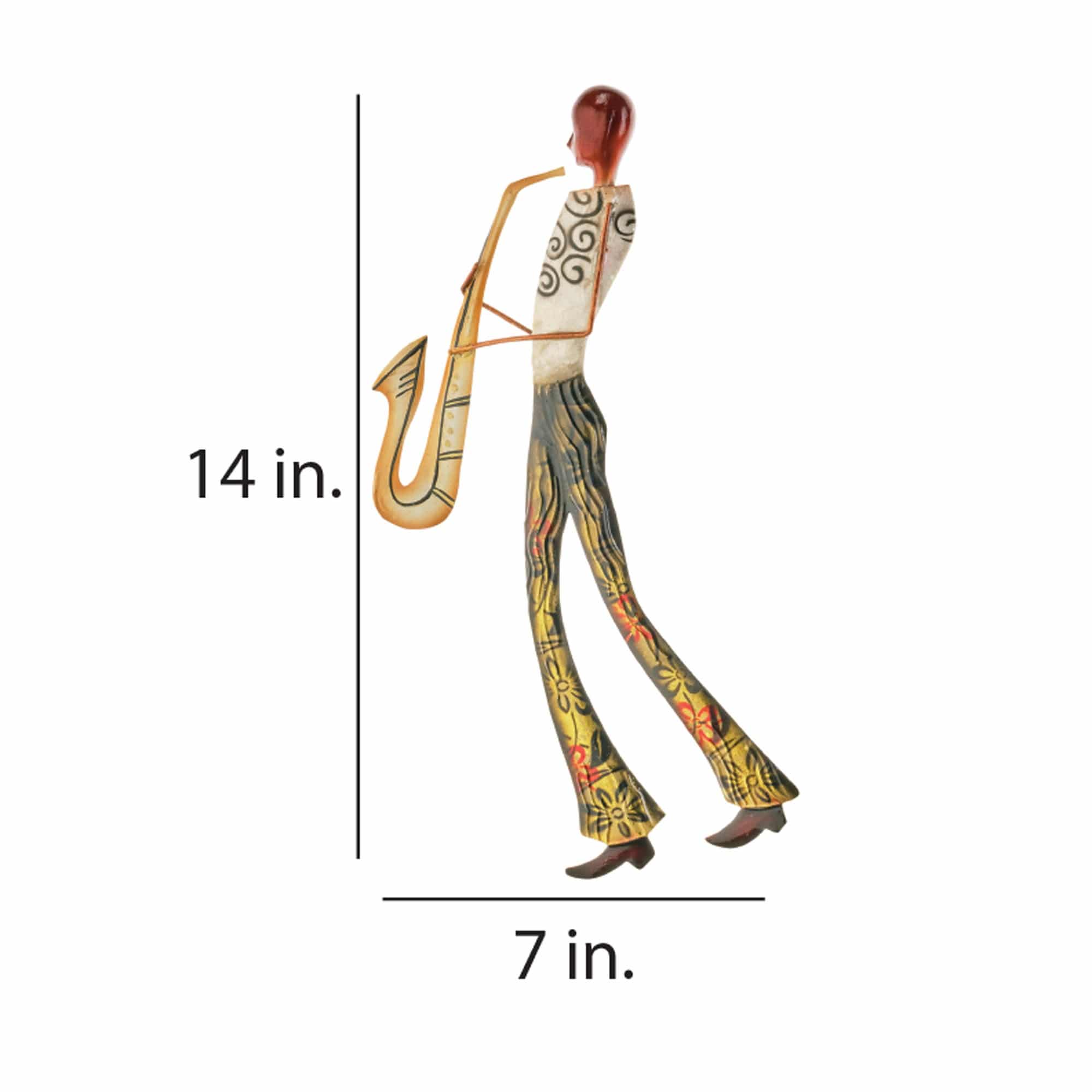
 Jazz inspires the artisan's interpretation of the sax player. Jazz is considered music of the soul due to the deep emotion that runs to the roots of this important American movement. It can be used as a journey to happy times or a reflection of struggles. This particular guitarist, with the colorful finishes, the influence is definitely in a mood of celebration. The festive shirt of the player is adorned with capiz shell, giving it a shimmer as it reflects light. The frame of the Sax Player Wall Decor is created using tin, which is powder coated as a black finish. The frame is reinforced using wrought iron wire inner and outer edges. Capiz is an oyster shell and the primary purpose of the oyster is as a source of food. However, the by-product, the shell, can be used for decoration. Due to it being a natural material, the natural colors of the capiz can come through as tans and browns underneath the paint.
Jazz inspires the artisan's interpretation of the sax player. Jazz is considered music of the soul due to the deep emotion that runs to the roots of this important American movement. It can be used as a journey to happy times or a reflection of struggles. This particular guitarist, with the colorful finishes, the influence is definitely in a mood of celebration. The festive shirt of the player is adorned with capiz shell, giving it a shimmer as it reflects light. The frame of the Sax Player Wall Decor is created using tin, which is powder coated as a black finish. The frame is reinforced using wrought iron wire inner and outer edges. Capiz is an oyster shell and the primary purpose of the oyster is as a source of food. However, the by-product, the shell, can be used for decoration. Due to it being a natural material, the natural colors of the capiz can come through as tans and browns underneath the paint. -
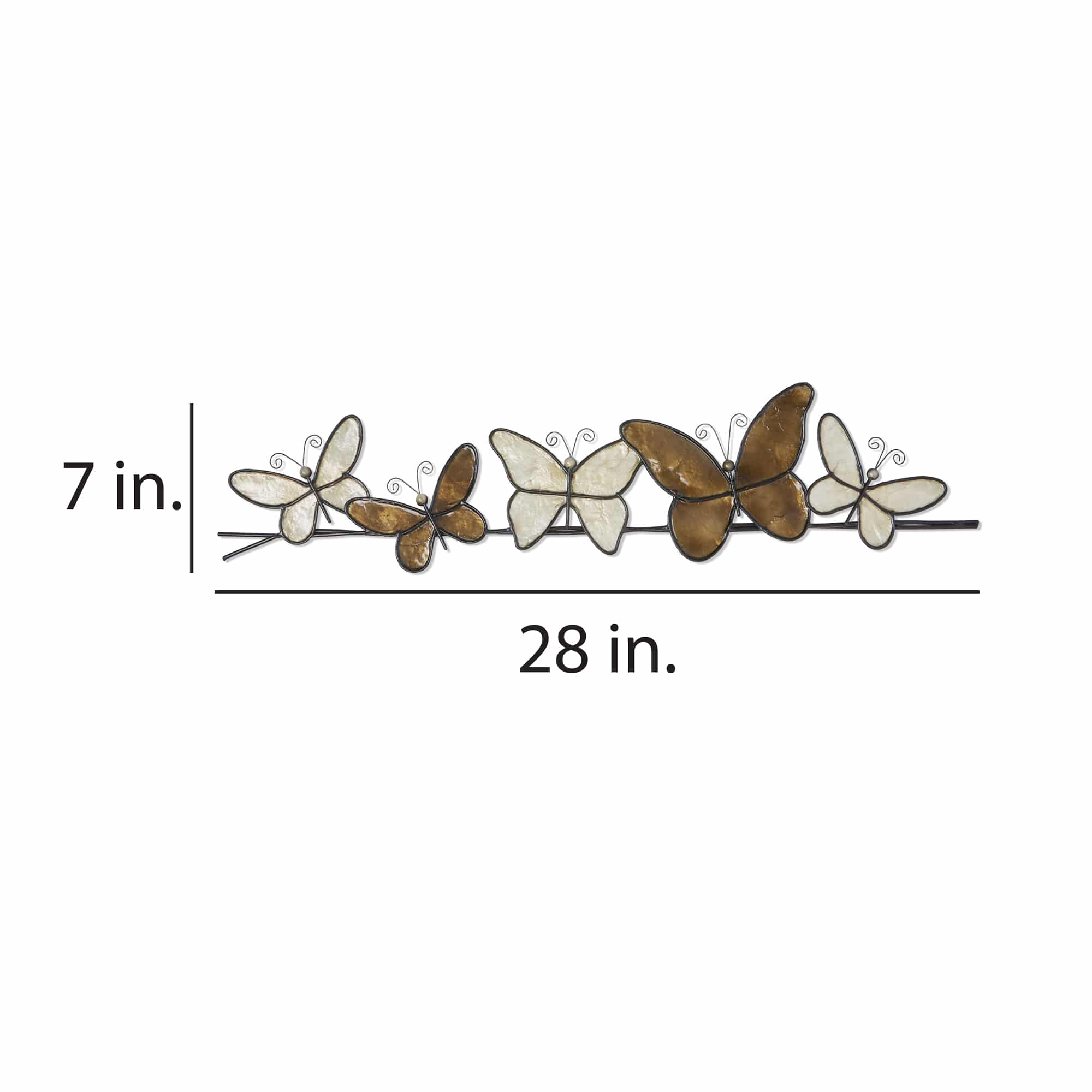
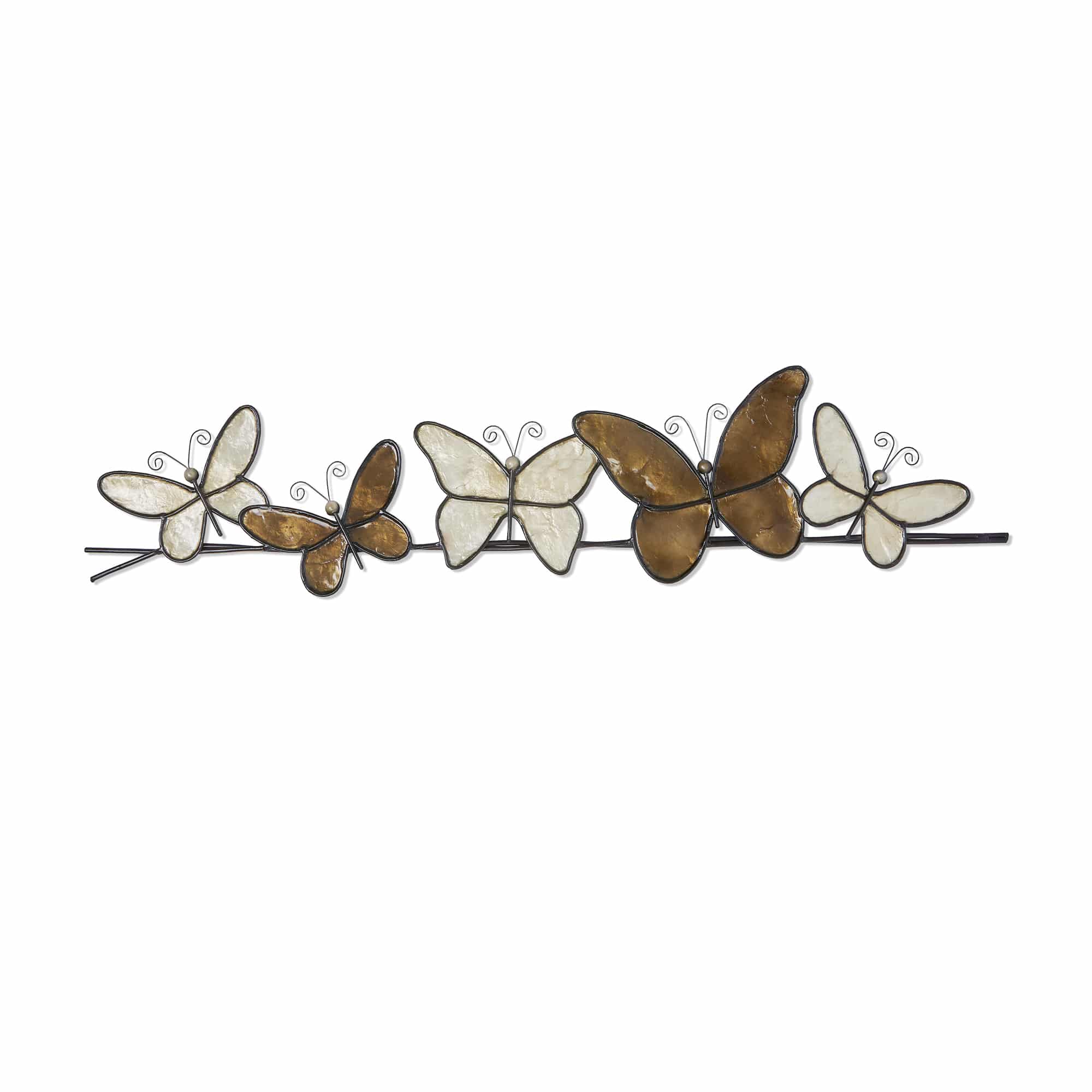
Five, fluttering butterflies are ready to complete their journey after taking a break from a long migration. The slender, metal body of each butterfly connects to colorful capiz-shell wings which catches light and adds shine. Each wing is framed using sturdy wrought iron and reinforced with a metal backing.
The basic frame of the butterfly is created using tin, which is powder-coated with a black finish and makes this piece safe to use outdoors. The edges of the frame are reinforced using thicker tin wire. The front of this piece is adorned in areas with capiz shell, an oyster native to the Philippines, before being hand-painted and sealed with a water-based sealant. The primary purpose of this oyster to provide a source of food, however, the shell is a sustainable by-product that can be used for decoration. The capiz shell subtly replicates the reflective qualities of butterflies in nature. The entire piece is lightweight and has an eyelet in the back allowing it to be hung using a finishing nail, command strip, or a push pin. Due to it being a natural material, the organic colors of capiz come through as tans and browns underneath the paint.



